Australian
and international
exploratory
performance and
media arts
Embracing the work’s disturbing structure, Jonathan applauds writer and co-director Richard Murphet’s The Inhabited Man as a “dense, beautiful yet traumatising dramaturgical essay” about the psychological damage imposed by war.
RealTime issue #87 Oct-Nov 2008
–
Top image credit: Merfyn Owen (foreground), The Inhabited Man
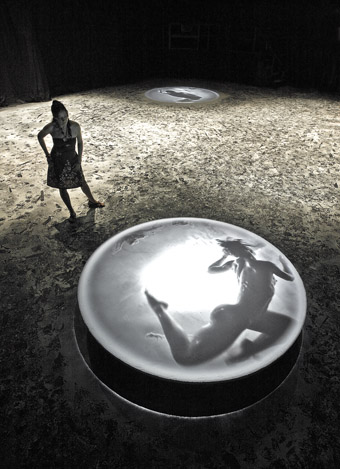
Shifting Intimacies
photo David Campbell
Shifting Intimacies
KEITH ARMSTRONG AND GUY WEBSTER COLLABORATED WITH CHARLOTTE VINCENT AND THE DANCER TC HOWARD TO PRODUCE SHIFTING INTIMACIES FOR A SHOW AT THE ICA IN LONDON IN 2006. AT THE BRISBANE FESTIVAL IT IS ON FOR A FEW HOURS SPREAD OVER FOUR DAYS. BOOKINGS MUST BE MADE. SINGLE VIEWER AT A TIME. TEN MINUTE SLOTS. THEY FILL UP PRETTY QUICK.
You turn up at the Judith Wright Centre, grab a drink, sit in the foyer and wait your turn. The usher comes out and quietly offers up the now mandatory fear of litigation instructions on responsible behaviour when encountering an installation. Emboldened by caveats I enter the room alert to the terrors that might lie ahead. The space is darkish and semi-industrial—silver aircon ducts, chunky pillars. Shifting Intimacies was originally designed for ‘the ideal black box’ (painting = the white box; installation = the black box. The white box isolates the object, the black box isolates the viewer). Although it does change the piece from its original conception the space works. There’s something shady and transitory about the combination of slick tech aesthetic and low rent industrial—sort of bump in, bump out biotech.
The floor is covered in white dust marked by the footprints of previous visitors. There are two discs at either end of the space, each one a couple of metres across. The closest disc is a sand covered platform raised to about knee height, the further one a disc of white dust laid out on the ground and defined by a rim of deeper dust. Both discs glow with video projections. Onto the raised disc is projected a dancer, life size, colour muted close to grey scale. The dancer spins and contorts within what looks like a very amniotic fluid. The face is obscured, the body de-identified. Motion is slow, there are pauses then rapid jerking shifts. Tissue filaments, like sheets of skin, float about in the fluid, disintegrate and trail the motion of the limbs. If the raised disc is gestation then the second disc is erosion. Again the dancer is anonymous and seen from above. But this time the image is repeatedly broken down into noise generated by the microbial growth patterns of an AI algorithm. Even though the images are large, the effect is of looking through a porthole or microscope onto a private mystery. The viewer presence is acknowledged but the dancer’s face is always turned away, there is nothing personal or dialogic happening.
Throughout all of this is the sound design—low rumbles, spatially driven static, unnerving resonances. Organic, layered, moving about, buzzes and drones. At times I wander away from the image and just enjoy the sound, which seems to be more responsive to my position in the space than the images ever were. It is as if the sound forms an enclosure within which the dancer acts out a private and necessary cycle.
At the end of the timeslot a light goes on in the corner of the space. One walks up a short flight of stairs to a platform overlooking the disc of the eroded body. But now the body is fully revealed, face down, knees clenched, crouching. You reach into a bowl and grab some dust and cast it onto the figure below. More dust blows in. Soon there is enough dust to erase the figure completely.
Gina Czarnecki’s Contagion provides a very different experience. It is designed around ideas of viral transmission—epidemics of disease and fear. The space is cubic and black, large screen at one end. The screen looks like a giant monocular scope, red crosshairs slowly moving across the surface. Billowing smoke tracks each person’s movement through the space—coloured according to their entrance point and beautifully detailed. And, underneath the smoke trails, a movie of a surveillance operation plays out, figures glowing hot in the long wavelengths of night vision.
Contagion presents a traditional theatric and game-like space with the action split between the presentation on the screen and the audience out front. People try and interact with the system by moving about the space to drive movement in the smoke trails. But one cannot move about the space and interact in a completely natural fashion as the head must be facing forward and angled upward to view the screen, which is quite high. It’s like being in the front row at the pictures. And the look of people all facing the front moving about with their faces craned upward at an uncomfortable angle doesn’t gel with the elegance of the imagery. There is nothing intrinsically wrong with a work that sets up some sort of disjunction or discomfort between action and response, but there must be some sort of conceptually coherent payoff for doing so. Unfortunately in Contagion there is no obvious payoff that links audience motion and orientation to the conceptual domain.
In the end, Contagion feels flat, any emotional or aesthetic engagement dominated by the clumsiness of the interaction. By contrast, Shifting Intimacies does not feel particularly interactive at all—the experience is primarily poetic, and more powerful for that.
Keith Armstrong: www.embodiedmedia.com
Charlotte Vincent: www.vincentdt.com
2008 Brisbane Festival: Shifting Intimacies, artistic directors Keith Armstrong, Charlotte Vincent, sound director Guy Webster, TC Howard, Judith Wright Centre of Contemporary Arts, July 30-Aug 2; Contagion, Gina Czarnecki, The Block, QUT, Brisbane, July 18-Aug 3
RealTime issue #87 Oct-Nov 2008 pg. 35
© Greg Hooper; for permission to reproduce apply to realtime@realtimearts.net
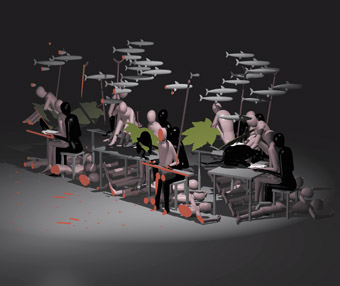
Yves Netzhammer, Die Subjektivierung der Wiederholung/The Subjectivisation of Repetition, Project C
NEW MEDIA ART HAS A VERY SHORT HISTORY ON CHINA’S MAINLAND, WHERE MORE TRADITIONAL FORMS SUCH AS PAINTING AND SCULPTURE TEND TO HOLD SWAY. SO, IN THE LEAD UP TO THE OLYMPIC GAMES, IT WAS A SURPRISE TO SEE BEIJING’S NOTORIOUSLY CONSERVATIVE NATIONAL ART MUSEUM OF CHINA (NAMOC) UNVEIL SYNTHETIC TIMES, A MAJOR SURVEY OF GLOBAL MEDIA ART PRACTICE.
The China-born, New York-based curator of Synthetic Times, Zhang Ga, has been involved in nurturing China’s nascent digital media scene for several years. “I was in China in 2003 and I looked around in Chinese universities and talked to a lot of artists”, recalls Zhang. “I realised their understanding of new media art really remained at the level of DVDs, digital photography, a little bit of 2D interaction and Flash. I thought it was important to introduce some of the most cutting edge, current media art production to China.”
During that visit, Zhang was invited by Tsinghua University to help introduce media art practices to Beijing’s creative community, which led to the inaugural Beijing International New Media Art Exhibition and Symposium in 2004. In 2006, the newly appointed NAMOC director, Fan Di’an, approached Zhang to curate a major exhibition of media art as part of the Olympic cultural program, signalling a significant shift in NAMOC’s curatorial philosophy. “[Fan Di’an] inherited a museum which is quite traditional”, says Zhang, “so I think he wanted to do something that is cutting edge and more appropriate for contemporary dialogue.”
Synthetic Times would have been a major event in any country, let alone one in which the concept of media art is barely known, and the sense of excitement and interest among visitors was obvious. Over 40 works filled the museum’s ground floor and spilled onto the building’s forecourt, including everything from kinetic sculptures to interactive installations. There were some familiar Australian contributions, including Transmute Collective’s Intimate Transactions (2005) and Stelarc’s Prosthetic Head (2003-08), smiling down on crowds near the museum entrance. [Australia’s MAAP was one of 17 international media arts organisations that collaborated on Synthetic Times. MAAP’s retinue also included Korea’s Kim Kichul and Singapore’s Paul Lincoln whose Citizen Comfort is described below.]
the recording eye
Some of the works that resonated most with the pre-Olympics Beijing setting were those dealing with digital image-making technologies. On the one hand these technologies, like film and photography before them, offer the tantalising possibility of capturing something of our history for posterity. The elusive nature of this promise felt all the more poignant in a city where physical traces of the past are being erased daily. On the other hand these same technologies are being increasingly utilised to observe, record and classify our movements.
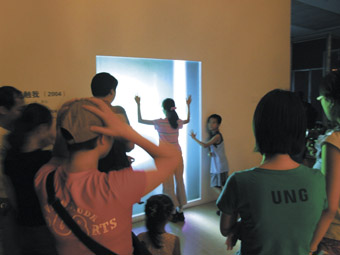
blendid collective, Touch Me, Netherlands, 2004
courtesy the artists
blendid collective, Touch Me, Netherlands, 2004
The blendid collective’s Touch Me (Netherlands, 2004) was a simple but affecting interactive installation, in essence a giant scanner fixed to the museum’s wall. Every so often a bright shaft of vertical light passed across the scanner which recorded a ghostly impression of spectators who pressed themselves against the glass. Each new sweep of light saw the previous image erased and new impressions recorded. If no-one pressed against the glass, the screen cycled through old images, creating a layering effect akin to a series of digital Turin shrouds. Initially amusing and a lot of fun, the blurry indistinct images took on a haunting air after a time, like ghosts reaching into the present from a murky past.
Nearby, Mariana Rondon’s You Came with the Breeze-2 (Venezuela, 2007-08) dealt in similarly fleeting imagery. Two robot arms suspended from a large metal frame each ended in a ring roughly the size of a football. The rings were dipped into bowls of soapy fluid, before being swung into the centre of the frame, where fans blew on the liquid to form giant bubbles. Clouds of mist were sprayed into the bubbles and shimmering images projected from the rear briefly appeared on the water droplets before the bubbles burst, the mist dissipated and the entire process began again. Images included a baby, a giant eye and, rather incongruously, a chicken. In the corner of the metal frame, indistinct naked figures were projected onto a solid plastic sphere, creating the effect of human forms swimming in a fish bowl. The work beautifully evoked the transient nature of images, suggesting that for all our archival technologies, time is always at work, eroding our attempts to fix memories.
David Rokeby’s Taken (Canada, 2002) was one of the older works at Synthetic Times, but it certainly struck a chord in a pre-Olympics Beijing as surveillance cameras sprouted like mushrooms across the city. It comprised two screens, the right one a fuzzy yellow surveillance image of the crowd in front of the work, captured by a camera in the corner. The image depicted gallery patrons in real time, but also retained traces of past observers in the form of spectral shadows. Periodically a small rectangle, akin to a gunsight, would single out an individual and relay their close-up to the blue-toned screen on the left. Words and phrases, sometimes amusing, sometimes sinister, flashed above the close-ups, such as “Unconcerned”, “Completely Convinced”, “Implicated”, and “Deeply Suspicious.” Every so often, dozens of the close-ups would appear together, like a mosaic of animated mugshots.
Paul Lincoln’s Citizen Comfort (Singapore, 2008) also reflected upon the way camera technologies assist in ideologically determining space. A small screen sat before a comfortable armchair and hat stand, signifiers of cosy domestic security. The screen showed the space in front of the armchair, but if the viewer picked the screen up and pointed it at the small air-conditioning holes in the museum’s wall, words in red block letters appeared in the televisual space, such as “United”, “Race”, “Democratic”, “Prosperity”, and “Nation.” A large flat screen fixed to the wall behind the armchair relayed the image appearing on the smaller screen, creating a hall-of-mirrors circuit of surveillance. Like David Rokeby’s Taken, Citizen Comfort interrogates how imaging technology both records an impression of the physical world and ideologically informs how we understand ‘reality.’
works of disquiet
A melancholic or sometimes menacing air lurked below the playful surfaces of the installations described above, but two works in Synthetic Times were unambiguously disquieting. The first was Cloud, by Chinese artist Xu Zhongmin (2006). A large cone spun as lights strobed and small child-like figures emerged from the cone’s top, tumbling and diving down the sides before dropping like rain from the base. Occasionally the spinning stopped, the strobing ceased and the children became stationary figures poised mid-action. Then the spinning resumed and they continued their lemming-like tumbles. Wide open to interpretation, Cloud was a disturbing portrayal of futile, repetitive mass action.
Yves Netzhammer’s The Subjectivisation of Repetition (Switzerland, 2007) was one of the exhibition’s more conventional works in terms of form, but also one of the most intriguing. A large installation comprising a main screen and three smaller screens on the opposite wall, viewers had to climb a sizeable mound made from timber in the centre of the room, as if gathering to hear a Biblical parable. The walls were filled with the silhouettes of strange creatures and vegetation, and maps of the world. On the main screen small animated vignettes played out in sequences lasting from a few seconds to a minute or so. A featureless black figure sat behind a white one, rubbed his finger on a blood red map of the world, forced out the white figure’s tongue and wiped it with his reddened finger tip. A dolphin swam beside a man walking on shore, until the creature hit a red pipe and went belly-up while the man walked on oblivious. A map of the world folded in on itself. Many of the aphoristic scenes were replete with acts of sanitised, clinical violence, the animated figures playing out a seemingly endless cycle of attraction, repulsion and struggle for domination with an unnerving air of calm. The rear trio of screens showed similar scenes. The scenarios felt both familiar and strange, like half remembered dreams. The Subjectivisation of Repetition was a beautiful, disturbing interrogation of our era’s contested signifiers, mediated violence, and sense of impending disaster.
wakeup call for local artists
Zhang Ga hopes Synthetic Times will “act as a wakeup call” for Chinese artists, who he believes have become too comfortable in China’s financially flush art scene. “Everybody’s making so such money, without really reflecting on what they actually contribute to the language of art…[This exhibition will] let people realise there are works that are very sincere, very serious, and require a lot of dedication.”
Of the exhibition’s more general impact, Zhang says, “Art is something that changes you over time; the way you look at the world, and eventually the way you perceive reality.” Art’s expansive possibilities are particularly vital in China, where the government severely restricts the exchange of ideas in public discourse. It was ironic, however, that many of the works in this “Olympics Cultural Project” utilised and interrogated the same technologies that were being rolled out across Beijing in the months preceding the Games, as authorities subjected the capital to an unprecedented level of electronic surveillance. Of course, this simply brought the city into line with long-established levels of ‘security’ in the West. It seems technology isn’t the only thing converging in our networked, closely monitored world.
Synthetic Times—Media Art China 2008, curator Zhang Ga, National Art Museum of China, Beijing, June 10-July 3, www.mediartchina.org
RealTime issue #87 Oct-Nov 2008 pg. 32
© Dan Edwards; for permission to reproduce apply to realtime@realtimearts.net
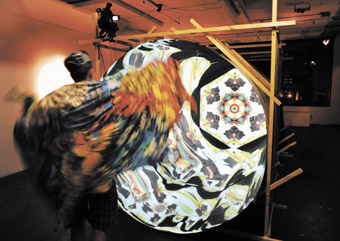
The Real Thing, photo courtesy the artist
When you peer into a kaleidoscope, into the mirrored surfaces on which tiny fragments of coloured glass spark and rattle, and raise the toy against the light, you don’t expect to see yourself. But in Sydney artist Jordana Maisie’s The RealThing, that’s what you get, the real you, captured by video and fragmented by soft and hardware magic into an infinite number of glorious mandalas.
Significantly Maisie’s work is on a human scale. The large screen facing you is contained in a deep circle of thin, bright metal, a camera hanging discreetly just above. Your actions become experimental as soon as you realise that the patterning on the vivid screen is evolving at the same rate as your own movement. You adjust relative to the camera. You discover that you can position hands, face, torso, objects with astonishing results, as surreal, temporary still lives or slow, lyrical dances.
Instead of the way you’d hold a kaleidoscope, in the Real Thing it’s the way you hold yourself, and far more interesting than, say, the fairground’s distorting mirrors. Here, Jordana Maisie the maker turns us into co-maker and subject at once. But it’s no mere narcissistic delight, because there’s no coherent mirroring of the self. Rather, we’re offered the perverse pleasure of dissolving and rearranging ourselves.
To see The Real Thing and to read about Jordana Maisie (she has a Masters Degree of Digital Media from Sydney’s College of Fine Arts and studied photography at the Glasgow School of Art) and forthcoming shows and collaborations, go to Studio.
Jordana Maisie, The Real Thing, sculpture, interactive video installation, Black & Blue Gallery,
Sydney, Aug 29-Sept 14; www.blackandbluegallery.com.au
RealTime issue #87 Oct-Nov 2008 pg. 33
© Keith Gallasch; for permission to reproduce apply to realtime@realtimearts.net
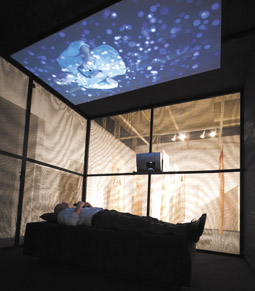
George Khut, The Heart Library Project: Biofeedback Mirror (2008)
photo Silversalt Photography
George Khut, The Heart Library Project: Biofeedback Mirror (2008)
AFTER NOT INCONSIDERABLE HARD TIMES, NEW MEDIA ARTS APPEAR TO BE ENJOYING NEW FAVOUR AND SOME RE-BRANDING. GROWING VISIBILITY, BIG PRIZE MONEY, SIGNS OF RE-GROWTH IN THE TERTIARY EDUCATION SECTOR AND THE EXPANDING INTERNATIONAL PRESENCE OF INDIVIDUAL AUSTRALIAN ARTISTS ARE SIGNS, HOPEFULLY, OF BETTER TIMES. EXPERIMENTA’S EXTENSIVE FORAYS ASIDE, EXHIBITIONS OF NEW MEDIA ARTS HAVE BEEN RARE, SO IT WAS EXHILARATING TO BE ABLE TO ENJOY MIRROR STATES, CURATED BY LIZZIE MULLER AND KATHY CLELAND, AT THE CAMPBELLTOWN ARTS CENTRE. IT’S A SERIOUSLY ENGAGING SHOW THAT OFFERS A RANGE OF INTERACTIVITY WITH NEGLIGIBLE MOUSING AND NOT A LITTLE PHYSICAL AND MENTAL ACTIVITY.
As for re-branding, the ‘new’ appears to have been clipped off ‘new media arts’ leaving us with the somewhat ambiguous ‘media arts’. Exactly who did the scissoring is not clear, perhaps it’s one of those meme things, but it’s certainly no fait accompli: the Queensland Premier’s National New Media Art Award is hanging onto the label with a $75,000 prize for the best work from a select group of artists. Certainly the argument about the ‘newness’ of new media arts has been long argued for and against, including on these pages. Those for ‘new’ argued that the constant inventiveness in electronic technology and art’s engagement and furthering of it justified the label; those against had seen it all before, all the way back through pre-digital multimedia, Expanded Cinema, Fluxus, Dada, Wagner…And then there were the new media artists who just wanted to be artists.
Although university courses are more likely to be titled in terms of electronic art, digital arts and still occasionally as new media arts, there’s a drift to ‘media arts’ in common parlance, encouraged doubtless by various kinds of platform convergence and the out and out digitalisation of the cinema. Media arts now encapsulates everything from photography to pre-cinema to film to video to gaming to Second Life to mobile phone and GPS art, and the big screens proliferating in public spaces across the world. [The international Urban Screens Conference is being held in Melbourne this month. Read Ross Harley’s report in RealTime 88.]
Meanwhile, film schools are pushing their media arts credentials. The Australian Film TV and Radio School (AFTRS), for example, has announced Graduate Diploma courses specialising in Game Design and Virtual Worlds, building, says Peter Giles, Director of Digital Media, on “AFTRS’ expertise in computer animation and interactive writing…coupled with our experience of rapidly prototyping digital content through our Laboratory of Advanced Media Production (LAMP).” The new federal film agency, Screen Australia (a merging of the Australian Film Commission, Film Australia and the Film Finance Corporation) has put out a statement of intent for public comment forecasting not just funding film but developing a broader notion of screen in a context of media convergence [www.screenaustralia.gov.au/soi].
For the $75,000 biennial acquisitive Premier of Queensland’s National New Media Art Award, nine artists have been short-listed: Peter Alwast (QLD), Julie Dowling (WA), Anita Fontaine (QLD/Netherlands), David Haines and Joyce Hinterding (NSW), Natalie Jeremijenko (QLD/USA), Adam Nash (VIC), Sam Smith (NSW), John Tonkin (NSW) and Mari Velonaki (NSW). It’s an intriguing range of artists, a broad notion of the field bringing together some recent converts to media arts alongside established practioners. The award exhibition will be on show in the Media Gallery, Gallery of Modern Art (GoMA) until February 8 next. The selection of artists was made by invitation and will be judged by Melinda Rackham (ANAT), Liz Hughes (Experimenta) and Tony Ellwood, Director QAG, while the $25,000 travel and study scholarship for an emerging new media artist living and working in Queensland was open to application.
There are other positive signs. ACMI’s Game On, a hands-on exhibition tracing the history of computer gaming, was a monster success, drawing record crowds. The Australia Council’s Inter-Arts Office pulled an unusual degree of media and online attention on the announcement of the successful applicant [the team of Justin Clements, Christopher Dodds and Adam Nash] for a residency in Second Life [see the interview with the Office’s Ricardo Peach on page 36]. Australia’s MAAP continues to work the Asia-Pacific region, participating in China’s Synthetic Times [see Dan Edwards’ report on page 32]. The Australian Network of Art & Technology offers artists key support through travel funding, workshops and its administration of the art-science program Synapse. Experimenta has upped the ante by titling its big touring shows as biennales. NSW’s dLux Media Arts has been particularly active in promoting the potential of locative media.
Meanwhile, Australian media artists roam the world, invited to major media arts events like Ars Electronica and ISEA [see reports on the 2008 festivals in RT88] or appearing in notable exhibitions. Recent travellers include Josephine Starrs and Leon Cmielewski with their new work, land [sound] scape (2008), chosen for the Guangzhou Triennial, China; Lynette Wallworth whose work has featured recently at London’s BFI and now the 2008 Melbourne International Arts Festival; and Transmute Collective, whose Intimate Transactions has taken them recently to the UK, Europe and USA [director Keith Armstrong’s Shifting Intimacies is reviewed on page 33].
If recent years have been frustrating for new media artists—watching ACMI turn predominantly to cinema before Game On, universities shutting down new media arts departments or forcing mergers with sometimes unlikely partners, the absorption of the Australia Council’s New Media Arts Board remit largely into the Visual Arts Board—things seem to be looking up. A more integrative vision is also evident. As Ricardo Peach makes clear, several of the Australia Council artform boards have partnered media arts projects and have individually addressed the potency of new technologies for their constituencies. I was pleased to be invited to launch the University of Technology Sydney’s Centre for Media Arts Innovation (see p42), which aims to work across disciplines and artforms within UTS and generate dialogue and ventures with sectors outside the university and the general public [www.communication.uts.edu.au/centres/cmai].
In Indigenous media art, the winner of the Wandjuk Marika 3D Memorial Award in the 2008 Telstra Aboriginal Art Awards, went to Nyapantapa Yunupingu, a Yolngu artist from Yirrkala, for her installation (natural pigments on bark, moving image) entitled Incident at Mutpi (see page 10). The filming for the work was done at Yirrkala’s new multimedia studio, the Mulka Project.
All these signs of new media arts life (Lyndal Jones’ RMIT Vital Signs conference in 2005 [RT 70, p35] in the wake of the demise of the New Media Arts Board had left not a few us fearing a fatality), not least a major media arts prize with ‘new’ in the title, suggest room for optimism even if the uptake of media art in galleries, proliferating video art aside, is still very slow. It’s good then to know that Campbelltown Arts Centre and GoMA are creating new benchmarks with a determinedly national approach (for a state premier’s prize) in GoMA’s case and a Pacific Rim one in Mirror States.
mirror states
Kathy Cleland and Lizzie Muller have drawn together works familiar and unfamiliar, all deserving of a wider audience. The spacious Campbelltown Arts Centre allows each work plenty of room to work its magic in a thematically rigorous show that seduces the viewer-participant into reflecting on their self perception with humour, trepidation and deep seriousness.
At the gallery’s entrance we are welcomed face to face by a video of the head of a ventriloquist’s dummy (from Bioheads, Anna Davis, Jason Gee, 2005-08). In appearance it’s a simple work displaying the usual mechanics of manipulation but, with restrained digital animation, the eyebrows seem to rise that little bit higher, the smile wider, the jaw deeper as the dummy intones deviantly mainstream self-help mantras: “I sing beautifully and am financially blessed”; “it is abnormal to be sick”; “poverty is a mental disease.” The extra animation touches and the eye to eye positioning of the screen make the doll just that little too real. You feel vaguely implicated, a tad grubby, for even staying to listen to the rubbish he spouts. That’s not me in the mirror, you hope.
Even more alarming, filling the main entrance, floor to ceiling, is a huge, long, pink inflatable finger, Sean Kerr’s Klunk, Clomp, Aaugh!—Friends Reunited (NZ, 2008). It seems to have a life of its own, but you work out fairly quickly that if you turn to two small screens with large black dot-like eyes, in the corner and gesture you can perhaps influence the rise and fall of this phallic toy —shocking inflation, too big!, and worrying deflation, almost flat to the floor. You want to turn to the nearby gallery staff and say I didn’t do it, but then you think, Did I? Is it giving us the finger for imagining we’re on top of the new technologies? Is it mirroring our foolishness, our wishful thinking?
Deeper into the foyer, Hye Rim Lee’s Powder Room (2005, USA/NZ) displays a face, seen from various angles, being digitally made over on four small circular screens. The face is analysed and gridded so we witness the precise topography on which changes will be wrought—the slow re-drafting and fattening of lips or re-working of eyebrows and nose. It’s clinical but leavened by familiar, cute Asian-style graphic art which almost, but not quite, guts the horror of the cosmetic surgery reality behind this ‘mirror’ evocation of a possible future self. This is not me, but it might be the kind of hypothetical modelling offered potential makeover customers. Things get weirder when we’re drawn to an adjoinging large room where, in Lash, a huge version of the face fills a circular screen, engaging us eye to eye, waves of soft colour emanating from behind the coiffure, head rolling, a gentle moaning and then eyelids fluttering with an accompanying, alarming machine gun ratatatat. This is mechanistic animation, but like the ventriloquist’s doll, there’s a disturbing sense of being regarded, played to, in the loop of being estimated, or seduced.
In a spare, white room, two wheelchairs lurk on a floor littered with paper strips—that’s it. No screens. Mari Velonaki’s Fish-Bird: Circle C-Movement B (2005), created with a group of roboticists, is by now an old favourite but still manages to surprise as these empty conveyances with apparent lives of their own seem to uncannily sense your movements as they follow, back off or turn away at the last moment: they seem to mirror your intentions and expectations. Meanwhile they’re pumping out messages to each other on small strips of paper which they dump on the floor or which we bend to gratefully receive as gifts from another intelligence. One printout suggests I’m being addressed directly: “Fish is not talking to me.” The desire to be mirrored by another (the phenomenological loop that builds and sustains our sense of self), even if by a wheelchair, makes for an experience both uncanny and self-critical.
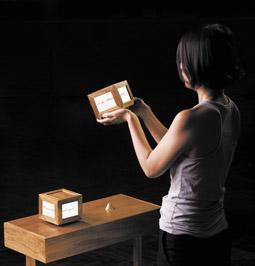
Mari Velonaki, Circle D: Fragile Balances (2008)
photo Silversalt Photography
Mari Velonaki, Circle D: Fragile Balances (2008)
In a nearby room, the wheelchairs have been replaced by doppelgangers, two immaculately crafted timber boxes with crystal screens on four sides (Circle D: Fragile Balances, 2008). You pick one up and, as you gently turn the box around, writing unfolds in a similar style to the wheelchair printouts. At the same time you glimpse responses on the second box as a lateral, poetic conversation unfolds. It’s like coming across an expensive Victorian pre-cinematic toy that’s been digitalised. It’s an odd, and again implicating experience, holding an intelligent box as it writes, “If our eyes should meet, what would we have in common?” Exactly. Mari Velonaki is one of the contenders for the Queensland Premier’s New Media Arts Prize, so this work will be on show at GoMA.
I’ve also seen Alex Davies’ Dislocation (2005) before, but again it’s surprising to find your perceptions nonetheless tossed about as you bend to peer into one of four small peephole screens that reveal the room behind you. Suddenly, on the screen, someone enters—other gallery goers, a guard and a dog, variously indifferent, affable, vulnerable and perhaps dangerous—but, you turn quickly, to find there’s no-one there. The screen is an unreliable mirror. You wonder how you’ve triggered these ghostly intruders.
Canadian David Rokeby’s Giver of Names (1991-2004) is an even stranger experience. Brightly coloured toys litter the floor. You arrange them on a plinth. A camera and computer read your arrangement and interpret and transform it onto a screen above, thickening and varying the colours quite beautifully. Meanwhile the computer is converting its sense of the image into extremely lateral text, readable on another screen: a rubber duckie on the plinth becomes “that is the mountain girl.” This is no mere mirror of our actions rendered interactively, but an evocation of the challenges and limits of translation.
The closest we get to something like a true reflection is John Tonkin’s time and motion study (2006), the latest version of which will also appear in the New Media Art Prize show at GoMA. In a long, narrow, dark room you move towards a screen (and camera above it) on which fragments of a row of overlapping faces are fading and over which your own multiplies moment after moment, in portraiture of now and now and now and before, before, before…and, as you shift before the lens, now again. As in the Rokeby, there’s an absence of literal translation, the imagery is dark, grainy, not distorted but curiously Francis Bacon-like, each duplicated face locked into a kind of rictus in an infinity mirror, trailing light years away.
If George Khut’s previous works (Drawing Breath, 2004-06 and Cardiomorpholgies, 2004-07) have allowed the heart beat and breathing of individual participants to modulate his visual and sonic imagery, this new work, The Heart Library goes much further in transforming states of being into artistic mirrorings and with greater audience-as-co-maker participation. The visitor retires to a gently darkened space, stretches out on a cushioned platform, holds a sensor in each hand and encounters themself, life size, on a screen above. The pace of the heartbeat yields a flow of snow or blossom-like drift over the body and changes in colour and sound—for some participants the variation is subtle, for others relatively dramatic in intensity.
On leaving the space, you enter another hung with full-scale drawings by participants reflecting what they’d just experienced. A number are distinctive artworks and all are revealing about where people see their bodies centred or off-balance, wounded, anxious or enjoyed. Khut and collaborators (Caitlin Newton-Broad, Greg Turner and David Morris-Oliveros), have video-ed some of these drawings and recorded the makers explaining them. These, with headphones, are available on small wall players. The notion of a new kind of library is fully and immersively realised, and goes a step further in its offer of creativity. The artist Khut provides the framework within which others can make art of their bodies and their perceptions. As Anneke Jaspers writes in the Mirror States catalogue, “…the addition of a social dimension reconfigures interactivity within an inter-subjective rather than strictly technolgical framework.” We feel of works of art we like that they mirror something about us, even if we don’t like what we see, but in The Heart Library we are the actual subject of the work. Our heart beat turns us, thanks to Khut’s artistry, into co-maker while being audience to our own experience. Those who draw and speak become interpreters of that making. The hung paintings and screen recordings are left for others to share and compare as the mirroring multiplies.
Mirror States, curators Kathy Cleland, Lizzie Muller, Campbelltown Arts Centre, Sydney, July 18-Aug 24; MIC Toi Rerehiki, Auckland, New Zealand, May 16-June 28
RealTime issue #87 Oct-Nov 2008 pg. 34
© Keith Gallasch; for permission to reproduce apply to realtime@realtimearts.net
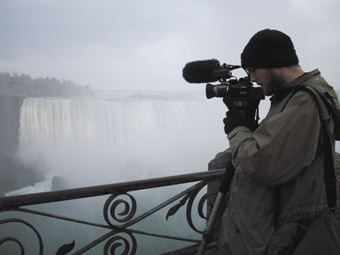
Dan Monceaux, Niagara Falls 2007
THE OPENING MONTAGE OF DAN MONCEAUX AND EMMA STERLING’S SUPERMARKET IS FULL OF FAST CUTS, STARS, LIGHTS AND CARS, DOUBLING AND REPEATING. A SEQUENCE OF NIGHT-TIME CITYSCAPES TURN AROUND THE SCREEN. THE FOOTAGE SHIFTS FROM FILMIC TO THE OPEN SHUTTER BLUR OF VIDEO. LINES OF COLOUR SLOWLY DRAG ACROSS THE FRAME. LIVE FEED OF MONCEAUX’S HANDS, MIXING THE SOUND, DISSOLVES BRIEFLY IN AND OUT OF THE SCENE. THEN WE’RE TAKEN ACROSS A BRIDGE, MOVE INTO A TUNNEL. THE TITLE, IN THICK BLACK RETRO FONT, CROSSES OVER A LARGE WHITE SPACE. BLACK AND WHITE GEOMETRIC PATTERNS TAKE OVER. THERE’S A CROSS-SECTION OF A BRAIN, LIKE AN X-RAY. BUBBLES FALL. THEN A WARNING THAT THE FILM MIGHT CAUSE INDUCE EPILEPTIC EPISODES CUTS HARD ONTO THE SCREEN.
These eclectic media are driven by the audio beat: electronic music composed, performed and mixed by Monceaux. Meanwhile a male narrator, like documentary’s ‘voice of god’ and in a style reminiscent of cinema advertising and infomercials, informs us that Supermarket “speaks up for consumer interest…supplying several million people with the truth”, “for men and women in all walks of life.”
Supermarket unfolds as a series of chapters, or sections. Early on I’m wondering what will hold them all together. Even though it is described as non-narrative the approach to genres and styles fragments the work. There are a number of Monceaux-Stirling vignettes. One section comprises numerous shots of people wearing uggboots framed to cut off the person at the knees, keeping identities censored, or avoiding, like television news, the need for permission to shoot. At best the uggboot works like a ‘quirky’ homage to American avant-garde ‘catalogue’ films. This chapter is followed by a romantic comedy, shot on Super 8 for Shoot the Fringe. It tells a story about two balloons meeting in The Garden of Unearthly Delights. While a sweet interpretation of falling in love, its classical narrative form stands out amongst the otherwise experimental use of footage.
“Men and women from all walks of life” are presented to the audience through a combination of archival and borrowed footage. However, unlike, say, Tracey Moffatt’s Love (2003), which liberally takes from Hollywood, Supermarket doesn’t appear to have a sense of direction. Early on there is a sequence of images that runs approximately in this order: an Aboriginal man hunting with a spear, kangaroos, the face of a native American, an eagle, a bull running, snow on branches, time-lapse footage of Uluru, and smiling black children who wave at the camera. Are the artists calling into question the ethics of representation or are they unconsciously contributing to a colonialist perception of Aboriginal people? And what about the generalising association the sequence makes, likening the indigenous peoples of Australia with those of America?
Other sections of Supermarket either rely on audience cinematic memory or assume that the audience doesn’t have any. Scenes from Picnic at Hanging Rock (1975), 1970s martial arts and other films are re-cut. While the artists are perhaps concerned with deconstructing authorship the sequences seem to bear no relationship to an overall theme, except to say that everything can be accessed and is all available for consumption.
In keeping with the tradition of experimental filmmaking, Monceaux and Sterling do take risks. Supermarket has been created under the radar. It’s low budget, asynchronous and amorphous. It’s openly in development, always in flux, and this allows the artists plenty of room. At times Supermarket offers images that stand alone as remarkable moments. It is worth noting that the filmmakers come from a visual arts background and their documentary, A Shift in Perceptions (2006), about the experiences of three visually impaired women, has done very well in both national and international film festivals [RT75, p50].
It’s ironic that the makers of Supermarket claim to comment on the emptiness of consumerism and yet present their work in some way as a ‘must have’ consumer event. Perhaps that’s the incongruity of making art about society valuing the superficial while needing to market the work to secure an audience. Or if irony is part of the artists’ intentions why am I am still wondering what I’m missing from the Supermarket experience? If, as Monceaux explains, their objective is “not to sell you anything substantial, just the image of an empty shopping trolley”, then it fulfils its sales pitch, paradoxically leaving the audience with the same old consumerist dilemma.
South Australian Living Artists festival: Supermarket, artists Emma Sterling, Dan Monceaux, camera, editor Emma Sterling, music, sound Dan Monceaux, producers Emma Sterling, Dan Monceaux; Mercury Cinema, Adelaide, Aug 9
RealTime issue #87 Oct-Nov 2008 pg. 35
© Jessica Wallace; for permission to reproduce apply to realtime@realtimearts.net
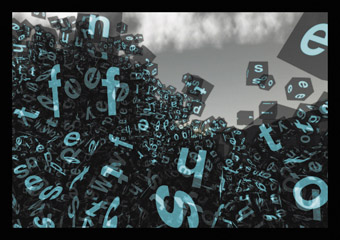
Babel Swarm
RICARDO PEACH IS THE PROGRAM MANAGER FOR THE AUSTRALIA COUNCIL’S INTER-ARTS, OFFICE. PEACH IS AN ENGAGING MEDIA ARTS ENTHUSIAST WHO HIMSELF ENJOYS A SECOND LIFE. WE MET TO DISCUSS HOW, IN 2007 THE AUSTRALIA COUNCIL FOR THE ARTS BECAME THE FIRST NATIONAL ARTS FUNDING BODY TO FUND AN ARTIST RESIDENCY IN SECOND LIFE. THE WINNING TEAM, WRITER JUSTIN CLEMENS, VISUAL ARTIST CHRISTOPHER DODDS AND SOUND ARTIST ADAM NASH CREATED BABEL SWARM, A NETWORKED PROJECT LINKING PEOPLE IN REAL LIFE WITH AVATARS CREATING AN IN-WORLD, REALTIME 3D SCULPTURE BUILT FROM THE SPEECH OF PARTICIPANTS. THE MEDIA RESPONSE AND PUBLIC INTEREST WAS WAY BEYOND EXPECTATION.
Although the Australia Council doesn’t have any Second Life property, it has ‘borrowed’ space from the likes of the ABC and the Australian Film Television and Radio School, allowing it to conduct an in-world media campaign, in-world client meetings, in-world artist matchmaking and the first in-world grant assessment meeting. The virtual gets real-er all the time.
What made the Inter-Arts office take up the Second Life challenge?
We’re keen to support those practices that would otherwise fall through the funding gaps between the artform Boards, and interested in what Adam Nash calls “post-convergent” art. I’m not quite convinced about the term yet but it’s about spaces opening up room for practices to flourish that are not limited to the physics of the natural universe.
Getting past conventional representation must be a challenge for artists making work in Second Life?
Yes, it’s a kind of parallel ‘real’ world for many people, and it’s cheaper: you can buy virtual Gucci shoes for five cents rather than paying a million bucks. But in terms of aesthetics, there’s a huge potential to shift things. So we thought why don’t we support the emerging practices that are already testing Second Life and other spaces. There was already a cluey and energetic art culture happening there and Australians seemed to be engaged in it from the beginning.
So Inter-Arts has played a triggering role?
That’s what we aim to do, to make potential practices visible and then other artists become more aware of it as well. So it’s about finding ways, with small amounts of funding, to support emergent practice.
Because Second Life is cheaper than real life, does this mean you don’t need to invest quite so much money?
It’s a helluva lot cheaper. But in fact it was the largest grant that artists have received for such a virtual platform. It was $20,000 for up to three Australian artists to develop a project that used the disciplines of literature or writing, sound art or music and a digital visual practitioner. The Music and Literature Boards and the Inter-Arts Office funded the project collaboratively. It was an interesting collaboration within the Australia Council itself.
Were there funding criteria beyond making the work, for example how it might be exhibited or broadcast?
One we built into the grant itself was for the applicants to create some form of mixed reality showing or event where people who weren’t necessarily conversant with these virtual platforms could experience the new spaces for themselves. It was about making people aware of the potential of the platforms and assisting those who might be technologically phobic, or just not into these spaces, to at least have access. The artists collaborated with Lismore Regional Gallery so that a regional centre had the first mixed reality showing of the Second Life initiative. Lismore farmers mixed with the directors of Eye-Beam [new media arts centre] in New York as Babel Swarm evolved in the gallery.
Virtually and actually.
Well, you know, there’s no difference. There were people in the gallery and people online from various places interacting, avatars ‘flying in’ from wherever and the people in the gallery space with access to a few generic avatars. They could access an avatar and then interact with the other avatars from Tokyo or New York. The artists cleverly developed the event in three stages. The first was like a traditional gallery approach with images, photographs and text. The second space, on screen, was machinima: a filmic version of the artwork. The third space was where people were engaged interactively in real time with Babel Swarm and with other avatars.
The people at the opening were creating Babel Swarm in the process of interacting with it. This is something very interesting about the project—it’s user-generated. The words people spoke or typed into the space were the same words that create the work’s sculpture as the letters fall from the sky in the Second Life lansdcape. It’s beautiful metaphorically as well. There are many layers and I’m sure I haven’t touched on all of them yet. After the letters fall, they start searching for each other but avatars can destroy them and once destroyed they have no chance of becoming whole again, becoming one with other letters.
A strange kind of ecosystem. You’ve described Babel Swarm as “sculptural.”
Others would call it musical because there’s a very complex sound aspect to it and the sounds are triggered by the letterforms. So, depending on people’s preference—I’m very much visually oriented—but people who have a sound or literary orientation would perhaps read it in a different way.
What might the literary people get out of it, do you think other than the joy of seeing letters?
There is a growing understanding that literature is more than poems or novels, that literature is a practice that’s living and that people interact in other interesting ways through words. There are probably writers watching their text fall and interacting in a dialogue about the ways words and letters can impact on each other.
The gallery audience loved the experience and so did the in-world audience and participants—there were more than a thousand visitors at the time.
What do you think is the future of this initiative?
It will depend on the type of artists and their interests. I think there’s probably a lot of room for performance art as well, which doesn’t necessarily require the huge technical skills which artists like Nash and Dodds need to code the letters in Babel Swarm and make sure they connect. A key thing is that this practice engenders a collaborative approach. If artists are not necessarily confident within the virtual space they can collaborate with somebody who knows more about it and maybe thinks about that space in a different way. That can be very productive. One of the processes we developed for this initiative was a matchmaker or collaborator blog where we put artists in contact with each other, not just the technically proficient. So it’s an ideal space for collaboration.
Has there been a new phase of the initiative?
Another one emerged from the Second Life initiative called MMUVE IT!, a Massive Multi-user Virtual Environment Initiative. There was a recognition that the next step would probably be an embodied computer-human interface, a little bit more complex than, say, the mouse or the keyboard. There are a lot of new interfaces being developed in areas like gaming: alpha waves or 3D motion-tracking cameras allow people to move their bodies and therefore their in-world avatars.
The successful artist team for MMUVE IT! is Trish Adams (RT84, p31) and Andrew Burrell who’ll be working with the Queensland Brain Institute to develop a project called Mellifera (http://mellifera.cc), working with sound and with bees to help people manipulate, interact with and develop ecosystems in a virtual space via their avatars and their bodies. It will explore cognitive processes and bodily interaction and their relationship to virtual environments. They’ll use Second Life and the work of an Australian start-up company called Vast Park where you can have your own virtual world and connect to other virtual worlds.
More parallel universes!
So rather than having your own island, there’ll be a galaxy of virtual worlds. What Inter-Arts wants to encourage in our next round, closing December 1, is work that can engage with mixed reality settings but also more locative media based works—mobile phones, GPS—different ways of interacting in public spaces. It doesn’t always have to be technology based but some of it will be. And we’re also interested in user-generated content, a growing area, that reduces the audience-artist dichotomy with the audience being involved in the creation of the artwork. The Second Life and MMUVE IT! initiatives are designed to generate interest and activity, but our key focus is still on the grant rounds where artists apply with great ideas for works.
How successful was the promotion of Babel Swarm?
It was extraordinary. It took us all by surprise. It was great to be on the crest of the wave. I think it’s to do with the social networking phenomena that has emerged over the last few years. People are now more comfortable with being in these virtual spaces. They’re like 3D chat rooms—3D MySpace or 3D Facebook. There are people who say these spaces are destroying social skills but these are places where you can blossom and you’re not going to be killed or become a social pariah, not for long anyway. You can always come back in another avatar and make new friends.
The media and public response to the Babel Swarm launch was extraordinary. It got the highest hit rate of any initiative that the Australia Council marketing team has developed to date. I think one of the keys to its web success was that there was international interest. It was an interesting to see the potential of social networking sites in terms of art practice. In hindsight I’ve labelled these practices Social Media Arts—a combination of Media Arts and Social Networking. It’s not just the form of the art and the new means of expression but the huge networks they’re connecting to. That’s new, I think.
What have the other artform boards of the Australia Council taken on in this area?
The Literature Board, through Stories of the Future, had some great Second Life and other digital initiatives in its promotion of digital publishing over three years. It included the mixed reality event Mix My Lit at Federation Square where V-Jays and Lit-Jays were mixing their sounds and images and texts that the public were texting them onto the screen and their little stories were being mashed. So there is no distinction between “this is what literature is” and “this is what visual art is.”
The Visual Arts Board funded dLux Media Arts to do a whole range of machinima and Second Life initiatives, including tours in Second Life. The Music Board and the Literature Board were already on board with this. The MMUVE IT! initiative was a collaboration between the VAB and the Inter-Arts Office. I think that’s one of the most successful aspects of these initiatives. You have emerging practices, collaboration across artforms, breaking down barriers and giving artists the opportunity to seek support for work they may not be able to apply for in one particular board.
Post-convergence funding. What about the issue of facilitating participation and development in regional areas?
We’re learning from artists, as we did with the Babel Swarm-Lismore Gallery collaboration, where they saw a need to develop these projects in regional Australia. We’re not developing specific initiatives here yet but we are looking at how we can facilitate it with other boards or initiatives to incorporate regional possibilities in the projects they’re developing.
The Inter-Arts Office part funded a project with urban and regional dimensions called A-lure by Visionary Images completed this year in Melbourne, Shepparton and Richmond where socially disadvantaged young people worked with media artists to develop locative media games within the City of Melbourne.
Is Council looking at the potentials of multiplatforming?
At the international Urban Screens event that’s happening in Melbourne (Oct 3-5) Council supported a focus on the re-purposing of interactive work, perhaps initially staged in a small space, so that it can be made public in a large urban context. We also assisted MEGA (Mobile Enterprise Growth Alliance) to develop some projects to teach artists how to link with business to get their content out there on the mobile phone platform—a huge market’s emerging and one of the most lucrative markets as well. We also have a major partnership with the ABC to assist in the broadcasting of work made by Australian artists.
As technological developments in media continue to accelerate and arts opportunities multiply, the Inter-Arts Office’s R&D alertness is a valuable resource for artists working on landscapes real and virtual and, not least, un-signposted.
RealTime issue #87 Oct-Nov 2008 pg. 36
© Keith Gallasch; for permission to reproduce apply to realtime@realtimearts.net
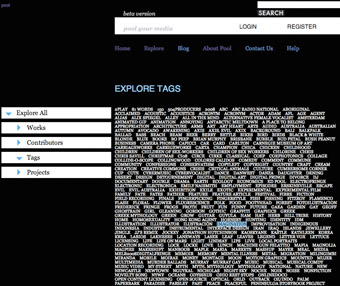
screenshot of Pool website – tag search
THE RISE OF WEBSITES LIKE YOUTUBE AND FLICKR HAS MADE THE SHARING AND REMIXING OF CONTENT MORE MAINSTREAM AND MORE CONTROVERSIAL THAN EVER. REUSE AND REINTEPRETATION AREN’T JUST FOR ABSTRUSE FRINGE-DWELLING SITUATIONISTS AND GRANT-UNWORTHY CRAFTS LIKE SCRAPBOOKING. CULTURAL APPROPRIATION IS THE CURRENCY OF A NEW, FASHIONABLE GENERATION OF VERY MAINSTREAM INTERNET USERS. IT IS ALSO THE GROUND ZERO OF A PROTRACTED DISPUTE ABOUT THE NATURE AND OWNERSHIP OF INTELLECTUAL PROPERTY THAT ENGAGES MEDIA ORGANISATIONS, ARTISTS, GOVERNMENTS, COLLECTION AGENCIES AND THE GENERAL PUBLIC.
Into this disputed territory steps the ABC’s pool.org.au, a project that invites and fosters reuse of digital art. In the short time since the launch, the site has been populated with a fascinating array of content spanning the full spectrum between kitsch and inspired, unfinished samples and well-produced remixes and reworkings. There are already some familiar names uploading content; at a cursory inspection Alan Lamb and Jim Denley, and from within the ABC, producers Nicole Steinke and Gretchen Miller seem positively active. It’s not the only such experiment launched of late—the textually-oriented, Australia Council-backed Remix My Lit project has been making a splash in the blogosphere. The ABC has also made tentative gestures in this direction before with small creative reuse projects, such as the Night Share and the Orpheus Remix Awards.
But while the style and form of a social media site might be familiar to internet users in 2008, the institution behind this one is not your typical Facebook or Yahoo, nor is it an entrepreneurial startup. Why this sudden adventure into potential anarchy by the ABC? Are we seeing a public broadcaster relying on volunteers to make up a shortfall in content? Or an adept and thoughtful attempt to respond to the social media zeitgeist? Is it so very different to Australia Talks Back, and is it any more interesting?
I interviewed two of the project’s instigators, Sherre Delys and John Jacobs, about the venture and its origins. What follows is excerpted from those two interviews. Starting with the question: where did the idea for the pool come from?
pool evolution
Sherre Delys: The pool has [evolved] from an idea around since before YouTube—the idea of sharing and remixing. It’s only recently that we’ve been able to make the case to the ABC that this kind of thing is worth getting involved with. It’s an experiment with the role of a public broadcaster.
John Jacobs: There’s a lot of different ideas going into the pool. It’s a petri dish, it’s got culture in, it’s growing, and we’re all sticking our finger and licking it occasionally.That culture we’re growing is going to inoculate the ABC against becoming a fossilised media organisation…It’s R&D, to see what public media might be, in a networked, social media future. Public media have historically been cultural gatekeepers, representing people back to themselves…A networked social media thing could be the public media of the future…ABC workers have certain skills—we’re employed to “do” media for the people, if you like. I think there’s a role for the people to be paid by the government to help administer and facilitate a social network space.
why the abc?
Dan Mackinlay: What does the ABC getting involved in social media offer to the users that they would not get from, say, just filesharing on YouTube, or Facebook? And how about the criticism made of YouTube—that this “user generated content” is a cheap way to get media produced by volunteers while providing little in return?
SD: There’s a lot of answers to that. For one, we’re constantly concerned about giving back to our users. We’re organising production advice and resources—some of our projects get ABC studio time for pool users. We get exposure for people’s work, and provide a trusted brand and a non-commercial context, an advertising-free context. We don’t have to behave like a YouTube and work out how to make money out of it.
If it’s what users want we have resources to assist making that transition from ‘am’ to ‘pro.’ We’re curating works on the site. We have radio producers sharing their experience. You’ll see that Street Stories has started a project up—and at least one job at the ABC has come out of it already. We have a strong moderation process, a lot of skilled time goes into it, bringing out high quality results. It’s not at all one way.
copyright: issues & options
One part of the pool that has drawn a lot of attention has been the copyright regime. The pool allows works to be submitted under a variety of Creative Commons Licences, some of which allow legal re-use of the content without royalties to the artist who created it.
DM: As it currently stands: when you submit content to the site, you choose what licence to place it under. This can be either a Creative Commons licence, or not, and there is also a voluntary dual licence to allow the ABC to rebroadcast.
SD: We see it as providing a variety of options. So if you upload a low quality version of the work you might want to licence that with a very open licence to allow it to be distributed, to raise your profile. And you might reserve a high quality version for commercial use. It’s completely up to an artist and what their goals are with a given work.
DM: As far as I can tell, in the latest iteration of the relationship between [musical royalties collection agency] APRA and Creative Commons Licences, APRA argues that their collection contract is technically incompatible with Creative Commons. But they also acknowledged at the Music Industry Forum last year that a huge number of their members are actually using Creative Commons Licences, and they conceded that they would not to sue their own members…It’s definitely a grey area. Is there awareness of that among the users?
JJ: Absolutely, it’s come up. A lot of APRA members have been concerned about that…There’s compromise needed and the players are at the table working it out, but there’s a long way to go.
It’s time to think carefully about your rights, and not just allow other people to make the decisions for you. When you see the pull down boxes and all the different types of licences, it’s time to read the fine print. We’re already seeing artists becoming their own labels, putting their stuff out there, becoming experts in all sorts of areas, production, instruments. We know lots about lots of different fields; it’s time to know about rights management.
DM: One thing pool does is make really clear which licence the uploaded work has, what you can and can’t legally do with it. I’m assuming that’s part of the intent—a safe space for reuse of material? I notice you can also see which other works a piece derives from.
JJ: [Attribution] has got to be easy. If you are a remix advocate, like myself, that’s part of your responsibility. And so, on pool we have a first baby step in that direction—that is the ‘derived from’ field, you have a menu of [works] in the database…That’s a start, but it should be so much easier. And it will be.
everyday pooling
For my part the pool project is a hard one not to like; the effervescent excitement amongst the site users is more response than I’ve seen to an ABC project before, and all this without the usual high budget trappings and drum beating that kicks off, say, a new TV show. The budget didn’t even run to a catered launch. In the absence of an offer of celebratory canapés on the public purse, I consoled myself with a trip to the MCA show in the Biennale of Sydney.
In the dying days of that festival the galleries seemed more crowded than usual, and more full of miscreants. Those most mischievous of Sydney-dwellers, the mobile phone owners, were out in force with their illicit happy snaps of the works, keeping the gallery attendants busy. I had most sympathy for the gent getting himself shooed off Tracey Moffat and Gary Hillberg’s REVOLUTION. The didactic panel explained that this video work was proudly constructed from unlicenced samples of commercial works. That did not help the attendant make her plaintive case that this gentlemen could not in turn take photographs of those stolen frames of video. It’s gallery policy, you see.
www.pool.org.au
www.abc.net.au/classic/orpheus/
http://remixmylit.com/
http://creativecommons.org.au/
www.viscopy.com
www.screen.org/
www.copyright.org.au/
www.apra.com.au/
RealTime issue #87 Oct-Nov 2008 pg. 37
© Dan MacKinlay; for permission to reproduce apply to realtime@realtimearts.net
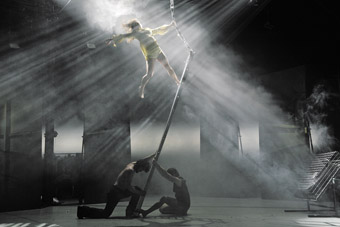
Menske, Ultima Vez
photo Martin Firket
Menske, Ultima Vez
DANCE KEEPS VIENNA BUSY FOR FIVE LONG SUMMER WEEKS, EVERY CORNER OF THE CITY DOTTED WITH GLOWING BALLOONS, ENDLESS OPEN-AIR PARTIES AND GRACIOUS BOYS AND GIRLS ON PINK IMPULSTANZ BIKES. EUROPE’S PREMIER DANCE FESTIVAL, IMPULSTANZ IS AN ARTISTS’ BUSINESS, NOT ENTERTAINMENT FOR THE TAXPAYER, ITS INDEPENDENCE VISIBLE NOT ONLY IN THE MERCIFUL ABSENCE OF POLITICIANS’ ADDRESSES, BUT, PRIMARILY, IN THE CENTRAL ROLE THAT EDUCATION, DISCUSSION AND RESEARCH HAVE IN THE PROGRAM.
Established in 1984 by Karl Regenburger and Ismael Ivo as a vehicle for development of contemporary dance in Austria, ImPulsTanz introduced its performance component in 1988, and now boasts over 200 dance workshops, an extensive scholarship program, a young critics’ forum and this year’s first Prix Jardin d’Europe for emerging choreographers.
European dance, however, is not an unequivocal affair. With walls between performance art, theatre and dance long breached, many an overseas visitor is seen stumbling baffled out of a performance: ‘Can this be called dance at all?!’ Much of the focus (despite the enormous individual differences between choreographers) is on disrupting and dismantling the relationship between the performing body and the world at large. Instead of what André Lepecki calls the “anatomical self-experimentation” of modern dance, complicit with modernity’s restless drive towards mobility, its kinetic excess, the Viennese dancer refuses to be a “dazzling dumb-mobile”, rebels through stillness and speech, ugliness and failure. In a time when the body has become the central fixation of Western politics—detained, surveilled, displaced, dutifully exposed or wrapped in shame, focus of ethnic hatred and identity anxieties—contemporary dance in Europe strikes me as unmistakably political.
ultima vez
Even the standing room only tickets have sold out, and the raging mass of disappointed kids looks like they may start a riot: the atmosphere before Ultima Vez’s performance is akin to a rock concert. Choreographer superstar Wim Vandekeybus’s company has toured the world with their trademark vocabulary of acrobatic, extreme, often violent movement, soaked in multimedia and energetic music. Menske (meaning approximately ‘little human’), their latest work, has all the typical flaws and qualities of classic Vandekeybus. On the conservative end of political intervention, Menske is an explosive concoction of brash statements about the state of the world today, a sequence of rapidly revolving scenes of conflicting logic: intimist, blockbuster, desperate, hysterical. The broad impression is not so much of a sociological portrait, but of a very personal anguish being exorcised right in front of us, as if Vandekeybus is constantly switching format in search of eloquence. Visually, it is stunning, filmic: a slum society falling apart through guerrilla warfare, in which girls handily assume the role of living, moving weapons. A woman descends into madness in an oneiric hospital, led by a costumed and masked group sharpening knives in rhythmic unison. A traumatised figure wanders the city ruins dictating a lamenting letter to invisible ‘Pablo.’ Men hoist a woman on a pole her whole body flapping like a flag. “It’s too much!” intrudes a stage hand, “Too much smoke, too much noise, too much everything!” And the scene responsively changes to a quiet soliloquy. At which point, however, does pure mimesis become complicit with the physical and psychological violence it strives to condemn? Unable to find its way out of visual shock, Menske never resolves into anything more than a loud admission of powerlessness.
robyn orlin
South African Robyn Orlin’s work is political in the broadest sense: in dialogue with culture, history and identity in the post-apartheid, attentive to the politics of representation, she regularly brings the untouchable on stage and unleashes it on the audience. Her Dressed to kill…killed to dress… is neither subtle nor immediately likeable. It is, in turns, in-your-face, obnoxious, sentimental, playing for cheap laughs, gaudy; and yet enormously compelling and rather smart. We are invited to judge in a ‘swenking’ competition, a lovingly presented South African quirk: the fashion competitions of migrant workers in Johannesburg, sometimes with prizes in money, watches or even livestock. Personal style is displayed in a softly graceful sequence of movements: wrist to ankle, tie to watch, jackets flung over the shoulder. This mesmerising dance is coupled with video presentation of each swenka’s real-life world: workplace, family, the street, the city. Meanwhile, glimpses of newspaper headlines announce “Hidden Cost of Power Cuts.” Familiarising an exotic strangeness to the point of banality, then making it strange again is no small feat for an hour-long performance. Descending into mayhem of images, Dressed to kill… becomes first a confrontingly trivial dissertation on consumerism (MC Rafael Linares sighing, “Hugo Boss! Prada! Gucci!”), but then warps into a devastating picture of blind narcissism and cultural loss: the suits deconstructed into war costumes in ominous pink, music violently blaring, the ensemble breaking into the audience to hysterically demand a winner. It is neither cute nor quaint anymore.
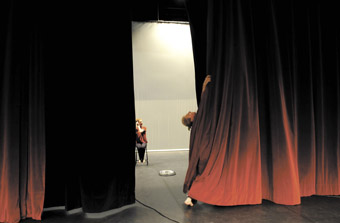
Gustavia, La Ribot & Mathilde Monnier
photo Marc Coudrais
Gustavia, La Ribot & Mathilde Monnier
mathilde monnier & la ribot
The most extraordinary performance, however, is Mathilde Monnier and La Ribot’s Gustavia, a sharp and intelligent exploration of female identity abused through physical violence, prejudice, the imperative of silence, prescribed emotions. “After these tears are shed”, Monnier announces weeping, “all feminine in me will be gone.” On a cocoon-like stage, wrapped in black cloth, intimate and chokingly oppressive, unfolds a bleakly literal, demystified burlesque in which highly sexualised women humourlessly step into pails, fall, receive slapstick blows. Monnier, repeatedly hit in the face with a gigantic plank, collapses and obediently rises again, frail and unsteady in high heels and a skin-tight leotard. In the triumphant final scene, the two performers populate the stage with a menagerie of strange and familiar creatures, employing only a torrent of words and growingly frantic gesticulation: “a woman has ears with trees inside!”; “a woman has thighs cut with a chicken here!”; “a woman has small breasts which fit inside her bra!”; “a woman sews her hymen to get married!”; “a woman in the dark.” Hysterical laughter and horror collide to great effect, and political side-taking never smothers superbly executed formal inquiry. Nothing is superfluous in Gustavia, which proves that it is possible to be topical without falling into cliché.
2008 ImPulsTanz: Menske, direction, choreography, design Wim Vandekeybus, music Daan, creation, performance, script Ultima Vez, artistic assistance, dramaturgy, Greet Van Poeck, Museums Quartier Halle E, July 21, 23; Dressed to kill… killed to dress…, choreography Robyn Orlin, performance City Theater & Dance Group, video Nadine Hutton, Akademietheater, July 11, 13; Gustavia, choreography, performance Mathilde Monnier & La Ribot, lighting design Eric Wurtz, Akademietheater, July 15-18, ImPulsTanz, Vienna, July 10-Aug 10, www.impulstanz.com
RealTime issue #87 Oct-Nov 2008 pg. 38
© Jana Perkovic; for permission to reproduce apply to realtime@realtimearts.net
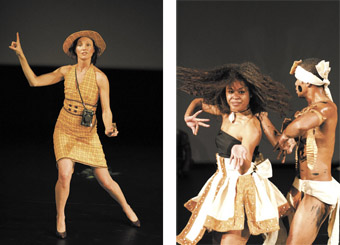
left – Leah Shelton, Polytoxic, right – Vou Dance Company
photos Fiona Cullen
left – Leah Shelton, Polytoxic, right – Vou Dance Company
THE TOWERING SOUNDSCAPES OF BABEL INVARIABLY HAUNT EVENTS THAT ASPIRE TO A LARGE-SCALE EXCHANGE OF HUMAN IDEAS. AS AN ANTIDOTE TO ANTICIPATED COMMUNICATION MELTDOWN, 21ST CENTURY MANAGEMENT EMPLOYS TACTICS LIKE OBEISANCE TO THE FAIR PLAY OF RHETORIC TO DEFLECT CONTROVERSY AND CHAOS WHICH CAN, UNINTENTIONALLY, GENERATE PASSIVE LISTENING RATHER THAN EXCHANGE. THIS UNINTENTIONAL PARADOX IS OF THE SAME ORDER AS THAT POSED BY CULTURAL COMMENTATOR, RUSTOM BHARUCHA’S PROVOCATION: “DO THE IDEAS OF THE LIBERAL THINKER IN OUR SOCIETIES NEED TO BE QUESTIONED?”
In some respects, Bharucha’s question was a throwaway line, dropped like a pebble in the hushed auditorium of the Cremorne Theatre to prick the indignation of Babel, but it fell that night without so much as a splash. Where was the rabble-raising such a question was crafted to sting? Admittedly, it was a relief that war was staved. But what about the dialogues, conversations between opposing ideas, exchanges in diversity?
Such musings arise not in criticism of the mighty effort from Associate Professor Cheryl Stock and Janelle Christofis (Ausdance Queensland) and the extraordinary team of associates and volunteers who made the event sparkle, but to wonder why the dialogues at the heart of the World Dance Alliance Global Summit and its vision of “Conversations across cultures, artforms and practices” sometimes faltered.
The World Dance Alliance was born from Carl Woltz’s belief in the capacity of dance artists, educators and scholars to transcend difference and present a richly varied and united front to the world. Hatched in the Hong Kong Academy of Performing Arts, Woltz’s idealism spread through the Asia Pacific region, the Americas and Europe, forming a loose coalition of like-minded people who wished to promote the significance of dance in human affairs. Annual meetings, propelled by the key training organisations’ desire to share their physical achievements, gave way to greater visions of what dance on the world stage might mean. Cutting a complex history short, that is where Brisbane stepped in to host the 2008 Global Summit, proposing an institutional ‘coming-of-age’ which privileged the ‘voicing’ of artists, educators, scholars, administrators, producers and critics’ practices.
Dialogues, embodied and verbal, thus guided the event’s unfolding. From an Australian perspective, the targeting of debate was politically proactive, straining against the nation’s habitual avoidance of incisive art form commentaries. Such reticence has been attributed to the fragile state of funding, but there are also strains of the laconic Aussie temperament in the mix which signal acceptance and equality but can be misinterpreted by outsiders as a lack of interest.
At the same time, “she’ll be right mate” nonchalance, if underpinned with tight, organisational control, can strike just the right notes for a thoroughly embracing and bracing hospitality. Such was the relaxed pitch of excitement at the opening night’s party in the QPAC courtyard. Dialogues were unleashed in encounters, inevitably incomplete and side-tracked against the resonant welcome to country from artists of Treading Pathways and their Fijian counterparts. The interplay between dijeridu and drum, together with the volume of the milling crowd, intimated the vibrancy of exchange ahead.
In large conferences, delegates can be assured of finding abundant stimulation for their particular bent, even if all sessions focus on crossing, shifting and interrogating cultures in one way or another. Culture is notoriously or fortuitously indeterminable in contexts such as dance. Be it queer or techno, post-humanist or ethnic, culture incubates interpretations and consequently facilitates diversity, resulting in choice overload. If you latched onto what ‘bele’ might mean for Pan Caribbean identity, you were bound to forego insights into who frames the writing and performing of Odissi in India; the impact of managerial cultural policies of dance in the UK; methodological and theoretical issues of clinical practice research; educational strategies on culture in the classroom and a poetic invitation to “Boundaries … dreams …beyond.” More pertinent to the desired outcome of dialogue, each session seemed time-constrained which, though indicative of the smooth-running of the event, tended to disable exchange at the point of its critical engagement. Is it the nature of conferences that rhetoric outstrips the conditions possible for considered reflection? As one idea is conceived, the next topic whizzes off on alternative conceptual tangents.
Another innovation of the event aimed to raise the level of discussion by embracing eminent practitioners within the Australian environment. The Cremorne venue and celebrated guests of the afternoon Dance Dialogues certainly contributed prestige but presentation styles and the stage/auditorium separation inhibited the flow of spontaneous debate. Professor Susan Street’s Dame Peggy Van Praagh Memorial Address raised questions about the dance community’s possible failure to exploit the educational and political potential of creativity in an age poised to respond to “conceptual and emergent experiences.” Such a far-reaching issue cannot be resolved through an immediate barrage of questions and opinions but, by the same token, participation can underline the significance of these matters by infusing the political with the personal.
Undoubtedly dialogues did continue in multiple fragments through dinner engagements that generated their own momentum, however, shared moments to tackle pressing challenges did not eventuate from the dialogue series in spite of valuable probing and reflection from an impressive array of guest speakers. It seems that the interrogative practices of the dance community need sharpening.
That said, “Dialogue Five: Re-thinking the way we make dance”, the Summit’s closing exchange highlighting the Choreolab that took place in parallel to the week-long talk-fest, did ignite an odd fiery crackle. The Choreolab provided four mid-career choreographers with the opportunity to work on the all-important writing of bodies through time-space with a selected group of dancers under the mentorship of two masters, Lloyd Newson (UK) and Boi Sakti (Indonesia). Here, dialogue was reduced to monologue, initially by the decision not to show any transitory outcome of the week’s explorations which the assembly accepted with good-will, but then by an ill-informed attack on the very core of the organisation’s belief in diversity. Though protesting against intolerable persecution of a certain social group, the latter speaker’s inflexible ‘righteousness’ overstepped the boundaries of tolerance and, ironically, united delegates in multi-directional debate. Injustice, as the ensuing discussions acknowledged, comes in many morally-complex forms.
World Dance Alliance Global Summit, Brisbane, July 13-18
RealTime issue #87 Oct-Nov 2008 pg. 39
© Maggi Phillips; for permission to reproduce apply to realtime@realtimearts.net
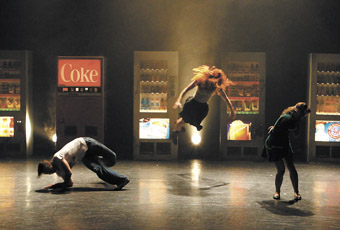
Underground, Dancenorth
photo Justin Nicholas
Underground, Dancenorth
LIKE MOST PERFORMING ARTS COMPANIES IN AUSTRALIA, DANCENORTH WORKS HARD TO MAINTAIN ITS PLACE IN THE CONTEMPORARY DANCE ARENA, BALANCING A STRONG REGIONAL PRESENCE FROM THEIR BASE IN TOWNSVILLE, NORTH QUEENSLAND ALONG WITH AN INTERNATIONAL PROFILE. IN RECENT YEARS, THE COMPANY HAS TOURED TO GERMANY, YOKOHAMA, SINGAPORE, LONDON AS WELL AS SYDNEY, PERTH AND THROUGHOUT QUEENSLAND. TO INSPIRE DIVERSITY, THE COMPANY ALSO HAS A STRONG COMMITMENT TO COLLABORATION AND CO-PRODUCTION.
Fresh from their most recent international foray, a residency at the prestigious Vienna International Dance Festival, Dancenorth is presenting a national tour throughout October-November with a new work titled Underground, soon after another new work, Remember me, reviewed in RealTime 86 (p33).
Featuring six young performers (Alice Hinde, Charmene Yap, Hsin-Ju Chiu, Joshua Thomson, Kate Harman, Kyle Page), Underground turns a commuter precinct into “a vivid and surreal dream world where routine is transformed into spontaneous action.” Choreography is by Dancenorth’s Artistic Director Gavin Webber who joined the company following a five year stint with Meryl Tankard’s ADT, followed by three years in Brussels with Wim Vandekeybus and Ultima Vez [see page 38]. His previous works for Dancenorth include the wildly inventive Lawn and then Roadkill. Undergound also features a score designed by Luke Smiles, “turning it up with Nick Cave, Nine Inch Nails and Messer Chups.” RT
Dancenorth, Underground, tour dates: Brisbane Oct 8-11, Lismore Oct 14-15, Bathurst Oct 18, Sydney Oct 22-Nov 1, Hobart Nov 5-8, Melbourne Nov 12-15, Perth Nov 19-29
RealTime issue #87 Oct-Nov 2008 pg. 39
© RealTime ; for permission to reproduce apply to realtime@realtimearts.net

Axeman Lullaby, BalletLab
photo Jeff Busby
Axeman Lullaby, BalletLab
WE ENTER A DEEPLY FOGGED SPACE UPSTAIRS AT THE CHUNKY MOVE STUDIOS. A SPLINTERING THUD REVERBERATES THROUGH THE DARK, THE KIND OF VIBRATION THAT LODGES ITSELF DEEP WITHIN THE CHEST. THERE IS SOMETHING INCREDIBLY UNSETTLING ABOUT A HEAVY AXE SWUNG HARD IN THE BLACKNESS. IT’S NOT SO MUCH FEAR OF PERSONAL INJURY AS INJURY OF THE OTHER. AND THIS IS A FEAR THAT IS HEWN INTO WITH FERVOUR IN CHOREOGRAPHER PHILLIP ADAMS’ LATEST WORK.
Black shadowed sentinels stand in the green gloom of the clearing fog when we finally make out the image of the axeman. Laurence O’Toole, a real World Champion axeman is the Goliath standing at the back of the cavernous studio diligently making woodchips from a barkless hardwood trunk. A deep russet blazes clear across the stage, a reminder of the infernal fury trapped within the heart of the wood. Gumbooted and feathered women beat out a rhythm with planks and offcuts as David Chisholm’s composition works along with the grain, the metronome of the woodchop echoed by piano and violin.
Centrestage is initially dominated by an ultra-cubist arrangement of timber yard offcuts. Decking planks, boards, frame, hardwoods and structural pine form a hard-lined square that the dancers readily demolish and rearrange into a haphazard pile close to the audience. In this juxtaposition of the rigid geometry of machined planks with the trunks of raw timber surrounding the axeman I get a visual parallel of the colonial compulsion to impose order onto the chaos of Australia, to create structure from the scrub. There is a frenetic and fearful energy to the dancers’ destruction of this geometry just as the clearing of huge swathes of the continent shallowly masked a fear of an Australian bush that harboured ‘miasmatic’ disease vapours and covered good agricultural soil.
With the appearance of women dressed in high Victoriana, the work becomes gothic in its heightened tension, the squeak of a rusted baby carriage mirrored in the slivered harmonies of a violin. The melodrama of the gothic is not such a distorted prism with which to view Australia’s history and sense of self-identification. An arid and desolate land, with an unknown interior harbouring the fear of isolation, displacement and death, is decidedly gothic. This is even before we consider the anchoring image of this work—the axe.
An axe is sharp, heavy and dangerous. By contrast Adams’ choreography is lithe, fluid and fragile: an intricate joinery of movement with all the complexity of fine lace. Wood chips fly and two dancers on the ground become sounding blocks for a double axe swing. Shifts in lighting states are punctuated by axe blows, greenish shafts stab through the milky swirl, reminiscent of light shining through the holes of a weathered tin work shed. Dancers appear trapped in their gestures and in vain try to connect with one another through birdsong.
Lurking at the back of the space for the majority of the performance, like a splinter in the concept of terra nullius, Jacob Brown represents the markedly different Indigenous connection to the land and enters the action with a rhythm of the feet. His presence sends a raw and dynamic energy through the group. Dancers begin to beat on the woodpile, making mockery of their ‘civilisation’ as the axeman disrobes to the collective intake of audience breath. This energy does not affect Brown, he works in counterpoint, creating his own rhythm and vocabulary of movement. Rather than linear precision, he works with arcs, stamps and a deep rooting to the earth. Eventually all others are drawn into his meditative geometry, the five dancers with wood transcribing the circle of Da Vinci’s Vitruvian Man.
From horror leading to contemplation, BalletLab’s team succeeds in crafting a delicate lullaby to hush the collective, historical and habitual fears of arrived inhabitants to the spirit of this country. And with reference to this, perhaps the last word should be left to one of the first invokers of the power of the Australian landscape. “And the sun sank again on the grand Australian bush—the nurse and tutor of eccentric minds, the home of the weird, and of much that is different from things in other lands” (Henry Lawson, The Bush Undertaker, 1892).
BalletLab, Axeman Lullaby, artistic director, choreographer Phillip Adams, performers Joanne White, Clair Peters, Carlee Mellow, Stuart Shugg, Jacob Brown, Laurence O’Toole, composer David Chisholm, lighting Paul Jackson, Niklas Pajanti, costumes Doyle Barrow; Chunky Move Studios, Melbourne, August 7-17
RealTime issue #87 Oct-Nov 2008 pg. 40
© Alex Ben-Mayor; for permission to reproduce apply to realtime@realtimearts.net
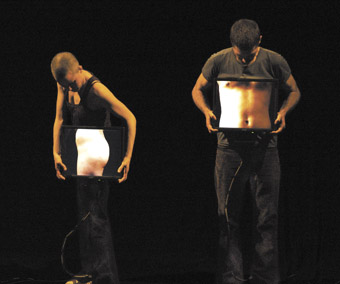
Kirstie McCracken, Byron Perry, The Age I’m In
photo William Yang
Kirstie McCracken, Byron Perry, The Age I’m In
THE END OF NOVEMBER SEES THE WELCOME RETURN, AND RE-WORKING, OF A MAJOR DANCE THEATRE WORK, FORCE MAJEURE’S THE AGE I’M IN, AFTER ITS SUCCESFUL PREMIERE SEASONS AT THE 2008 SYDNEY AND ADELAIDE FESTIVALS.
The Age I’m In’s subject is age and its variables as revealed in bodies young and old, being themselves and, in acts of play and empathy, transmuting into others of different ages. It’s a transformation that particularly intrigues in this work as, for example, when Byron Perry and Kirstie McCracken turn child behaviour into gestural dance with an artistry that goes beyond mere mimickry. It’s also rivetting on the actual-virtual plane with the performers dextrously handling small, portable videoscreens they can hold over their faces (replacing them with others) or lower down revealing a naked body, perhaps not their own or even their own age. This play with possible selves is very much of the era of avatars and cyborgs, but in The Age I’m In the focus in the end is always on the actual body—how we experience ageing, regard others in terms of differences in years, and how we embody these in social behaviour and physical intimacy. This is amplified by voices from the public who contributed material to the creation of the work. RT
–
Force Majeure, The Age I’m In, CarriageWorks, Sydney, Nov 26-Dec 6; artist talks Dec 1 & 3 after performance; www.carriageworks.com.au; www.forcemajeure.com.au
RealTime issue #87 Oct-Nov 2008 pg. 40
© RealTime ; for permission to reproduce apply to realtime@realtimearts.net
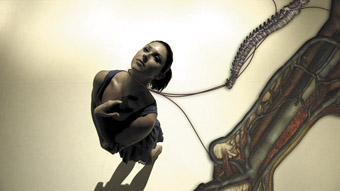
Rachelle Hickson, ‘Reading the Body’ in The Curiosities
PHILOSOPHER DREW LEDER SAYS THAT THE LIVED EXPERIENCE OF THE BODY IS MOSTLY ONE OF ABSENCE. THE INTERNAL BODY DISAPPEARS FROM BOTH VISIBILITY AND SENSATION UNLESS THERE IS PAIN, IMAGING, DISSECTION OR A RETURN TO THE BODY THROUGH DANCE. SUE HEALEY AND COLLABORATORS HAVE BECOME CURIOUS ABOUT THESE ABSENT LAYERS OF BODY. WITH MEASURED ATTENTION, HEALEY’S LATEST INVESTIGATION, THE CURIOSITIES, EVOCATIVELY PROBES OUR INTERNAL STATES AND STRUCTURES, REVEALS EXTERNAL CONNECTIONS AND IMAGINES THE POSSIBILITY OF BEING ANATOMICALLY OTHER. REPRESENTATIONS OF THE HEART, BRAIN AND SKELETAL SYSTEM ARE MANIPULATED USING PROPS, ISOLATED AND SUSPENDED THROUGH ANIMATED IMAGE, AND REINTEGRATED THROUGH THE MOVING RELATIONSHIP OF DANCERS NALINA WAIT, RACHELLE HICKSON AND LISA GRIFFITHS.
A screen is suspended in front of the upstage wall. To the right, a rectangular screen on its side hangs close the ground. A white cube two metres in dimension is downstage centre, a mobile site for analyses and scene transitions. The opening projection is of a richly coloured throbbing heart, rhythmically pulsing, indicating a living creature, absent.
Nalina Wait interrupts the image, stands in a column of white light, face widened with exaggerated emotional confusion. She eyeballs the audience. Her solos vacillate between explosive reaction and considered retraction of extended limbs thrown from a fluid, breath filled centre. Deeply sourced, Wait’s energy percolates, whipping the space in fitful bursts of acute self-awareness: causation. Her manner sometimes borders on the stylised: construction. Appositely adorned in red heart-shaped fairy lights, during a cutesy ‘kitsch’ moment, she presses a love heart about the space she moves within.
Wait’s facial expressions and hand gestures remit a quality rather than identifiable character. Following a playful chess game and assembling of a model brain and heart by Hickson and Griffiths, a seated Wait pushes a table backwards while wringing clasped hands with throbbing gestures. A wicked smile causally connected to the pleasures of her action disappears into the darkness.
The clarity of Hickson’s grand extensions carries the “rational, scientific perspective” to a point. Her inquiry is direct and calm. She observes by looking at how her body moves and is moved by Griffiths, a character facilitating “possibilities for movement.” There is a softness and creamy tempo in the unfolding of limbs along direct pathways, arrival entailing a pause with hand flourish or finger gesture: dabbing, curling, then little shakes. The lower leg rotates in the knee joint as an afterthought, causing a different part of the body to respond in circular isolation.
Griffiths manipulates Hickson through supportive limb lifting, pushing, stance arrangement and dragging of protruding bone—manifest as fleshy skin sculptures. She instigates many of the moving duets and trio sequences: fully lit for their duration, screens inactive. The lyrical dances are met by the more melodic moments of Darrin Verhagen plumbing the depths of his variegated soundscape.
The image of a bird’s wing in skeletal form is projected onto the rectangular screen as if inserted into the dancer’s shoulder joint, permitting us to see the possibility of interspecies experimentation. The idea is thickened by a final moving trio: heads bowed, scapulas slide awkwardly upward, reconfiguring the distal relationship of limb points where embryonic flight unfurls in the cacophonous shrill of many birds: a large aviary or Hitchcockian anxiety?
The production of animated space in the projected film Reading the Body (animator Adnan Lalani, performer Hickson) mirrors, dissects and makes visible the felt forces and linear geometries expanding beyond the boundary of skin: how do we move? Animated objects are spookily suspended like child mobiles. Graphics resemble the crude, naive surrealism of Mexican folk art figures: bones in their own dance. The dancer interacting—measuring, shaping up, now inside-out—Hickson disassembled in the apprehension of absences.
The pleasure of Healey’s installations is found in the sober balance between dancing and screen work which mediate her explorations. The Curiosities avoids saturation of one media and the jarring consequences of poorly developed dramaturgical interactions between bodies and screen. In one playfully engineered moment, Griffiths and Wait, supine, pump arms and legs in a raucous running style. They are captured in real time and recast as little figures in the slapstick chase of a bouncing love heart. Healey has allowed the work’s structure to breathe: this is felt in the pause of a phrase which permits a new cycle and in the white cube’s revolving display of bodies re-examined, recreated and restless in form.
–
The Curiosities, director, choreographer Sue Healey, performers Nalina Wait, Lisa Griffiths, Rachelle Hickson, animation Adnan Lalani, film Louise Curham, sound Darrin Verhagen, visuals Adam Synnott, IO Myers Studio, UNSW, Aug 13-16
RealTime issue #87 Oct-Nov 2008 pg. 41
© Jodie McNeilly; for permission to reproduce apply to realtime@realtimearts.net
BERNADETTE WALONG DANCES HER OWN DANCE. IT IS THIS IDIOSYNCRASY THAT MARKS GROUNDUP AS A PERFORMANCE OF DELICACY, SURPRISE AND RESILIENCE. CONTEMPORARY DANCE PERFORMANCES CAN DISPLAY GENERIC VOCABULARY AS SYMBOLS OF MASTERY AND VIRTUOSITY, SPEAKING THE GRAVITAS OF THE ACADEMY. TRAINING IS EVIDENT IN WALONG’S BODY AND CHOREOGRAPHY, BUT IT IS USED AS A CAPABILITY AND A PORTAL, NOT A DESTINATION. DISPLAY IS NEGATED IN GROUND UP. INSTEAD IT MOVES THROUGH VARIOUS STATES OF BEING IN A DIMENSIONAL AND MALLEABLE ENVIRONMENT. CLEAR BUT OPEN-ENDED NARRATIVES TETHER THE DANCING BODIES TO A GROUND FROM WHICH THEY CAN FLY. SOMETIMES THEY SEEM CLOSE TO A RAW IMMEDIACY THAT ALMOST SCREAMS.
As we enter the theatre, Walong, Barbara Adjei, Victoria Chui and Deidra Taueki are chatting in an alien language, already a clan, strangely communicative. They will continue to speak in a language I do not know but understand. In a densely woven and active aural landscape, sounds will range from the scouring of pots and pans to rhythmic washes, to spoken conversation and the banging of tin. The dense soundscape coming from many directions is occasionally unnecessary, too seductive or overly pointed. But ah, the voices of these women, providing potent emotional resonance as they gabble, laugh, cry and moan in stories that rely on shared humanity rather than simply shared language. Relationships, actions and narratives are firmly established in the rhythms, tempos, intensities and cadences of a language at once strange and strangely familiar. The sounds of this performance will stay with me, even entering my dreams, providing visual memory with a life and a tone, with a substance and a voice.
As the women vocalise their stories, they weave through a landscape of erect bamboo poles, like didgeridoos, like trees, dense like a mangrove. We see the dancers as we would in the world: partially hidden, disappearing, reappearing, peripheral, profiled. Rather than as in a theatrical presentation of full disclosure, this one makes me a voyeur to a world that would happen without me. These women exist in a place both real and surreal, of now and never, here and everywhere. They emerge from dark corners and dissolve into obscurity and, as I seek them out in the multi-focussed, semi-darkness, I am engaged and drawn into this place, this world, these sounds, these bodies.
Rocks, sand and vegetation naturalise the deep and broad performing space. It is a detailed environment: asymmetrical, differentiated yet coherent, textured, fertile and dangerous. A corrugated tin humpy hints at a more modern time, and renders this place Australian. The women, with archetypal dilly bags and wearing curiously apt black corsets, gather, carry, store, feed. The smell of fish wafts to nostrils surprised by olfactory depth in the theatre, making this place real.
Behind and beside the women, filmed images vary from a vast, abstracted moon to the close-up detail of the stitched neck of a white T-shirt. Live feeds of the onstage action top and tail the performance, enlarging, extending and revealing the minutiae of what happens before our eyes. Technology slaps me out of a complete immersion.
Movement in groundUP! ranges from perambulatory wanderings to the high art technicalities of pointe work: a Walong trademark. Although she has used it more effectively in the past, the pointe shoe is again used to lengthen the leg to creature-like proportions. Choreographic incongruity again shakes me awake.
In groundUP! , Walong stands out as the master to the apprentices. With a firm centre she descends to the earth only to lift up more easefully again. In relaxed muscular length she has delicate detail, holding understated balances that suspend time and space in a breath. She folds into herself and unwinds smoothly only to jump and twitch. A face relaxed and open lets the witness in to see not just a dancer, but a person. Beautifully simple, not displaying, communicating.
Solos display each dancer’s personality, some more delineated than others. Group choreography ranges from contemporary athleticism to a cheekiness most evident in the little raised hip twist with a gentle Broadway feel: a whisper of the chorus line amidst the mangroves. The group recedes, advances, gathers and dissipates, crossing the environmental membrane to enter audience space, always travelling. Soft knees make quiet and knowing feet move lightly. These mangrove creatures shake and chase and slide, then…they disappear.
–
groundUP!, choreographer Bernadette Walong, performers, Bernadette Walong, Barbara Adjei, Victoria Chui and Deidra Taueki, Henrietta Baird, set design Jason Pitt, lighting Simon Wise, costume Jacques Tchong, vocal design Jill Brown, musical score Calvin Rore, video design Lisa Duff, assistant video design Willurei Kirkbright; Performance Space, CarriageWorks, Sydney, Aug 14-23
RealTime issue #87 Oct-Nov 2008 pg. 41
© Pauline Manley; for permission to reproduce apply to realtime@realtimearts.net
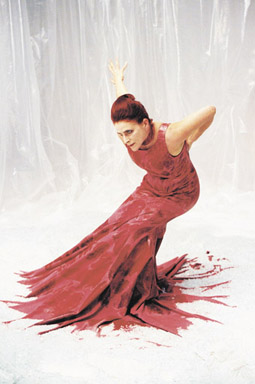
Liz Aggiss, Motion Control
photo H. Murray
Liz Aggiss, Motion Control
THE UK TAKES DANCE SCREEN VERY SERIOUSLY. SUPPORT FOR DEVELOPMENT, PRODUCTION AND PRESENTATION HAS BEEN STRONG OVER THE PAST 30 YEARS THROUGH PROGRESSIVE PROGRAMMING AT CHANNEL 4 IN THE 80s, LONG-TERM COMMITMENTS TO COMMISSIONING LOCAL WORK AT BBC TV, AND A RESPONSIVENESS TO CHANGES IN THE FIELD WITH THE ARTS COUNCIL OF ENGLAND’S CAPTURE INITIATIVE WHICH OPENED UP FUNDS TO ARTISTS WORKING IN SCREEN CONTEXTS BEYOND THE SHORT FILM FORMAT. TAKE 7, A DVD AND STUDY PACK ON MAKING DANCE SCREEN FOR STUDENTS AND TEACHERS, IS ANOTHER GREAT IDEA AND INNOVATION THAT IS, UNFORTUNATELY FOR OTHER POTENTIAL MARKETS, UK SPECIFIC IN ITS TERMS OF REFERENCE AND SLIGHTLY AWKWARD IN ITS METHODS.
The DVD is a collection of “seven pioneering British dance films” that can operate as a discrete teaching tool. It includes classics such as Boy (directors Rosemary Lee, Peter Anderson, 1995), Birds (David Hinton, 2001) and Dust (Antony Atanasio, 1998). These fine examples will yield much in a pedagogic context. It is excellent that the films are being made widely available, although the image quality is surprisingly poor. The scarcity of dance screen resources is largely responsible for the lumbering pace of critical discourse surrounding the field, something RealTime has tried to correct and this is acknowledged in the resource list accompanying the Study Pack. The DVD offers a few comments from the filmmakers that range from the specific to the general and there’s an easily navigable chapter interface.
Naturally enough, in the booklet there is little reference to the important work done in the US and France in the field prior to the boom in the UK, with the historical background jumping from early cinema to musicals to the UK in the 70s with a nod to Maya Deren and Merce Cunningham. Minimising the close association of dance film with the cinematic avant-garde across the 20th century means that contemporary work is attributed with inventing much more than it actually has. The dissociation of dance screen from cinema theory and culture in general has lead to a lot of reinventions of the wheel. But Take 7 is clearly aimed at UK dance students being introduced to the field and practice of dance screen and in servicing this market, there is an emphasis on dance per se and on recent UK product.
The Study Pack covers the seven films by concentrating on specific aspects of filmmaking eg location, treatments, score/sound. The focus is on the practicalities of filmmaking and always in reference to live dance performance and spectatorship; how and why the processes differ in relation to screen choreography. This enables a fairly comprehensive ‘how-to’ guide much in the tradition of Katrina McPherson’s Making Video Dance (Routledge, London, 2006). The Study Pack is made up primarily of questions—one set written by Liz Aggiss, a dance filmmaker and lecturer, and another set by a dance education expert, Justine Reeves. These appear to be addressing two different readerships, one being A-Level dance students, but the questions repeat, overlap, and cross-reference. Reeves’ ‘tasks’ also refer to other UK dance work which would be unavailable to students outside the UK.
It ultimately seems a shame that there is so little engagement with the ‘ideas’ presented in the films that form the basis of this resource. The large majority of the tasks focus on the ‘how’ with little encouragement to connect this with the ‘why’, and this in itself indicates the problems surrounding the kind of ‘crash courses’ in filmmaking that are required. In dealing with the basic technical requirements, the bigger picture is neglected. I have to admit to being slightly baffled by A-Level and, in Australia, HSC studies in dance screen. The choreographic approach to filmmaking is such a complex field and so aesthetically specific—and it is not as if there is a HSC filmmaking syllabus. That students have to understand and apply choreographic compositional processes not only to dance but also film/video seems an enormous ask. It is worth noting that many of the films included in the UK collection are directed by successful fimmakers who engage with dance screen amongst other genres (David Hinton, Antony Atanasio, Peter Anderson). But it is also worth highlighting David Hinton’s comments that the art form has not yet become too prescribed so that there is still the opportunity for newcomers to jump in the deep end a la the Sex Pistols, armed with their three chords.
It is of course important that students in the performing arts engage with interdisciplinarity and the attraction of the moving image for dancers and choreographers is undeniable. That they can bring something special to filmmaking is certain and is exemplified in the work of choreographer/director Miranda Pennell who is represented in the DVD, and whose Australian peers include award-winning artists such as Sue Healey and Tracie Mitchell.
Take 7 DVD and Study Guide, available through www.southeastdance.org.uk
RealTime issue #87 Oct-Nov 2008 pg.
© Erin Brannigan; for permission to reproduce apply to realtime@realtimearts.net
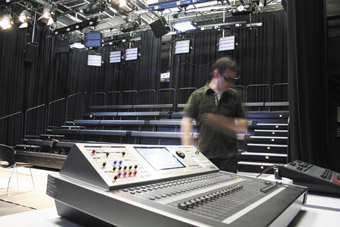
James Hurley in the Bon Marche Studio
photo Jeff Shoesmith
James Hurley in the Bon Marche Studio
CONFIDENCE IN NEW MEDIA ARTS IS GIVEN A LITTLE MORE BOUNCE WITH THE OPENING UP OF NEW SPACES FOR THE CREATION AND SHOWING OF WORKS BY STUDENTS AND ARTIST-ACADEMICS. AMONG THE LATEST IS THE BON MARCHE STUDIO, A 10M X 10M X 10M FILM SHOOTING STAGE AND PERFORMANCE AND MEDIA ARTS PRODUCTION SPACE RECENTLY RENOVATED IN THE FACULTY OF ARTS AND SOCIAL SCIENCES, UNIVERSITY OF TECHNOLOGY SYDNEY. THE EXTREMELY WELL EQUIPPED VENUE, A SYDNEY RARITY, IS BOUND TO ATTRACT A LOT OF INTEREST.
James Hurley, Media Centre Manager in the Department of Communication at UTS shows us proudly around the new million dollar venture: “Flexibility was the design brief, so the space has retractable tiered seating for up to 100 people, high definition playback and projection, a 9.1 loudspeaker system that can be configured for stereo, quad, 8-channel surround or film surround formats up to 7.1.” Hurley is particularly fond of “the Coemar de Sisti lighting rig, which allows for safe and easy lighting setups without the need for staff or students to go up to the ceiling. The 10 lighting hoists come down to floor level for setup.”
As well the room has a large green screen cyclorama for compositing work with the luxury of “live keying to Final Cut Pro and three XDCam-Ex 3 High Definition Cameras.” And there’s more, says Hurley: “Audio control is via the latest Roland RSS Virtual mixer and digital snake system allowing for very flexible positioning and control of audio for a variety of media production, playback and performance needs.” To complete the picture, there’s an area for set construction, dressing rooms and loading dock access. Everything an artist could desire. We await the bar.
The new Bon Marche Studio got a good workout at the launch of the UTS’s Centre for Media Arts Innovation, which aims to work across disciplines and artforms within UTS and generate dialogue and ventures with sectors outside the university and the general public [www.communication.uts.edu.au/centres/cmai]. The launch showed off A-V and sound works by UTS staff and affiliates to maximum, immersive advantage. The studio will largely be used in BA (Communication) and Post-Graduate courses as well as the new Sound & Music Design BA commencing in 2010 and, as is hoped, attract a range of conferences, performances and events. RT
James.Hurley@uts.edu.au;
www.communication.uts.edu.au
RealTime issue #87 Oct-Nov 2008 pg. 41
© RealTime ; for permission to reproduce apply to realtime@realtimearts.net
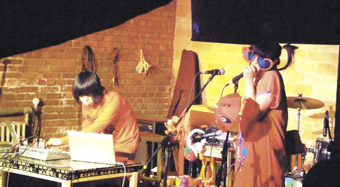
10 (itta and marqido)
THE FOURTH MINIMIDI FESTIVAL, NOISE IS FREE, WAS HELD IN MAY THIS YEAR AT THE 2KOLEGAS BAR AND AN OUTDOOR AREA LOCATED ON THE EDGE OF A DRIVE-IN MOVIE PARK ON LIAGMAQIAO STREET AND EAST 4TH RING ROAD IN BEIJING. THIS SUITABLY INTERESTING LOCATION SEEMED APPROPRIATE FOR THE BEIJING UNDERGROUND NOISE SCENE. YAN-JUN DESCRIBES THIS LOCATION ON HIS “FIELD RECORDINGS” SITE PAGE:
“This is a park located between Lufthansa Shopping Centre and Dongfeng Qiao. Inside it there is the bar 2Kolegas, the coolest place in Beijing. It’s old-school, environmental and loose. Every Tuesday since June 2005, I organise the Waterland Kwanyin series there. I recorded this to remind people and myself that there’s still some place worth enjoying in this huge noisy hyper-city, where we can keep making noise without disturbing others.”
There is an MP3 recording that goes with this page and it wonderfully contradicts the sounds one might expect hear from a “hyper-city” like Beijing. You can imagine that it was recorded early in the morning before daylight breaks (as the page image suggests). But it is surreal to think of it as the centre for experimental sound/noise in Beijing.
As a very active member of the Beijing sound community, Yan-Jun knows probably every significant sound artist in China and has encouraged many of them to perform as part of his Waterland Kwanyin series. In May, with close friends Yang Licai from Sugar Jar records and Xu Ya-zhu—and many volunteers—he organised the MiniMidi festival, the only outdoor experimental music festival in China. This celebration of the alternative sound scene in Beijing is usually scheduled in parallel with the much larger and mainstream Midi festival. In a city growing and evolving at an unprecedented rate, where commercialism is almost a universal and singular mantra, the MiniMidi festival stands in stark contrast. It is a passionate event that serves to draw artists together to commune over what Chinese sound art is and might become. It was for precisely this reason that I was drawn to experience the festival.
MiniMidi debuted in 2005 and has grown from there. It has the aura of a refreshingly naive or perhaps a singularly passionate contemporary sound and performance event that is universally felt. MiniMidi has, however, a deceptively simple image for an annual event of such maturity and which has already received critical reviews from such publications as The Wire.
The first day began by showcasing international labels and festivals. Miguel Santos, the head of Atlantic Waves Music Festival told us about its history and operations. The Staubgold label and the Goethe-Institut German Electronic Music Series were represented in performance by Joseph Suchy, Mapstation (Stefan Schneider), Reuber (Timo Reuber), Klangwart (Markus Detmer and Timo Reuber). In comparison, Chinese sound art was revealed as a scene rich in online discourse on sound events and sound dissemination. The growth here is evident when looking over the recordings available at Sugar Jar, located in the progressive 798 Art District and the most influential record store for new sound labels such as Shanshui, SubJam, Kwanyin and Post-Concrete. These serve to promote the most innovative and diverse range of sound work from the China and Taiwan.
In fact, MiniMidi was bracketed by such discourse, closing with an intriguing look at the “Noise Movement in 90s Taiwan” and a discussion about Chinese contemporary music. In between the formal and informal discussions were diverse performances and events that confirmed influences and current directions.
As interesting as it was to catch up with works by artists from Europe, I was much more curious about the state of electronic, digital and performance sound art in China. While laptops continue to provide the functional glue to many performances, more interesting were performances that extended sound in a range of unorthodox or idiosyncratic directions. Notably, in this respect, the TronOrchestra+SAM2+SomeMoreSams+ brought a theatrical, Björk-like element to the opening day echoed later in the work of Lin Chi Wei and Steve Chan.
Performances by Janek Schaefer, Andy Gulh, Mapstation and others on the Staubgold Label provided an international perspective for the local scene. Schaefer’s performance was sans three-arm turntable but interesting to see him perform with live mixing of sound sources.
Two performances are worth noting. Fujui Wang’s (Taiwan) set reflected a sophisticated and focused engagement with technology and a refined sensibility for contemporary global electronic sound and image. His laptop performance tightly integrated sound and image, expressing a distinctly individual aesthetic. In the second work of his set, the image component comprised a series of shifting vertical lines synchronised with a “glitch” style sonic texture reminiscent of Alva Noto or Jan Jelinek.
Lin Chi Wei, Steve Chan and Singing Liu’s (absent but replaced by a laptop) performance, A Dismissed Organization, conveyed the strongest sense of a uniquely contemporary Chinese sound art. Taking place amidst the audience, two performers and a laptop faced each side of a triangular mirrored structure. Chi Wei wore a mask invoking memories of Chinese Opera and interacted with Steve Chan in a sound world of text and noise. Amid the intense sound, the stillness of the performers infused with the attention of the audience, and the reflections in the mirrored surfaces, reminded me of the contradiction between the dynamism of Beijing city life and the calmness of the people who inhabit it.
In its programming, organisation and post- festival activities, the MiniMidi festival reflects a maturity in the Chinese sound scene commensurate with similar events in Australia. This is, in a sense, remarkable considering that the history of experimental/contemporary music in China is relatively new by Western criteria. Given the obvious differences between the East and West, the MiniMidi Festival clearly articulated the universality of sound and the exciting prospect of a new frontier less evident in Australia these days.
MiniMidi Festival, Noise is Free, Beijing, May 1-3, http://minimidi.cn
Yan-Jun field recordings site page: www.yanjun.org/projects/field_recording/drivein/drivein.html
RealTime issue #87 Oct-Nov 2008 pg. 43
© Alistair Riddell; for permission to reproduce apply to realtime@realtimearts.net
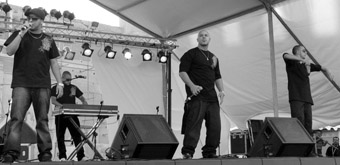
Fnaire, Fes festival
photo Madeleine Blackwell
Fnaire, Fes festival
I FIRST HEARD THE MUSIC OF MOROCCAN GROUP FNAIRE IN A TAXI IN FES, A “PETIT TAXI” AS THEY’RE CALLED LOCALLY. WHEN MY FRIEND AND I SHOWED SIGNS OF APPRECIATING THIS ENERGETIC MOROCCAN HIP HOP, THE DRIVER THROTTLED UP THE VOLUME, TURNED ON THE KITSCH DECORATIVE LIGHTS AND WE DROVE AROUND LIKE A MOBILE CHRISTMAS TREE, THUMPING OUT THE UBIQUITOUS HIP HOP BEAT TO WORDS IN A LANGUAGE I WRONGLY PRESUMED WAS ARABIC.
The taxi driver was so proud of the music that he gave us the CD and eventually dropped us off where we wanted to go—the opening concert of the Fes Festival of Sacred Music. Inside the ancient fortress walls of a caravanserai with a full moon above, the audience of local elites was thrown into a tizz by the late arrival of the Queen of Morocco and the renowned American diva Jessye Norman to open the program.
I was in Morocco to attend two music festivals: this glorious, highbrow festival in Fes and the Gnawa Festival in Essaouira which reveals the African face of Morocco. But that first grand concert was nowhere near as exciting as the taxi-ride, which introduced me to Moroccan hip-hop and to a dynamic social movement erupting all over Morocco today. The movement is known as “nayda” which means “it’s moving”—something’s on the move!
Nayda is a newly-coined word in a colloquial, unofficial language called Darija, or Moroccan Arabic, only spoken at home or on the street. It’s the language used in rap and hip-hop to express the heartfelt concerns of a generation who have been educated in French and Classical Arabic, languages inherited through ideology and the circumstances of history rather than the breath of their mother tongue. Nayda is an explosion of creativity from a generation who don’t want to flee to Europe, or risk their lives as illegal immigrants but rather choose to redefine the way they live and push for much needed democratic change.
In a huge public square just outside the ancient sand-coloured walls of the Medina of Fes, I got to see Fnaire live, with other hip hop artists including local heroes Fes City Clan. Thousands of young men edged to the front of the stage, mouthing the words, but more remarkable were the families with kids, old women wearing their hijab, young girls dancing in jeans, others dancing in the djellaba, a long cover all robe worn by men and women alike. Fes City Clan leapt about the stage with a patter about unemployment, corruption, the police and the impossible cost of living. In a country where half the population is illiterate their message was widely amplified.
Toc Toc, get up, your son is being beaten at the police station. Toc Toc, go and see. Some people have nice children, but you have a poor bastard who is stubborn, drugged with the pills he swallows. Thanks to him the dealers have built three storey villas with swimming pool, Turkish bath, chauffer waiting at the door. Toc Toc, get up.
Nothing can prepare you for the ambience of Essaouira, a small fishing port on the Atlantic coast where boats are all painted the same inky blue and weirdly oversized seagulls dominate the sky. There are no petit taxis, only pedestrians and hand-pulled carts fit inside the corridors of the ancient Medina. Now in its 11th year, the Essaouira festival’s proclaimed objective is “to fight for Gnawa culture and for cultural democratization in Morocco.” Directed by a brilliant young woman Neila Tazi, it has established the recipe for the plethora of mega-festivals that are sprouting up all over the country: free entry, high production values, investment in public space. The Timitar festival in Agadir celebrates Amazigh culture. In Casablanca L’Boulevard celebrates hip-hop and rap. Here in Essaouira it is the Gnawa.
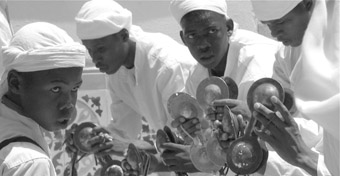
A Gnawa troupe in Essaouira
photo Madeleine Blackwell
A Gnawa troupe in Essaouira
The Gnawa are descendents of black African slaves who were traded by the Berbers of the Sahara. Their polyrhythmic music is a ritual of trance and still has a religious function, to heal and exorcise entities that occupy the human body. Voodoo and Brazilian condomble share its roots, as does the American blues. The Gnawa Maalems, or ceremonial masters, come from all over Morocco to participate in this festival, beginning with a procession through the streets of the Medina. They play a three-stringed bass or ghembri and sing a melodic call which is replied to in unison by their entourage who layer the rhythm on metal castanets called qraqebs, evoking the chains of their slave forebears. Each night on the main stages their mesmerising music becomes a crossroad of experimentation and fusion. Great musicians of jazz, pop, rock and contemporary world music are invited to dialogue: Toumani Diabate, the Malian master of the chora, Wayne Shorter and his band from New York, and many more. Men, women, old and young, even small children dance en masse into altered states, as if wanting to be free of themselves.
The Nayda atmosphere continues into the night on the beach of Essaouira on a stage dedicated to the incorrigible hip-hop, rap, rai and fusion. Fes City Clan, Darga, H-Kayne, Ganga fusion…I have never seen so many dreadlocks in my life. The city is ‘occupied’ by young people, some from the tribes of the Sahara wearing turbans and robes, neo-hippies, baba-cools, punks clad in black, hip hoppers in their triple X T-shirts and running shoes. But I baulk at these categories. Identities can shift from one minute to the next, as they are shifting now throughout Moroccan society.
Morocco has recently emerged from the dark ages and the kids don’t want to go back there. Their parents endured “The Years of Lead”, so called because of the weight of exile, emigration, political repression, disappearances and death. While Nayda may look like Western decadence to its detractors, it certainly has roots in the radical popular movements of this era. In the 70s a group of musicians from the Rif mountains called Nass El Ghiwane personified resistance, carrying the voice of the Moroccan people through those dark years.
The current transition to democracy, overseen by King Mohammed VI, walks a fine line between the Islamic conservatives and the prescriptions of the International Monetary Fund and the globalised free trade market. The internet has had a momentous social impact, sometimes compared to the fall of the Berlin Wall. And in a country where 68% of the population is young, and many unemployed, there is an ideological battle to control hearts and minds. The youth and their music are constantly accused of being un-Moroccan. Some music festivals have provoked editorials in the Islamist press accusing them of “polluting the society with alcohol, hallucinogenic pills, men exchanging kisses, shameful, promiscuous women, and hysterical wobbling under the effect of musical trance.” In 2003, 14 rock musicians were put on trial for Satanism. Public sit-ins were held in their support; the charges were dropped.
But, as one of the musicians of rock/fusion group Hoba Hoba Spirit put it, “we love our country, we don’t want to ‘bruler’ (flee to Europe), we’re proud of being Moroccan but we’re not going to speak your sort of nationalism.” What is so intoxicating about the energy of all this music is the clear sensation that the artists are performing to assert their very existence, in a language of their own, revealing the diversity of contemporary Islam.
Fes Festival of World Sacred Music, artistic director Gerard Kurdjian, Fes, June 6-15, www.fesfestival.com; Festival Gnaoua, artistic director Neila Tazi, Essaouira, Morocco, June 26-29, www.festival-gnaoua.net
RealTime issue #87 Oct-Nov 2008 pg. 44
© Madeleine Blackwell; for permission to reproduce apply to realtime@realtimearts.net
WHETHER CONSIDERED AS AUDITORY CULTURE OR SOUND STUDIES, THE CULTURAL, SOCIAL, PHILOSOPHICAL, HISTORICAL AND AESTHETIC INVESTIGATION INTO SOUND HAS NOT OFTEN BEEN CONSIDERED TO CONSTITUTE A DISCIPLINE IN AND OF ITSELF. INSTEAD, IT HAS BEEN AN AREA WHERE ACADEMICS AND ARTISTS FROM A DIVERSE RANGE OF BACKGROUNDS HAVE MADE VALUABLE CONTRIBUTIONS TO THE DEVELOPMENT OF AN INTELLECTUAL CLIMATE WHERE SOUND AND LISTENING HAVE BECOME SIGNIFICANT SUBJECTS, TO BE CONSIDERED ALONGSIDE THE IMMEDIATE SONIC CONCERNS OF EITHER MUSIC OR ACOUSTICS.
However, the publication of a number of anthologies in recent years, such as The Auditory Culture Reader (2003) and Hearing Cultures (2004), has created a locus around which many contemporary writers have gravitated, producing not a specific discipline but a more amorphous or generalised field, bringing multifarious approaches into contact to produce an array of dialogues about sound and listening. One of the more recent additions to this steady stream of writings and publications is Hearing Places.
The title itself holds a fairly apparent double meaning—positing both an activity (the auditing of a given environment) and localities where such an activity might occur (places for listening)—that only partially accounts for the multitude of approaches to the experience of sound and place contained within. Compiled and edited by Ros Bandt, Michelle Duffy and Dolly MacKinnon under the auspices of the Australian Centre at the University of Melbourne (which is also home to the Australian Sound Design Project, directed by Bandt), Hearing Places draws together 37 scholars and artists from Australia, New Zealand, Japan, Europe, North America and beyond, bringing a plethora of voices from a variety of cultural backgrounds to explore the concept of place through an attentiveness to its sounds, and the relative significance attributed to those sounds.
In light of these aims, the use of the term ‘hearing’ in the title comes across perhaps as a slight misnomer, referring as it does to the sensory mode that allows us to perceive sound. Instead, hearing in this context has been taken (as frequently occurs in everyday usage) to be synonymous with listening—a conscious act that involves the focusing of attention on to the sense of hearing—and also to operate as a synonym for processes of communication in general. This slippage between literal and metaphorical acts of audition is used by several authors to articulate the complex interweavings of voice, place and power. Jane Belfrage’s essay explores how the notion of “The Great Australian Silence”—initially a metaphor for colonial attitudes to both Indigenous people and the land—signifies the continuing unbalanced power relations between Indigenous and non-indigenous peoples in this country. Similarly, Kelley Johnson’s cataloguing of the everyday sounds and voices of an institution for people with intellectual disabilities highlights the explicit connections between communication and power. Hearing, or in these circumstances, to be given a hearing—the opportunity to air grievances, to express opinions, to participate in cultural life—becomes the first step in fostering an understanding based on dialogue rather than assumption.
Given that this volume investigates the relationship between place and listening, it is not surprising that a number of writers draw from the notion of the soundscape, first advanced by Canadian composer R Murray Schafer and popularised in his book The Tuning of the World (1977) and also the wider, related field of acoustic ecology. However, many of the artists and researchers here extend beyond Schafer’s geographical similes and schema of soundmarks, sound signals and keynote sounds, and perform an auditory reimagining of their locales of choice, one that incorporates memory and narrative, which emphasises the tensions between the natural, cultural and historical components of a given environment. Keiko Torigore brings all these factors to bear in designing a ‘soniferous garden’ to honour the life of Japanese composer Taki Rentaroh—using plants, watercourses and pavement materials to subtly infuse a modern location with the historical sounds relevant to her subject. Kiera Lindsey brings the full force of an imaginative listening to an aural recounting of the Hume and Hovell expedition party of 1824-25, eliciting from the historical documentation an embodied experience of animal encounters, new surroundings and intercultural contact.
Alongside the more typically academic pieces are a number of statements by artists and artist-researchers whose work engages with both sound and place, such as the interactive sonic environments of Garth Paine, the distributed choral performances of Johannes S Sistermanns, and American Aaron Ximm’s audio restoration project. Of particular note is Jay Needham’s radiophonic work Listening at the Border which explores the personal dimension of the wartime monitoring of military airspace. Also intriguing is Dutch artist Ricardo Huisman’s woollen sound pill, conceived of not only as a touchable sound producing object, but also operating as a “woollen time capsule” in that it reproduces (among others) the sounds of the powder-fold machinery once commonly heard in Dutch pharmacies. The push and pull of memory is also detailed in Paul Carter’s perceptive description of both the content and the reception of his sound installation Out of Their Feeling, which had been developed to accompany a memorial to the great Irish famine. The accompanying compact disc contains not only samples of these artists’ works, but a range of field and location recordings that relate to almost all of the chapters, giving the reader (and in this case, the listener) an all-important opportunity to experience some of the sonic aspects of place to which their work relates.
Even though it has an international ambit, what is most significant about Hearing Places is the inclusion of works that address Australian subjects. “Locks of Hair to Untangle” by Melbourne writer and poet Tony Birch outlines his attempts to open channels of communication between the competing social and audiory spheres of Indigenous and non-indigenous Australia. If, as Birch posits, “silence may or may not be golden” since it can attest not just to respectfulness but to ignorance, then any opening up of those channels would produce the kind of cacophony that I dare say many of us would prefer to hear, potentially making any future ‘hearings’ of this particular place much more interesting.
Hearing Places: Sound, Place, Time and Culture, edited by Ros Bandt, Michelle Duffy and Dolly MacKinnon, Cambridge Scholars Publishing, Newcastle, UK, 2007
RealTime issue #87 Oct-Nov 2008 pg. 45
© Peter Blamey; for permission to reproduce apply to realtime@realtimearts.net
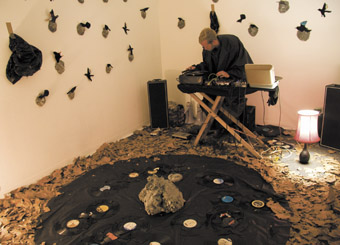
Ryan Cockburn, vacuum#1, installation, Westspace, Liquid Architecture 9, Melbourne
photo Louise M Cooper
Ryan Cockburn, vacuum#1, installation, Westspace, Liquid Architecture 9, Melbourne
LIQUID ARCHITECTURE SEASONS TYPICALLY REVEAL NEW DIMENSIONS OF SOUND, AS WELL AS INVESTIGATING THEIR IMPACT ON THE LISTENER. WHAT WAS STRIKING THIS YEAR WAS THE DIVERGENCE IN THE LISTENING ENVIRONMENTS AND THEIR EFFECT ON THE RECEPTION OF THE WORK. WE WERE VARIOUSLY IMMERSED IN THE MELBOURNE PLANETARIUM, THE REVERBERANT CELLS OF THE OLD MELBOURNE GAOL AND A WEST SPACE ART GALLERY INSTALLATION, SPLITTING THE AUDIENCE’S AWARENESS BETWEEN SONIC AND VISUAL CUES. AS WELL, THERE WAS THE TYPICAL ARRANGEMENT OF THE MAIN CONCERT VENUE, THE NORTH MELBOURNE TOWN HALL, TO LOCATE LISTENERS INSIDE A CIRCLE OF LOUDSPEAKERS TO EMPHASISE THE SPATIAL MANIPULATION OF THE SOUND.
Immersion, a concert of high-quality recordings by prominent sound artists, curated by Phillip Samartzis, was located in the Planetarium, an interesting location for sound art. You lie back in a reclining armchair, as you might at home, and enjoy the recordings on the excellent speaker system in a detached and inward way. While listening, you could watch an outer-spacescape, but since this imagery has nothing to do with the music, it is better to close your eyes and focus on the sound. The session included Berlin composer Rhienhold Friedl’s fascinating eight-channel work Neo-Bechstein (undated), which employs an electro-acoustic piano built by Bechstein, Siemens and Telefunken in 1930. The ringing tones of the piano, beautifully mixed and spatialised, are hypnotic in such a setting.
This highly structured experience, a kind of aural cinema, contrasted vividly with the stark and emotionally challenging site of the Old Melbourne Gaol, where Within Earshot offered a showcase of multimedia works in cells through which the audience could wander, followed by a concert of four performances in the gaol’s exercise yard. The theme of the event was the idea of displacement, and the works in the cells made good use of the gaol’s resonance, dynamics and social history. In the concert, Melbourne sound artist Que Nguyen’s complex and engaging vocal and electronic work (untitled), with its hints of creaking doors, ghostly cries and clanking metal, stood out.
Vacuum #1 at West Space Gallery, curated by Eamon Sprod and Camilla Hannan, was a group production that ran for several hours each day over four days, with many local and visiting performers sitting in, and with the public invited to contribute. The sound, generally laptop and synthesiser driven, evolved continuously, and was relayed through numerous sets of speakers: wall-mounted, floor-mounted and some within lengths of tubing suspended at ear-level. Generally lacking the resolution of a compositional beginning, middle and end, this sound art seems intended as an exploration of group improvisation and spatial and acoustic dynamics, as well as challenging the usual performer-audience hierarchy. Audience members meandered around the gallery’s spaces and speakers for minutes or hours at a time, or found a convenient corner to sit—what you get out of such unstructured activity depends on what you put into it.
The transaction between audience and performers is different in the concert hall. For the events in the more conventional environment of the North Melbourne Town Hall, LA9 artistic director Nat Bates brought together major Australian and international performers who typically sat studiously at keyboards and laptops, though it is not always easy to tell how much of what is heard is pre-programmed and how much is improvised or spontaneous. These concerts included a thorough exploration of the genre of electronic music that both manipulates sound in space and provokes and unsettles the mind. Berlin composer Marcus Schmickler’s overwhelming orchestration of electronic sound, emphasising spatial effects, was at a volume that obliged the audience to resort to the earplugs offered on entry. The flavour is dark, alternately bellowing and brooding, with dense, contrasting textures, sweeping shifts in pitch and long tones with no discernible rhythmic structure. The Thursday night North Melbourne audience responded strongly to Schmickler’s lengthy, dramatic and adrenaline-pumping performance, which was nicely complemented by Sydney sound artist Alex White’s wailing, fraught and overdriven sound and Nat Bates’ own powerful and highly crafted composition.
The work of Schmickler, White, Bates and many others produces its effect through a high quality and very robust multi-channel speaker system in a large space, a space that emphasises the cerebral nature of the work, forcing your awareness inward and even engendering feelings of isolation. By contrast, the Sydney-Melbourne instrumental/ electronic ensemble Metalog’s absorbing improvisation was an intimate affair. The audience was seated around the musicians and the sound came both from behind and in front, locating you in a unique aural space. Metalog’s engaging and physical live performance added an essential dimension to its music.
Liquid Architecture 9, artistic director Nat Bates, West Space Gallery, Old Melbourne Gaol and North Melbourne Town Hall, July 16–19
RealTime issue #87 Oct-Nov 2008 pg. 46
© Chris Reid; for permission to reproduce apply to realtime@realtimearts.net
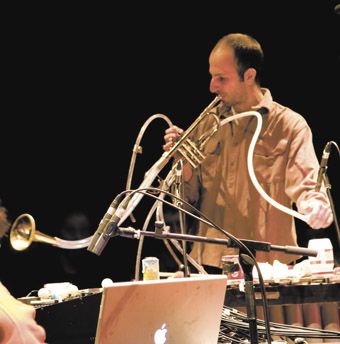
Dale Gorfinkel from Metalog, Liquid Architecture 9 Melbourne
photo Louise M Cooper
Dale Gorfinkel from Metalog, Liquid Architecture 9 Melbourne
BRINGING TOGETHER A GROUP OF PRACTITIONERS USUALLY ON THE PERIPHERY OF MUSICAL CULTURE, LIQUID ARCHITECTURE PROVIDES AN IMPORTANT FORUM, RAISING THE PROFILE OF SOUND ART AND BRINGING IT TO A LARGER AUDIENCE. IN DOING SO IT HAS ADAPTED SOUND ART MODES OF PRESENTATION RATHER THAN THE TRADITIONAL INSTRUMENTAL CONCERT MODEL. IN NORTH MELBOURNE TOWN HALL SIX CHANNELS OF SOUND SURROUND THE AUDIENCE, SEATED IN A CIRCLE, CREATING AN IMMERSIVE LISTENING ENVIRONMENT. LISTENING BECOMES A MUCH MORE INWARD EXPERIENCE. THE AUDIENCE ENTERS A MEDITATIVE SPACE, DRAWN TO SUBTLETIES IN THE SOUND AND THE KINAESTHETIC SENSATIONS THEY EVOKE.
Making effective use of the multi-speaker setup, Jacques Soddell presented a work that sent field recordings, samples and white noise sliding around the space. Not afraid to use single sound sources with gaps and silence, this work slowly developed out of simplicity, often returning to samples almost as a kind of recurring theme. Rod Price presented a work similar in its use of field recordings and synthesised sound, although combined in a way to create a darker and heavier atmosphere. Sound masses would often build, colliding with other loud gestures, creating a sense of immediate impact and whiplash.
Canadian artist Robert Normandeau, a highlight of this year’s program, presented a three movement work with a subtle control of dynamic, dispersing sound around the space to dizzying affect. These works, characterised by voices murmuring and chattering, stood out in the way they used sound to create a feeling of movement, shifting energy and momentum skilfully between medium, fast and extremely fast. French artist Cedric Peyronnet’s was also a standout performance, masterfully combining field recordings from the French countryside to create surreal atmospheres, building to levels of high intensity and energy. Taking a different tack, Lawrence English’s work began exploring the lower end of the volume spectrum. Distorted shards of low pitched timbres were gradually layered to build a slow moving and ambient texture. Particularly interesting in this work was the beating of sound waves, caused by slight discrepancies in pitch.
German artist Andrew Peckler opted for a lighter and more playful approach, presenting a work largely built upon harpsichord and celeste samples. These semi-melodic fragments, combined with oscillators, ring modulators and a modular synthesiser, gradually evolved into a predominately rhythmic piece. Breaking from the mould, Peckler’s work might just as easily be heard in a club—a real break with the austerity and seriousness usually felt at these town hall performances. To Peckler’s credit, this piece had buoyancy and colour created through pitch organisation and contrasting rhythms, even if at times the drum ‘n’ bass-ish sections did feel a little out of place.
The collaborative ensemble Metalog comprises Jim Denley (alto saxophone), Amanda Stewart (voice, text), Natasha Anderson (contrabass recorder), Dale Gorfinkel (vibraphone, trumpet), Robbie Avenaim (percussion) and Ben Byrne (tape and electronics). Focussed on bridging the gap between laptop and instrumental performance, Metalog presented a work with a diverse sonic spectrum, yet with a feeling of ensemble interaction and collaborative composition.
Denley’s gurgling water through his saxophone, Stewart’s lip chattering and the motor on Gorfinkel’s vibes repeatedly striking various objects provided a charactersitic Metalog layering of sonic planes of various timbral densities. These larger gestures were punctuated throughout by shorter rhythmic shapes, mainly articulated by Denley and Anderson. The success of this work came from the bringing together of six very compatible artists, always listening closely, never cluttered, and maintaining their distinctive voices while sustaining a strong aesthetic direction throughout. As in much of Liquid Architecture 9, the sounds generated by the works fell outside traditional musical syntax, encouraging the listener to become absorbed in the very sound itself.
Liquid Architecture 9, North Melbourne Town Hall, July 18-19
RealTime issue #87 Oct-Nov 2008 pg. 47
© Simon Charles; for permission to reproduce apply to realtime@realtimearts.net
THE DAVID CHESWORTH ENSEMBLE’S DISTINCTIVE SOUND WAS HEARD RECENTLY IN ONE OF ITS RARE SYDNEY OUTINGS. THE GROUP PLAYED COMPOSITIONS FROM CHESWORTH’S MUSIC TO SEE THROUGH (AVAILABLE ON CD, WWW.MINC.COM.AU) WHICH RECEIVED THREE NOMINATIONS FOR INSTRUMENTAL WORK OF THE YEAR AT THE CLASSICAL MUSIC AWARDS AND OPENED AT THE SYDNEY CONSERVATORIUM WITH ONE OF THE WORK’S MOST ENGAGING PIECES, THE SET THEORY-INSPIRED PANOPTICON.
Panopticon’s gentle pulse of thrust and relax, ascent and float, established the character of the concert—semi-meditative, lyrical and with a sense of time that allows for attention to instrumental texturings and juxtapositions. But there were plenty of exceptions. Such apparently simple music (Chesworth in his introduction spoke of it as “laidback, kind of easy listening”) certainly keeps the musicians busy—a virtue of seeing the work in concert and getting that little extra aural insight into its construction. The breaks in the patterning in such works, a kind of suspension, has quite an impact, with passages from violin or cello or any of the instruments followed by a return deep into the primary pattern (which has stayed gently vibrating in our bodies).
But not everything’s meditative; ensuing pieces variously march or dance out of the frame and suggest movie suspense or grand macabre moments. Floating World, rising out of a supple piano ostinato picked up by the violin is sad in a curiously sunny way (a definition of melancholy?), soaring before returning to the piano. Perpetual Presence opens dramatically with drums and vibraphone, moving on to trombone growls and string glides and then into something almost cartoony, almost jazz and in a mad rush. Blind Forever is jauntily folk-ish, awash with liquid sounds this time. A Chesworth composition from 25 years ago, Shady Elements, recalls French movie scores and is aptly charming, ever flying.
For a complete change of pace a very dynamic, side drum driven Heaps with warbling trombone and tinkling piano, escalates into mad big band sound. Bongo had Chesworth on whistle and ocarina and FX as this movie music-ish piece launched into a trombone led riff against chugging strings and onto another powerful surge into a sound that suggested a far larger ensemble. In a less formal venue we might have danced.
The top line players were all in fine form and the concert’s trajectory from measured emotional intensity to skilfully excecuted, brash playfulness made for a satisfying experience, superficially ‘easy’ but always diverting in the details and often surprising in the many departures from the composer’s fundamental idiom.
New Music Network, David Chesworth Ensemble, electronics David Chesworth, piano John McAll, violin Andrea Keeble, cello Helen Mountfort, percussion Eugene Ughetti, percussion Peter Neville, trombone Simon Myers, bass Jeremy Alsop; Sydney Conservatorium of Music, Sept 14
RealTime issue #87 Oct-Nov 2008 pg. 47
© Keith Gallasch; for permission to reproduce apply to realtime@realtimearts.net
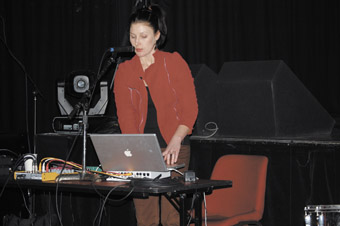
Kusum Normoyle, Liquid Architecture 9 Sydney
photo Alison Richardson
Kusum Normoyle, Liquid Architecture 9 Sydney
THE ROMANTIC IN ME WILL ALWAYS FEEL THAT THE IDEAL VENUE FOR EXPLORATORY MUSIC AND SOUND IS THE SMALL DINGEY SPACE WITH THE MAKESHIFT SEATING, THE MILKCRATE TABLES AND THE QUIET TENSION OF A SMALL ATTENTIVE AUDIENCE. HOWEVER THE FESTIVALS THAT GALVANISE THE OFTEN SCATTERED COMMUNITIES OF EXPERIMENTAL MUSIC MAKERS NEED LARGER VENUES THAT CAN ACCOMMDATE BIGGER AUDIENCES, BETTER SOUND SYSTEMS AND OVERGROUND MARKETING CAMPAIGNS.
For the last three years the Sydney leg of Liquid Architecture has partnered with Performance Space, utilising the Cleveland Street premises and the new CarriageWorks complex. While this has provided great exposure to a wider audience, these venues have pushed the presentation mode closer to that of formal concert and for me this often brings with it a sense of claustrophobia.
This year, with new Sydney directors Alex White and Jennifer Teo in charge, the festival moved to The Factory in Marrickville, home to eclectic programming generally on the rock/popular music side but which has hosted the NOW Now festival in the past. This venue allowed for a more relaxed presentation however the serious rigour remained intact.
The festival opened with Kusum Normoyle, a relatively new addition to the Sydney sound landscape. She starts singing quiet, shakey notes that hang naked and vulnerable until one is looped, the tentative vibrato turning into texture. The analogue input of strident sibilants, hissing purrs and throaty growls is gradually folded in with feedbacks and statics to create a complex morass of sound. At one point it coalesces into slippery beats, at another into a distorted vocal cacophony with a gothic feel. Ideas and processes are mostly well structured into clear movements rather than the seemingly endless crescendo so common in improvised laptoppery, though the last section did seem to extend just a little beyond its natural life. That aside Normoyle’s approach to the partnership of vocals and computer processing is bold and intriguing.
Also focusing on voice, Canadian artist Robert Normandeau (in town courtesy of the Australasian Computer Music Conference), presented a stunning set in acousmatic style—precomposed work spatialised live. With alarming clarity he spins moans, cries, laughs and gasps around the multiple speakers, the combinations forming rhythmically punchy pieces. Cascading sheaths of sound seem almost gelatinous, yet within this, each element is precisely placed. The figurative nature of the samples is often preserved—he describes his work as “cinema for the ear”—giving some of the pieces a cartoon slapstick feel while others conjure B-grade sci-fi fantasies. The content may not have been to everyone’s taste, but the masterful execution was undeniable.
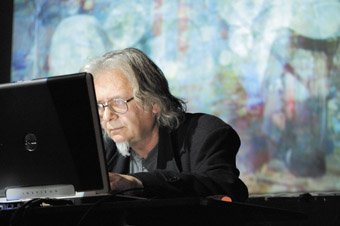
Jacques Soddel, Liquid Architecture 9 Sydney
photo Alison Richardson
Jacques Soddel, Liquid Architecture 9 Sydney
Not all the visuals had to be imagined. Jacques Soddell opened with video impressions of a face, shifting in and out of perception accompanied by liquid static. Big, rich sustained tones drive us through beautifully framed tunnels and telegraph lines, followed by an aggressive overload of interference laden, cutup media images and the sound equivalent of dirty pointillism. Besides the ‘meaningful’ conclusion (the image of a church altar), Soddell on the whole walks a fine line between abstraction and narrative which complements his sound explorations.
Toby Grime also used visuals. His sound is like a organism made of grainy drone that incrementally grows—understated yet somehow hinting at the ecstatic with luxurious shifting harmonies. He accompanies this with premade video material which maintains a similar tension. The close-up of a man’s mouth in profile, with water droplets suspended in air, looks like slick advertising. As the footage slowly moves in reverse, we discover that the captured moment is of the man literally spitting a dummy. While the simple narrative becomes clear, the sensuality of the footage combines with the suspension of the sounds to push us beyond literal interpretation.
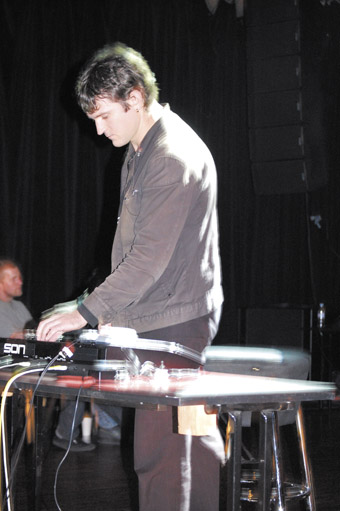
Nat Bates, Liquid Architecture 9 Sydney
photo Alison Richardson
Nat Bates, Liquid Architecture 9 Sydney
There were two outstanding performances across the festival. One came from national festival director Nat Bates. Lit from behind, seated at a keyboard, Bates starts with a dramatic stadium rock sting. Using an antique Ensonique ASR10 sampler, he takes the iconic sounds of epic rock—cymbals, drums, grand full band stabs—and explores them as artefacts. By using the sounds minimally and deftly spatialising them, he lets us hear beyond the cliché to the timbral and textural essence of the sounds themselves. A cymbal plays out longer than is physically possible, cycling around the speakers: we identify it as a cymbal yet hear beyond it to the metal, to the computer bits that stretch it, to the room it was recorded in and the one in which it is played. It’s ear and mind expanding—an exploration of both the sound of a sound, and an interrogation of the meanings and associations imposed on it. The combined result of this sustain and suspense is intriguingly cinematic, even noirish. As a dramatic conclusion Bates triggers a final rock stab and a seemingly infinite reverb rings out…it’s still going as he leaves the stage.
The fitting climax to the festival came from Marcus Schmickler. Generally I don’t take up the option of earplugs. You end up missing vital frequencies, and perhaps it might be better just to turn it down. But with Schmickler the volume is the essence so I succumbed. Bass driven, his sound becomes physical—walls, floor, ceilings, internal organs begin to vibrate with his fierce, overlapping, ascending tones carving out another dimension. We are all at the centre of the Earth in the hot larval flow of Schmickler’s creation. With the strange internalisation that earplugs give I begin to feel that the music is emanating from within me, from us as an audience. The effect is powerful, verging on spiritual, with no drugs required.
Over two nights Sydney’s LA9 was smaller in scale than previous festivals, but limiting the acts to five per night was just right for maintaining audience attention. Nor did the program lack variety with approaches ranging from the brash noise hackings of Nick Wishart (Toydeath) and Hirofumi Uchino, to the quiet improvising organism of Metalog, to the sweet beats of Andrew Peckler, with some compact sound installations and a screening loop thrown in as well. Liquid Architecture on a national level has developed such a strong yet flexible curatorial approach over the nine years of its operation that the identity of the festival remains clear while allowing room for new directors to make their mark.
Liquid Architecture 9, Sydney; directors Alex White, Jennifer Teo, national director Nat Bates; Factory Theatre, July 11-12
RealTime issue #87 Oct-Nov 2008 pg. 48
© Gail Priest; for permission to reproduce apply to realtime@realtimearts.net
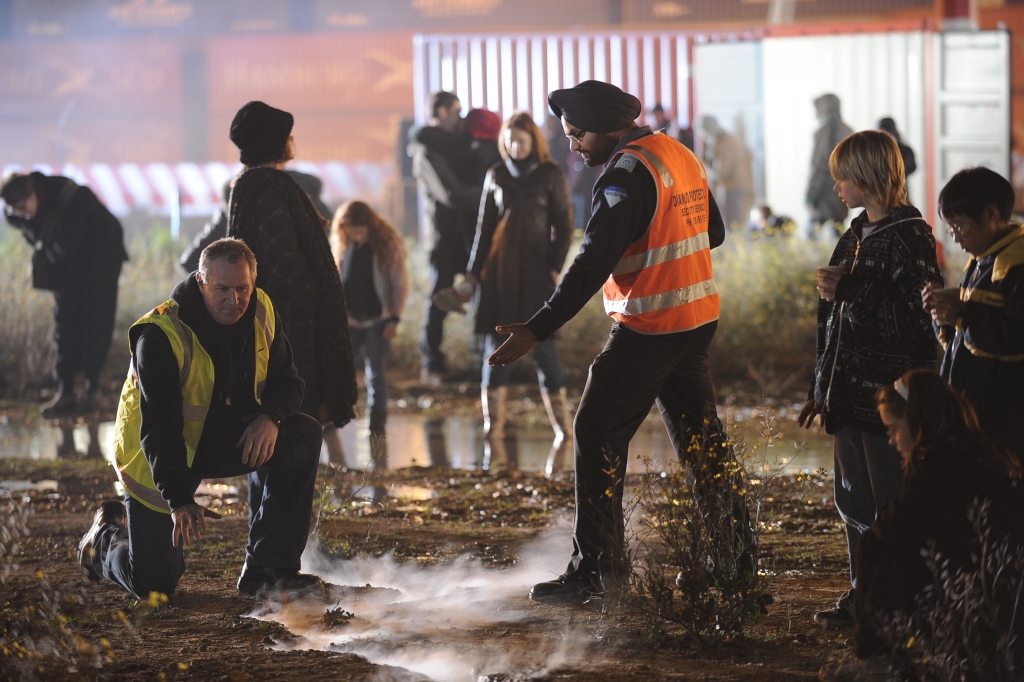
Crowd Theory – Port of Melbourne, 2008, Simon Terrill, produced in association with Footscray Arts Centre and Port of Melbourne, photo Matt Murphy
INSIDE THE SECURITY-CONTROLLED PORT OF MELBOURNE, AUGUST 2, JUST ON 5.30 PM: A BROODING SKY, AN EERIE SOUNDSCAPE, SHIPPING CONTAINERS, SCATTERED WEEDS AND PUDDLES, AND 160 WARMLY DRESSED ‘PARTICIPANTS’ COMBINE IN AN HOUR-LONG ‘MOMENT’—THE CREATION OF THE FIFTH IN SIMON TERRILL’S CROWD THEORY SERIES OF PHOTOGRAPHS. THE RESULTING IMAGE CONVEYS A SENSE OF THE TENUOUS RELATIONSHIP BETWEEN A MAJOR URBAN LANDMARK AND THE COMMUNITIES THAT SURROUND IT, AND THE IRONIC NARRATIVE OF A FROZEN ‘CROWD’, WHOSE PRESENCE IN THE PHOTOGRAPH TESTIFIES TO ITS COLLECTIVE AFFINITY WITH THE PORT.
Crowd Theory—Port of Melbourne is, for Simon Terrill, a kind of proposition: both an exploration of the physical space of the Port and a kind of documentary fiction based around the responses of participants to the location. While the scene is carefully constructed—the patch of earth sandwiched between West Swanston Dock and the Coode Island liquid storage facility appears much like a film set—Terrill is not interested in directing participants. Instead, he asks people to consider their relationship to the Port as they form the ‘crowd’ that he captures from atop a 6.5-metre scaffolding tower.
Between the endless beeps and clunks of the dock area and the dark silence of the Coode Island terminal, this crowd is restless, curious. The sun is about to set as people tuck into hot soup, compare gumboots, beanies and scarves, and watch the awesome display of cranes unloading a nearby ship. Four busloads of local residents, interested ‘outsiders’, port workers ranging from office staff to truckies and engineers, a few kids, amateur artists and sundry others have been shuttled across from Footscray Community Arts Centre—producer of the Crowd Theory series and partner with the Port of Melbourne Corporation for this image. As the clouds move in and the light softens, marshalls lead the crowd into the shot and the event begins to take shape.
Simon Terrill has worked with Footscray Community Arts Centre to create Crowd Theory images in four other locations: by the Maribyrnong River at Footscray (2004), at Skinner Reserve in Braybrook (2004), at Footscray Station (2006) and at Southbank (2007). The Footscray photograph won him the $10,000 KPMG Tutorship Award in 2005. Looming clouds have been a feature of all but one of the photos, throwing an enclosing moodiness over scenes of saturated colour and precise composition. The Southbank image stands distinctly separate, its participants both dwarfed by, and part of, a wall of high-rise windows and balconies.
The Port of Melbourne shoot unfolds rhythmically under bright lights: 10 shots are taken throughout the sunset hour, and during each 10 or 15-second exposure the slowly evolving soundscape gives way to a long, solid tone. As the shoot progresses, obvious fascination with the usually hidden landscape gives way to individual preoccupation with the next shot: what we will do, what we will think. Before each exposure, Terrill reminds us over the PA to spend the duration of the exposure focusing on “that one Port thought”—and everyone seems to take it seriously, embracing each extended ‘moment’ with a deliberate, small gesture in the midst of the scattered whole.
Terrill insists on the importance of allowing each person to respond and represent themselves as they choose. “I see the hour of the making of the picture very much as a ritualised hour”, he says, adding that his role at that point is simply to facilitate that ritual. For Terrill the final photograph will encapsulate “all that precision beforehand, and then, in a sense, the anti-precision of the crowd space.”
The process feels strangely unreal, like a cross between friendly gathering, facilitated trespass and private journey. The location itself seems part real, part artifice—another contradiction that Terrill is keen to explore: “that tension between the fictional image, the things that have gone into making that image, and the attributes which come from that place.”
Crowds, says Terrill, are formed both of shared experience and a kind of “unconscious group mind”, and this idea has been central to all five Crowd Theory images to date. The photograph selected for the final 1.8 x 2.4-metre print is the one he sees as capturing the ‘moment’ during the ritual in which a coherence begins to show itself in the pattern of bodies. Having employed the same process for each image in the series, Terrill says he’s learned to recognise that moment, usually somewhere towards the middle or end of the shoot, when participants’ uncertainty and exploration gives way to a kind of group energy.
Citing Elias Canetti, Terrill describes this ‘crowd-moment’ as being “one of the true moments of equality, where differences between people do drop away.” Canetti’s Crowds and Power, he says, begins with the statement that human beings’ primary fear is that of being touched. “The crowd situation removes that fear”, says Terrill, “and all these interesting things start to happen, psychologically. It’s quite beautiful, the idea of genuine equality, for that fleeting moment.”
Further threads feed into the overall project, with Footscray Community Arts Centre, the Port of Melbourne Corporation and the artist, not to mention the participants, all having an investment in the aesthetic outcome. For Footscray Community Arts Centre the project marries critical artistic practice with community engagement and for the Port Corporation it serves an important community relations function. The final shot seems to be horizontally layered: the ‘community’ almost floats in the middle ground, suspended between the chosen location and the massive port infrastructure behind.
There is also a paradoxical stillness—the hour-long ‘ritual’ was an hour of almost-constant movement as participants explored the site, talked to strangers, watched the cranes and the sunset. The image of the frozen ‘moment’ is indeed a fiction—the long camera exposure can’t be discerned directly in the photo, except for some blurring in the Panamax cranes on the wharf. Terrill’s humble crowd finds its feet and stakes its tenuous claim, both co-existing with and deferring to the mystique of the machinery and the process that goes on, 24/7, behind the wire fences.
–
Crowd Theory—Port of Melbourne, artist Simon Terrill, produced by Footscray Community Arts Centre in partnership with the Port of Melbourne Corporation, Aug 2, Port of Melbourne; Exhibition, Mission to Seafarers, Melbourne, Aug 28-Sept 28,
Urszula Dawkins is a freelance writer, editor and arts worker based in Melbourne.
See cover for the complete Crowd Theory–Port of Melbourne photograph.
RealTime issue #87 Oct-Nov 2008 pg. 49
© Urszula Dawkins; for permission to reproduce apply to realtime@realtimearts.net
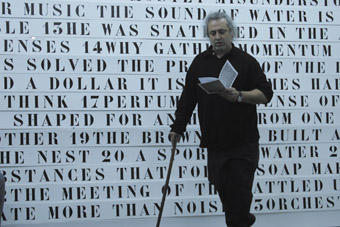
Ruark Lewis, A Babel Reading-Machine (2005)
photo William Yang
Ruark Lewis, A Babel Reading-Machine (2005)
RUARK LEWIS IS A PASSIONATELY POLITICAL AND COLLABORATIVE ARTIST WORKING ACROSS AND INTEGRATING PAINTING, DRAWING, INSTALLATION, ARTIST BOOKS, PUBLIC ART, PERFORMANCES, AUDIO AND VIDEO WORKS. HIS METHOD, WHICH HE TITLES “TRANSCRIPTION (DRAWING)”, OFTEN TAKES THE WORK OF OTHER ARTISTS—COMPOSERS, POETS, CHOREOGRAPHERS, ANTHROPOLOGISTS AND FELLOW VISUAL ARTISTS—AND TRANSFORMS IT INTO ABSTRACTED TEXT EMBODIED IN IMMACULATE SCULPTURAL INSTALLATIONS IN A RANGE OF MATERIALS INCLUDING CLOTH, TIMBER AND STONE, OR TRANSPOSED ONTO THE FACES OF BUILDINGS, AS IN RECENT PUBLIC ART WORKS. THIS ARTICLE REPRESENTS A SMALL PART OF A FASCINATING CONVERSATION YOU CAN FIND AT WWW.REALTIMEARTS.NET.
Like a good poem, a Ruark Lewis work encourages contemplation and promises delayed revelation; then it’s art that stays with you. The man himself is more immediately accessible, an ubiquitous and energetic arts presence (despite a taxing physical disability) and an eager conversationalist—one for whom conversation, he says, is the source of much of his art, building on the images that first occur to him and take flight through talk and are then realised often in collaboration.
A long conversation with Ruark Lewis is a rich journey into cultural history from the 1980s on, of which his own career is a fascinating part. After studying ceramics, Lewis turned to curating public events for four years for the Art Gallery of New South Wales in the late 1980s. The resulting programs brought together a wide range of artists in performative mode. Doubtless, these telling juxtapositions and potentials for partnerships inspired the conversations which became his own collaborative art in the 1990s and up to the present. He created RAFT, a major work with Paul Carter for the Art Gallery of New South Wales and other commissioned works—for the 2000 Sydney Olympics, 2006 Biennale of Sydney and Performance Space. He collaborated with Jonathan Jones on an installation called An Index of Kindness at Post-Museum in Singapore 2007. His recent outdoor installations and sound works in the City of Sydney focus on the consequences of urban development. In October this year he travels to Canada where he’ll create a commissioned public art installation called Euphemisms for the Intimate Enemy for Toronto’s Nuit Blanche festival.
the public house
I asked Lewis about his City of Sydney project, which has recently taken him to Millers Point with its small remaining population of an older community residing amidst new developments and the palpable wealth of new apartment dwellers in the Rocks and Walsh Bay. He describes it as “a public artwork, which includes agit-prop elements, working with a group of people, studying the area and trying to develop a spoken word archive piece, an archive of community comment about lifestyle in the area at this time to do with ‘the public house.’ I’m looking at the ways that development encroaches upon traditional communities living in the inner city areas.” Lewis sees Sydney as having been through several visionary planning periods and with “a remarkable political history when you look at what the BLF forged with the Green Bans…It’s a history of significant counterpoints between the dissident voice, the resistant voice and the government and the developers.” The words of the community, material for Lewis’ text, are being found at the Darling Harbour branch of the ALP and the National Trust and Tenant’s Union.
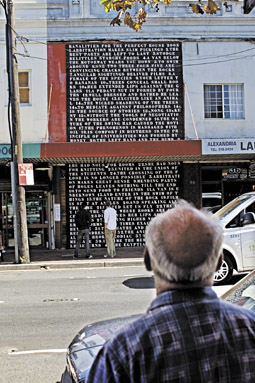
Banalaties for the Perfect House installation, Slot Gallery
photo Alex Wisser
Banalaties for the Perfect House installation, Slot Gallery
Lewis is keen “to make an environmentally integrated artwork. That’s how we worked at Homebush on public art at the Olympic site, making Relay with Paul Carter’s text during 1999-2000 as a Sydney Olympic Games commission. There are no spaces between words and I designed a colour code to cross-reference through the ongoing sequences of five rising stone steps. We had three kilometres of texting going up and down those stone bleachers. The planners were very keen to create a public art that would environmentally integrate with both the site and the sporting events and audience. They didn’t want decorative art baubles. I thought that was a workable approach for an ongoing strategy for placing works in the public zone…I’m still working on that idea and trying to find ways of lightly integrating installed works into the actual building fabric. I’ve done it on couple of locations recently. At an artist-run-initiative called SLOT in Regent Street Redfern I made a seven-metre high façade on the front of the building using the width of the shopfront downstairs and closing off the apartment windows upstairs and taking the text all the way to the parapet. It’s a peoples’ poem called Banalities for the Perfect House.”
We watched and spoke to a lot of people in the street in Redfern to see what their reactions were. A grandmother was drunk in the street and she had tears in her eyes as she stared across the road. “What’s this? What’s this?”, she kept crying. I asked her what the matter was and she replied, “I’ve got to explain this to my grandchildren because when I come up here shopping with them they’re gonna ask about it.” So I said “maybe it’s poetry.” She said, “I know it’s fucking poetry! But what does it mean?” I said, “I’m not quite sure what it means.” She said, “Ah! come on it’s not that complicated.”
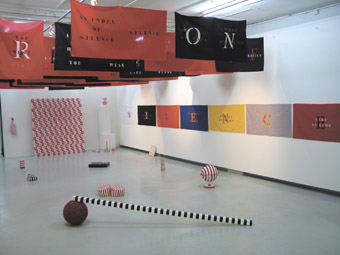
An index of Kindness, Chalk Horse Gallery, Sydney, 2008
courtesy the artist
An index of Kindness, Chalk Horse Gallery, Sydney, 2008
municipal signs & other objects
Lewis’ most recent show, at Chalk Horse in Sydney’s Surry Hills, draws on work from his shared show with Jonathan Jones at Singapore’s Post-Museum. The gallery was hung with flags stencilled with words from Nathalie Sarraute’s play SILENCE. Below, on the floor and plinths, everyday found objects had been painted with red, black and white stripes and markings, making the gallery-goer doubly attentive—to where they trod and how they were regarding the art. Lewis surmises that he’s using the gallery to test out some of his outdoor optical and spatial systems: “I’ve been considering the sculptural objects in the show as decoys. They’re like the rocks of Mer in the Torres Strait. Eddie Mabo identified a bunch of rocks around his Island of Mer as being the markers for the language or community zones. I thought that’s a very useful message for all Australians to start to recognise…”
In Singapore, says Lewis, “I was actually looking for garbage. I thought, here’s a place where you can’t have long hair, you can’t chew gum, what can you do? So I started making work about the garbage—on the streets, in the countryside or washed up on the beach…I stencilled messages onto pieces of garbage.” Then he placed the garbage back where he found it and made a photographic record: “This formed an intimate poetic puzzle. I wanted to leave messages for people anonymously. I avoided the fear of arrest by photographing the evidence before and after I removed it. Sometimes I kept elements of the garbage to paint an abstract pattern on it—with red and white or black and white stripes painted in gouache.”
the artist begins
We step back in time to Lewis’ beginnings as an artist. He went to Sydney Boys High School where “One day I went up to the art room and a friend of mine was throwing on the pottery wheel. I became totally mesmerised how that form came up out of his hands and fingers. I loved the slithering plastic action of the clay that formed in his hands. I went straight out and bought a bag of clay that afternoon and made a sculpture, not a pot as such.” With a photographer brother and musician and painter cousins, Lewis describes himself as “sort of coming from a Jewish artistic family—a tribe of mercantiles and artists. According to the painter Cedric Emmanuel our earliest Australian relative was Michael Michaels. He was a forger who was pardoned in 1809 and left Sydney returning to London and he started an orchestra. We’ve always had painters and musicians in the family so making things seems natural to us.”
Lewis studied Ceramics at the Sydney College of the Arts: “It was difficult for me physically but I needed the tangibility of clay.” But a major influence there opposed his interest in ceramics: “the composer David Ahern in the Sound department. David was a total radical. He’d been working with Cornelius Cardew in London and for two years was a personal assistant to Karlheinz Stockhausen. He came back to Sydney in the early 70s and among other things he ran a Sunday new music workshop out of Inhibodress Gallery. That was the group called Teletopia and AZ Music. Tim Johnson and Mike Parr and Peter Kennedy ran the avant-garde concept gallery the rest of the week. But on Sunday the experimental artists ran an open studio where trained and untrained musicians joined together to perform music. Although I wasn’t involved in those early years I’ve been very interested and was highly motivated and inspired by Ahern’s practice. It was wild. It was recklessly terrific. I thought this is really what art’s about. Because it was a language made of sound and music…Ahern was very discouraging of my interest in ceramics and always urged me to paint and draw.”
But, says Lewis, “Ceramics gave me a sort of classical education, which I may not otherwise have received in such a serious avant-garde art school.” An interest in architecture has also been “infinitely useful.” Such contrasting influences were to yield a seriously idiosyncratic artist. The sense of difference was compounded in 1984: “I was expelled from Sydney College of the Arts. That was pretty demeaning—it really wasn’t my fault. I also had been expelled from Sydney Boys High School in 1978. Perhaps both these rejections shore me up as a kind of outsider in art—in that I seemed able to miss out on certain unnecessary things exactly at the right time.”
the artist as curator
Lewis began first as a reader and then as a curator of poetry readings at the Art Gallery of New South Wales and then with Emmanuel Gasparinatos “who programmed a new media event in the theatrette called Sound Alibis with 14 artists including Rik Rue, Warren Burt, Sarah Hopkins and Vineta Lagzdina. There were Super 8 films and sound works and live performances. I developed the program further the next year with the poet and scholar Martin Harrison [who] was interested in the writer/performer as live presence…This began a really successful curatorial collaboration [becoming Writers in Recital]: it made the AGNSW the stage to a wide range of writers and musicians, composers, filmmakers, visual artists, performers dancers, radiophonic composers…I kept working out ideas of how to get the most radical types of experimental art out to the widest audience possible…even radio stations like 2GB would give me a five minute interview each season. I saw it as an act of anti-elitism to promote radical art to a willing public.” The big names, poets like Judith Wright, David Malouf or Les Murray, were programmed to attract large audiences who would witness, for example, “the soprano Elizabeth McGregor singing the Margaret Sutherland settings of early Judith Wright poems alongside the relatively unknown work of Allan Vizents, William Yang, Ania Walwicz or Jonathan Mills.”
escape to melbourne
After four years of curating, “in August 1990 I escaped Sydney. In Canberra I found a copy of TGH Strehlow’s Journey to Horseshoe Bend. It’s a biography/autobiography about the death of his father, the missioner Carl Strehlow in Central Australia in 1922. I started reading what turned out to be a transformative book for me.” It was important in developing Lewis’ art of “transcription” and “texting”, which would later lead to a major work with Paul Carter.
About the origins of his artistic process, Lewis explains, “I wanted to lay in poetic lines from poets I was reading at the time, like Rilke’s Duino Elegies. I wanted to actually enact it as a trace. At the time I was working on musical and sound transcriptions in the form of drawings. That’s how I’d begun texting into works and making abstract cross-overs from one art form to another.” He made diagrammatic drawings of sound works—acoustic music and then the work of the Sydney composer Robert Douglas who was making large-scale works on the Fairlight CMI.
my university
In Melbourne, Lewis spent time with Paul Carter, the director Peter King, Jonathan Mills, Warren Burt, Chris Mann, Vineta Lagzdina and Rainer Linz. The experimental music scene was particularly influential, coming out of the Clifton Hills Community Music Centre and the NMA magazine: “The Rainer Linz and John Jenkins’ 22 Australian Contemporary Composers anthology was the sort of curatorial guide I’d been looking for at AGNSW. There had been little like that sort of thing operating in Sydney…That was also the era of the ABC’s radio’s The Listening Room. Carter had been editing the Age Monthly Review which we’d all contributed to over the years. This was an artistic atmosphere I called ‘my university’.”
In Melbourne Grazia Gunn, director of ACCA offered Lewis a major solo exhibition opportunity which he worked on for two years. “I finished the Robert Douglas transcriptions, which ended up being 48 metres of extended drawing. The 48 panels occupied the Lotte Smorgon Room at the old ACCA in Melbourne’s Domain. There were studies of Douglas’ Homage to Bessemer. I made a room of literary transcriptions based on the French newspaper Le Monde. I’d been in Paris in 1991 and I found a way to look at the demarcations between the generating forces in commercial print media. It was a simple critique of how photography, journalism and advertising worked in concert on the pages and how that formed the capital which is the motivation for a daily publication.” The exhibition was part of Melbourne Festival in 1992: “Melbourne was into high postmodern and neo-expressionist painting then, and along comes an incredibly cool minimalist show with regional underscores. It was shown there for a lengthy 14 weeks.”
But the Melbourne show did not result in Lewis being immediately picked up elsewhere. He comments wryly, “I like the fact that you can work ‘fairly privately’ in Australia. I always understood that experimental art would be ignored by the local art cognoscenti and that the avant-garde was taken up by the academies that could easily canonise it in what I regard as a pseudo international context.”
the experimental realm
Lewis makes strong distinctions between the realms of the avant-garde and the experimental: “It was the expansiveness, I suppose, of the experimental realm, the idea that art and production could take on other forms in constant flux and I could rewrite them…” And there was a correspondence to this work outside of Australia for my artistic friends. John Cage had picked up on Chris Mann’s work and set it for an opera. What I find most interesting in writers like Mann and Walwicz is the certainty of their regional voice. [W]ith the experimental, there’s a sort of fraternity that I like, keen about reading through each other’s work, reading the sound waves that each artist arrives with.”
Lewis enjoyed this feeling when he met Kaye Mortley and René Farabet in Sydney: “Martin Harrison was a friend of Kaye’s. All sorts of interesting people came together at the Harrisons’ house. The dinners often went until dawn. When René and Kaye came to Australia a sort of sound circle developed around them and the Listening Room at the ABC and at UTS. René Farabet was director of the radiophonic atelier program called France Culture, so there were significant cross-overs with people working here. I went off to Paris in 1991 and had the best time of my life.” Lewis worked with Mortley on a rendering of the play Pour en Oui Pour en Non (Just for Nothing) by Nathalie Sarraute: “I immediately had a vision for setting the players’ script marked out on the page in different colours. The colour would navigate the reader through the text like a graphic score.”
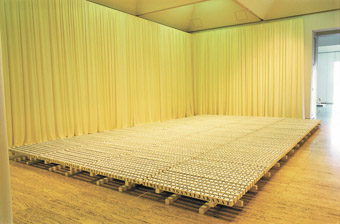
RAFT (2005), with Paul Carter, collection Art Gallery NSW
photo Ian Hobbs
RAFT (2005), with Paul Carter, collection Art Gallery NSW
the raft journey
Asked about the genesis of RAFT, Lewis explains, “I often have visions of things—I see them in visual daydreams and then follow the image directly along into the work. I saw a large gridded structure that seemed to extend out along the surface, so I set off in that direction. The timber of RAFT weighs 1.5 tons. I started testing possible materials when I was staying in Melbourne in 1993. I later made three large Water Drawings which joined RAFT at the Art Gallery SA showing in 1997. Then our book, Dept of Translation, appeared in 2000 to coincide with the exhibit at the Sprengel Museum, Germany which occurred in 2001. So, only about seven years gestation. The Art Gallery of NSW where it was first exhibited acquired the work earlier this year.”
“We were looking at the Arrernte water myth of Kaporilja as the main poetic cross-reference for RAFT. RAFT symbolises the carriage that Carl Strehlow was transported down from Hermannsburg to Oodnadatta to get a train to Adelaide because of his fatal illness. But he died on the way, just north of Fink at Horseshoe Bend. RAFT has to do with issues of translation in the desert. It allegorically acts as a portrait of the classical intercultural brokering of the language scholar and evangelist missioner Carl Strehlow with his links to the first phase of modern anthropology. What’s so amazing is Hugo Ball and Tristan Tzara performed various Arrernte and Lorritja songs at the Café Voltaire in May 1917…Three songs were performed, maybe with movement, and probably in the presence of James Joyce and maybe Lenin both of whom were resident in the neighbourhood. So, there’s the modernist trace again.”
the artist performs
I ask Lewis about the performative aspect of his work. In the exhibition at Chalk Horse there’s a beautiful recording of Amanda Stewart and Lewis doing something quite dramatic and very funny and largely unintelligible (but oddly familiar as social exchange) with occasional literal utterances. Lewis explains, “I have became increasingly interested in the process of concretising language and making a score I can follow and make performances from. Last year I asked Amanda” [whom he declares an inspiration] “to work on an improvisation that would in a non-representational way convey three emotions: anger, joy and sadness. As we huddled around a microphone in the studio we both began giggling, wondering how ridiculous we were, but a really intimate moment between artists emerged as we worked out a range of responses that we might record. Rik Rue collaged our efforts adding layers and depth and spatial elements which formed a kind of audio space poem at Post-Museum in Singapore in 2007. I called it An Index of Emotions. I think visitors were surprised and confronted by those spatial effects and some of the sobbing sounds and angry tones were quite distressing.”
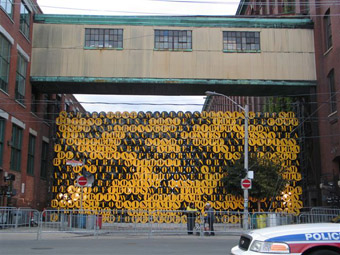
Euphemisms for The Intimate Enemy
nuit blanche, toronto
Lewis’ work for Toronto’s Nuite Blanche (an all night, one night exhibition of 155 works across the city) is a sound installation called Euphemisms for The Intimate Enemy, with a duration of 12 hours . As with The Banalities of the Perfect House “the sound is computer generated but will be a live collage when the computer is started around 7pm on the night of the event. I’ve devised an installation of 550 oil drums to be stacked as a curtain wall between two 19th century industrial buildings. Each word of the Euphemisms is stencilled onto coloured (black and yellow) painted drums and will form an illuminated text in the void.”
See also full interview transcript.
www.ruarklewis.com
RealTime issue #87 Oct-Nov 2008 pg. 50-51
© Keith Gallasch; for permission to reproduce apply to realtime@realtimearts.net

Euphemisms for The Intimate Enemy
RUARK LEWIS IS A PASSIONATELY POLITICAL AND COLLABORATIVE ARTIST WORKING ACROSS AND INTEGRATING PAINTING, DRAWING, INSTALLATION, ARTIST BOOKS, PUBLIC ART, PERFORMANCES, AUDIO AND VIDEO WORKS. HIS METHOD, WHICH HE TITLES “TRANSCRIPTION (DRAWING)”, OFTEN TAKES THE WORK OF OTHER ARTISTS—COMPOSERS, POETS, CHOREOGRAPHERS, ANTHROPOLOGISTS AND FELLOW VISUAL ARTISTS—AND TRANSFORMS IT INTO ABSTRACTED TEXT EMBODIED IN IMMACULATE SCULPTURAL INSTALLATIONS IN A RANGE OF MATERIALS INCLUDING CLOTH, TIMBER AND STONE, OR TRANSPOSED ONTO THE FACES OF BUILDINGS, AS IN RECENT PUBLIC ART WORKS.
Like a good poem, a Ruark Lewis work encourages contemplation and promises delayed revelation; then it’s art that stays with you. The man himself is more immediately accessible, an ubiquitous and energetic arts presence (despite a taxing physical disability) and an eager conversationalist—in fact conversation, he says, is the source of much of his art, building on the images that first occur to him and take flight through talk and are then realised often in collaboration.
A long conversation with Ruark Lewis is a rich journey into cultural history, of which his own career is a fascinating part. After studying ceramics (of which he’s still fond and a new work, a book about pots, is on the way), Lewis turned to curating public events each year for the Art Gallery of New South Wales in the 1980s. The resulting programs brought together a wide range of artists in performative mode. Doubtless, these telling juxtapositions and potentials for partnerships inspired the conversations which became his own collaborative art in the 1990s and up to the present.
Lewis has collaborated with writer Paul Carter, Nathalie Sarraute, Angelika Fremd & Ingaborg Bachamann, Rainer Linz, Jutta Hell & Dieter Baumann and Jonathan Jones. He has created work in Berlin and Singapore; Raft, a major work created with Carter, toured to the UK and Germany; and his commissions include works for the 2000 Sydney Olympics, 2006 Biennale of Sydney, Performance Space and the Art Gallery of New South Wales. He collaborated with Jonathan Jones on an installation called An Index of Kindness at Post-Museum in Singapore 2007. His recent outdoor installations and sound works in the City of Sydney focus, his website says, “on the theme of home, the homeless, huts and the public house.” In October he travels to Canada where he’ll create a public art installation called Euphemisms for the Intimate Enemy for Toronto’s Nuit Blanche festival.
sharing the public house
Before turning to Lewis’ career I asked him about his City of Sydney project, which has recently taken him to Millers Point, with its small remaining population of an older community residing amidst new developments and the palpable wealth of new apartment dwellers in the Rocks and Walsh Bay and the new suburb of Barangaroo.
RL I’m making a public artwork, which includes agit-prop elements, working with a group of people, studying the area and trying to develop a spoken word archive piece, an archive of community comment about lifestyle in the area at this time to do with “the public house.” It’s not precisely about public housing but the public house, a shelter for the street person, the homeless person and about the kinds of housing in general in the area. I’m looking at the ways that development encroaches upon traditional communities living in the inner city areas. (Mayor of Sydney) Clover Moore talks about “urban villages”, but I’d like to talk about a kind of city tribalism and urban history.
The City of Sydney has had three visionary planning periods forwarded by Francis Greenway, Sir John Sulman and George Clarke There have been architects like Peter Myers and Lesley Wilkinson who have built significant public housing projects in the city’s inner suburbs. Col James is a legend for his work and ideas around Redfern. Bill Lucas was my first mentor in urban planning and architecture. In the 1960s he was very focussed 0n saving Paddington from slum clearance and demolition. There’s been consistent conflict between the notion of slum clearance, new developments in public housing and developers in the City of Sydney since the early 20th century. It’s an expensive city. There’s a remarkable political history here when you look at what the BLF [Builders & Labourers Federation] forged with the Green Bans. That’s had an international influence responsible even in formative years of the Green Party in Germany. It’s a history of significant counterpoints between the dissident voice, the resistant voice and the government and the developers. So I think the issues to do with the status of the underdog are really important to focus on for urban activists. The massive corporate/state mentality is keen to erase our community history of resistance. It’s a situation where we hasten to forget. Right now we’re all very conscious of the nature of over-inflated value of property.
KG Do you negotiate your project with the Council and building owners?
RL Yes. I want to make an environmentally integrated artwork. That’s how we worked at Homebush on public art at the Olympic site [making Relay with Paul Carter during 1999-2000 as a Sydney Olympic Games commission]. The planners were very keen to create a public art that would environmentally integrate with both the site and the sporting events and audience. They didn’t want decorative art baubles. They wanted art as user-friendly contextual forms not visually rhetorical objects. I thought that was a workable approach for an ongoing strategy for placing works in the public zone. Especially if you wanted to utilise space to make a public poem. I’m still working on that idea and trying to find ways of lightly integrating installed works into the actual building fabric. I’ve done it on a couple of locations recently. At an artist-run-initiative called SLOT in Regent Street Redfern I made a seven-metre high facade on the front of the building using the width of the shopfront downstairs and closing off the apartment windows upstairs and taking the text all the way to the parapet. It’s a peoples’ poem called Banalities for the Perfect House. Here’s a selection from it:
1. Arbitration makes slim pickings 14a. The wicked smashing of the trees 15c. Without the tools of negotiation the workers are condemned 16. The nature of the swing has caused the motion 17. A phenomena is massaged by oil 19. The principle of universities is formed with money 20. The left hand and the dumb 21. He has nous for rooms 22. She had nous for knitting 23. United in the union of the students 24. A crossing of the floor is no longer possible
The materials had previously been part of a theatre work at Performance Space in Cleveland Street in Redfern but generally the people of Redfern wouldn’t have readily accessed it. Moving the text outside the theatre seemed a stimulating extension and use of the original efforts.
[Melbourne composer] Rainer Linz and I were really keen on looking at the ideals of the visions for housing in Sydney and the potential for social inequity that gentrification enforces. In response to this we developed an installation-cum-music theatre work. Parts of that later were adapted to the street which was very startling, like a fish out of water. We had part of the set in the street for five weeks. They were large but delicately hand-stencilled white characters on black timber boards extending across the front of the building. It looked boarded up. The surface could have been hit by graffiti artists or damaged by vandals or scribbled on during that period. It was interesting to see it was actually still in pristine condition when we took it down. We documented a lot of people stopping and reading the work in the street during the day and the night.
KG Did it have a sonic element?
RL No. It was just textual. It could have had that. It was fairly cost effective to put up. We installed it in three hours, literally transforming a whole facade and street. That was a real surprise to the cosmopolitan Redfern community—all of a sudden the walls were talking and it wasn’t advertising, it wasn’t municipal signage. We didn’t even seek official permission.
KG Was there any explanatory material with it?
RL Gina Fairly and Tony Twigg arranged an information sheet on the front of the building, but I must say I would have liked to have presented it anonymously like a surrealist’s dreamscape.
working the public
KG You’re politically and socially motivated but your work resides in a modernist tradition that wants to make its audience work and not be given any easy solutions or instant intelligibility. Is that an issue for you?
RL Yes, especially when it’s in a really public art zone like at the Sydney Olympics site. Paul Carter’s Relay text is quite difficult, like Russian constructivist Zuam poetry. There are no spaces between words and I designed a colour code to cross-reference through the ongoing sequences of five rising stone steps. We had three kilometres of texting going up and down those stone bleachers. I find audiences always engage in difficult work—to me engagement is all one really needs. My modernist bent comes from my long interest in architecture, through the systems that Bill Lucas taught me and also the Le Corbusier principle of The Modular (the font I use generically was first adapted by Corbusier). I’ve been able to manage things and control designs, writing, audio, video, paintings, theatre, installation or pages of books—anything and all measure of things in the way that architects project manage their sites. It’s the very structure of a given thing that in turn supports another structure that leads out beyond itself.
KG It must be great to be able to say you’ve created three kilometres of texting.

Banalaties for the Perfect House installation, Slot Gallery
photo Alex Wisser
Banalaties for the Perfect House installation, Slot Gallery
RL I was told by a visiting Turkish journalist that no-one in the world could easily boast about that sort of structure. The conceptual artists I greatly admire appear generally to be putting out one-liners—effective as that may be! But I think of text as part of literature. We find that people read parts of the whole so we write and code the work with that fragmentation in mind. The work is readable and puzzling at the same time. I’ve always understood that’s what poetry does: meaning being temporarily suspended. You don’t just have a poetic spectacle that spells the whole message to be consumed immediately. I’m against automatic consumption. We watched and spoke to a lot of people in the street in Redfern to see what their reactions were. And sometimes the initial reaction was anger, “Why the fuck is that here?” I was talking to a taxi driver (I didn’t tell him that I had anything to do with those Banalities). He said he was pissed off at first seeing it there. I said, “Do you go past there very much?” He said, “Yeah, at least two or three times a day to the airport.” But in the end he liked it. He said. “I started to read the lines and I went, ‘Fuck, what’s that doing there? It’s poetry.” A grandmother was drunk in the street and she had tears in her eyes as she stared across the road. “What’s this? What’s this?”, she kept crying. I asked her what the matter was and she replied, “I’ve got to explain this to my grandchildren because when I come up here shopping with them they’re gonna ask about it.” So I said “maybe it’s poetry.” She said, “I know it’s fucking poetry! But what does it mean?” I said, “I’m not quite sure what it means.” She said, “Ah! come on it’s not that complicated.”
KG The crafting of the work, its look, I think is also something people appreciate enormously.
RL And not just the “look”, but the materials. Once you get up close to the surface you can see its materials are basic. Everything we work with are the sort of materials anyone could work with in the back shed or garage. It’s just packing crate timber and colour paints. That honesty of materials is something I’ve wanted to employ for a long time. I think it breaks down the barriers of fine art authority to a simpler commonality. I see that as one of the significant aspects of Brutalist architecture—its modest materiality.
KG You’ve done another version of this in another location?
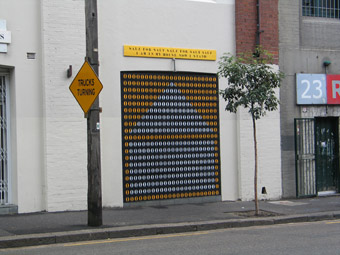
Ruark Lewis, An Index for the Homeless
RL Recently we placed a work called An Index for the Homeless on a building at 27 Abercrombie Street, between The Resistance Centre and MOP Gallery. MOP have been interested and very supportive of what I’m doing. Both at their artist-run-initiative and also at Hazelhurst Regional Gallery for the Cronulla Riot exhibition that Ron and George Adams curated. I made two installations down at Sutherland which where called Euphemisms for a Riotous Suburb. In June they agreed to housing my street installation in the wall cavity outside the gallery.
There are some arched alcoves in the facade, making them modules across the the entire surface of the building that is three metres square. I’ve designed into it a hut structure that fits within a form of a house made out of stencilled zeros. It’s a simple square structure that has a triangle and rectangle within it. The triangle is at the top, forming an apex as the roof and a rectangle underneath making the walls of the house. So it’s a square, a triangle and a rectangle. There’s the modernist activity in operation again. Form informing form. I thought of it as a concrete poem as well. We stencilled 10cm high characters so they can communicate from a long distance away. This was not an artwork that you go up in front of to experience the brushwork. You have to be at least 20 metres away to get the peripatetic effect. It’s part of a man-made environment, heavy with four lanes of traffic where the optical concerns are experienced spatially.
We installed a sign above the main door of the gallery. It looks like an institutional name for the entire building. It says, “An Index for the Homeless.” It’s as though we’d instantly created a research centre for homeless people. It’s become a bit of a joke actually. I didn’t expect it to work like that—a game of nomenclature, a poetic association generated by chance. Alongside that I painted a board with a quote from Ania Walwicz’s short story called House, which reads, “SALZ FOR SALT SALZ FOR SALT SALZ I AM IN MY HOUSE NOW I STAND.” It’s a fairly mysterious line on a curious site. You can hear people uttering Ania’s words. And they don’t just say it once. they seem to perform it several times. So they’re getting the shape of the poetic sentiment into their oral cavity. It’s been up for 16 weeks and hasn’t been graffitied or complained about. I’m hoping someone does graffiti this pristine artwork at some time. I don’t quite understand why not.
KG Too sacred?
RL When I say “we” I’m referring to the assistance I receive from Bartholomew Rose. He works for me in the studio three days a week. He’s enabled me to undertake a wide range of physically demanding installations over the last five years. He’s a Scrabble expert and a very valuable iterary companion to have.
KG Back at Millers Point…
texting
RL The Index of Kindness takes up from where the Index for the Homeless leaves off. Kindness is the thematic umbrella I am working under at present. The idea is to think about the Millers Point precinct and a number of the public buildings in the area as the next surfaces to publish onto in the name of “the public house”. We’ve been arranging for the Millers Point community to participate with their own “texting.”
KG You mean mobile phone texting?
RL Not really. The people there say, “We don’t have mobile phones and we don’t have computers.” The issues of information and activism are articulated differently in that community. They say, “you’ve gotta give us proper messages. You can’t just think digitally and expect us to read your emails.”
KG How do you work with these communities to get their “texts”? Do you interview people, make sound recordings?
RL At the moment we’ve been going through the process with the Darling Harbour branch of the ALP and the National Trust and Tenants’ Union. The branch meets monthly in the Garrison Church. For these interviews I’m working with Jo Holder, a well known curator, writer and activist. I guess a local ALP branch can be like a little church itself. It’s a conduit of informed opinions where like-minded people are motivated to come together politically. Most of them are or have been activists too. They’re a group of very articulate and socially motivated people. They’ve recorded a lot of the things that have gone down with state government’s dealing in that region. The Millers Point residents have often been described as a traditional inner-city community. The impact on Hickson Road with the new Barangaroo development at East Darling Harbour is monitored by this fragile community very closely. The history of activism in The Rocks goes back to the Green Ban days when the BLF led by Jack Mundy, Joe Owens and Bob Pringle were there on site saving The Rocks from demolition for more office towers. This community has seen it all and has learnt to deal with all the difficulty of state and council bureaucracy. Now the fight is to protect the community itself including much of the residential properties for low income housing.

An index of Kindness, Chalk Horse Gallery, Sydney, 2008
courtesy the artist
An index of Kindness, Chalk Horse Gallery, Sydney, 2008
municipal signs and other objects
In Lewis’ most recent show at Chalk Horse in Sydney’s Surry Hills, the gallery was hung with flags stencilled with words from Nathalie Sarraute’s play Silence. Below, on the floor and plinths, everyday found objects had been painted with red and white stripes and markings, making the gallery-goer doubly attentive—to where they trod and how they were regarding the art.
KG In your latest gallery show at Chalk Horse there’s your usual play on words, in the form of flags. There are objects as well. Where do these fit in the scheme of things?
RL I guess I’m using the gallery to test out some of my outdoor optical and spatial systems. I’ve been considering the sculptural objects in the show as decoys. Leading up to the Chalk Horse show I was studying maritime signage. The navigating tools that ships use on the harbour. I realised there’s a language for signs out there, a municipality of water and land signals. I’m very interested in the municipal sign and seeing where an artwork can transgress the polite internal boundaries of cities and streets and art galleries. One of the Chalk Horse panels is being prepared for reinstallation at Abraham Mott Hall in Argyle Street, Miller Point. This stencilled timber work called Conrete Poem II will be added to a sequence of other panels called Euphemisms for the Seafaring Nation. I’m making these things as modular constructions so they’re adaptable and relocatable. At Chalk Horse, all the objects on the ground operated as warnings so that visitors won’t trip over. They’re like the rocks of Mer in the Torres Strait. Eddie Mabo identified a bunch of rocks around his Island of Mer as being the markers for the language or community zones. I thought that’s a very useful message for all Australians to start to recognise. We need to identify our environments with objects set out as markers. These are the municipal markers that translate a whole bunch of security/insecurity issues that control the movement of society. I was in Singapore last year. To me Singapore is a remarkable, urbane area but it feels as though it is adapted from the City of London. It’s the municipal aspect of London that modern Singaporean politicians adopted to their equatorial zone in a number of ways.
KG What did you do in Singapore?
RL I was actually looking for garbage. I thought, here’s a place where you can’t have long hair, you can’t chew gum, what can you do? Obviously everything is very clean and modern there. So I started making work about the garbage—on the streets, in the countryside or washed up on the beach. I began to examine parts of the island that weren’t stereotypically clean and modern. Jonathan Jones and I picked up pieces of junk as we drove all around the perimeter of the island state. We went out to the rural areas and coastlines. We reached the industrial area Jurong where an army of cheap contracted labour from the Indian sub-continent are imported and housed. We did a week of urban fieldwork in a hire car last September. It was the sense of island containment that we decided to study.
KG So what did you do with the garbage?
RL I stencilled messages taken from An Index for Redundant Expressions which I’d assembled there. It’s a set of 45 aphoristic tautologies. Found phrases or ready-mades, for example: “9. earlier in time, 16. an honest truth, 32. a pair of twins, 1. an actual experience.” I inscribed these onto pieces of garbage. Then I placed these messages back into the piles the rubbish came from and made a photographic record. This formed an intimate poetic puzzle. I wanted to leave messages for people anonymously. I avoided the fear of arrest by photographing the evidence before and after I removed it. Sometimes I kept elements of the garbage to paint an abstract pattern on it—with red and white or black and white stripes painted in gouache. We arranged sets of these garbage ‘props’ for the large exhibition we assembled at Post-Museum. These displayed redundant expressions accompanied by three distinctive suites of work under the title of An Index of Kindness. There was An Index of Emotions which is an audio construction formed from vocal performances I made with Amanda Stewart. The spatial affects in audio were collaged by Rik Rue. Then the Index of Line was a wall drawing executed by Jonathan Jones.
Jon photographed the Singapore coast and shipping channels. He drew with meticulous precision the contours of most of the landscape of the island and parts of Malaysia in the distance. The drawing encircled the three rooms forming a semi-abstract design on the gallery walls. He just kept layering his drawings so a sense of landscape appeared cloud-like and hovering which was a really interesting anti-territorial take on a visited place.
The Index of Silence involved the stencilled flags you mentioned before, that’s a transcription of Nathalie Sarraute’s play Silence. The red and black flags, suspended low from the ceiling, distorted the volume of the space altogether. We significantly controlled the volume both spatially and directionally by designing the sound. The speakers for the vocal collage were hidden above the hanging textiles. All this was pretty emotionally charged, with the sound of tears and anger. The sound of Amanda and I appeared and disappeared as the sound collages Rik Rue devised panned around the rooms—the audio was kind of spooky there!
Singapore is a place of finite politics so I decided to make a banner. Apparently the making of political banners has to be authorised in Singapore, so I made a concrete poetry banner called QUOTE where I took a line from the Indian writer Ashis Nandy that said, “It was a strange mix of love and hate, affirmations of continuity and difference, nostalgia and a sense of betrayal on both sides.”
The redundant objects were diversions to slow down the audience. I don’t want people to consume exhibitions quickly. At times our signs seemed odd. My favourite object was the coconut. A truly beautiful painted object. A small leaf began to emerge during the exhibition and it just kept enlarging, breaking through the husk. The shell was painted with black and white stripes, then this little green sprig appeared. We found a broken shovel left by the builders of the gallery. We painted it along with a frame, a chair a rock and ball, a stick and a tree branch. A lot of these ‘municipal’ signals were stimulating to look at without being burdened with the values and meaning of a grand allegory. I liked the way the owners called their gallery Post-Museum. A sort of dissident location in itself.
the artist begins
KG When did you become an artist?
RL I went to Sydney Boys High School. One day I went up to the art room and a friend of mine was throwing on the pottery wheel. I became totally mesmerised how that form came up out of his hands and fingers. I loved the slithering plastic action of the clay that formed in his hands. I went straight out and bought a bag of clay that afternoon and made a sculpture, not a pot as such. That’s where it all began. My brother is a photographer and my cousins are musicians and painters. Nicola Lewis played the violin in An Index of Horses which we made as a performance-for-video at Chalk Horse. I sort of come from a Jewish artistic family, a tribe of mercantiles and artists. According to the painter Cedric Emmanuel our earliest Australian relative was Michael Michaels. He was a forger who was pardoned in 1809 and left Sydney returning to London where he started an orchestra. We’ve always had painters and musicians in the family so making things seems natural to us.
KG You have quite a collection of pottery here in your apartment.
RL I’ve procured these jugs to make an exhibition. I‘ll probably call this The Index of Forms. I’m focussed here on the anthropomorphic conditions that are related in the forms of the jug. These vessels are built with a foot upon which they stand, and a belly, where the bulk of the contents is stored. They have handles, necks and lips. That means they have at least five different physical attributes relating to the human form. I’m thinking of a book which indexes the shadows they cast set alongside the silhouettes and profiles from the bodies of dancers. I’m interested in the double nature of the cast of shadows. I would love to generate a text from a series of conversations with a man who has Alzheimer’s Disease. When we talk he often tells me things in a manner I think of as neo-Dada poetry. To everyone’s surprise we have a terrific time sitting there talking with gusto. If I could record his sayings, write them down in the form of our dialogue it could have an interesting and enabling affect. He’s been a journalist all his life; so the idea and its written form is like a game on his tongue. That’s a nice thing to try and share. Pottery has always been a really interesting through-line for me.
KG So you threw pots yourself?
RL I studied Ceramics at the Sydney College of the Arts with Bernard Sahm and Mitsuo Shoji, both very interesting artists. It was difficult for me physically but I needed the tangibility of clay.
At that school I came into contact with the composer David Ahern in the Sound department. David was a total radical. A really heavy drinker but strangely charismatic and he was wonderful to a small band of loyal students. He’d been working with Cornelius Cardew in London and for two years was a personal assistant to Karlheinz Stockhausen. He came back to Sydney in the early 70s and among other things he ran a Sunday new music workshop out of Inhibodress Gallery. That was the group called Teletopia and AZ Music. Tim Johnson and Mike Parr and Peter Kennedy ran the avant-garde concept gallery the rest of the week. But on Sunday the experimental artists ran an open studio where trained and untrained musicians joined together to perform music. Although I wasn’t involved in those early years I’ve been very interested and was highly motivated and inspired by Ahern’s practice. He was just at the end of his teaching life when I came in contact with him. But it was wild. It was recklessly terrific. I thought this is really what art’s about. Because it was a language made of sound and music, and I studied music throughout high school and my cousins were practicing musicians. Someone like Ahern became strongly influential. In a sense David was the first in a string of “tormentors” I got to know outside of the normal structure of the art school pedagogy. Ahern was very discouraging of my interest in ceramics and always urged me to paint and draw. Soon I began making sound drawings on sheets of cardboard using charcoal and white chalk.
KG So this opened up the idea of there being a number of means of functioning of an artist.
RL Yes. Ceramics gave me a sort of classical education, which I may not otherwise have received in such a serious avant-garde art school. I did a paper on drawing in ancient Greek ceramics. It was an interesting medium for discovering the function of mythology and literature of the Greeks. Then I studied Asian architecture and the correspondences with early classical sculpture. I got a better grounding in architecture that way, which has been infinitely useful. For some unknown reason I never did study painting at art school. I think it would have been physically easier for me. In 1984 I was expelled from Sydney College of the Arts. That was pretty demeaning—it really wasn’t my fault. I also had been expelled from Sydney Boys High School in 1978. Perhaps both these rejections shored me up as a kind of outsider in art—in that I seemed able to miss out on certain unnecessary things exactly at the right time.
KG It didn’t inhibit your progress as an artist.
RL No, it freed me up really.
the artist as curator
KG What did you do then?

Ruark Lewis, A Babel Reading-Machine (2005)
photo William Yang
Ruark Lewis, A Babel Reading-Machine (2005)
RL I left art school and was lucky that Ann Berriman asked me to perform poetry at the Biennale Readings she organised at the Art Gallery of New South Wales. During the 1982 Biennale a group of contemporary Australian poets were scheduled to make readings at the gallery. Anna Couani was invited to read. She realised that the Biennale paid the international artists fees to appear but the organiser for the poets had no arrangements in place to pay the poets fees. Organisers of Sydney poetry readings have been notorious for paying low fees for poetry readings, forcing the poets into what was basically an amateur arrangement. I don’t know why the Literature Board didn’t form a rates schedule. On the gala opening night of the Biennale Couani organised a protest on the steps of the state gallery. It caused such a fuss that a small fund was released immediately from the Literature Board to pay fees for the readings. I thought Anna’s fighting spirit had done a lot of good. She’s a terrific writer. In 1985 I managed to convince the Gallery to start another program of readings, for younger writers and new media artists. Some years later we were able to commission a setting of Couani’s The Harbour Breathes which was brilliantly performed with projections by Peter Lyssiotis and sound designed by Rainer Linz. I thought if you’re going to be a curator, you might as well be a producer and procure the best fees for artists commissioned or programmed to perform in a state gallery.
Initially I worked on the younger poets’ series. We had a six week season of readings. But perhaps even more interesting was when Emmanuel Gasparinatos agreed to join me and he programmed a new media event in the theatrette called Sound Alibis which included 14 artists. People like Rik Rue, Warren Burt Sarah Hopkins and Vineta Lagsdina participated. There were Super8 films and sound works and live performances. Burt assembled his massive tuning fork installation that reverberated through the gallery’s Victorian courts. That was truly spectacular. The program continued to be modelled along those lines of new media and spoken word and poetry for another five years. Those events gave a lot of production confidence to a younger generation of artists presenting to a general public in a state gallery.
I developed the program further the next year with the poet and scholar Martin Harrison. Martin was interested in the writer/performer as live presence, in creating a kind of listening room atmosphere. He was at the ABC at the time doing his Books and Writing program. We’d met at the first Premier’s Literary Awards. This began a really successful curatorial collaboration. Our more substantial programming strategy evolved quickly and it made the AGNSW the stage to a wide range of writers and musicians, composers, filmmakers, visual artists, performers dancers, radiophonic composers. I worked on promoting the programs and quickly built up a large audience. I kept working out ideas of how to get the most radical types of experimental art out to the widest audience possible. I thought if you’re going to compete for funding from the Australia Council the key would be large and consistent audiences. I remember heading off to lots of radio stations with cassette copies of Kurt Schwitters’ Ur-Sonata or Ania Walwicz reading in her remarkable voice—even radio stations like 2GB would give me five minute interview each season.
KG Virginia Baxter and I did a misguided tour for gallery goers, Small Talk in Big Rooms, in 1991 for a Jonathan Mills-Martin Harrison program.
RL These big museums needed us to animate the place. And we need them because audiences like that sort of place to hang out in. People in metropolitan centres want to go to unusual events all the time. They’re not scared of the weird but they don’t go to off-beat venues easily. I was keen to work at the grass roots level. I saw it as an act of anti-elitism to promote the radical art to a willing public.
We’d always program an establishment decoy in our series. The Big names, poets like Judith Wright, David Malouf or Les Murray. They helped to attract the very large crowds for us. We programmed the soprano Elizabeth McGregor singing the Margaret Sutherland settings of early Judith Wright poems alongside the relatively unknown work of Allan Vizents, William Yang, Ania Walwicz or Jonathan Mills. I remember the afternoon when poet Gwen Harwood and composer Larry Litsky presented their recital—a very memorable and stylish event. We maintained the idea of airs and aria as the program through-line. It was very demanding curatorial work. At the end I wanted get back to my own studio practice. I curated for four very intense years and helped produce well over 200 performances. I was pleased that we could raise professional fees and standards and develop funding arrangement that crossed over in a completely new way.
KG Writers-in-Recital happened once a year?
RL Yes. Each year as a one-month season during either the Biennale or the survey exhibition called Perspecta. In 1991 Jonathan and Martin took over and tried to make the program run as regular bi-monthly event.
KG Which year did you leave?
escape to melbourne
RL In August 1990 I escaped Sydney. I headed off to Melbourne, I travelled overland to Wollongong to watch Jaffa and Richard Moore perform Kurt Schwitter’s Ur Sonata alongside Andrew Ford’s music theatre piece Icarus, with a Barbara Blackman libretto. I travelled to Canberra and stayed for a week. You know, sometimes when you work too hard you become emotionally breathless and can’t get your heartbeat back in the right pattern.
In Canberra I found a copy of TGH Strehlow’s Journey to Horseshoe Bend. It’s biography/autobiography about the death of his father, the missioner Carl Strehlow in Central Australia in 1922. I started reading what turned out to be a transformative book for me. I felt this epic story could somehow be adapted either as a film or an artwork. I headed off with that text in hand to visit a Sufi retreat at Yackandandah. It was the off–season so I slept in and revived myself there for a couple of weeks. It was a good occasion to go walking in the backblocks. I followed the fence lines and picked up pieces of wire and made an installation under the verandah of their building. Those wires looked like Arabic calligraphy set out across the walls.
KG Was this the beginning of a particular kind of work that you’ve continued?
RL I was “texting”, so to speak, a bit earlier. Looking at the work of Juan Davila, Imants Tillers, Robert McPherson and Peter Tyndall who worked with inscription in their painting, I wasn’t totally convinced by what I saw. From a literary perspective it seemed to lack the poetic content I’d been seeking. That’s the sort of depth I was looking for in my own study of language. Their work was high art and powerful and of considerable museum scale. But I didn’t think there was the depth that a baroque field vision could offer. I wanted to lay in poetic lines from poets I was reading at the time, like Rilke’s Duino Elegies. I wanted to actually enact it as a trace. At the time I was working on musical and sound transcriptions in the form of drawings. That’s how I’d begun texting into works and making abstract cross-overs from one art form to another.
I made diagrammatic drawings of sound works too, starting with acoustic music and then I experienced the work of the Sydney composer Robert Douglas. He was making large-scale works on the Fairlight CMI. I wanted to make drawings tracing his computer music. I was realising that I could make art too, that I didn’t have to curate. It was a bit of a crisis. I could have made an entry into a professional career as a curator and been paid a salary at that time. But I realised that I could also do these other perhaps more creative experimental things, and that’s what I was interested in.
That year I went to Melbourne and stayed with Paul Carter. We met there to look at Joan Brassil’s retrospective at ACCA in September 1990. We’d formed a sort of group Martin Harrison, the director Peter King, Jonathan Mills and Paul. Mills called us the North Caufield Light Opera Company. I wanted to meet and talk to people like Warren Burt, Chris Mann, Vineta Lagzdina and Rainer Linz who was publisher of the magazine NMA. Melbourne had been a radical birth place for new media arts and experimental music at the Clifton Hills Community Music Centre. Rainer Linz and John Jenkins’ book 22 Australian Contemporary Composers anthology was the sort of curatorial guide I’d been looking for at AGNSW. There had been little like that sort of thing operating Sydney. The Melbourne discourse was quite advanced and very anarchic. By the time I arrived, I’d been “corrupted” by the newly acquired Strehlow material. Paul Carter was working with considerable consistency making his early radiophonic creations with people like Andrew McLennan at the ABC. That was the era of the ABC’s radio atelier program Surface Tension (1980s) and later The Listening Room. Carter had been editing the Age Monthly Review which we’d all contributed to over the years. This was an artistic atmosphere I called ‘my university’.
KG How long did you stay?
RL I kept going. Visiting friends, sleeping on floors and cooking for them, entertaining people, just being there like an artistic vagrant. I loved Melbourne. I’d go down every few months. Then Grazia Gunn was directing ACCA and she offered me a solo exhibition. I’d only done one or two solo shows (19 musical transcription drawings and a language transcription exhibition in Sydney). That ACCA gig was my big calling to come. I worked on it solely for two years.
KG What did you do?
RL I formed an exhibition in three parts. I finished the Robert Douglas transcriptions, which ended up being 48 metres of extended drawing. The 48 panels occupied the Lotte Smorgon Room at the old ACCA in Melbourne’s Domain. There were studies of Douglas’ Homage to Bessemer, and the 48 Alpha Solstice drawings. That was the ‘listening room.’ I made a room of literary transcriptions based on the French newspaper Le Monde. I’d been in Paris in 1991 and I found a way to look at the demarcations between the generating forces in commercial print media. It was a simple critique of how photography, journalism and advertising worked in concert on the pages and how that formed the capital which is the motivation for a daily publication.
KG So you reframed the material in a way?
RL It was a direct response on to actual newsprint. This work mirrored the time Rupert Murdoch of News Limited was closing down his newly acquired Fleet Street press and moving The Times to their robotic Wapping media factory. My drawings were a deconstruction of newspaper, a week of newspapers with drawings highlighting the spaces in between the contents. In this space I made a set of transcription drawings based on a group of bark paintings traced from the AGNSW and the Australian Museum. What interested me most were the painters from Yirrkala. These archival works had been collected by Charles Mountford in 1948. I was interested in those objects for all sorts of problematic ethical reasons. These paintings had been acquired as a form of scientific information during the American-Australian Scientific Expedition to Arnhem Land. I made a kind of funerary drawing from Mountford’s ‘data.’ I was making a ‘drawing’ that covered up the painted iconic blocks on the bark paintings. By drawing a kind of reversal all that remained was the grids between the pictograms. The ‘lines’ were just the raw paper left over in the reduction. The black rectangular areas were simple burnished graphite surfaces. I transcribed a set of 12 bark paintings and called the results The Silhouettes.
KG What is involved in this transcribing process?
RL I took sheets of mylar plastic and placed them over the top of the objects. With a texta I traced the regions. I drew around where the picture block sat in the case of the bark paintings. I’ve also made similar transcriptions from the collages of Kurt Schwitters at the Sprengel Museum in Hannover. The skeletal forms of the original works are recorded from the bark or collages. These lines represent the directional modality defined in the original by the artist before the readable pictogram is put into place to tell their story. I am attracted by the structure of those schematic intentions.
So that’s what the first exhibition was—fairly esoteric too. It was part of Melbourne Festival in 1992. Melbourne was into high postmodern and neo-expressionist painting then, and along comes an incredibly cool minimalist show with regional underscores. It was shown there for a lengthy 14 weeks.
KG It would have excited the high theory crowd.
RL They mostly ignored it! It was an incredible experience to be given such silent treatment. Maybe that’s what happens coming from Sydney and being 32 at the time and having the top spot at ACCA during a festival season. But I made a lot of terrific friends through that project. I asked the composer Keith Humble to open the show.
KG So you were on a path; were you immediately picked up elsewhere?
RL No. It was ‘difficult’ work and it was commercially ignored. The next two years was fairly quiet and contemplative. A few dealers made comments. I remember George Mora liking the newspapers drawings very much but he said they were unsaleable. Charles Nodrum has always been very keen. I like the fact that you can work “fairly privately” in Australia. I always understood that experimental art would be ignored by the local art cognoscenti and that the avant-garde was taken up by the academies that could easily canonise it in what I regard as a pseudo international context.
the experimental realm
KG So you’ve seen yourself very much in the experimental realm rather than from an established avant-garde position?
RL Yes. I just thought there was more interesting dialogue between artists and forms in what is experimental.
KG There’s a public conflation between experimental and avant-garde usually. People don’t make the distinction
RL Ahern made the distinction from the outset: Schoenberg and Stravinsky, then Cage and Boulez. I’d been wanting to make the distinction. I tried to make the distinction at the AGNSW and we could model it on the stage with the Margaret Sutherland and Judith Wright work for instance. The music and writing was avant-garde in 1943. On the other hand, placed right beside that were the extreme writings/performances of Ania Walwicz. We could form those kinds of critical juxtapositions in the museum. Walwicz has always been remarkable to watch, or read on the page and then she’d do these haunting performances. Those writings correspond to the paintings she makes also—like dream sketches in oil paint. It’s a modest and manageable practice but a fantastic way of working with things. The Sutherland setting of Wright is probably known by only a small group of musicians and historians today. Programming a local rarity like that, with a big shiny Steinway on the stage was a different way of analysing the structural differences of both these tendencies.
KG So the experimental for you represented various means of working whether through text or image or performance or film or whatever. What is the essence of the experimental as opposed to the avant-garde?
RL Well to me it’s a living force with the musicians or performers. Not exactly being a musician myself but having studied music at school and in association with Ahern and people like that I focussed more and more on structures rather than expression or evocations. I wasn’t really attracted to the technological in new media as a means for hand-crafted works. I’m happy using low tech tape recorders, using video to form a document of a process. I didn’t know how to use a computer for a long time. I was lecturing in the new media lab at SCA but didn’t even know how to turn a computer on. The students were eagerly making CD-ROMs at the time. I was teaching what I thought of as a production management course—almost like a project manager on an architectural site. It was the expansiveness, I suppose, of the experimental realm, the idea that art and production could take on other forms in constant flux and I could rewrite them that I found stimulated my thinking about experimental art.
And there was a correspondence to this work outside of Australia for my artistic friends. John Cage had picked up on Chris Mann’s work and set it for an opera. What I find most interesting in writers like Mann and Walwicz, and others Javant Biarujia, is the certainty of their regional voice. I guess you could say that about Gerald Murnane too. To me this is both political and psychological. In certain ways I understand their writings operate as a kind of artistic resistance. It’s about being in this place in the work but in very interesting and surprising ways. Carter’s writings too had taken the regional condition and re-examined it in books like The Road to Botany Bay or his Italian book called Baroque Memories. I think there’s too often an identity crisis in the Australian avant-garde. The constant need it faces to be academically relevant. To me that leads to conformity. Isn’t that what the underlying anxiety of cultural cringe is about? But with the experimental, there’s a sort of fraternity that I like, keen about reading through each other’s work, reading the sound waves that each artist arrives with. I found it highly attractive that when you went to Paris someone was there that you could plug into right away and you felt very much part of what is going on. I went to Paris and began to work with Kaye Mortley on the Nathalie Sarraute book. That was remarkable shift. To be part of a cohesive living culture that remained in nature to that place as well.
KG When did this happen?
RL 1991. I made the Le Monde drawings for my ACCA show while I was in Paris. I’d met Kaye Mortley and Rene Farabet here in Sydney. Martin Harrison was a friend of Kaye’s. All sorts of interesting people came together at the Harrisons’ house. The dinners often went until dawn. When Rene and Kaye came to Australia a sort of sound circle developed around them and the Listening Room at the ABC and at UTS. It was formed by Virginia Madsen and Tony MacGregor and Martin. Rene Farabet was director of the radiophonic atelier program called France Culture, so there were significant cross-overs with people working here. Kaye had been a pioneer in the new radio at the ABC—the days of Radio Helicon I remember so well.
transcription & translation
I went off to Paris and had the best time of my life. I felt like I could walk all over that city. I wanted to make an artist’s book with Kaye, to try to form a radio score into a book form. I was really interested in how her radio scores appeared to be arranged to form a depth of field in audio terms. That’s a form of literature that doesn’t come outside of the production room very often at all. She’d published a work in a Sound issue (number 31), of the Australian journal Art & Text which looked fascinating on the page and I thought, there could be a whole book possible relating her many and various creations for radio. But Kaye said we should ideally work on the play Pour en Oui Pour en Non (Just for Nothing) by Nathalie Sarraute. She’d translated that work for radio—the ABC did it with Arthur Dignam and Barry Otto. Perhaps I was a little disappointed not to work on her scripts, but when she described the play I immediately had a vision for setting the players’ script marked out on the page in different colours. The colour would navigate the reader through the text like a graphic score. I wanted to run the lists across the page so it was justified left and right and formed as modern prose would work. That’s a better way to read it and easier for the actors because they’ll know how much material is coming up from the blocking of the colours.
KG I remember seeing it at Sarah Cottier Gallery in Redfern.
RL It was ignored again.
KG It was beautiful.
RL Thank you. Andrew McLennan launched it (I think he produced it at the ABC for Radio Helicon) and he did a wonderful rendering of the idea of the play that afternoon. We got a small but knowing audience for that exhibition. And we had Nathalie’s voice present in the installation! We went beyond the play. Nathalie lived to 99. When she died I wanted to bring her voice into the installation. Kaye had made a supplementary audio work where Nathalie was speaking about herself being photographed, and as a child, and there was a statement about self perception—the paradox of growing old and not growing young.
When we were making the book, I asked Kaye Mortley if she would construct a sound piece as an idea for an installation of the book pages bringing the presence of the author into place. One of the tricky parts about working in Australia with Kaye was that people didn’t seem to understand the significance that the translator represents alongside that of the author. Her relationship with Sarraute was so intimate. And Nathalie loved the English language, so it was in every way an ‘authentic’ translation, a collaboration between the two of them. That art work started in 1991 and it turned into a 10-year project. A lot of my projects have been constructed over a long period of time. Perhaps it will return.

RAFT (2005), with Paul Carter, collection Art Gallery NSW
photo Ian Hobbs
RAFT (2005), with Paul Carter, collection Art Gallery NSW
the raft journey
KG Was RAFT a long process?
RL No not that long—from that moment I owned a copy of TGH Strehlow’s Songs of Central Australia. I had a form for that installation but it took some considerable modelling. I often have visions of things—I see them in visual daydreams and then follow the image directly along into the work. I saw a large gridded structure that seemed to extend out along the surface, so I set off in that direction. The timber of RAFT weighs 1.5 tons. I started testing possible materials when I was staying in Melbourne in 1993. I later made three large Water Drawings which joined RAFT at the Art Gallery SA showing in 1997. Then our book Dept of Translation appeared in 2000 to coincide with the exhibit at the Sprengel Museum, Germany which occurred in 2001. So, only about seven years gestation! The Art Gallery of NSW where it was first exhibited acquired the work earlier this year.
I’d been wanting to make a work with Paul Carter since about 1989—I was connecting the bark painting grids called The Silhouettes to his radio play Mirror States in an attempt to design a setting for that audio construction but it was never realised.
I was keenly aware of the Jindyworobaks [a literary movement promoting Aboriginal culture and aware of Strehlow’s rendering of Arrernte songs] who had made early performance poetry in the 1930s with people like the poet Roland Robinson. I’d watched a late performance by Robinson at The Edge Theatre in Newtown in the late 80s. He was able to move and recite the texts in the space with the dancers surrounding him. I began thinking that RAFT would maintain a post-Jindyworobak voice in some way.
There’s an audio work that accompanies RAFT called “Peripetia at Horseshoe Bend.” A haunting sound sequence running for 43 minutes, with Paul walking through the Fink river bed reciting from his poem collage “Every Possible Place.” We were looking at the Arrernte water myth of Kaporilja as the main poetic cross-reference for RAFT. RAFT symbolises the carriage that Carl Strehlow was transported down from Hermannsburg to Oodnadatta to get a train to Adelaide because of his fatal illness. But he died on the way, just north of Fink at Horseshoe Bend. RAFT has to do with issues of translation in the desert. It allegorically acts as a portrait of the classical intercultural brokering of the language scholar and evangelist missioner Carl Strehlow with his links to the first phase of modern anthropology.
KG Another kind of transcriber.
RL Absolutely, and most remarkable. I learned later on that Carl Strehlow’s material found its way to Zurich Dada. What’s so amazing is Hugo Ball and Tristan Tzara performed various Arrernte and Lorritja songs at the Café Voltaire in May 1917. It’s set out in their program notes. They spell the words Aranda and Lorritja as in Carl Strehlow’s Die Aranda und Lorritja Stamme in Zentral Australia as published in five volumes in Frankfurt from 1907. Originally published as a parallel text, Tzara later translated three songs from the German into French which appeared in the first Paris Dada journal. Three songs were performed, maybe with movement, and probably in the presence of James Joyce and maybe Lenin both of whom were resident in the neighbourhood. So, there the modernist trace again.
I don’t know how to talk about RAFT any more. It was a massive project. Our book was a sort of manifesto to regional modernism.
KG And RAFT travelled widely?
RL In Australia it was shown in Brisbane, Sydney, Melbourne and Adelaide. In Alice Springs it appeared at Arraluen Art Centre at the same time as the Albert Namatjira retrospective. That was lucky because people from Aboriginal communities of Central Australia experienced the Water Drawings and heard the audio work. Then RAFT toured to three museums in England. It was included in the language-art exhibition BABEL at the IKON Gallery in Birmingham. Perhaps the most important ‘transgression’ was at the Sprengel Museum in Hannover just 40kms south of Hermannsburg which the mission station in Central Australia is named after.
The 1870s missioners who began the Lutheran pastoral care program at Hermannsburg in Central Australia were consecrated at the St Peter and Paul Kirche. There is still the tiny missioner school operating in the town there. I visited that place twice to explain what we were trying to achieve in our work. Our installation in Hannover repatriated some of that German-Australian history too without undue exoticisation. We brought their narrative back to them full circle via those curious religious links. I think the Germans appreciated the retelling of that particular story.
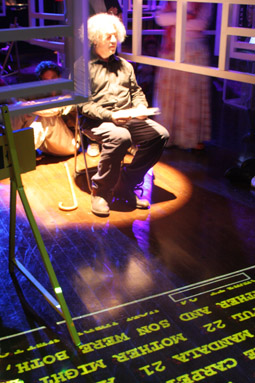
Ruark Lewis, Banalaties of the Perfect House
photo R Leech
Ruark Lewis, Banalaties of the Perfect House
the artist performs
KG Can we talk finally about the performative aspect of your work. You’ve performed in constructed performances—Alan Schacher’s work-in-progress, The Babel Project, and especially in Banalities for the Perfect House—but you also improvise. In the exhibition that’s recently concluded at Chalk Horse there’s a beautiful recording of you and Amanda Stewart doing something quite dramatic and very funny and largely unintelligible (but oddly recognisable as social exchange) with occasional literal utterances. You mentioned that at the opening you performed solo, apparently out of the blue. And that was related to the exhibition, a Nathalie Sarraute piece.
RL Around 2000 I broke with conventional narrative writing and autobiographical poetry. The typographical book False Narratives was my second attempt to generate a text solely for vocal performance. Amanda Stewart has always been out there moving away from narrative poetic forms into a more musical form which she excells at. We both appeared in the Berlin Poetry Festival in 2003 and I realised how far she pushed her work off the printed page. Watching her move through an extraordinary extended vocal range and seeing her technically adept performance has always been inspirational for me.
I have become increasingly interested in the process of concretising language and to make a score I could follow and make performances from. That’s the sort of thing I admired in Marinetti’s typographical novel Zang Tumb Tumb or Schwitter’s UR Sonata. Last year I asked Amanda to work on an improvisation that would in a non-representational way convey three emotions: anger, joy and sadness. As we huddled around a microphone in the studio we both began giggling, wondering how ridiculous we were. A really intimate moment between artists emerged as we worked out a range of responses that we might record. Rik Rue collaged our efforts adding layers and depth and spatial elements which formed a kind of audio space poem at Post-Museum in Singapore in 2007 then at Chalk Horse this year. I called it An Index of Emotions. I think visitors were surprised and confronted by those spatial effects and some of the sobbing sounds and angry tones were quite distressing.
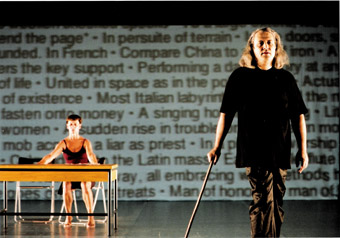
Ruark Lewis, Banalaties of the Perfect House, Berlin
photo Gerhard Ludwig
Ruark Lewis, Banalaties of the Perfect House, Berlin
I performed in Banalities for the Perfect House in 2005, a work made of numerous facets. Installation, poetry, computer music and recital. Performance Space commissioned the work as part of a gallery series called Who’s Afraid of the Avant-Garde. Banalities has been the name I’ve applied to numerous post-poetry writing projects. The structure of the writing comes from stacking and sequencing a kind of chance generated writing. The lines are generated by a structured procedure. I want the sentiments uttered to be formed by generalisations: “7. Angular sightings deliver films. 11. A pedant nut is formed by fourths. 17. A phenomena is massaged by oil.”
Rainer Linz worked from the outset of this project as collaborator. He’s a very intuitive person to work with. The musical and performative intelligence he brings into the working process of the theatre lifted the activity to a kind of alpha level. In creating it we met in Sydney and went out to visit Castlecrag one afternoon. I was keen to show Rainer Bill Lucas’s experimental houses at the Bulwark and in particularly his seminal work called the Glass House built in 1957.
We discussed the ideals of that satellite Sydney suburb. Castlecrag started as the utopian urban development that Walter Burly Griffin and Marion Mahony created for the Greater Sydney Development Association in 1921. Rainer viewed the Haven amphitheatre with its steep bank of sandstone seats and the stage area (with its excellent acoustic) all of which is surrounded by the thick green silence of the bushland. Later in the afternoon we called in to see two radical modernist houses designed by émigré German architect Hugh Buhrich down on Sugerloaf Point.
From our conversations that day we focussed on the social politics of the then state government planning minister Frank Sartor’s ill-fated Redfern-Waterloo Project, close to where we would perform and install our allegorical Banalities. Rainer enabled us to undertake the process of transcription from the writings and recordings of the spoken word and abstract vocals. He made a computer sound construction in 12 parts based on recordings of my voice. This 60 minute installation-for-performance changed the dimension of everything I’d experienced before. We expanded the texts using data projectors and painted the language components onto the various timber components assembled architecturally throughout the performance space. We penetrated every crevice of that building. The writing and soundings tracked around 12 stations to construct a work of theatrical proportions. Rainer’s directorial control of events was very cool. I was pretty tired having made the many complex timber components we used in the ‘installation.’ At the same time as fabricating I was writing the words to be recited as lists of aphorisms, Banalities for the Perfect House, the Newspapers, the Times, the Kitchen, the Solid Mandala, for Napoleon and the Perfect Place. It was an amazing and exhausting way of working toward a final piece. Rainer was in Melbourne processing and sampling and constructing the program that would generate the sound.
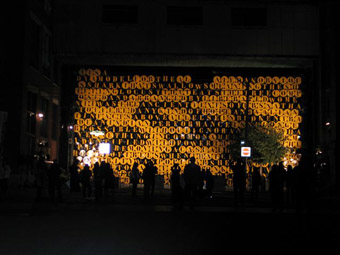
Euphemisms for The Intimate Enemy
courtesy the artist
Euphemisms for The Intimate Enemy
The work we are currently aiming at for the Toronto gig on October 4 is similar but different. That sound installation is called Euphemisms for The Intimate Enemy. The duration of 12 hours is much longer. The sound is computer generated once again but will be a live collage when the computer is started around 7pm on the night of the event. This work was commissioned by the City of Toronto. For it I’ve devised an installation of 550 oil drums to be stacked as a curtain wall between two 19th century industrial buildings. Each word of the Euphemisms is stencilled onto coloured (black and yellow) painted drums and will form an illuminated text in the void. Since last year I’ve become increasingly interested in the writing of the Indian Post-Colonial theorist Ashis Nandy. Some of my interest is microscopic by examination of Nandy’s phraseology. The transcription I undertake searches for the global facets in his sentiment, collated alongside recent world events which I hope forms a type of public poem: “4. The shifting locust that eats the tree. 5. Composed and arranged of liberated women. 6. It was the ancient texts of Krsna that offered any kind of hope.”
smashing poetry
RL I’m also trying to work out how to break narratives into the concrete sound forms. One day I decided to write more simply and in a sort of rude and abject manner. To do this I went into a series of internet cafes and wrote emails to friends that responded to a previous correspondence. That’s how I wrote 13 texts they were a sort of bad writing directed as a false poetic narrative. It was a kind of bent approach to the niceties that form in poetry and personal poetic sentiments. I made these writings tonal in that the phrasing was shaped for an easy speech flow. I used a numerical index and stacked the lines up one against the other. That way they become concretised. That was a breakthrough moment in the way I was thinking and making writing. That’s the way I really started examining the structure of computers and the internet. If I got a reasonable reply from my correspondent or we subsequently had a conversation I could integrate those parts tangibly into each story. I also had decided what the page length of the entire text measured before I started writing. I even had the thickness and shape of this book in mind and how the pages could be moved. I set the pages so they contained an unusually large font size and sans-serif characters. There are only six letters per line and nine lines per page. With such a structure the false narratives deteriorated physically and formed into pseudo phonetic clusters.
KG False in what sense?
RL They were to be abject stories, little short stories that were bad, set out to either say bad things or to be badly grammatically structured. And I just wanted to break off from poetry completely. I wanted to smash it and get rid of it. I had to do it within myself. That way I thought writing would be more useful to me again. So there I was at the keyboard chattering away, writing these often absurd narratives to friends. They often went out as an email but in a strange form of language. This typo-physical intervention would radicalise and disorientate the words, breaking their sense and interrupting their continuity. It was a literary architecture of the page that was generating and shaping textuality. In this process the page was automatically formed as a kind of score for abstract vocal performance. I first performed this sort of pure glossolalia at an exhibition in the basement of the Scots Church Studios. I just started to perform making sounds. I thought I’ll make noise and bounce around some of phoneme stuff of the broken letters. The performance went on for about 10 minutes. To my amazement the others in the room seemed engaged. They had big smiles and were not distracted. It was a fun way to animate the moment.
KG So you did it at Chalk Horse recently.
RL We reinstalled the transcription of Sarraute’s text SILENCE. It was suspended from the ceiling. Through the extraction of 144 key words and topic phrases we were able to stencil the results onto thin textile flags. In this way the texting bleeds through and distorts the readability of each side slightly. In this impromptu performance I caught sight of words and phrases as I walked through the installation. My voice changed in pitch and volume dramatically. At times I increased speed and then I slowed down or repeated a word more and more aggressively each time. The art crowd appeared suspended in shock by my uncalled for dramatic articulations. It was a sort of cathartic theatre for 10 minutes. And the theatre had come to them. Surprisingly the sense of Sarraute’s original drama seemed to stay intact even though my transcription and reformations of the page and the stage made it physically unrecognisable. In the mad way I did it, and that sense of character of the outsider looking in, moved those present that night and that surprised me. It just simply began.
www.ruarklewis.com
RealTime issue #87 Oct-Nov 2008 pg. web
© Keith Gallasch; for permission to reproduce apply to realtime@realtimearts.net
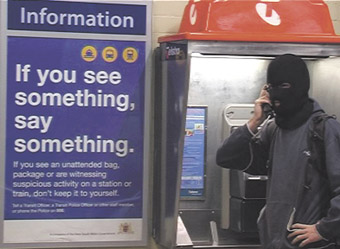
Jon Wah, Balaclava: “if you see something say something”; 2005
THE NAKED GUY IN VERMILLION BODY PAINT GESTICULATING AMONGST THE CLOWNS, THE GOLD GIMP AND THE SERIOUS LAPTOP MUSICIANS IN WADE MARYNOWSKY’S ARTSPACE INSTALLATION AUTONOMOUS IMPROV IS JON WAH. THAT FLEETING GLIMPSE OF BRILLIANCE WAS, FOR AUDIENCES NOT FAMILIAR WITH THE LOCAL SYDNEY SOUND AND PERFORMANCE FRINGE, SYNECDOCHE FOR AN EMERGENT PERFORMANCE AND VIDEO PRACTICE FIRMLY PLANTED IN THE TRADITION THAT EXTENDS FROM CHRIS BURDEN AND PAUL MCCARTHY TO GINA PANE, VALIE EXPORT AND MARINA ABRAMOVIC.
I’m not sure where that footage was sourced, but it revisits Wah’s early student collaboration in which he (again naked) had painted himself red, donned a leash and gone on all fours for the first year student he had dressed as a leather-clad dominatrix. Near naked Redman has since resurfaced in a nappy and Roccoco wig in Tillianakis’ Back in Black, but for me the original naked Redman will be Jon Wah, a rude baboon-bottom red, wearing his sexuality as playful insolence, not in his genitalia, but on his skin.
Then there was yellow man, Jon Wah lead singer, body painted puce for the band The Bloodied Cunts, spewing on stage in puke rock homage to the punk days of affectionate gobbing (Electrofringe, 2005, with Abe Powell and Flynn Donovon). He could go to the dark places, the extreme places (videoing friends in the intimacy of excretion for his study of the formal aesthetics of poop) but among the most memorable were the delicate Zen-yogic balancing works: Wah in a yoga position, feet extended along his side of a half-empty seesaw, the other side stretching to the disproportionate length of a massive symbolic blank. This was Wah in philosophical mode, balancing life against Lacanian psychoanalyis’ structuring void, the lack at the heart of the subject (Position of Balance 1).
In Position of Balance 2, Wah filled out the void of desire by matching his weight with a crate of beer—on the one hand a blokey joke towards his own fondness for drink (and a dig at the modesty of TS Eliot’s Prufrock, measuring life out in teaspoons of coffee). But that crate of beer also represented a critique of capitalism and consumerism (how we fill that metaphysical void by stuffing ourselves).
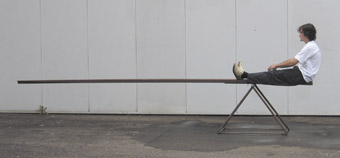
Jon Wah, Position of Balance I,
‘ …to balance my body against the weight of the board…’ 2006
Position of Balance 6 (First Draft, 2007) had Wah with arms and feet stretched out towards a precariously balanced video camera projecting his image on the wall. In this subtle endurance work he swayed up and down in micro-movements on the tipping and rebalancing beam. Metaphysically speaking, Wah’s decentred subject was now alienated, ex-sistent, in the image’s mediating representations. Of course, Wah’s performances played out without any psychoanalytical framing: they were immediately, intuitively grasped. The strength of his work was that his insights were instantly recognisable, even if hard to put into words (try explaining a complex joke).
Dressed (Serial Space, 2008) was his last performance work. Naked, he summoned the crowd to follow him down a flight of stairs where he ritually wrapped himself in barbed wire, pulled on clothes and then re-ascended (in wincing pain) to retreat behind closed doors. In the following symposium Wah’s analysis amounted to frank confession: the performance was an allegory for a life lived increasingly out of control. When his wire cutters didn’t work he had to call friends into the back room. Finally the audience saw the ambulance men arrive to disentangle him.
Repenting his extreme behaviours, Wah apologised for demands beyond those with which friends could cope. The clown-prankster doing the thing that he does best, going in too deep and needing help to get out, acknowledges the debt and what he has put the other through.
When viewed through the history of performance, and more recently, relational aesthetics, it’s a complex work. The ‘for whom’ of Wah’s barbed wire piece goes beyond the ruse of “I f’d up on the wire cutters.” Wah was revisiting those 1960s works of risking the body in the contemporary context of the politics of friendship: art as an examination of the demands on the other.
Wah leaves behind an original and important body of work yet to receive the critical commentary it deserves. This includes Balaclava, on the politics of terrorism, and the movie-length sitcom King of the Loungeroom, with its anti-corporate ads. In video and performance Jon Wah opened a territory that was his own. Jon Wah died on June 29.
“Art is easy, it’s life that’s hard.” Jon Wah interviewed by author, March, 2008.
Ann Finegan
On Friday December 4 a retrospective of Jon Wah’s work opens at Serial Space 33 Wellington Street Chippendale, serial@live.com.au
RealTime issue #87 Oct-Nov 2008 pg. 52
© Ann Finnegan; for permission to reproduce apply to realtime@realtimearts.net
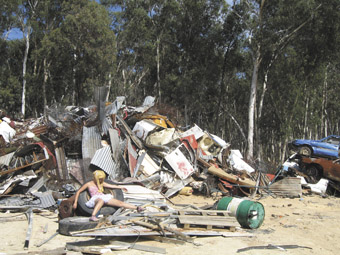
Katthy Cavaliere, Loved, 2008, installation/performance
TO CELEBRATE ITS 25 YEARS, ARTSPACE IS TURNING ON QUITE A PARTY FEATURING ONE HOUR TURNS OVER TWO DAYS BY 24 ARTISTS WHO HAVE ALL AT SOME TIME EXHIBITED WITH THE GALLERY IN WHAT PROMISES TO BE A SIGNIFICANT HOMECOMING.
These mini-exhibitions will include installation, performance, moving image, sculpture, photography, new media and painting, all in the spirit of the gallery’s long tradition “as an active working space, a place in which to think, intuit, experiment and make.”
Artspace 24/25 also implicity celebrates the work of generations of artists from the 80s (the gallery opened in Surry Hills in 1983 and moved to Wolloomooloo in 1992) to the present whom the gallery has supported in exhibitions and through the sustained provision of an invaluable critical context through publications and vigorous debate.
The artists showing are Jim Allen, Brook Andrew, Denis Beaubois, Mark Brown, Katthy Cavaliere, Julian Dashper, Elizabeth Day, Richard Dunn, Mikala Dwyer, Domenico de Clario, Deej Fabyc, Matthys Gerber, Joan Grounds, The Kingpins, Derek Kreckler, Wade Marynowsky, Mike Parr, Eugenia Raskopoulos, r e a, Nuha Saad, Jill Scott, George Tillianakis, Mark Titmarsh and Julie Rrap.
Curator Kylie Johnson tells me that the approach has been open-ended, artists providing existing or new works, but each working strictly with the 60 minute limit, which includes setting-up time.
In the first space, on entering the gallery, you’ll find ephemeral materials hung on the walls and in bound scrap books, one for each of the 25 years. The display includes invitations, catalogues and press clippings. You can have a coffee while you browse and your memory of Artspace history, “will be jogged by the amazing number of significant names who have been involved with the gallery”, says Johnson.
The large gallery space will feature performances and object-based works while the smaller will house projected works. Set to run to a tight timetable, says Johnson, Artspace 24/25 should yield many pleasures and, not least, a serious celebration for a uniquely creative Sydney insitution’s 25 years and the many to come.
Artspace 24/25, Woollomooloo, Sydney, Nov 1-2, 11am-5pm
RealTime issue #87 Oct-Nov 2008 pg. 53
© RealTime ; for permission to reproduce apply to realtime@realtimearts.net
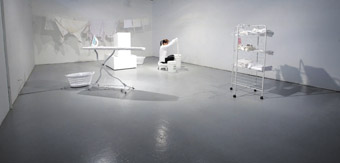
Philippa Steele, White Wash
photo Sean Fennessy
Philippa Steele, White Wash
INITIALLY UNAWARE OF THE IRONY, I QUICKLY SORT THROUGH MY CLOTHES BEFORE I LEAVE HOME, PLACING DELICATE ITEMS IN PROTECTIVE NET BAGS. CAP FULL OF LIQUID. CLIP THE CIRCULAR DOOR SHUT. A MULTITUDE OF BEEPS TO FIND THE RIGHT CYCLE. PRESS “GO”. LEAVE. MY DESTINATION IS WHITE WASH, WHERE ALL OF THE STEPS IN MY TWO MINUTE PROCESS AND THE ENSUING WASH, ARE RECLAIMED BY ARTIST PHILIPPA STEELE IN AN ACT OF SLOW DEDICATION.
A soft sloshing greets me as I enter. The diminutive artist is perched on a small white stool, her white gloved hands working away steadily at a white towel immersed in one of a number of similarly monochrome buckets. Surrounding the artist are a series of ‘stations’ that offer the tools required to sort, tag, rinse, wash, wring, dry, iron and set aside for collection. Each station is stripped to the bare minimum. Apart from the electric iron and the small white laptop for entering data, there are no smooth whitegoods or unwarranted beeps. The smell of clean clothes surrounds us. Everything is white.
Every week we wash. This has gone on ever since we began our long obsession with cleanliness and desired for more than the clothes on our backs. For most, the experience matches my opening sentences—a quickly executed series of steps with coffee, toast or child in the other hand, followed by a reluctant hanging out, sometime later.
This year Steele completed a six month stint living and working in India. As with many before her, the experience has had a profound effect on the way that she views her daily existence and consequently her art practice. Prior to this journey, her work focused on the object or what she likes to call ‘thingness’ and a process of identifying and removing associations that defines any one thing, with the difficult ambition of achieving ‘nothingness.’ Through observation of the devotional attention to everyday processes in India, Steele has made a lateral shift, focusing her intimate, intense attention on the action.
The set up is sublimely simple. The artist is offering to handwash people’s clothes. Steele’s advertisements in the local paper and flyers placed with nearby businesses invite members of the public to bring in white items for washing, with the provocative tag line “I WANT YOUR DIRTY WHITE LOAD.” All items are entered into a database, sorted according to necessary treatment (soak, starch, iron etc), tagged and then laundered by the artist within the gallery space throughout the three week exhibition. Just as in any other service industry, Steele states that she aims to be “friendly, approachable and professional.” There is no charge.
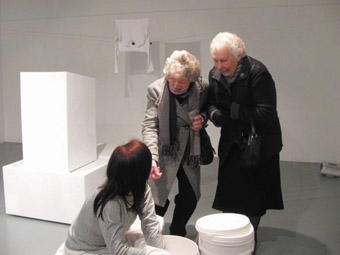
Philippa Steele, White Wash
photo Sean Fennessy
Philippa Steele, White Wash
While simple in set up and aesthetically austere, the translation of this daily process into a gallery show creates a layered, powerful work, which unfolds as you spend time in the space. There are obvious links to the lowly paid labour of those within the service industry, particularly in the developing world. Steele’s refusal of payment amplifies this transaction and she notes that some ‘customers’ express discomfort with the arrangement. The work clearly highlights the disconnection that Westerners now have from the details of daily life, but for Steele I think the most resonant aspect of the work is the potential for meditation through the action. She has found herself perfectly absorbed in the simple steps of washing and feels that she has achieved active meditative states. The tiny, tiny details like the fine fibres impossible to remove entirely and the vast variation in ‘whites’ have found their way to her attention. Her intent, I believe, is for everyday moments of spirituality reached through quiet observation.
The artist acknowledges and embraces the inherent contradictions in the work. In attempting to remove associations through stripping away and ‘whitening’, Steele succeeds in bringing every single object into focus, with items like the electric iron and plastic coated hangers reading like iconic artefacts. Placing the work within a sterile gallery context brings with it an ironic sense of disconnection with her Indian experience as this cool white room is surely no match for the humming, sensory environment in which she first recognised the potential in these acts. And I wonder about the actuality of meditative states for those whose life offers no choice but to wash in this manner.
I leave the gallery to the soft slap of towels against the washing plinth and look back to the shadow of the action against the white walls. Some minutes after I arrive home, sing song beeps signal that my wash is complete. As I shake out each item and hang it on the drying rack, I take stock. I notice the soft snap as I shake the clothes, I watch my hands as I place each item to maximise drying and I reflect that a little of Steele’s attention has quietly travelled out of the gallery along the road and into my home, my hands, my work.
Philippa Steele, White Wash; Inflight Gallery, Hobart, July 4–26
RealTime issue #87 Oct-Nov 2008 pg. 54
© Judith Abell; for permission to reproduce apply to realtime@realtimearts.net

Joshua Mu, Aisling Donovan, Preparing to be Beautiful
photo Ashley de Prazer
Joshua Mu, Aisling Donovan, Preparing to be Beautiful
THESE DAYS THE POSSIBILITIES FOR OUTRAGE SEEM SO MUCH MORE PREVALENT WHILE ITS MANIFESTATIONS VERGE ON THE PRIVATE, EVERYDAY ERADICATION OF RIGHTS SLIPPING BY UNACKNOWLEDGED. ARE WE SLOWLY COMING TO OUR SENSES, I WONDER, WAKING TO WHAT’S HAPPENED WHILE WE’VE BEEN WATCHING OUR BACKS? ARE WE READY NOW FOR ART THAT MAKES US RAGE?
Enter Artrage, now in its 25th year and talking up its silver anniversary, which has a quaint ring for what has been by all accounts a gathering of creative tearaways, a festival of the emergent appearing unannounced in all manner of unlikely spaces. This year’s brochure looks disturbingly sweet until you read between its pages the old signs of subversion.
The necessary Climate Change action appears impressively hands-on as we should expect from the avant-garde. Following the supportive paras from sponsor Western Power who’ve planted enough trees to compensate for production of the festival, is the invitation to Artrage audiences to participate in “WA’s first mobile, networked, pedal-powered generator system.” You’re asked to “bring in your bike or use one of ours and contribute your pedal power to producing electricity to run parts of the People Power program.” This includes 1,000 LED lights attached to kites flying above the cultural centre on the Saturday night of the Northbridge Festival. Let’s hope Prof Garnault is taking notes.
Performances/events will be staged at The Bakery Complex as well as a range of other venues and galleries in Perth and Fremantle. A show that caught my eye, as one who likes to dance to the beat of a different drum: a Silent Disco where you “enter, put on headphones, choose your channel then shake it with your dance floor pals.”
In the performance arena, Home Alone showcases new WA contemporary dance as Company Upstairs, featuring Bianca Martin and design artist Jamie Macchiusi, “take a peek through the windows into an abstracted image of everyday life and contemporary Australian domestic normalcy, weekend DIY projects and debt consolidation.” And as if that weren’t enough, they’ll also be delivering “a tale of gratification via material goods, a housing squeeze and life in the lucky country!” Red Shoes is an equally ambitious “radical reworking of the fairytale by Mathew Lutton transgressing gender, eras and theatrical boundaries.” The triple bill Dyuetto includes dancers from The Dance Box in Osaka; Dancehouse in Melbourne and STRUT Dance in Perth.
What would happen, I sometimes wonder, if artists were held to account for the questions they pose at the outset of a creative process and their findings published in worthy journals like The Lancet? I look forward to results on the premise for Preparing to be Beautiful with 6 young dancers, choreographed by Alice Lee Holland, score by Julian Day: “What draws us to symmetry, structure and order” and further, what is behind “modern-day voyeuristic tendencies that reveal an interest in chaos and spontaneity?”
In 24HR Comics, an Artrage-FTI (Film & Television Institute) project, “[s]imultaneously across the globe thousands of eager artists will be doing their best to create a new comic book over 24 consecutive hours.” The book will be posted on the artrage website after October 20.
PVI’s loyal citizens’ underground will be doing their rounds during the festival watching out for transgressions in the municipal order. The festival offers another chance to see REFORM, the company’s witty, interactive performance that cleverly confounds its audience. This is the team that apparently had Singaporeans eating their potato crisps with chopsticks. PVI are also presenting This is the Time, a one-night only event featuring short and edgy performance works from across the country including Unreasonable Adults (SA), Spat & Loogie (NSW), Martyn Coutts, (VIC), Version 1.0 (NSW), panther (NSW), sic (WA), Cat Jones (QLD), Hydra Poesis (WA) and Michelle Outram (WA).
The History of Glass looks intriguing. “One day a whole lot of people wake to find themselves imprisoned in a huge cube of yellow glass.” I know the feeling. Told in a series of 80 short prose poems by local performer Mar Bucknell with live soundscapes by Allan Boyd and projected live drawings by Stuart Reid. In Limbspeak, WAAPA’s Michael Whaites and guest choreographers present new works in which physical and verbal mingle.
And this one on the complexities of internet criticism: Apocalypse Perth. “In January 2008 a cruel and anonymous review of an amateur production was posted online. What followed was an online exchange of observations, criticisms, insults and invective.” Based on the online forum and interviews with those who took part, Apocalypse Perth is a verbatim theatre piece brought to the stage by seasoned performers Kate and Jeremy Rice joined by a large cast. In another apparent oddity, Martin Heine Performance entails simultaneous projection of a series of collaborative performances generated by Dr Martin Heine and Dr David Bromfield, “creating an omnipresent, all powerful performance environment…Gaze as Heine cuts out the silhouette of Perth’s most hated art critic with his chainsaw. ” Better still, be there at KURB Gallery “when he does it live with an Elephant.” Possibly outrageous.
There are lots of mobile works to accost the unsuspecting with art from all angles: Street art adventures (The Trickster’s Bible); a portable confessional (Jen Jamieson’s The Booth); a Laser tagging gig with local artist Jeremm Lynch who worked with ANAT’s USA guest artists Graffiti Research Laboratory earlier this year, and CONTROLLED RIOT in which electro-punk Tomás Ford “is joined by an army of minions to conduct experiments in crowd control, and a frantic DIY on the night of the closing party.”
Silent Barrage is the culmination of six years of research by Phil Gamblen and Guy Ben-Ary (SymbioticA) contemplating the artistic and philosophical implications of an entity made of a “living brain” controlling a robot body. Silent Barrage presents “60 sculptural robotic objects, each responding to electric activity occurring in a living network of rat neurons, grown in a petri dish inside the Georgia Institute of Technology, USA.” For one night only Silent Barrage will be presented as an active public lab. Wear white.
The year’s festival poster features a small section of Rose Skinner’s Forbidden Garden installation commissioned by Artrage. Its “hyper-coloured psycho-popic landscape and zany assemblage of characters” induces visual hyperglycemia and aptly captures the promised mood of the festival, 25 years on and still raging. RT
RealTime issue #87 Oct-Nov 2008 pg. 55
© RealTime ; for permission to reproduce apply to realtime@realtimearts.net
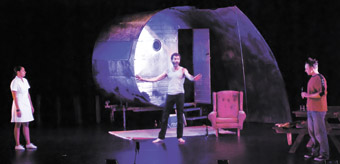
Kyas Sherriff, Shane Nagle, Ed Wightman, The Bloody Bride
photo Christian Watts
Kyas Sherriff, Shane Nagle, Ed Wightman, The Bloody Bride
IN JULIAN LOUIS’ PRODUCTION OF THE BLOODY BRIDE, A DARK CYCLORAMA CURVES ABOVE THE STAGE, SHADOWY LIKE A GNARLED FIG TREE IN THE DYING LIGHT OF A SWELTERING DAY; BEYOND, A HINT OF MOON AND STARS. BELOW, A BEAT-UP OLD CARAVAN WITH MAKESHIFT AWNING: AN ESKY, A DIRTY RED ARMCHAIR AND SOLID WOODEN PICNIC TABLE. LIGHTS INSIDE THE CARAVAN AND MUFFLED MUSIC OVERDUBBED WITH INAUDIBLE WHISPERS ALL FEED A SENSE OF MENACE AND CLAUSTROPHOBIA. THE SOUND SEGUES INTO BEATING WINGS AND THE STAGE IS SUDDENLY FILLED WITH THOUSANDS OF SCREECHING BATS PASSING OVERHEAD—THE EFFECT IS STRIKING AND LOADED.
The teeming ritual nocturnal flight of the fruit bat is familiar to anyone who knows New South Wales’ North Coast sunsets in summer. But the theatrical image, reminiscent of Goya’s painting The Sleep of Reason Produces Monsters, signals something beyond the naturalistic. In this impressive new work by Hilary Bell, we will be drawn into a metaphorical world of innocence corrupted by passionate desire, repressed sexuality, jealousy, nihilism and death; unusually heightened themes for Australian theatre.
The bats having passed over, now we are thrust into the lives of the three protagonists triangulated about the stage—Cassie (Kyas Sherriff) and Darren (Ed Wightman), a naive young couple from Lismore, and Leo an Irish ‘tourist’ (Shane Nagle). Having just met at a local pub before returning to Leo’s caravan on the outskirts of town, they are already drunk and the dialogue is sexually charged. Leo is the agitator here. Cassie appears to be enjoying the flirtation but Darren is awkward in his attempts to keep face against the jibes of this older, worldly rival. “Would you kill for her?”, challenges Leo while offering Cassie a drag on a mysterious ‘cigarette.’ Cassie accepts and is almost immediately aroused by an intense sensual reverie. When Darren asks what’s in the smoke, he is told “magic powder from Spain.” Leo chides, “Do whatever you want with her!” until Darren too takes a drag. In the final moments of this opening scene, as the action swiftly descends into a Dionysian underworld of projection and sound, we are confronted with the disturbing image of the frenzied young couple fucking on the picnic table while the tourist masturbates as he listens from the dirty red armchair.
There is something of a hint as to the genesis of The Bloody Bride in the ‘Spanish cigarette.’ Louis’ creative team were looking to contemporise Lorca’s masterpiece Blood Wedding into an Australian setting. There are some similarities between the works. Both deal with the clash of love/responsibility and desire/abandonment. And in each piece fatalism inexorably impels the action toward its conclusion. Leo might be the reincarnation of Leonardo—his murky past directly connects him to Lorca’s character. But the different settings make for different resolutions and the love triangle at the heart of both works unfold to very different effect. Lorca’s focus is lust, jealousy and revenge—the three protagonists all victims of a repressed and superstitious society. Stylistically, the intense Catholicism and ritual folkloric poetry of Lorca’s Spain don’t translate. The passionate Leonardo of Blood Wedding is not the machiavellian Leo of The Bloody Bride.
Instead, as Hilary Bell points out in her Writer’s Notes, the Lorca story becomes a departure point for an original work. Bell’s Leo has lost all desire–nihilism has become his creed, purity his enemy. As Leo draws Cassie and Darren into his suicidal plan, he is not, like Leonardo, driven by lust so much as the schadenfreude of destroying unsullied love. In Bell’s rendering, the love triangle becomes a metaphor for the loss of innocence at the hands of corruption. Ironically, this structural frame echoes the biblical story of Eden as Cassie is drawn into temptation knowing full well the world will rebel. There are moments when the tension between naturalism and metaphor threaten the suspension of disbelief. But there are still other moments of powerful emotional intensity. Ed Wightman’s portrayal of Darren’s vulnerability is particularly moving. As the sun rises and the bats flock home from their nocturnal feeding at the end of The Bloody Bride, there has been one death not two (as in Lorca’s play) and the naive young couple are forever changed.
The Bloody Bride marks a promising beginning to NORPA’s Generator program designed to develop new work. The audience at the performance I attended sat rapt throughout this swift, dark journey into the intimate emotions and conflicting ethics of relationships and sexuality. This is a most provocative piece of theatre and deserves to be seen beyond the North Coast.
NORPA, Generator Program, The Bloody Bride, writer Hilary Bell, director Julian Louis, dramaturg Janis Balodis, performers Shane Nagle, Kyas Sherriff, Ed Wightman, design Rita Carmody, lighting design Verity Hampson, sound design Toby Alexander, projection artist Marion Conrow; Star Court Theatre, Lismore, August 21-22.
RealTime issue #87 Oct-Nov 2008 pg. 18
© Peter Barclay; for permission to reproduce apply to realtime@realtimearts.net
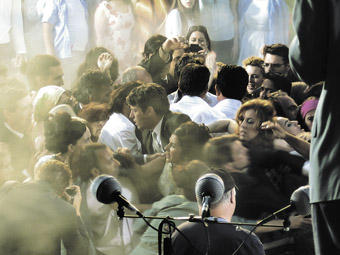
J’s Kennedy Moment, The Rape of the Sabine Women, Eve Sussman
VIDEO ARTIST EVE SUSSMAN BRINGS HER LATEST WORK, THE RAPE OF THE SABINE WOMEN, TO THE MELBOURNE INTERNATIONAL ARTS FESTIVAL THIS MONTH. BASED ON AN 18TH CENTURY PAINTING BY JACQUES-LOUIS DAVID, IT IS AN EXAMPLE OF THE ARTIST’S ONGOING USE OF CANONICAL PAINTINGS AS SOURCES OF INSPIRATION.
Sussman was born in London in 1961 to American parents. Her mother was an interior designer with a talent for historic restoration, while her father, a chemical engineering professor, took travelling sabbaticals, which allowed Sussman to grow up not only in Massachusetts but also in Turkey, India, Israel and New Zealand. Having studied photography and printmaking, Sussman moved into sculpture and installations in 1989, but maintained an interest in the reflective qualities of materials as much as in their spatial dynamics. On the phone from her studio in Brooklyn, Sussman explained to me how she had played with surveillance cameras since high school and that her interest in sculpture had always been closely related to this fascination with observation, reflection and projection. An effortless consequence of this fascination was Sussman’s move into video art.
However, the categorisations that one inevitably falls into in succinctly verbalising an artist’s career can too easily elide the details. Sussman’s apparent departure from photography towards the moving image is not so clear-cut. She herself is adamant that her work and her interests cannot be pinned down to one mode of communication or representation. She is as likely to create a sculpture next as she is a photograph, as she is a video. Moreover, the very attaching of the nomenclature ‘video’ immediately differentiates and establishes a tension between Sussman’s work and that of ‘filmmakers.’ This is clearly no small matter. Much of the history of video art has seen it deliberately drive itself in opposition to the film industry. That is not to say that there haven’t been many exceptions, but the subject is clearly important to Sussman, who distances herself from this culture of video art by affirming her cinematic influences.
In The Rape of the Sabine Women, Sussman’s attention to her cinematic and artistic predecessors is abundantly clear. The initial catalyst for the work came haphazardly when Sussman was flicking through an art book and chanced upon Jacques-Louis David’s The Intervention of the Sabine Women from 1799. She had been looking for a reason to work with choreographer Claudia de Serpa Soares again and the painting provided the perfect starting point, with its vividly populated battle scene lending itself to Soares’ abilities. Based on a Roman myth, The Intervention depicts the efforts of the Sabine women to make peace between their fathers, the Sabines, and their husbands, the Romans, who had kidnapped the women for wives. In the end, Sussman and her team of regular collaborators, known as Rufus Corporation, decided to work more from the original myth than from the painting. They brought the story into the aesthetics of the 1960s and with that came the concomitant cinematic references of that decade. Foremost among these is the work of Michelangelo Antonioni, whose distinctive visual style utilised long focal-length lenses to produce abstract graphical compositions with flat areas of colour, in the tradition of painters such as Barnett Newman. Sussman readily admits to having rewound again and again across “millions” of frames of Antonioni’s films for inspiration, as well as those of Jean-Luc Godard and John Cassavetes.
The work of Cassavetes is an important touchstone here because of his legendary use of improvisation in the creative process. Sussman and her team rehearse thoroughly, but within the framework of rehearsal there is scope for creative licence. In a method developed during the filming of 89 Seconds at Alcázar, Sussman’s reimagining of the Velázquez painting Las Meninas, certain rules or necessary points of action might be established and then it is left to the actors to realise the scene. The nature of the work is always non-verbal, so the improvisation is in the languages of gesture and proxemics. Yet for someone who speaks freely of an “organic” process of improvisation and collaboration, Sussman seems to hold the authorial reins much tighter with the rest of the crew. Though some reports suggest that Rufus Corporation is a democratic body with Sussman as a benevolent mediator, the tone she adopts in speaking about working with her director of photography implies that the vision of the work—the eye of the camera—remains very much hers. However, in discussing the music, by composer Jonathan Bepler, it is clear that the collaborative democracy of the process does sometimes lead the piece in directions that Sussman might not have chosen herself. Indeed, the sheer pluralistic scale of the work is something that Sussman was evidently happy to leave behind when it came to the editing, which she did herself with the help of Kevin Messman, the editor on Todd Solondz’s Palindromes.
Trawling through almost 200 hours of footage, Sussman cut the final film down to 83 minutes, but she makes use of the discarded footage on side projects, or “postcards”, that form a sort of halo of works around the main feature. Along with these shorter sequences of film are still photographs taken on set that are distinct from the film and not to be mistaken for film stills. The effect is a collection of works that feels much more like a gallery exhibition than a movie.
Nevertheless, The Rape of the Sabine Women is just that, a movie. The shorter works, in their use of vérité time and brief, looping gestures, allow the viewer to engage with them in the way one might with a painting or photograph—Sussman also likens them to fish tanks and has called one of the pieces Aquarium. But the film, in its traditional feature length, its narrative structure and its dramatic aspirations, is a work of cinema with all the corresponding audience expectations and, in this regard, Sussman is breaking new ground for herself as an artist as well as opening herself up to a whole new array of viewers, fans and critics.
Eve Sussman & The Rufus Corporation, The Rape of the Sabine Women, Melbourne International Arts Festival, ACMI, Oct 17-19, www.melbournefestival.com.au, www.rufuscorporation.com
RealTime issue #87 Oct-Nov 2008 pg. 2
© Carl Nilsson-Polias; for permission to reproduce apply to realtime@realtimearts.net
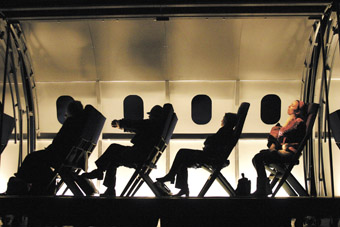
Nuria Garcia, Lipsynch
photo Érick Labbé
Nuria Garcia, Lipsynch
AS PART OF HIS COLLABORATIVE WORKING PROCESS FOR LIPSYNCH—IMPROVISATION, ACTORS AS CO-CREATORS, MULTIPLE AUTHORS, AN ABSENCE OF SCRIPTS—DIRECTOR ROBERT LEPAGE ASKED PARTICIPANTS TO BRING A TEXT OR OBJECT TO REHEARSALS. DRAMATURGY CONSULTANT MARIE GIGNAC’S CONTRIBUTION WAS AN 8MM SILENT FILM OF HER FATHER WHO DIED WHEN SHE WAS THIRTEEN. THIS DEVELOPED INTO “MARIE” WHERE A CHARACTER’S ASPHASIA RESULTS IN HER FORGETTING THE SOUND OF HER FATHER’S VOICE. MARIE (FRÉDÉRIKE BÉDARD) THINKS IF SHE CAN JUST DISCOVER WHAT HE SAID, SHE’LL RECOVER HIM.
But when she hires a woman to lip-read old film reels, she’s disappointed by the meaningless exchanges. “It’s pretty banal”, she says; “That’s life”, the woman shrugs. Persisting, Marie asks an actor to dub her father. After three hilarious attempts (he sounds like a dalek, “a Martian in Bugs Bunny”, a drunk) she tries it herself. A voice comes from nowhere; her father’s voice. “The voice is inside you”, her sister says.
This is just one of the stories from nine characters unfolding over nine hours. The first concerns opera singer Ada (Rebecca Blankenship) who witnesses the death of a young mother on a plane and goes on to adopt the orphan she calls Jeremy. Another shows Jeremy’s (Rick Miller) quest to make a film about his dead mother; another Detective Inspector Jackson (John Cobb) investigating a suspicious death and trying to find a tango partner to replace his wife; yet another a raucous funeral. As with all Lepage’s epics, Lipsynch is more an event than a show. The Barbican theatre is packed, there’s a sense audience members are fans happy to share chocolate and opinions while they watch an increasingly layered narrative explore voice, language and speech as discrete entities.
In order to concentrate on the notion that voice is genetic (almost part of the fabric of the soul, whereas language or speech is encultured) Lepage courageously eschews the stunning visuals for which he is known. So, sets are witty and efficient—the side of a plane morphing into a train—but not spectacular. Instead, there is a glut of sound from singing to speeches, to a baby’s cries, to advertisements, to canned laughter. In a Los Angeles restaurant, conversation is punctuated with simultaneous translation and ringing telephones. Characters switch languages as do actors—text is in English, French, German, Spanish, Italian. On occasion, where surtitles are unclear, we are immersed in pure sound and sometimes, as Jeremy tells us, music transcends failing language. As her son departs for California, Ada sings from Górecki’s Symphony no. 3 the lament in which the Virgin Mary asks Jesus dying on the cross to “Share your wounds with your mother.” In other episodes we learn: we can speak without saying anything (President Bush is quoted); the content of speech—however plaintive or important—can be reduced to an analysis of harmonics and frequency; by recording permutations for British Rail announcements, you could read your own obituary. And death does not mean your body stops farting.
To its immense credit, Lipsynch is often very funny, moving, insightful and never boring. It deserves multiple viewings to appreciate all of its references and nuances, the motifs of loss, of absent fathers, biblical characters, dualism; the incredible performers who take us on journeys as their multi-faceted roles age, change context or gain knowledge. Yet for all that, and for its previous incarnation in Newcastle as a five and a half hour work-in-progress, it doesn’t quite cohere. Perhaps it’s because the narrative’s emotional treatment of prostitution, its insistence on victims, is overbearing even in the context of nine hours. Despite Sarah Kemp’s faultless acting, her role is such a cliché it’s almost parodic (she’s a street prostitute, formerly drug-addicted, sexually abused, raped, self-harming victim of incest, but too honest to steal).
Later, in Nicaragua, we witness the fate of Lupe (Nuria Garcia), Jeremy’s birth mother, who is just 15 when her uncle sells her to sex traffickers for $600. The two stories are subtly linked (Sarah is from Manchester, Lupe is in a German brothel dancing to Manchester band Joy Division; there’s the possibility that punter “Tony” who demands Lupe’s services is the same Tony who raped his sister Sarah as a child). Even accepting the premise of their inclusion (giving a voice to those who do not have one), this begins to feel like a cross between harrowing documentary and bad soap opera. Only when the tone, rather than content, of speech is emphasised (as in the comic scene where the middle class presenter of a radio show asks Sarah and male escort AJ inane, prurient questions) are we reminded of Lepage’s intention to emphasise the difference between internal voice and language as learned behaviour. The other ideas in those episodes—reinventing oneself through voice; the impact of accents; how the car, voicemail and microwave speak but humans fail to communicate—appear incidental.
Conversely, the parts that resonate most are those where narrative is secondary and where the interplay between voice and image is explored (which is, after all, what lip synching is). When Jeremy turns filmmaker, sound and image are divorced and remarried. Foley artists recreate every effect; dialogue is dubbed into French. At neurosurgeon Thomas’ (Hans Piesbergen) request, Marie tries to give names to child-like chalk drawings and says “arab” rather than “arbre”, noting the difference one letter can make to signification. Head bandaged post-operation, Marie sings Gregorian chant into a machine. The patterns made by her voice are projected onto the screen behind in a series of vertical lines on graph paper. They accumulate into thicker marks as echoes increase; lines like bundles of sticks across the page. In disturbed sister Michelle’s story (Lise Castonguay), shapes press against transparent clinic walls as she hears voices; later snow falls against a bookstore where poetry readings are held and a girl in an orange dress hopscotches along the pavement to the sound of traffic.
Lipsynch is truly magical for its metaphysical enquiries. Where do lost and forgotten memories go? Do men stammer more because they are more vulnerable? Is God just the human brain’s best creation? These moments make us want to keep listening.
Ex Machina/Théâtre Sans Frontières, Lipsynch, direction/text Robert Lepage, performance/text Frédérike Bédard, Carlos Belda, Rebecca Blankenship, Lise Castonguay, John Cobb, Nuria Garcia, Sarah Kemp, Rick Miller, Hans Piesbergen, dramaturgical consultant/text Marie Gignac, design Jean Hazel, lighting Etienne Boucher, sound Jean-Sébastien Côté, costume Yasmina Giguère; Barbican Theatre, London, Sept 6-14
RealTime issue #87 Oct-Nov 2008 pg. 3
© Marie-Anne Mancio; for permission to reproduce apply to realtime@realtimearts.net
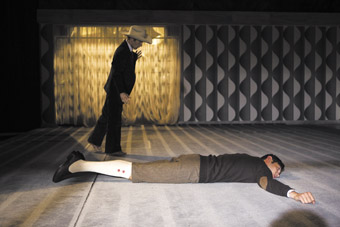
Socìetas Raffaello Sanzio,
Purgatorio
photo Luca Del Pa
Socìetas Raffaello Sanzio,
Purgatorio
PURGATORY IS A TEMPORAL NOUN. THERE ARE NO CLOCKS IN THE INFERNO OR IN PARADISE—THERE IS NO TIME IN ETERNITY. BUT PURGATORY IS IMMANENTLY EPHEMERAL. AT LEAST, THAT’S HOW DANTE WOULD HAVE IT. PURGATORY IS ALSO THEATRE. IT IS A MORALITY PLAY WRIT LARGE, WHERE THE ACTORS ARE SINNERS AND THE CURTAIN CALL IS THE EXPURGATION OF SIN.
Romeo Castellucci’s staging of Purgatorio [the second part of his trilogy inspired by Dante’s The Divine Comedy], commissioned by the Festival d’Avignon, begins with a quotidian scene of bourgeois domesticity. The set is an expansive, hyperrealist snapshot of refined 1970s living—dark wood, muted tones, recessed lighting. In it, a boy dangles his feet at a table and a woman washes dishes. It is, by every appearance, a literal kitchen sink drama we are witnessing. But Castellucci establishes these references, these codes of theatrical familiarity only to derail our expectations. Like Michael Haneke in his film The Seventh Continent, Castellucci begins by feeding us these images of habit without the anchors of narrative or character. The mundane actions and props of life are thereby removed from their context and float in front of us as anonymous signifiers, suggesting the illusiveness of this existence. Purgatory is, after all, theatre—the replaying, in real time, of a misjudged life.
The woman, a screen tells us, is called “First Star”; the boy is called “Second Star.” When they speak to each other, we see their words just before the actors vocalise them and the dialogue is drawn out by silences, as though the characters were not so much conversing as simply passing the time. And time does pass. The first act of Purgatorio is a blatant invocation of time as punishment—weary festival-goers would have been forgiven for resting their eyes a little. The discrepancy in timing between the surtitles and the text is no technical hitch, but rather a deliberate ploy to disrupt the action by anticipating it with text. Castellucci thereby de-energises the dramatic tension, distances the characters from one another and asserts a painterly torpor on the space. This inertia has strange effects, particularly on time, the measurement of which is always a measure of movement. With no reference points of action, the audience’s sense of time is dislodged and what might have been only 20 minutes feels instead like an hour.
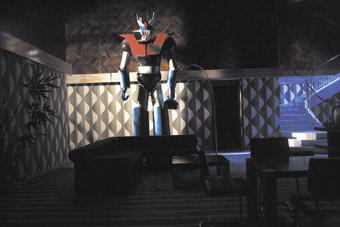
Socìetas Raffaello Sanzio,
Purgatorio
photos Luca Del Pa
Socìetas Raffaello Sanzio,
Purgatorio
With all this inaction, what does the audience desire at this point, what does it expect? It wants a change and it expects action. Castellucci delivers. Having apparently returned from a day at the office, a man (“Third Star”) has entered the domestic scene. He does not touch the food his wife presents him with, but dons a cowboy hat and takes his young son upstairs. The stage is emptied of actors but slowly, discomfortingly one hears the brute grunts of the father and the weeping pain of the son from offstage. The audience has been given the drama and action they craved in the form of a tortuous and prolonged rape. So, the initial stretching of the audience’s patience is not done merely to punish but also to disturb. Just as sinners would pass through the seven stages of Purgatory to be cleansed, Castellucci puts us through these early tests of our own theatrical sins of expectation.
Having, at first, exasperated the audience and having then slapped them in the face with their own hand, Castellucci changes gears once more. The father eventually returns to the stage in a somewhat dishevelled state and is joined soon after by the boy, who bears no discernible sign of mistreatment. Strangely, the boy consoles the man with the words, “Ne t’inquiète pas, tout est fini” (“Don’t worry, it’s all over”). It acts as a pardoning and, thus, an inversion of the power structure we expect.
This inversion is echoed in the final act, when two different actors come on in the costumes of the father and son. The father is now a shorter, slighter man and played by an actor (Juri Roverato) who suffers from severe spastic tetraplegia. On the other hand, the boy is now a towering two metres tall. The father begins a sort of fitful dance that the son echoes until his body is totally at the mercy of the convulsions. In front of this action, a clear glass circle hangs spinning as black paint is squirted onto its surface by automated jets. The resulting web of interweaving spirals on the glass is beautiful to the point of distraction, but beneath the blackened circle that hovers in the space, the son continues to jar his body unceasingly against the floor. A realisation soon dawns: it’s not all over after all.
Socìetas Raffaello Sanzio, Purgatorio, inspired by Dante’s The Divine Comedy, mise en scène, design, lighting, costumes Romeo Castellucci, original music Scott Gibbons, choreography Cindy Van Acker, Romeo Castellucci, performers Irena Radmanovic, Pier Paolo Zimmermann, Sergio Scarlatella, Juri Roverato, Davide Savorani; Châteaublanc Parc Des Expositions, Avignon, France, July 9-19
RealTime issue #87 Oct-Nov 2008 pg. 4
© Carl Nilsson-Polias; for permission to reproduce apply to realtime@realtimearts.net
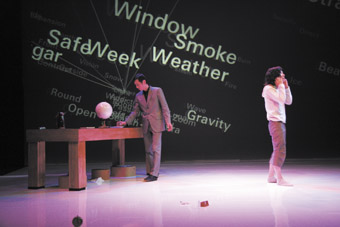
Takao Kawaguchi, Tsuyoshi Shirai, True, Dumb Type
photo Yohta Kataoka
Takao Kawaguchi, Tsuyoshi Shirai, True, Dumb Type
A MAN IN A GREY SUIT IS TELLING US ABOUT OUR BRAINS. DESCRIBING THE PERCEPTION OF COLOUR, THE EFFECTS OF CAFFEINE AND NICOTINE AND THE BODY’S REACTION TO SURPRISE, HE SPEAKS IN PRECISE, CLIPPED TONES, DISPASSIONATELY EXPLAINING THE GAP BETWEEN OUR INTERNAL AND EXTERNAL REALITIES. AS HE SPEAKS, HE CIRCLES ANOTHER MAN, WHO IS RE-LIVING THE EXPERIENCES HE DESCRIBES. BEHIND THEM PROJECTED KEY WORDS ARE LINKED WITH MONOCHROMATIC PRECISION, LIKE A DATA-VISUALISATION OF PSYCHO-PHYSIOLOGICAL PHENOMENA. “AS THE ZIGOMATICUS MUSCLES CONTRACT THE MOUTH OPENS HORIZONTALLY”, HE TELLS US, INDIFFERENTLY CONTROLLING THE OTHER’S MOVEMENTS. “AND THE EYES ARE PULLED DOWN TO MAKE A SMILE.” THIS IS DUMB TYPE’S TRUE.
Exploring the “relationship between the brain and the reality we face”, true is an extraordinary collaboration between Yamaguchi Centre for Art and Media, Kanazawa 21st Century Art Museum, Yokohama Red Brick Warehouse and 10 artists from new media, technology, dance and theatre companies, including Dumb Type, rhizomatiks, AbsT/baneto and Softpad. In exploring the interface between reality and the processes that mediate our experience, the makers of true have incorporated as many new media technologies in this production as would seem humanly possible. Their tech rider is staggering.
Though the set is minimal, it becomes apparent during the show that it is deceptively simple. White vinyl covers the floor, and there is a thick wooden table littered with everyday objects. Above, is an 8m wide circular truss of LED lighting especially developed for the show by director and lighting designer Takayuki Fujimoto of Dumb Type. The back wall is a translucent PVC screen, which allows for both front projection and later, a performer to appear, lit from behind. The stage area is sandwiched on both sides by three storey high scaffolds, reminding us that this is a site of construction, where reality is constantly mediated by perception.
The show is divided into nine scenes, reading like the curriculum of some unspecified high school course: Introduction, Science, Music, Physical Education, Verbal Skills, Social Studies, Drafting, Maths and Survival. The Introduction borrows more from silent-movie slapstick than contemporary dance, with Tsuyoshi Shirai (of AbsT/baneto) establishing the naive nature of his character. He seems bewildered, as though awakening, and becomes innocently pre-occupied with the objects on the table—gazing at a picture, bouncing a ball, rearranging a tea cup and kettle. Perfectly synchronized sound effects match Shirai’s manipulation of the objects, some appropriate, and some completely estranged from the motions he makes. Prefiguring the stage craft yet to come, the tea cup moves across the table seemingly of its own volition, and then a large circular section of the table, with tea-cup still atop, drops neatly to the floor.
As we move from the Introduction to Music we meet our second character. Appearing stage-left, clad in a brilliant red PVC hooded robe reminiscent of a boxer’s cloak, this quite ominous character climbs slowly up the scaffold. He observes the action, while occupying the periphery of audience vision. As Shirai executes some bedroom-style air guitar action on the stage below, the red robe is removed and tossed down emulating an MTV video clip.
Unrobed, Dumb Type’s Takao Kawaguchi reveals himself as a stylishly, grey suited character, at once menacing, impish and manipulative. As the relationship between these two characters unfolds, the choreography shifts between formal paradigms, changing from movement-with-intention to contemporary dance through to physical theatre. This relationship begins with one of true’s most breathtaking moments, when the LED lighting executes a dazzling circular strobe, and the dancers spin in opposite directions, their shadows on the white floor appearing to stalk them. Kawaguchi and Shirai continue to perform a series of duets, in which Kawaguchi’s suited character appears to manipulate Shirai’s naive disposition, culminating with Kawaguchi literally controlling Shirai’s face, presenting us with both comedy and pathos, as the face contorts through smile, sadness and scream.
The nature of the relationship between these two characters is ambiguous. Any mention of it is noticeably absent from the program notes, leaving audiences to deduce it for themselves. For me Kawaguchi’s character comes to represent social norms, maturity, expectations and generally the constrictions of the older self, written upon and set in its nature. Shirai represents youth, play, wonder and the promise and possibility of the blank slate. In the wonderfully executed spoken word poetry-dance of Verbal Skills, true speaks of the relationship between the mechanics of perceiving reality and the individual processing of this data into meaning, memory and emotion. In this context Shirai and Kawaguchi perform a kind of coming of age, in which our perceptions and apprehensions shift over time—we are afraid of getting old and then nostalgic for our youth, yet the nature of the stimulus we receive and the way in which we receive it remains unchanged. Why does a colour, a smell or a sound come to mean so much to us?
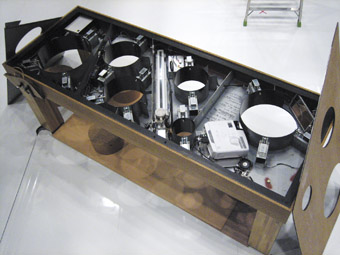
Dumb Type, true, table mechanics
photo Motoi Ishibashi
Dumb Type, true, table mechanics
True is full of those rare moments when you feel the audience collectively take a breath, when technical wizardry, stage-craft and performance combine to effectively convey emotionally charged imagery. The table and its objects come to life without human touch. The lighting separates and recombines colours, fading and strobing light in a way that traditional theatre lighting simply cannot. Sounds emanate from objects, including the scaffolding, which at one point hums a tune when oscillators vibrate the aluminium structures. The video component, left in reserve until Verbal Skills, is wonderfully simple, and offers surprises, particularly when a tiny projection of a dancing man appears from within the table to light up the spinning globe of an atlas. And all of this is completely synchronous with stage action through the use of myoelectric sensors attached to the performers’ bodies, providing real-time triggers for sound, mechatronics, lights and video. With so much ‘trickery’, true could easily have overplayed its hand, distracting us from the relationship between Shirai and Kawaguchi. Instead the technology serves and enhances the performances in ways rarely seen in new media dance collaborations.
If good contemporary dance goes beyond metaphor, or even aphorism, and provides a series of images for audiences to superimpose possible meanings, then great dance is where those images dive into our desire through all our senses, providing a narrative beyond words, leaving audiences in a state of bodily wonder, alive with altered perceptions. Dumb Type’s true is truly great dance.
International Symposium of Electronic Arts 2008: Dumb Type, true, direction, lighting design Takayuki Fujimoto, choreography, dance Tsuyoshi Shirai, choreography, text, dance Takao Kawaguchi, sound, video, visual design Takuya Minami, sound, oscillation, programming Daito Manabe, video, programming Satoshi Horii, table design, mechanics Seiichi Saito, Motoi Ishibashi, producers Yamaguchi Centre for Arts and Media, 21st Century Museum of Contemporary Art, Kanazawa, Yokohama Red Brick Warehouse, Hi Wood; Esplanade Theatre Studio, Singapore, July 24-26, www.true.gr.jp
RealTime issue #87 Oct-Nov 2008 pg. 5
© Matthew Gingold; for permission to reproduce apply to realtime@realtimearts.net
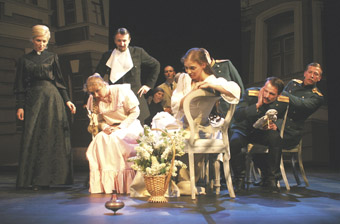
Three Sisters, Chekhov International Theatre/Cheek by Jow
photo Mikhail Guterman
Three Sisters, Chekhov International Theatre/Cheek by Jow
IF I SAY THAT LYNDON TERRACINI’S BRISBANE FESTIVAL 2008 WAS ALL OVER THE PLACE, I MEAN THIS TOPOGRAPHICALLY. THERE WERE ALL SORTS OF FREE EVENTS OCCURRING ROUND THE SUBURBS, WITH PERHAPS A LESSENING OF THE TRANSGRESSIVE SENSE OF CARNIVAL ON THE CITY STREETS. NEVERTHELESS, FOR THEATREGOERS TERRACINI’S CHOICES PROVIDED MANY MOMENTS TO SAVOUR.
three sisters
Declan Donnellan’s luminous production of Three Sisters showed us how to look at Chekhov afresh. There was so much sheer brio in this saddest of plays—about three sisters from pre-revolutionary Russia who can contemplate happiness in the past, the future, but never the present. When I went, there were a bunch of Russians occupying a half empty theatre. They understood. It’s life. The doll’s house brought out at the beginning for Irena’s name day eerily evoked associations with Ibsen’s play, especially for Brisbane audiences who recalled Mabou Mines’ magnificent festival production of A Doll’s House in 2006.
In contrast to Ibsen’s pejorative take on role playing and childishness, however, an interlude in the first act that focused on the name day celebrants—mesmerised by a spinning top—conveyed not only the spontaneity and self-abandon pervading the moment, but the centrifugal force of Donnellan’s direction. His production turned on a seductive balance, highlighting these exuberant and positive qualities with a delicacy that only compounded the social tragedy. The superb ensemble likewise created an electric field, a dynamic gestalt rather than the solipsism of individual characters sometimes critically attributed to Chekhov as a precursor to Becket.
Designer Nick Ormerod’s non-naturalistic deployment of chairs and tables seemed swept up in the swirling force of this production. Deftly rearranged by the cast for the scene changes, they coalesced as if by magic, until, jumbled together, they came to represent a larger metaphor for things falling apart. We gained a belief from this production in the strength that the sisters summoned from each other at the end, however bereft they were, and despite all the implicit ironies for our own times.
the kingdom of desire
The Kingdom of Desire was a lavishly mounted production, a superb blend of Beijing Opera with Western theatre in an adaptation of Shakespeare’s Macbeth, set in feudal China and performed in Mandarin with English surtitles. In any language, this was stimulating and accessible theatre. The Contemporary Legend Theatre of Taiwan has moved away from traditional minimalism and subject matter to explore the freedoms of the contemporary stage. Exotic from a Western point of view were the expressive forms of singing, chanting, hand gestures, face painting, elaborate costuming, acrobatics and martial arts. The interesting result, however, was a heightened realism that easily translated across cultural barriers. This admixture included delightful elements of clowning that bracketed even the lead actors in a Brechtian way. The company might be seen as restoring to Western audiences an enjoyment of lost elements of their own traditions—the popular forms of vaudeville, pantomime and melodrama. Fifty year old actor/director Wu Hsing-kuo as Macbeth received rapturous applause when he somersaulted backwards from a huge height in a death scene reminiscent of Kurosawa’s 1957 film, Throne of Blood. Beat that.
the grand inquisitor
From total theatre to Peter Brook’s empty space—a brightly lit, bare stage. Brook directed long-time collaborator Bruce Myers as raconteur/performer of Dostoevsky’s parable of the Grand Inquisitor. Christ has returned to Earth at the time of the Spanish Inquisition and has been condemned to death as a heretic. If Marx denied that he was a Marxist, then Christ would have to deny he was a Christian. Interrogating the still and silent figure of Christ (Joachim Zuber, seated downstage on a stool), Myers’ Grand Inquisitor has a measured intensity that never flags as he paces, advances and retreats while pursuing his labyrinthine argument.
The Inquisitor, ideological policeman for any totalitarian regime, argues that Christ has cursed mankind with the intolerable burden of free-thinking, pre-figuring TS Eliot’s remark “mankind cannot bear too much reality.” Brook, by presenting Dostoevsky’s parable in the theatre, made me aware of a dimension I hadn’t grasped reading it. That is, it is the intensity and authenticity of Christ’s (Zuber’s) listening rather than his silence that causes the Inquisitor’s inner unravelling, and his bidding that Christ go free on pain of never returning. The Inquisitor argues with unassailable logic (after all, he has history on his side), but Brook subtly demonstrates that, while philosophy demands our entire mind, listening demands our totality. This was the revelation of Christ’s kiss of peace, and the chill implication in Myers’ last line: “The kiss glows in his heart, but the old man sticks to his idea.”
theatre, community, constituency
Queensland Theatre Company’s The August Moon and Eugene Gilfedder’s The Fiveways had mirroring concerns, but differed widely in approach. The August Moon had as its subject matter the effects of cyclone Larry on the far north Queensland community of Innisfail, while Gilfedder’s piece took on a different kind of natural disaster—the storm of development engulfing local communities, landmarks and history in the inner suburbs of Brisbane. Writer/ directors Adam Grosetti and Jean Marc-Russ reported the community they visited verbatim, for sensitive reasons, while writer/director/composer/pianist Gilfedder was on home ground, speaking to, and on behalf of, his own constituency. He could speak as he liked. Both productions interestingly turned round this question: Who is speaking? And on whose behalf?
the august moon
This was more fraught for the QTC production. Looking for the story behind the one reported death of a man at the August Moon Caravan Park, the writers found there was no story, and the whole thing was a beat-up by the press. As self-styled ‘Gonzo journalists’, they interviewed the brother and sister owners of the caravan park who felt unfairly put upon, another elderly resident and the barmaid who looked out for the deceased man. So far, so forensic, but aware that in a postmodern world narratives are suspect, they proffered themselves up as contaminated evidence. They inserted themselves as characters into the ‘script’, the ‘script’ became a ‘score’ to be manipulated along with other media, and actors could only ‘stand in’ for real life people. Or sit down. The actors were seated on a revolve stage reading transcripts of the interviews in the metaphorical eye of the storm, but the exciting possiblities of the reconfiguration of the Billie Brown Studio as a panoramic theatre in the round were not realised. This production became confused in its own metatheatrics, and in the end spoke for no-one. A pity, because underlying I suspect was a compassionate motive, not an exploitative one.
the fiveways
Presented as a free event in a car park in West End, surrounded by developers’ cranes, and close to one of Brisbane’s historic fiveway intersections, The Fiveways, a Brisbane Festival commission, was brilliantly located with its scaffolding and street party atmosphere—kids, cushions and lots of meet and greet—within the totality of inner-city West End as mise en scene. The set design was classic Footrot Flats; a figure of progress out of control, Harlequin as a patchwork jockey somersaults through randomly and literally brings the house down at the end. Madam Butterfly (Li, the Chinese Takeaway Lady) meets Mo McCackie (three inebriated punters from the TAB) meets the devil (Wright, the developer), who of course had all the catchiest tunes. The uncanny figure of the The Goldfish Girl, a soulful soprano, loosely defines as the spirit of place. Two tuxedoed piano players completed the ensemble and played as if themselves possessed by the ghosts of silent film accompanists sent back to save their old stamping ground.
The political message was perfectly clear but, like Peter Brook, Gilfedder is interested in a Theatre of Myths, where the audience might draw many different layers of meaning. Gilfedder’s plangent, Sondheim-like score was likewise hauntingly evocative, especially in the interludes. He has said that he tries to give expression in his work to the “semi-ecstatic stillness in Australia.” But there were also European influences here. The absurdist playwright Eugene Ionesco confides that his plays have their origins in two basic states of consciousness, “an awareness of evanescence and of solidity, of emptiness and of too much presence.” This seems to speak to Gilfedder’s deceptively populist Gotterdammerung. And in the figure of the Goldfish Girl, it was truly as if the beauty of the objects of Surrealist desire had become convulsively alive through dreams. Gilfedder is possessed by his amour fou, and speaks for the angels.
2008 Brisbane Festival: Chekhov International Theatre/Cheek by Jowl, Three Sisters, writer Anton Chekhov, director Declan Donnellan, design Nick Ormerod, Playhouse, QPAC, 29 July-Aug 3; The Kingdom of Desire, director Wu Hsing- Kuo, QPAQ, July 23-26; The Grand Inquisitor, from Fiodor Dostoyevsky, director Peter Brook, adaptation Marie-Hélène Estienne, Cremorne Theatre, QPAC, July19 – 26 July; Queensland Theatre Company, The August Moon, writers Adam Grossetti, Jean-Marc Russ, director Jean-Marc Russ, designer Bruce Mckinven, lighting David Walters, composer/sound design Brett Collery, cinematic theatre design Brad Jennings, Steven Maxwell, Billie Brown Studio, July 17-Aug 9; Fiveways, director, composer, writer Eugene Gilfedder, design Jonathon Oxlade, lighting, David Murray, choreographer Neridah Waters; West End, July 31–Aug 2
RealTime issue #87 Oct-Nov 2008 pg. 6
© Douglas Leonard; for permission to reproduce apply to realtime@realtimearts.net
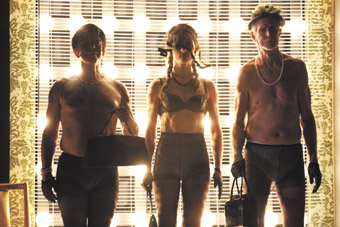
Omar Ebrahim, Deborah Kayser, Philip Larson, The Navigator
photo Justin Nicholas
Omar Ebrahim, Deborah Kayser, Philip Larson, The Navigator
THE NAVIGATOR IS PARTLY INSPIRED BY WAGNER’S OPERA ABOUT ILLICIT DESIRE, TRISTAN AND ISOLDE. COMPOSER LIZA LIM AND LIBRETTIST PATRICIA SYKES HAVE CREATED WHAT IS ESSENTIALLY AN ERSATZ MYTH TO TRACK THE PERMUTATIONS OF DESIRE IN THE MODERN WORLD. IN ORDER TO RESIST THE MAGNETIC PULL OF WELL-KNOWN MYTHS, “YOU MUST GO BEYOND THE SOURCE INTO NEW TERRITORY VERY QUICKLY”, SYKES SAYS. RATHER THAN A NARRATIVE JOURNEY ON A MASCULINE MODEL, THEY HAVE TAKEN PAINS, AS LIM SAYS, TO “RADIATE EXPRESSION AND EMOTION, STATES OF BEING.” I SUGGEST THAT THE WORK ATTEMPTS TO CONVEY THE HIDDEN, THE UNSPOKEN, ESPECIALLY ON THE OUTER FRINGES (SUCH AS THE NON-SPACE OF THE ‘FEMININE’ IMAGINARY). THUS THE OPERA BEGINS IN TIMES OF WAR IN WHICH THE BELOVED HAS BEEN GAMBLED AND LOST (LIKE DRAUPADI IN THE MAHABHARATA). SHE ENTERS A RIVER OF TRANSFORMATION IN WHICH SHE UNWINDS INTO HER SHADOW TWIN, THE NAVIGATOR. IN THE WORDS OF THE BELOVED, “I TWIN MYSELF, BECOME THE HE WHO IS ME AND NOT ME, DISGUISED, STRANGER, TRAVELER, EXILE …”.
Other archetypal characters intersecting with her journey are the Fool, The Angel of History and the Crone. Baritone Omar Ebrahim as The Fool—a minotaur like figure, huge horns, huge male genitalia—courses from male polarity to female, producing ‘reality’ in the world as we know it, according to the system of the Tarot. Similarly, Philip Larson, as The Crone questions essentialist myths of gender. The Angel of History is graphically, irruptively enacted by baroque alto Deborah Kayser in a full-skirted ball gown, gnashing and growling in an aphasic, deep masculine register as ‘he’ sees “one single catastrophe that keeps piling ruin upon ruin and hurls it in front of his feet” (Walter Benjamin). As the program notes, “The Angel’s gaze takes in landscapes of tidal blood, unwinding rivers, glaciers, a comet, the ocean, the desert, and finally—in a vision of rebirth during which a cicada is placed on the eye of a foetus—the submarine amniotic world of the womb.”
As director and designer Barrie Kosky, far from being ‘iconoclastic’, handled the mythic dimension of this work with great precision and astuteness in his decision making. As a backdrop to his painterly tableaux a series of confined urban spaces are represented as a flat, continuous and uncluttered collage. A shallow stage and intense and clever lighting contributed to create stage pictures of extreme visual potency: a Tiresias-like old man/woman, sorrowful and strong; roses above a doorway become a brothel’s red light; Max Ernst-like creatures shuffle in and out of the brothel. An array of symbolic costume changes added to the surreal effect.
The Beloved, soprano Talise Trevigne, nightclub svelte in a simple purple silk shift sings like a siren. She is the essence of longing and loss. The Navigator, her other, is the potently beautiful counter-tenor, Andrew Watts, sometimes also in a purple silk shift. Cross-dressing is not fortuitous, however, but an artful play of signs. In this context, it’s interesting that Virginia Woolf considered it was “fatal” for an artist to be simply a man or a woman. Following on from Woolf, Hélène Cixous maintains “that there is no invention possible…without there being in the inventing subject an abundance of the other, of variety.” Tristan and Isolde’s mythical love affair, at least from Wagner’s revisionist perspective, was all in the mind, more intimate, more profound than sex. Their deeper reality was riven through by the same cosmic forces of creation and destruction, of Eros and Thanatos, that course through Lim’s and Syke’s imaginative world. Indeed, simply as an artist, Lim appears to be enthralled by the infinite musical possibilities of alterity and otherness.
Genevieve Lacey, as a young girl in an animal mask, pouring her soul into a Ganassi recorder is our overture. This instrument with its lamenting tonality speaks of an otherworldly eroticism and is urgently counterpointed by the incessant cicada sounds that signal “a high pitch of desire” for the other. The sheer carnality of the embodied voices of the singers, pitched to the many tensions of desire expressed in this work paradoxically raised them to a mythic level. Conductor, Manuel Lawri, draws forth too, from the superb Elision Ensemble, complex aural landscapes that illuminate and interpenetrate the cosmos-encompassing stage action, completing what Kosky promised, “a fugue of the senses.”
Kosky’s triumphant and sumptuous final stage picture reunites The Beloved and The Navigator in a sonorous affirmation that a cycle has been completed. The sound of the Sirens falls away, their final invocation of the cicada placed on the eye of a foetus a promise of “infinity’s dark longing to perfect its own.” They sing of “desire’s timeless valve opening…closing…opening.”
The Navigator can be seen in the Melbourne International Arts Festival, Playhouse, Arts Centre, Oct 9-12. www.melbournefestival.com.au
Brisbane Festival 2008, The Navigator, composer Liza Lim, librettist Patricia Sykes, director Barrie Kosky, performers Talise Trevigne, Andrew Watts, Omar Ebrahim, Deborah Kayser, Philip Larson,conductor Manuel Lawri, recorder Genevieve Lacey, Elision Ensemble, design Barrie Kosky, costumes Alice Babbidge, lighting Damien Cooper, sound Michael Hughes, Judith Wright Centre, Brisbane, July 30-Aug 2
RealTime issue #87 Oct-Nov 2008 pg. 8
© Douglas Leonard; for permission to reproduce apply to realtime@realtimearts.net
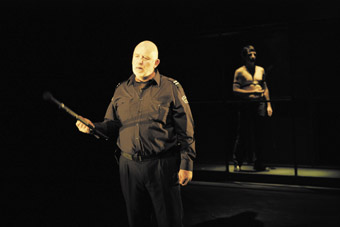
foreground Merfyn Owen, The Inhabited Man
photo Jeff Busby
foreground Merfyn Owen, The Inhabited Man
THE BOX IS A POTENT ORGANISATIONAL STRUCTURE IN RICHARD MURPHET’S THEATRE. CUBES, WHOSE INTERSTICES FORM AN AMBIGUOUS ENCLOSURE AROUND A CHARGED SPACE OF EMOTION, LIGHT AND SET, FREQUENTLY REPLACE METAPHORS AS JUNCTURES BETWEEN FORM AND MEANING, BETWEEN WHAT IS REPRESENTED BY THE PROJECTED FILMS AND WORDS WHICH MOVE ACROSS AND WITHIN THESE REALMS, AND WHAT THEY MIGHT ALLUDE TO WITHIN THE PIECE ITSELF OR IN THE OUTSIDE WORLD. THE BOX IMPLODES SPACE AND AFFECT INWARDS, AND EXPLODES THEM OUTWARDS, PRODUCING HERE AND IN PREVIOUS SHOWS A KIND OF NESTED, OVERDETERMINED PSYCHIC “HABITATION.”
Reviewer Alison Croggon, more concerned with textual cohesion than myself, found the dramaturgical links within Inhabited Man difficult to read or to relate to specific positions on war, terror or Vietnam. It seems to me though that it is this model of the theatre as a series of inhabited boxes which provides the logic for Murphet’s oeuvre. Inhabited Man revolves around the psyche, memories, fantasies, desires and fears of Vietnam-veteran-turned-security-guard, Leo (Merfyn Owen)—himself a composite of mechanism (cane, artificial leg), flesh (his painful stomach and bowels) and voice (song, groan and a gargling, sing-song monologue). Although the text is rich in political and psychoanalytic readings of the battle scarred psyche, it is this motif of disturbing habitation that organises the piece. Just as Owen’s songs, his increasingly straining, operatic monologues inhabit a stage construct wrought from two adjacent cubes—the almost Bauhaus looking architectural frame which serves as the motel room number 7 Leo observes, and the cube of white light within which he rests—so the warrior subject is figured here as inhabited, disjointed, a kind of haunted house of memories and horrors. These habitations trace their way through his ghastly visions of Vietnam (notably a key traumatic memory of pulling the head from a boy’s body caught in mud) to those of childhood (a twinned memory of the mother pulling tapeworms from Leo’s anus).
The point is that, as historians of the psyche like Klaus Theweleit have asserted, although specific psychological defence mechanisms and their disordered, traumatised forms arise within specific conflicts—Vietnam, World War II, the “War on Terror”—they are not unique to these, nor can they be attributed to these conflicts alone. Vietnam was a novel battlefront in terms of how closely white Australians had to deal with an Asian population which included allies and enemies. This confusion of friend and foe, and the unconscious racial fears and horrors which they could unleash, finds its origins in the very constitution of the Western human subject, and not in the wars themselves. Like Theweleit, Murphet sees this figure’s status today as the product of a failure of paternalism (Leo’s own father is significantly absent, while his own inability to father is writ large) and of maternalism (mothering becomes associated with horror, muck and self-mutilation). The inhabitants of room 7 seem to offer a transcendence of this state through technology—to become cyborg—but here too the masculine habitant ends by using technology to blow his body into abject, fleshy remnants which recall Leo’s own missing leg.
Leo’s subjectivity has only apparent boundaries, its spaces, lights and sounds (including a wonderful, bassy score) exceeding and layering the boxes which inhabit the stage. In the same way the problems of how to heal individuals and society, of how to construct a human who would not be subject to these horrific urges and patterns, lies beyond Leo and indeed the theatre itself. Inhabited Man is a dense, beautiful yet traumatising dramaturgical essay.
–
Rear Window Ensemble, The Inhabited Man, text, co-direction Richard Murphet, co-direction, performers Leisa Shelton, Merfyn Owen, design Ryan Russell, sound Jethro Woodward, lighting Jen Hector, performers: Merfyn Owen, Adam Pierzchalski; Arts Centre Melbourne, Full Tilt, July 15-26
RealTime issue #87 Oct-Nov 2008 pg. 8
© Jonathan Marshall; for permission to reproduce apply to realtime@realtimearts.net
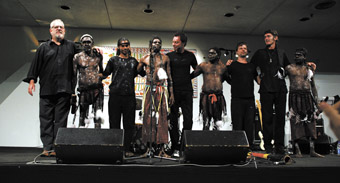
Crossing Roper Bar, Australian Art Orchestra, Wagilak Gujarra and Nyilapapidgi musicians of Ngukurr
photo Bohdan Warchomij
Crossing Roper Bar, Australian Art Orchestra, Wagilak Gujarra and Nyilapapidgi musicians of Ngukurr
A BRIEF VISIT TO DARWIN ALLOWED US TO ENJOY A SMALL PART OF MALCOLM BLAYLOCK’S FINAL DARWIN FESTIVAL PROGRAM. IT INCLUDED THE 25TH TELSTRA NATIONAL ABORIGINAL AND TORRES STRAIT ISLANDER ART AWARDS EXHIBITION AT THE MUSEUM AND ART GALLERY OF THE NORTHERN TERRITORY, A SHOW OF ASTONISHING ARTISTRY AND DIVERSITY, AND CROSSING ROPER BAR, A POWERFUL COLLABORATION BETWEEN THE AUSTRALIAN ART ORCHESTRA AND WAGILAK GUJARRA AND NYILAPAPIDGI MUSICIANS OF NGUKURR IN ARNHEM LAND ON THE ROPER RIVER.
When not isolated for several months by the flooded river during the wet season, the small town of Ngukurr can be reached by crossing Roper Bar. As the program note suggests, “the crossing over seems not only a poetic but a fitting metaphor for the collaboration…” A substantial part of AAO’s history and reputation has been built on cross-cultural collaborations—with classical Balinese artists in The Theft of Sita (1999-2002) and Indian musicians in Into the Fire (1999), both creations managing the difficult balancing act of maintaining cultural and aesthetic integrity for each of the partners but yielding something new.
The performance is staged informally on the open-air Star Shell stage in the Darwin Botanic Gardens which also provide an ideal festival venue for eating inexpensive, quality food and taking in adjoining art exhibitions, one in an old timber church (Ta Teut Amarasi/Awakening: delicate West Timor textile and print works from an Asialink sponsored workshop visit of Darwin artists to the village of Baun), the other on the whitened trunks of a grove of palm trees. The four Art Orchestra musicians (keyboards Paul Grabowksy, bass Chris Bekker, saxophones, flutes, clarinet Tony Hicks, drums Rajiv Jayaweera, guitars Stephen Magnusson) are spread wide across the stage. Centrestage are the four ceremonially attired Ngukurr men (songman Roy Wilfred, didjeridu man David Wilfred, songman Benjamin Wilfred, dancer Johnston Hall, although their roles sometimes interchange, while only one does most of the dancing).
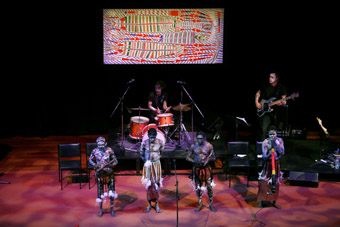
rossing Roper Bar, Australian Art Orchestra, Wagilak Gujarra and Nyilapapidgi musicians of Ngukurr
photo Bohdan Warchomij
rossing Roper Bar, Australian Art Orchestra, Wagilak Gujarra and Nyilapapidgi musicians of Ngukurr
The first part of Crossing Roper Bar emerges from a slowly escalating, disjointed sonic field generated by the band and joined by Aboriginal singing, screaming sax, raw electric guitar and didjeridu. It’s hard to pick the shape until a sudden pause after which the clap sticks palpably set the rhythm and the cultural disparity of the nervy opening—hardcore jazz and traditional Indigenous song—suddenly dissolves and the musics roll together and inexorably on, ending with a plangent sax line.
Between the collaborative pieces Ruby Hunter joins the band, her rich mezzo duetting with the warbling sax of Tony Hicks who plays with the ease and fluency of Wayne Shorter’s dialogues with Joni Mitchell. Hunter chats with the audience about her songs—one about basket weaving and spirit fish, the other about her empathy for her Aboriginal sisters in prison (“each day it’s real/ I know how you feel”). Less certain are the sources of the Ngukurr men’s songs—we learn about them later.
The second Crossing Roper Bar improvisation delivers the beautiful entwining of the two songman voices, one a higher tenor than the other, and another busy collaborative amalgam riding on a wave of rise and fall to which is added a big, surprising collective cry from all the Ngukurr men, a soaring sax solo and the first of the dances from Johnston Hall, executed dextrously within the space of a few steps.
Hunter returns to sing of a childhood living on the streets in Adelaide. Here she abandons her trademark vibrato for long held notes (juxtaposed with a supple quickfire saxophone) and a soaring, emotional chorus.
Prior to the final improvisations, Benjamin Wilfred tells us about the death of a man he greatly admired and learned much from, his grandfather, Sambo Barra Barra, a noted visual artist, “a pioneer.” Of the collaboration with the Australian Art Orchestra, he says, “We mix and I like it.” This time the pulse and the drive of the piece seems to come primarily from the Ngukurr men, with the two voices rising over dense instrumental textures and dramatically, and effectively, in and out of synch. Benjamin Wilfred takes over the didjeridu and David Wilfred joins the dancing. No one seems quite sure when the music is going to stop as each apparent close becomes just a pause before the return to a collective powering on, carrying us with it as one.
The confidence of the final stages of the performance contrasts with the tentativeness of the earlier pieces where the complexities of the collaboration seemed more apparent in the careful watching and subtle signalling between all the musicians, not least in the large number of eyes trained on Grabowsky who kept his gestures minimal. The music seemed to flow more easily when the Art Orchestra took its cue from the Indigenous artists. There was something less comfortable about the Ngukurr men waiting to place themselves in the flux of the jazz idiom. But, then again, why not, it’s a two-way street and there’s more to this than meets my naive ear. Later, at a public forum, Grabowksy tells us that “(the Indigenous artists) are in the driver’s seat.” I long for the CD if there is to be one. Certainly I might have better assimilated the meeting of two complex musical systems had Hunter performed her songs first with the Crossing Roper Bar pieces then presented consecutively. But this was a wonderful cultural event, ecstatically received by its fully engaged audience.
At the Northern Territory State Library, Genevieve Campbell (who organised a project with Tiwi women of Bathurst Island called We Sing Songs performed at last year’s Darwin Festival and more recently at the Sydney Opera House Studio) facilitated a conversation with the AAO’s Paul Grabowsky and producer Tos Mahoney of Perth’s Tura New Music. TNM arranged the tour of Crossing Roper Bar from Darwin to Perth via eight towns in the Northern Territory and Western Australia.
Grabowsky spoke about the idea of setting his orchestra apart from others by deciding it would be a group of improvising musicians as opposed to interpreters of composed music. Written music, says Grabowsky, is “like a street directory. It’s not the music. Music happens when people play music.” The interest for the orchestra was to be in process, what instruments can do, how to make them work in the moment and (as in all good improvisation) how to evolve structures. He said the same applies to good storytelling and he’s interested in that relationship too, aptly for a collaboration with a culture where the distinction between music and telling does not exist. Of The Theft of Sita, Grabowsky said that working with classical Balinese musicians the tuning was the opposite of Western instruments. “We were working with a clangorous resonance as opposed to a euphonious paradigm.” As a result, the AAO musicians came to love “out of tune-ness.” Working with master musicians of Southern India, he said, they were challenged by the complex rhythmic structures of the music, but took those on too to great effect.
When he first met the Ngukurr musicians, Grabowksy thought he would try to make a connection by telling them how he’d just come from working with black musicians in New York. “Oh, I’ve been to New York”, said the youngest of the songmen. He was amazed at the songmen’s pitch control—”they sing in microtones.” He thinks the lead songman, Roy Wilfred, “one of the best singers in the country.’
Grabowsky explained that Crossing Roper Bar comprises a cycle of songs that includes welcomes and farewells, songs pertaining to certain birds, to the wind, and one concerning a wild man walking through his land, singing the land. He described the songs as powerful, adding that working with Indigenous musicians involves trying to grasp complex cultural notions such as “singing into being”, “singing of ancestors”, “singing of place”, like multiple parallel universes. The songmen insisted that the AAO musicians learn some of their language, study and learn the traditional song cycle, and “be ready to be told off if out of line.”
Speaking of the challenges of the collaboration, Grabowsky said that the 2007 version of Crossing Roper Bar for the Queensland Music Festival involved female dancers but proved unwieldy. It was felt that clarity was important: “The project is both strong and fragile. It could easily go off the rails. It has to be treated like a newborn baby. Right now, it’s keeping us up late.”
Paul Grabowsky is passionate about the need for white Australians to connect with and learn from Indigenous Australians: “Engage in whatever ways you can. Indigenous people carry the solution to all the problems we’re experiencing with the land right now, what to do about the water and so on. Music is just a metaphor for this conversation.”
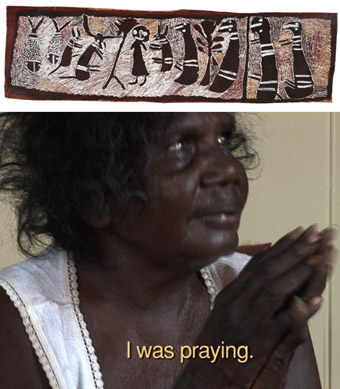
Incident at Mutpi, 1975, Nyapanyapa Yunupingu, bark painting and video still
incident at mutpi, 1975
Amidst the various winners in the 25th Telstra National Aboriginal and Torres Strait Islander Art Award exhibition at the Museum and Art Gallery of the Northern Territory was Nyapanyapa Yunupingu, sister of painter Gulumbu and musician and leader Galarrwuy, for her work Incident at Mutpi, 1975. She won the Wandjuk Marika 3D Memorial Award. It’s an intimate work in a corner in a gallery room otherwise populated with epic visions of the land. The work is in two parts. A bark painting narrating the artist’s goring by a buffalo in 1975 hangs above a video screen on which Yunupingu speaks in vivid detail about the experience to a local gathering whom we can’t see and to whom she sometimes cantankerously takes exception: “It’s not funny.” At the end we hear one of the listeners exhort her to “Tell the story shorter.”
The video is engagingly and amusingly frank and the beautiful, contemplative painting is purportedly the first from north-east Arnhem Land to use a bark to tell a private story. The video is titled Gatapangawuy Dhawu—Buffalo Story, and was shot by The Mulka Project, Yirrkala’s new multimedia studio (Buku-Larrnggay Mulka Centre). The effect of the juxtaposition of traditional art and modern media for the Incident at Mutpi, 1975 is at once simple and complex, like Crossing Roper Bar, vividly accessible at one level, rich in suggestion and cultural possibilities at another.
–
Darwin Festival: Tura New Music, Crossing Roper Bar, Australian Art Orchestra, Wagilak Gujarra and Nyilapapidgi musicians of Ngukurr, Darwin Festival, Star Shell, Botanic Gardens, Aug 17; 25th Telstra National Aboriginal and Torres Strait Islander Art Awards, Museum and Art Gallery of the Northern Territory, Darwin, Aug 15-Oct 26
RealTime issue #87 Oct-Nov 2008 pg. 10
© Keith Gallasch & Virginia Baxter; for permission to reproduce apply to realtime@realtimearts.net
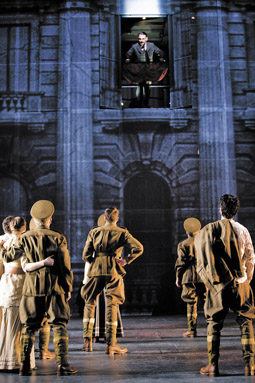
Gallipoli
photo Brett Boardman
Gallipoli
NIGEL JAMIESON’S GALLIPOLI BEGINS, APPROPRIATELY ENOUGH, WITH A DRILL. THE MASSED COMPANY, 35 ACTORS STRONG, ENTER IN KHAKI AND STAND CRISPLY BEFORE US. A SERGEANT SHOUTS THEM THROUGH THEIR FORMAL PACES—STANDING AT ATTENTION, BRINGING RIFLES TO BEAR, PRESENTING ARMS. LIKE ALL OF THE PHYSICAL SEQUENCES THROUGHOUT GALLIPOLI (MOVEMENT DIRECTOR GAVIN ROBBINS), THIS IS A WELL-EXECUTED PERFORMANCE, A FINE DEMONSTRATION OF THE SKILLS AND COMMITMENT OF THE STC ACTORS COMPANY AUGMENTED BY THE THIRD-YEAR ACTORS FROM NIDA. THEY BEGIN TO MARCH OFFSTAGE, AND IMMEDIATELY THE DYING BEGINS.
Gallipoli has many highlights, including a history lesson about the start of World War I that plays the complex configuring of alliances as an ever-escalating comic vaudeville. The company powerfully outlines the War Precautions Act (1914), which outlawed any negative reportage of Australia’s role in the conflict. A nurse recounts the visceral horror of the woefully inadequate hospital ship, struggling and failing to treat 8,000 wounded with only 350 beds. In moments like these, Gallipoli excels.
As a whole however, the work struggles for focus. Attempting, in a seemingly endless succession of short scenes, to offer multiple perspectives on the conflict and draw attention to the complexity of the story and its mythologising, the effect over its almost three-hour duration is numbing rather than illuminating. Spreading the narrative web extremely widely, Gallipoli fails to follow any perspective closely enough to effectively shape the work’s drama. The sole exception to this is the story of General Sir Ian Hamilton, engagingly portrayed by John Gaden, whose journey is traced from a recall from retirement to commanding the assault, to being removed from command as the primary scapegoat for the failure of the campaign. Despite initial misgivings, especially about the resources allocated him, Hamilton becomes increasingly excited by the challenge of the campaign, convincing himself and his staff that despite all of their limited resources, untested tactics, adverse circumstances and non-existent battlefield intelligence, the battle will be a glorious endeavour. “Before us lies an adventure, an adventure unparalleled in modern war”, he declares to a general staff briefing on the eve of the landing. It’s a clearly self-deluded position, but nonetheless Gaden’s Hamilton is a remarkably sympathetic figure, and Gallipoli feels stronger whenever he appears.
Thankless in comparison is the role of war correspondent and later war official historian Charles Bean, effectively portrayed by Luke Mullins. Initially instructed to produce reportage that was in fact propaganda, to help sell the war at home by delivering good stories of heroic Australian forces in action, Bean wrestles at various moments with the stupidities and horrors he witnesses, and the compromises he is forced to make in order to sanitise the slaughter for domestic consumption. At times it feels as if Bean is supposed to be the primary narrator, but his frequent absences from the stage make this untenable.
Strangely, the hero of the piece arrives in the last half hour in the form of Sir Keith Murdoch (Eden Falk), the man who, according to his son, “may not have always told the truth, but changed the course of history.” The narrative white knight Murdoch bursts onto the stage in a beige suit, a dynamic figure cutting through the official secrecy around the campaign and publicly naming the disaster for what it is. His letter to both the Australian and British Prime Ministers has immediate impact, with General Hamilton recalled and the surviving forces evacuated from the peninsula. After a couple of hours witnessing Charles Bean reluctantly self-censoring his reportage to comply with the will of the State, Murdoch’s demonstration of the power of the radically independent press is striking.
The technical skills of the creative team are aptly displayed throughout Gallipoli, especially the evocative video (Antonia Fredman), highly adaptive design (Brad Clark, Alexandra Sommer and Nigel Jamieson), and daring aerial work (rigger Finton Mahony). Nevertheless, it feels like most of the content of this Gallipoli has been told too many times, demonstrating what former US Secretary of Defence Donald Rumsfeld once described as “the known knowns.” In approaching this complex, multi-faceted national story, Jamieson has tried to tell too much, and the sheer mass of material precludes deep analysis. If perhaps an hour of material were stripped away, including many of the music hall interludes and frequently repeated songs scattered throughout the performance, Gallipoli would be a thrillingly visceral experience. As it stands however, it’s a meandering, yet artfully realised spectacle, the first draft of a significant theatrical work.
Sydney Theatre Company, Gallipoli, writer, director, co-designer Nigel Jamieson, performers STC Actors Company, Third Year NIDA Acting Students, designers Brad Clarke, Alexandra Sommer, lightingTrudy Dalgleish, composer, musical director Alan John, sound designer Steve Francis, video Artist Antonia Fredman, movement director Gavin Robbins; Sydney Theatre, 30 July-23
RealTime issue #87 Oct-Nov 2008 pg. 12
© David Williams; for permission to reproduce apply to realtime@realtimearts.net
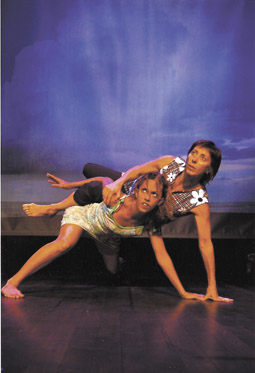
Samantha Chalmers, Nicola Fearn, Tracy
photo Fiona Morrison
Samantha Chalmers, Nicola Fearn, Tracy
CYCLONE TRACY WAS AUSTRALIA’S WORST NATURAL DISASTER, A NATIONAL SHOCK THAT HAS NEVER BEEN FORGOTTEN. IT VIRTUALLY ERADICATED AN ENTIRE CITY AND DESTROYED MANY LIVES. WOVEN FROM THREADS OF STORYTELLING, MOVEMENT, MUSIC, EXQUISITE PUPPETRY AND MASK, SARAH CATHCART AND NICOLA FEARN’S TRACY IS AN INTRICATE TAPESTRY IN WHICH EACH PANEL REVEALS A NEW EPISODE IN THE INTERTWINING LIVES OF TWO VERY DIFFERENT WOMEN. FOR REASONS AS CONTRASTING AS IT IS POSSIBLE TO IMAGINE, BOTH FIND THEMSELVES IN DARWIN ON CHRISTMAS EVE 1974, CELEBRATING WITH THEIR FAMILIES IN THEIR HOMES AND CHURCHES AS, OUT ON THE DARK SEA, A SMALL BUT INTENSE CYCLONE TURNS TO RIP THE HEART OUT OF THEIR CITY.
Based on research amongst cyclone survivors and some autobiographical detail, Tracy focusses more on the personal than the apocalyptic. The cyclone gets its moment, the drama eloquently and elegantly relayed through lyrical movement, text and the manipulation of a model house. However, it is the human stories that give this intimate presentation its power.
The story of Yanyuwa woman, Aunty Hilda Muir, a respected Territory writer, provides half the play’s material. Related by her granddaughter, dynamic actor and dancer Samantha Chalmers, Hilda’s story begins near the Gulf community of Borroloola where she is born to a Yanyuwa woman and an unknown white father. When there’s a murder on Vanderlin Island, the authorities take the opportunity to remove Hilda from her community and send her to Darwin. The journey is described with a sense of wonder and ironic humour—the horse ride to Mataranka, the 500km train ride to Darwin in cattle trucks and finally being left, lonely and starving, in the Kahlin Compound, a dormitory for Stolen Generation children.
This quintessentially Australian story is juxtaposed with that of Nicola Fearn, Tracy’s co- writer and the co-performer in this two-hander. Born in England and raised in a country mansion, Fearn flees England with her mother after her family is declared bankrupt. At the age of 15, she finds herself in Australia where “grown men wear shorts!” and it is here, after a stint in Tennant Creek, that she too takes her place in Darwin as the cyclone nears.
The contrasting of these two stories is undoubtedly the most successful dramaturgical element of this work, possibly best demonstrated when Samantha’s story of her grandmother’s epic horse ride through Arnhem Land (led by a policeman towards captivity) is set against Fearn’s exhilarating first experience of leaping her pony over fields and hedgerows in an English county hunt. That these two people should a short time later share the destructive violence of a Darwin cyclone is both a marvellous example of life’s inconsistencies and a stirring theatrical moment.
The arrival of Cyclone Tracy and the devastation that ensues provides an extremely moving sequence of scenes. Given the power of this central narrative, the subplot involving a more recent cyclone, Monica, is a distracting addition, throwing up one of the challenges of drawing material from one’s own life—what to keep; what to discard.
The complementary skills and energies of the two actors make for compelling viewing. Under the precise, creative direction of Sarah Cathcart, Chalmers and Fearn have developed a synergy that tangibly fills the stage. The earthy humour and perceptiveness of Fearn’s narration perfectly balances the lyricism of Chalmer’s almost danced style of delivery.
While a more thoughtful and perhaps poetic approach to the text would have been welcome, this is finely crafted and textured theatre. This is obvious from the very first moments of the play where puppetry and maskwork alternate—both exquisitely precise, both filled with artistry. The one puppet in Tracy represents the child Hilda in moments of silent anguish, often manipulated by both performers at once and with such delicacy that it becomes truly life-like.
Designed simply and with touring in mind by Louise McCarthy and sensitively lit by Brad Voss, the production is supported by an evocative soundtrack composed by Kim Baston. This production has already successfully toured, as part of the innovative Theatre to the Edge program, to Cairns, Townsville and Mackay, as well as to Alice Springs and country venues throughout the Northern Territory. The show is accessible and humorous; it’s heartfelt but reinforced with the narrative strength of human experience. Cyclone Tracy has passed into the national psyche. This show, which tells the story behind the tragedy, will have resonances for Australians everywhere.
–
Business Unusual Theatre/Darwin Theatre Company, Tracy, writers Sarah Cathcart, Nicola Fearn with stories by Yanyuwa woman, Hilda Muir, director Sarah Cathcart, performers Nicola Fearn, Samantha Chalmers, design Louise McCarthy, dramaturg Hannie Rayson, composer Kim Baston, puppet direction Nicola Fearn, lighting Brad Voss; Brown’s Mart Theatre, Darwin, May 28-June 8
RealTime issue #87 Oct-Nov 2008 pg. 12
© Sandra Thibodeaux; for permission to reproduce apply to realtime@realtimearts.net
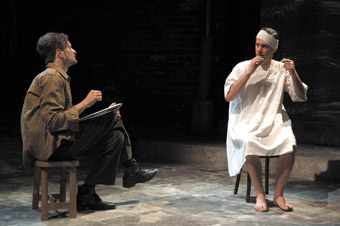
Brendan Ewing, Thomas Papathanassiou, Portraits of Modern Evil
photo Gary Marsh
Brendan Ewing, Thomas Papathanassiou, Portraits of Modern Evil
THE MURDERS COMMITTED BY EDDIE LEONSKI—A US SERVICEMAN STATIONED IN MELBOURNE DURING WWII—INSPIRED THE MOVIE DEATH OF A SOLDIER (1985). WHILE THE ANTIPODEAN EXPRESSIONISTS’ SEXUAL PECADILLOS (ALBERT TUCKER, JOY HESTER, ET AL) HAVE RECEIVED BIOGRAPHICAL TREATMENTS,THEIR LIVES AT HEIDE FARM WITH PATRONS JOHN AND SUNDAY REED HAVE NOT PREVIOUSLY BEEN FICTIONALISED. ROBERT REID’S PLAY INVENTS AN ENCOUNTER BETWEEN LEONSKI, TUCKER AND THE LATTER’S THEN-WIFE HESTER (WHO SOON AFTER LEFT HIM AND THEIR CHILD) TO EXPLORE TUCKER’S FAMOUS IMAGES OF MODERN EVIL SERIES (1943-47).
As biographers like Janine Burke have found, the lives of Tucker and his circle were so melodramatic and widely commented upon (Tucker too abandoned his son to the Reeds, the hapless Sweeney later taking his own life) that the ego and psyche of these larger than life characters threatens to eclipse their output—especially given that Tucker and Hester described their paintings as expressions of their individualised perspectives on the world and society.
The fervid energies of wartime Melbourne were so intense, so overdetermined, so overwhelming and dynamically seductive that one empathises with Tucker for being agog in the face of such social and sexual turbulence, attracted by shafts of vivid green light shearing through a wartime metropolis alive with sojourning American soldiers desperate for a last touch of flesh; by the sight of local women partying with them as if their mortality depended on it; staring at those clawed, groping hands and rounded buttocks, and wondering if Tucker and his emasculated compatriots were right and that the whole city was engulfed by whoring. Or did everyone—Tucker included—simply crave the warmth of another body before youth, modernity or conflict ended it all?
The playwright faces a similar conundrum, veering between offering a thriller, an analysis of Tucker’s scarred, often misogynist psyche, or an abstract musing on war, sex, and the attraction of a world where everything has become, like Tucker’s paint, ‘stuff,’ meat, flesh, contact and ultimately deathly. The closing scene in which Leonski is about to escort an unconscious Tucker and a vulnerable Hester through the darkened streets draws the play into the realm of thriller, only to conclude there. Similarly the detail, taken from court records, that Leonski wanted to steal the voices of those he killed, is a false lead since the murderer’s psyche is only touched upon.
Given these narrative inconsistencies, the production is most effective when Tucker and the murdered women act as a poetic chorus. The language is especially apt here. Materials, objects, smells and perceptions are enumerated, yet their significance or what brings them together in terms of meaning or morality is left unspoken. Reid perhaps draws on other wartime commentators like Louis-Ferdinand Céline or Georges Bataille who render a world view aflame with the richness of base materials, colours, objects, forms and furs, but which sees in this meaningless litany of gorgeous “muck” (Céline’s preferred term) a terrifying loss of social cohesion, meaning and ethics; of a world reduced to one damn thing after another in which humans are no more important than the stuff of the soil or of the city. From reading Céline—an anti-Semite and sometime fascist collaborator—we know where this perspective can lead.
Reid offers his own critique in the penultimate scene where the deranged, provoked Tucker spews forth repressed vituperations against women and their sexuality for becoming complicit with this social condition, and eventually contemplates murder himself. As Janine Burke recently suggested to me, Tucker’s strength is as much in how explicit he is about his intense ambivalence towards women and sex, as it is in the formal qualities of his paintings. Like Céline, Tucker rarely hid behind social graces, his oeuvre making clear his love and lust for women, as well as his rages against them.
Director Adam Mitchell’s decision to project details from Tucker’s paintings onto the flanking corridors down which the chorus languidly strolls is particularly astute. The piece is as much about the texture of things as it is about the overblown lives of the Heide circle. Details like the rough, red bricks, the stained corrugated iron, and the frosted back window evoke that sensorial experience of a bleeding, partying city—Tucker’s greatest achievement. Reid and Mitchell combine this with more dramatic content than to my taste. The scene in which Tucker describes the wounds he painted during his brief military service in Mildura is a compelling moment in which these two strands—the dramaturgical and the sensorial—meld. With polishing, this production deserves to tour.
Black Swan HotBed Ensemble, Portraits Of Modern Evil, writer Robert Reid, director Adam Mitchell, performers Brendan Ewing, Ben Russell, Anita Erceg, Thomas Papathanassiou, Amanda Woodhams, Jo Morris, designer Brad Reid, lighting Andrew Earle, sound Kingsley Reeve, projection Sohan Hayes; PICA, Perth, Sept 4-20
RealTime issue #87 Oct-Nov 2008 pg. 14
© Jonathan Marshall; for permission to reproduce apply to realtime@realtimearts.net
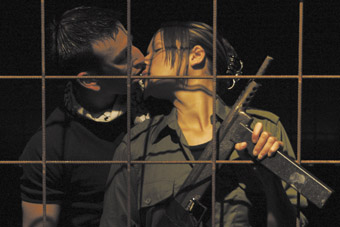
Charles Billeh, Cassandra Swab, Checkpoint Zero
photo Assad Abdi
Charles Billeh, Cassandra Swab, Checkpoint Zero
THE INVITATION TO CHECKPOINT ZERO SOUNDS PROMISING. SIDETRACK’S LATEST PLAY TELLS THE “STORY OF THE EFFECTS OF CONFLICT ON CURRENT GENERATIONS AND THE DILEMMAS INVOLVED IN INHERITING THE WOUNDS FROM THE PAST.” THIS LATTER PHRASE IS PARTICULARLY SUGGESTIVE—HOW DOES ONE INHERIT A WOUND?—AND IT REMINDS ME OF FILM THEORIST AND HISTORIAN KAJA SILVERMAN’S CLAIM THAT “TO REMEMBER OTHER PEOPLE’S MEMORIES IS TO BE WOUNDED BY THEIR WOUNDS…IT IS TO LET THEIR STRUGGLES, THEIR PASSIONS, THEIR PASTS, RESONATE WITHIN ONE’S OWN PAST AND PRESENT, AND DESTABILISE THEM.”
Checkpoint Zero, then, promises to create a sort of Silvermanian space, where we can remember other people’s memories, be wounded by their wounds and be destabilised by the past. More specifically, the play invites us into the Palestinian past and present and in doing so promises to “shatter the perceptions of one of the world’s longest lasting conflicts.”
The play begins with two Israeli soldiers, Yoram (Dritan Arbana) and Benny (Eddie Khalil), standing behind a vast wire screen, manning their checkpoint. They boast about gang raping a 13-year-old Palestinian girl for a week. They also enjoy a good curfew, which they consider “a licence to terrorise the terrorists”, and enforce it with the attitude of “zero tolerance, maximum security, maximum fun.” While this opening scene works to make the play’s sympathies abundantly clear, it also risks immediately alienating the audience because these characters seem to have no redeeming features whatsoever.
Working at the same checkpoint is another, more reluctant soldier, Sivan (Cassandra Swaby). The monotony and brutality of the checkpoint routine are effectively portrayed as the Palestinians circle around and around, displaying their hands as their identity cards. When the overzealous Yoram pulls Hani (Charles Billeh) aside and interrogates him for several hours, Sivan takes pity and gives him a Mars Bar. Something sparks and the next time Hani comes through the checkpoint there is some rather laboured flirting—“They don’t call me the Mars Bar princess for nothing,” she breathes—numbers are exchanged and a star-crossed love story ensues. Many of these scenes are played to the front, presumably in an effort to position the audience as confidante. Unfortunately this undermines the intense connection the lovers are supposed to share. Two interactions at the checkpoint and a brief encounter on the dance floor are apparently enough for Hani to declare love. Inevitably, Sivan finds it all too much and the two separate.
Thankfully, the story is more interesting and the staging more inventive away from the romance. The idiocy of bureaucracy is nicely conveyed when a Palestinian mother confronts an officious Israeli secretary only to be winched above the stage in order to literally “hang in there” while waiting. There is another striking moment when all three women scale the fence to frame their faces in the wire squares and Assad Abdi’s giddy video projections work to evoke a world off balance and out of kilter. The performances of Siliva Entcheva and Olivia Stambouliah are particularly strong in these scenes: the former plays a slightly tarty singer (delivering some soaring songs), an Israeli Lieutenant, and Hani’s mother while the latter portrays a Palestinian girl, an Israeli mother, and Hani’s grandmother. This last character is later revealed to have been Jewish before marrying her husband and converting to Islam. This revelation prompts the previously hesitant Sivan to see the humanity in Hani, the possibility of a future together, and the two are reunited.
In this way, Hani’s alterity is easily recovered and the play reveals itself as deeply conservative, despite its claims to the contrary. Far from “shatter[ing] the perceptions of the world’s longest lasting conflict”, Checkpoint Zero risks reinforcing them because neither the narrative nor the characters within it are sufficiently nuanced. None of the characters emerge as complicated, conflicted human beings and the Israeli soldiers come close to caricature. Moreover, the story depends on the female soldier to mobilise compassion and imagines a heterosexual couple and their future family unit as a metonym for the single-state solution. Even within its own limited terms, the play cannot in fact imagine a future for them and ends Hamlet-style with bodies strewn about the stage.
While part of the problem lies with the romantic storyline (the rest of the play has potential), another part lies with the expectations encouraged by the publicity. In vowing to investigate inherited wounds and to shatter perceptions, Checkpoint Zero simply promises more than it, or any other play for that matter, could possibly deliver.
Checkpoint Zero, conceived by Assad Abdi and Don Mamouney, writer and director Don Mamouney, cast Dritan Arbana, Charles Billeh, Silvia Entcheva, Eddie Khalil, Olivia Stambouliah, Cassandra Swaby, lighting design Jocelyn Speight, video projection design Assad Abdi, costume design Sue Liolio, set and sound design Don Mamouney; Sidetrack, July 28-Aug 24
RealTime issue #87 Oct-Nov 2008 pg. 14
© Caroline Wake; for permission to reproduce apply to realtime@realtimearts.net
THE NOTION OF ‘CHARACTER’ IS LIKE A PROPERTY TITLE HANDED DOWN OVER HUNDREDS OF GENERATIONS, THE ORIGINAL DEED NOW LOST AND ITS BOUNDARIES, DIMENSIONS, OWNERSHIP RIGHTS AND DUTIES OF CARE TANGLED AND UNCLEAR. EVERY PERFORMANCE MAKER MUST FACE THIS MONUMENTAL INHERITANCE AT SOME POINT, AND ASK “HOW THE HELL AM I SUPPOSED TO SORT THIS MESS OUT?”
Postmodern performance often negotiates this tricky terrain in intriguing ways. Three recent Melbourne premieres exemplify the range of responses—and their attendant problems—that can be found in the wider artistic shifts of the past few decades. In one, irony and excess are used to push character over the brink of significance; in another, the concept of the consistent, ‘closed’ character is replaced by the character as a process of becoming; and in the third, the distinction between character, performer and audience becomes a pivotal dynamic.
The character as ‘type’ has a long history, from Greek comedy through commedia dell’arte to French satire to modernist drama. The individual may represent a social, psychological or cultural type—but it is this notion of character as representation, as an instance of an essential class, that is called into question in Meow Meow’s Vamp. In her first full-length work the already legendary cabaret artiste has sought to problematise the character of the titular vamp, the femme fatale, the lethal seductress, the desirable, threatening woman. This questioning, however, is accomplished not through an explicit distance but through a perilous closeness—Meow Meow becomes the vamp so perfectly, in all of her historical forms, that the figure is drained of substance, rendered a hollow goddess.
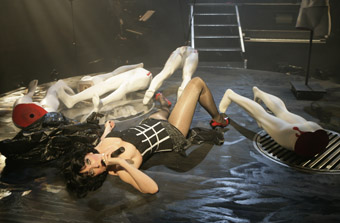
Meow Meow, Vamp
photo Jeff Busby
Meow Meow, Vamp
vamp
As a performer, Meow Meow is undoubtedly a star, with an astonishing vocal range and a powerful command over her audience. But Vamp is all masquerade—Meow Meow tries on characters like costumes, from Salome to Louise Brooks’ Lulu, borrowing songs along the way, snippets of text stolen from all over, the gestures of generations of chanteuses. This magpie approach is, itself, a pilfered costume, and the form of Vamp as well as its content is recognisable from both drag acts and the most hallowed of pomo pastiche. Meow Meow pushes it to the limit, though, and the density of allusion here gradually begins to suggest that Meow Meow herself is nothing more than her disguises—remove the mask and there would be no face underneath. This is reinforced by the mannequins and doll parts which appear throughout the performance, and her final number—a melancholy, quiet version of Radiohead’s “Fake Plastic Trees”—brings it all home. Meow Meow is the copy that destroys the original.
the antechamber
The characters of Tony Reck’s The Antechamber are less immediately recognisable. They inhabit a kind of uncannily rendered Aussie noir netherworld with a distinctly David Lynch ambience, in which interior psychology and exterior reality are hopelessly indistinguishable. There’s a narrative of sorts—a flower-shop assistant and part-time drug dealer is visited by an old (yet strangely young) flame; the domineering shop proprietor seems to control him while also being under his control; the ex’s sinister new beau later brings the threat of violence into an already charged atmosphere. At no point can we trust any of these characters—not simply in the sense of ascertaining motive, but of even expecting a temporal consistency. They occasionally slip into types, but only just. Most of the time they are foggy, amorphous identities whose only definition is found in their interactions with each other and given the constantly shifting relationships, this too becomes untenable.
The performers here don’t seem to have fully realised the ambition of this open-ended work, either over- or underplaying things throughout. This is, of course, a difficult assertion to make, since the notion of getting it ‘right’ or ‘wrong’ is undermined by the very piece itself. In fact, to get it right—in a conventional, realist way—would perhaps render it obsolete. But as it stands, this difficult, somewhat dissatisfying production is as much in the process of becoming as its subjects.
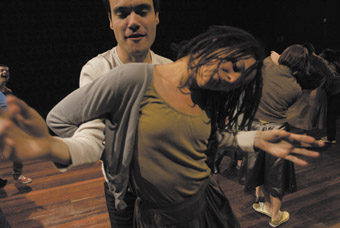
Clem Baad, Jay Kimber, The Heart of Another is a Dark Forest, Rawcus Theatre and Restless Dance Theatre
photo Paul Dunn
Clem Baad, Jay Kimber, The Heart of Another is a Dark Forest, Rawcus Theatre and Restless Dance Theatre
the heart of another is a dark forest
The Heart of Another is a Dark Forest explicitly takes on the issue of whether we can truly know another—at every level, it raises fascinating and provocative questions regarding performance, character and spectatorship. It’s the first collaboration between Melbourne’s Rawcus Theatre and Adelaide’s Restless Dance Theatre, both companies working with performers with and without disabilities.
As the title suggests, this is a work that tackles otherness—familiarity and difference, the space of encounter, the revelation and secrecy. It’s an abstracted, physically oriented piece with no discernible narrative arc, though there are frequent shifts of pacing and mood.
I’ve not experienced works by Restless before, but Rawcus’ previous productions have always struck me immensely with an intense, almost unique experience of presence. ‘Acting’ and ‘character’ depend on a kind of absence, a sense of an identity which is not the performer’s—hence the getting-it-right-or-wrong argument. Restless and Rawcus performers occupy a different space. Confronted by the physical liveness of a performer with disability, one is made more aware of the presence of the moving, sometimes speaking person rather than the more transcendent elsewhere of a character. There may be a sense of voyeurism at work, but this is something both companies play with, and nowhere more so than in this new collaboration.
The Heart of Another is a Dark Forest is a largely solemn, moody piece, as opposed to the lush playfulness of Rawcus’ last two works. Where Hunger (2007, see RT82, p8) and Not Dead Yet (2005) were revelatory in the way they allowed access into the interior worlds and experiences of their performers, this new work more consciously teases its audience by withholding information. What we choose not to reveal to others is as important as what we do: thus, we here find secret thoughts spoken anonymously, dancers turning their backs to the audience, text spoken in ways that are difficult to understand. This is a challenging, but thought provoking process: while I found the spontaneity and exuberance of Hunger, for instance, to be far more enjoyable, this work is an important reminder of the right of the performer—disabled or otherwise—to be something more than an exhibit for our curiosity.
There are some beautifully accomplished dance sequences: one especially in which partners provide arms for each other in a scene of massed duets that produces a wonderful sense of bodily communication. The power dynamics shift between each dancer and these shifts become the sequence’s expression. In another scene, a whisper passed down through a line of performers creates a real sense of hilarity as they react with genuine surprise to the phrase they hear. Whether, of course, this is just acting, is precisely the point. One walks away from this work wondering if we can ever know another’s truth, or if our ‘real’ self is in fact produced through the searching.
Malthouse, Vamp, by Meow Meow and Iain Grandage, performer Meow Meow with the Orchestra of Wild Dogs, director Michael Kantor, musical director Iain Grandage, designer Anna Tregloan, lighting design Paul Jackson, dramaturgy Maryanne Lynch, choreography Shaun Parker, CUB Malthouse Theatre, Sept 6-20; The Antechamber, writer, director Tony Reck, performers Phil Motherwell, Nada Cordasic, Wilfred Last, Jane Lundmark, sound Hugo Race, lighting Andre Conate, La Mama Theatre, Sept 17-Oct 5; Melbourne Fringe Festival: Rawcus Theatre and Restless Dance Theatre, The Heart of Another is a Dark Forest, directors Kate Sulan, Ingrid Voorendt, design Emily Barrie, costume Esther Hayes, lighting Richard Vabre, composition/sound design Zoe Barry, Jethro Woodward, performers Steven Ajzenberg, Clement Baade, Ray Drew, Rachel Edward, Nilgun Guven, Valerie Hawkes, Paul Mately, Mike McEvoy, Kerryn Poke, Louise Riisik, John Tonso, James Bull, Jianna Georgiou, Lorcan Hopper, Alice Kearvall, Jay Kimber, Kyra Kimpton, Dana Nance, Andrew Pandos, Anastasia Retallack, Stuart Scott, Lachlan Tetlow-Stuart, Bonnie Williams, Dancehouse, Melbourne, September 24-27
RealTime issue #87 Oct-Nov 2008 pg. 15
© John Bailey; for permission to reproduce apply to realtime@realtimearts.net
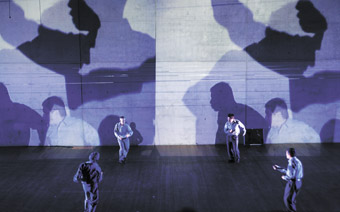
Gravity Reseach Institute, The Bland Project
photo Mayu Kanamori
Gravity Reseach Institute, The Bland Project
THERE’S NOTHING LIKE THE PLEASURE OF THEATRE THAT CONSUMES YOU AS YOU DEVOUR IT. ALAN SCHACHER’S THE BLAND PROJECT AT PERFORMANCE SPACE AND THE BARRIE KOSKY-TOM WRIGHT THE TROJAN WOMEN FOR THE SYDNEY THEATRE COMPANY WERE SUCH EXPERIENCES. I’M STILL DIGESTING THE DEMANDINGTROJAN WOMEN EXPERIENCE AS WE GO TO PRESS (READ ABOUT IT IN REALTIME 88), BUT THE BLAND PROJECT HAS BEEN PRETTY MUCH ABSORBED, SAVE FOR A DESIRE TO SEE IT AGAIN AND INGEST MORE.
the bland project
There was always a defining architectonic quality to the work of the performance company Gravity Feed, a way of working with materials to generate unusual, immersive spaces of scale—dark-suited men dancing with and manipulating door-proportioned slabs of timber into stark forms in In the House of Skin (1996) at Performance Space, the massive mobile three-metre high cardboard walls creating the spaces inhabited by performers and audience in Host (1999) in St George’s Hall, the huge metal framed red scrims constantly reconfigured around the audience in Tabernacle (1999) on the roof of a suburban carpark. But more than a mutable architecture or a living installation, was the suggestion of a potentially sacred space, of something being worked through by a silent team of men, somehow representing, containing, keeping us safe in ominous circumstances, and then releasing us.
Working as Gravity Research Institute with a range of collaborators, Gravity Feed mainstay Alan Schacher has now created The Bland Project, this time at Performance Space in CarriageWorks with four performers and an architecture created largely by video projection and mobile screens. As ever, the architecture is constantly reconfigured but this time more evanescently as images are multiplied and magnified over much of the high, long wall of the space or writ smaller as the screens travel, suspended from wires tracked from rigs each end of the space. Much of the lighting too emanates from the rigs. Again there’s the sense of a special place with its own shifting parameters and mobility, the screens largely appearing to move of their own volition.
The Bland Project too has the feel of occasion, ritual perhaps, as the bland unanimity of the four men mutates into something distinctively other over the performance’s contemplative duration. Of the same height, roughly similar build and clothing—plain shirt and trousers—the men greet us at the entrance to the theatre. They gesture as one for us to enter. In the theatre, close to the audience, hangs a large screen on which the men continue to gesture. We have time to take them in. And as the performance evolves we will look at them more and more, in greater detail, in the flesh, life size and larger on the mobile screens, huge on the wall, reading them as Asian and Caucasian, young, old, until we feel we know every feature, line, mole, chest hair (a surprising moment when this becomes an epic abstraction), a twisted nipple (writ large, intense) but never expression. The faces are masks, even when the body of each in solo moments is vibrated or racked by who knows what emotion.
Initially the men act as one. Soon they break into pairs in almost slow motion circlings. They travel with the screens, matching up with their own images. Later they will hold other screens before them as if asking us to check for correspondences. But there is one distinctive break from this massive exercise in the testing of the art of portraiture: moments when the men as one and individually seek comfort or refuge or sanctity (appearing like monks) in dark blankets that screen them from the eye of the relentless camera.
Although these enigmatic men remain in some ways bland throughout, by the end of the performance they have, through sheer physical expressiveness, through their wrought solos and instances of separation and panic, been revealed as individual, not least by the amount of attention we have paid every image of them in Sean Bacon and Michelle Mahrer’s magical mix of real time video and film. The patternings of images and their tonal texturing are bracingly pleasurable, with Sydney Bouhaniche’s swathes of light subtly transforming the space and in perfect balance with the projections.
As in any production associated with Alan Schacher there is a curious beauty about its totality; here it defies the very notion of blandness. It’s as if Schacher has looked at it and said, let’s rigorously sustain this blandness and subject it to every possible scrutiny and see what’s left—four distinctive men and an unforgettable experience rich in detail and a sense of reprieve for anyone ever labelled colourless in an age of excess like our own. The Bland Project deserves a very big audience. They will happily recognise this preoccupation with looking and estimation: after all, with the the revival of mass popular photography brought on by digitisation, never have so many been photographed so much.
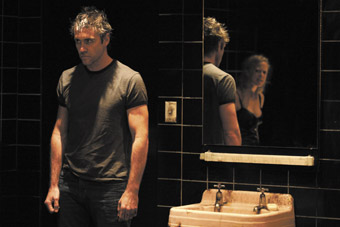
Jack Finsterer, Anna Lise Phillips, Don’t Say The Words
don’t say the words
Don’t Say the Words belongs to the theatre of the floating signifier, kin to the Theatre of the Absurd and Harold Pinter’s oeuvre. Tom Holloway’s contemporary take on Clytemnestra’s murder of King Agamemnon at the end of the Trojan War has unnamed characters, an un-labelled war, a desire for vengeance for an unspecified cruelty, a murder that might not have happened or is possibly imminent, and an insistence by the soldier husband, his wife and her lover to only refer to husband and lover in the third person. While the wife admits to the murder in the first act and urges it in the penultimate scene, the men are circumspect, their quickfire quizzing of the wife oscillating between interrogation, rationalisation and rigging the narrative.
This floating world is earthed however by Holloway’s brisk, terse, highly rhythmic dialogue, replete with the violence of constant interruption and contradiction, and by hard-edged performances from Jack Finsterer, Anna Lise Phillips and Brett Stiller, all three on top of the considerable demands of the playwright’s language and director Matthew Lutton’s relentless pacing. Adam Gardnir’s meticulously realised, overtly filthy bathroom set, with its freshly applied grafitti and overflowing basin that later floods the stage, corresponds with the abject state of affairs in which the characters find themselves.
The most suspenseful and grimly funny scene is the play’s centrepiece and the one where the males are ultimately at their most evasive, and abject. The ‘war hero’, who doesn’t feel like one, and his cousin (the presumed lover) spar verbally in a bar, like old mates, testing the limits. The cousin calculatedly recalls his desire for his mate’s wife in days gone by. He pushes harder. He’s heard of a husband who maltreats his lovely wife. He directly accuses his mate of forcing anal sex on his wife while calling her by the cousin’s name: “I mean if ya wanna fuck me, mate…All you had to do was bloody—.” He admits he’s just winding up his mate, “just havin’ a lend, mate”, but is it the truth, or at least what the wife has told her lover in order to justify her infidelity? We expect violence, but the husband backs off: “Fuck this. They still got that Karaoke machine round here somewhere?…I feel like a fucking sing.”
Don’t Say The Words is an intriguing chamber piece, tautly constructed (only the wife’s solo account of the killing to an invisible detective fails to fit) and a brilliant exercise in expert dialogue writing. Although it was certainly hard to nail down all those floating signifiers and not leave the theatre without the suspicion that you weren’t taking away much more than sheer theatrical virtuosity, Holloway and Lutton managed to pull a large, fascinated audience with this brief, driven, interval-less puzzle that had something to say about the construction, in speech, of evasion and fabulation. There are words you just don’t say. It’s good to see Griffin, true to form, supporting an emerging talent like Holloway (writer of Beyond the Neck, RT82, p35) in partnership with the Tasmanian Theatre Company.
the trojan women, briefly
As we go to press, I’m just now recovering from seeing the Barrie Kosky-Tom Wright The Trojan Women for the Sydney Theatre Company, one of the most harrowing and unrelenting theatrical if grimly rewarding experiences of recent times, superbly performed by Robyn Nevin and Melita Jurisic, a trio of actor singers and an acutely engaged accompanying pianist. In a number of ways The Trojan Women is exemplary music theatre, intoned and sung. It’s a brief work, but the pain it conveys opens up a small eternity. In the same week I saw Adelaide’s The Border Project, also at the STC, do their Rock’n’Roll Highway Disaster, a kind of personalised rock concert as music theatre, dextrously realised in song, video and animation by a multi-skilled company. More later.
Gravity Research Institute, The Bland Project, director Alan Schacher, performers Ryuichi Fujimura, Teik-Kim Pok, Ari Ehrlich, Philip Mills, design Alan Schacher, Sean Bacon, video Sean Bacon, film Michelle Mahrer, composer, musician Boris Baberkoff, lighting Sydney Bouhaniche, moving screen system Russell Emerson; Performance Space, Sydney, CarriageWorks, Aug 7-9; Griffin Theatre Company, Tasmanian Theatre Company, Don’t Say The Words, writer Tom Holloway, director Matthew Lutton, performers Jack Finsterer, Anna Lise Phillips, Brett Stiller, designer Adam Gardnir, lighting Paul Jackson, dramaturg Peter Matheson, composer, sound Kelly Ryall; The Stables, July 4-26
RealTime issue #87 Oct-Nov 2008 pg. 16
© Keith Gallasch; for permission to reproduce apply to realtime@realtimearts.net
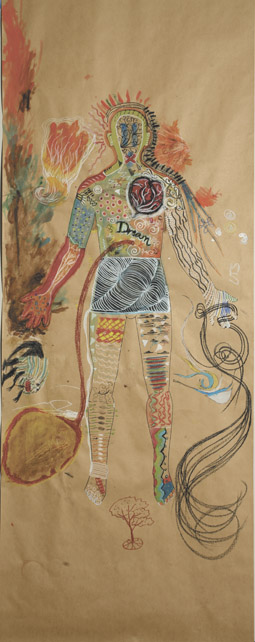
The Heart Library Project, George Khut with Caitlin Newton-Broad, Greg Turner and David Morris-Oliveros
photo Julia Charles
The Heart Library Project, George Khut with Caitlin Newton-Broad, Greg Turner and David Morris-Oliveros
Audiences are increasingly becoming the subjects of artworks, participants in them, even co-makers. Our cover image is from Simon Terrill’s epic photographic series Crowd Theory (page 49); this time the artist invited a community to collaboratively respond to the Port of Melbourne. In The Heart Library Project (p34), George Khut invited his audience to have their heartbeats translated into seductive, manipulable digital imagery, but also, with his collaborators, offered the opportunity to reflect on and share the experience through drawing and dialogue. Jordana Maisie’s The Real Thing (p33) is a giant kaleidoscope in which the viewer is magically fragmented and gloriously rearranged. Babel Swarm (p36) invites the public into Second Life, providing an avatar and the opportunity to convert spoken or texted words into the tumbling letters of a strange ecosystem. The beauty of Keith Armstrong’s Shifting Intimacies (p33) is only realised when the actions of audience members manipulate a digitised dancer. And, for a different kind of engagement, Pool, the ABC’s new online site for the sharing and re-use of digital art (p37), abounds with opportunities for artists and public to engage. Meanwhile in Hobart, in a work about labour and contemplation, and free of digital transmutation, Philippa Steele advertised free clothes washing for gallery-goers (p54), a quieter form of participation, but without which… RT
Image note: An example of an experience-map created by exhibition participants (Hope Lover, Ruby Jones and Scarlet Jones) in response to their experience in The Heart Library – Biofeedback Mirror, April 2008, UTS Gallery, NSW, and subsequently exhibited as part of Mirror States exhibition, Campbelltown Arts Centre, 2008 (curated by Lizzie Muller and Kathy Cleland) see page 34-35.
RealTime issue #87 Oct-Nov 2008 pg. 1
© RealTime ; for permission to reproduce apply to realtime@realtimearts.net
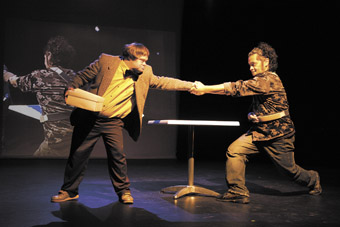
David Guhl, Sete Tele, Get Downers
photo Bohdan Warchomij
David Guhl, Sete Tele, Get Downers
THE IMPORTANCE OF THE CURATOR IS AMPLY DEMONSTRATED BY RECENT EXHIBITIONS LIKE FREMANTLE ARTS CENTRE’S BON SCOTT PROJECT OR PICA’S OLD SKOOL SHOW. IN EACH CASE THE CURATORS TAKE OTHERWISE UNDISTINGUISHED WORKS, ORGANISING THEM INTO SOMETHING MORE THAN THE SUM OF THEIR PARTS TO FUNCTION AS A COLLECTIVE, MULTIFACETED EXPERIENCE. UNFORTUNATELY, PERTH SEEMS INDIFFERENT TO THE VALUE OF SUCH CRITICAL FRAMINGS. STATE FUNDING APPEARS TO FAVOUR THE SPLASHY, GENERALISED LIKES OF THE CITY OF PERTH AND BANKWEST PRIZES.
I was hoping that PICA’s shaggy dog of an annual mini-festival of live art, Putting On An Act, would return with some kind of shape. Alas, 2008 was possibly even less coherent than 2006. While under-rehearsed student premieres from local universities and colleges were thankfully less evident, they were replaced by non-professional community groups like the Scarborough yoga school. Although established as a home for that amorphous scion of performance art and the happening, “live art”, Putting On An Act doubles as a community outreach program—a role for which it is neither designed nor suited. Consequently, all audiences, irrespective of taste, are subjected to material they loathe. Supporters contend this enlarges spectator horizons. Yet these same supporters complain of enduring some ‘horrible’ piece or feigning a seizure as a reasonable excuse to depart. The utopian ideal behind the formula is failing and its continued employment is an embarrassment.
There is no shortage of alternative models. Andrew Ryan and John Kaye recently established Perth’s shambolic Kabaret Dada. Generically focussed around music- or sound-based live art, these loud, insane mixed bills work remarkably well. At a minimum, Putting On An Act’s devisors should centre each evening around genres, offering audiences a sympathetic guide and the chance that a genuine conversation might arise. The current formula recalls the cacophonous asocial behaviour at the Tower of Babel, everyone shouting internal monologues while ignoring the discourse around them.
Given the lack of vision, it is unsurprising that much of Putting On An Act was amateurish or of little interest beyond friends and family (who make up much of the audience). This is unfortunate for works which rise above parochialism to comment on the forms they deploy. Clyde McGill for example, performed a fine miniature, entering a largely darkened stage, his head obscured in a black hood, placing four rusted, spring-loaded animal traps in pools of light. His idiosyncratic method of setting them, using plastic pull-ties, produced an engaging symphony of close miked crackles, squeaks and metallic echoes in this simple but suggestive piece. Cat Hope has been performing serious bass guitar noise for years, most recently with improvisatory quartet Abe Sada. Here she collaborated with Chris Cobilis as The Plateau Of Screaming Popes. The pair played a monstrous sounding collection of frets and guitars lying on tables, with Cobilis adding computer processing. As the title suggests, the aim is to generate something fairly static yet with detail and movement scratched across the surface of an intense sensorial subwoofer ocean. The Plateau’s reprise at the Perth leg of Liquid Architecture was even more impressive, with Cobilis experimenting by dragging his table backwards and forwards, causing a chaotic, gargantuan waxing and waning of noise.
The real masterwork of Putting On An Act was the collaboration of dance-makers Sete Tele and Rachel Ogle with the Get Downers company. They have been working together for some months to the point where this group of performers with Down syndrome now plays at a professional level with a recognisable range of dramaturgical approaches and choreographed material. Taking their lead from dance theatre (notably Pina Bausch), the performers offer a series of solo portraits. What is striking about these is that each is highly individualised, designed to reveal the dancer’s tastes. One dancer continuously executes cartwheels with a fabulous nuancing of degrees of bravery before each tumble and an idiosyncratic, jarring straight-legged approach that becomes attractively brutal as repeated.
At the same time it is evident that the performers are also sketching crafted fictions of themselves. This produces an instability around these actions as ‘authentic’ and phantasmatic depictions of selfhood. Two of the female performers play with different degrees of seductiveness—in one case melded with a consciously affectionate naivety, performing to the strains of a mumbled German rendition of Falling In Love Again—while a male dancer mixes elements of Michael Jackson’s lightness and aggressive yet tongue-in-cheek hip-hop. Tele himself was injured, his arm in a sling, yet his solo remained a lesson in how limits can generate beauty. His floppy, slinking, one-handed game with limbs spoke wonderfully to the work as whole, before he joined his colleagues in a closing free-for-all. One hopes Putting On An Act 2009 will be programmed so that such gems shine rather than sinking amidst amorphous dross.
–
Putting On An Act 2008, PICA, Perth, July 22–26
RealTime issue #87 Oct-Nov 2008 pg. 18
© Jonathan Marshall; for permission to reproduce apply to realtime@realtimearts.net
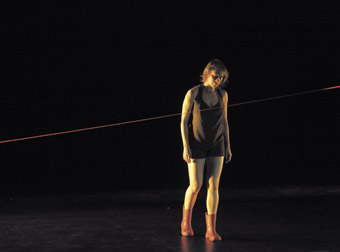
Peter Fraser, Tarkovsky’s Horse
photo Mayu Kanamori
Peter Fraser, Tarkovsky’s Horse
BODYWEATHER DISTILS TIME. AS A PRACTICE, IT WORKS TO OPEN THE LINE OF CONSCIOUSNESS BETWEEN PERFORMER AND PLACE. IN ITS TRAINING METHODS, PLACE AND BODY BECOME MUTUALLY ALIVE: THE BODY STARTS TO ‘CHANNEL’ A PLACE WHILE PLACE IS INHABITING, AND BREATHING THROUGH, THE BODY. WHEN REFINED FOR PERFORMANCE, BODYWEATHER [A PRACTICE INITIATED BY JAPAN’S MIN TANAKA] BUILDS A STAGE POETICS OUT OF RECALLING EMBODIED ENVIRONMENTS. WHILE THE TRICK SEEMS TO SIT IN THE PERFORMER’S ABILITY TO USE, BUT ALSO TRANSCEND, PURELY INTERNAL STATES, SUCH PERFORMANCES OFTEN FOCALISE THE MINUTIAE OF EXISTENCE ITSELF: THE EDGE OF AN ELBOW, TWO CONCAVE FEET, A PAIR OF EYES LOOKING OUTWARDS THEN INWARDS THEN OUTWARDS AGAIN. STILLNESS. SLOWNESS. PERCEPTIVITY.
In Borderlines (Linda Luke), the body charts a path of slow awakening. Beginning flattened in darkness, this body takes at least 10 minutes to stand itself upright. Slithers of light (designer Travis Hodgson) help us to read this slowly clambering, half-flaccid body, by plotting small rectangles that gradually grow in dimension across the space and skin. Are these peepholes—is this a game between us and performer? Or are these metaphors of a body broken? (Half-hidden, the body doesn’t seem to comprehend itself as a complete form.) Or do we simply see an image of night breaking, dawn being drawn inwards through blinds, a stiff morning caterpillar body shuddering towards yet another day?
In its abstraction Borderlines plays structurally with the body in regimented space. The dimensions of the body are plotted in movements that grow in rhythmic and spatial ascension. Small twitches indicate a kind of paralysis. Soon, this rigidity is softened with the extension of limbs and the slow illumination of a tense red borderline (a diagonal cord) within the space. Luke dresses in red gumboots to play out a motif of childhood hopscotch—a game of boundaries that is repeated when she is entangled with elasticised cord in a dance of frustration: there is little release when it finally snaps unhinged across the room. Meantime, her shadows have been flapping, enlarged, on the sidelines—monstrous dopplegangers of an inner self wanting to break free.
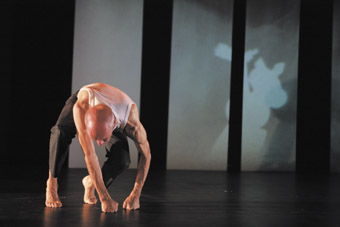
Linda Luke, Borderlines
photo Mayu Kanamori
Linda Luke, Borderlines
In Tarkovsky’s Horse (Peter Fraser), moments of theatricality undercut the intensity of pure bodyweather action. Walking on invisible gridlines, this body is loose at the joints, its head wobbling in somnambulant reverie. Punctuating the piece with nostalgia, Fraser is framed by a scratchy projection of grasslands (video Sam James). As an homage to Russian film director Andrei Tarkovsky, this body seems immersed in the texture of film itself. Tarkovsky was well known for his long takes and scenographies of childhood beauty. Such themes of re-birth and reminiscence appear when Fraser takes on the guise of a newborn foal—clumsy, clambering on all fours, but trying to ambulate. There is some relief in this image: it is readable beyond mere internality. Other motifs likewise serve to break the abstraction of form—a rehearsed laugh and steady recorded audience applause; moments of looking at us, his watchers.
Both Borderlines and Tarkovsky’s Horse rely on sound composition (and Tarkovsky’s Horse also on video) to explicate the textures that performer bodies present. Michael Toisuta works live with Linda Luke to embellish the halogen hums, clock ticking and pop-flutey tones of rhythmic modernity with dulled screeches of electro-acoustic feedback. This improvised score of extended and manipulated strings amplifies a world that is at once haunting and exciting: the body is poised in a place of curiously warm isolation. In Tarkovsky’s Horse, Natasha Anderson uses the echolalia of computerised bubbles to evoke a mindstate of nostalgic lightness. The bubbles fizz, pop and turn into a gurgling percussive rumble that is overwhelmed by a loose viola slipping and sliding down chords.
Borderlines and Tarkovsky’s Horse offer visions of bodies in tension with their environments. For Luke this is a stiff, geometric tension placed against an unlocatable backdrop. For Fraser, this is an almost romanticised tension between the body and its sense of a former wholeness. We sense it longs to climb back into some warm womb. Both Luke and Fraser draw a murky line between the training practices undergone as part of the research for these works and the craft in (re)performing the works themselves. In this, they depict an internalised focus that is at once commendable and alienating, creating a performance state that is compelling, if difficult to puncture.
The Weather Exchange, Borderlines, performer Linda Luke, sound composition Michael Toisuta, lighting Travis Hodgson; Tarkovsky’s Horse, performer Peter Fraser, sound composition Natasha Anderson, video design Sam James, lighting Travis Hodgson; Campbelltown Arts Centre, Sydney, Aug 21, 22
RealTime issue #87 Oct-Nov 2008 pg. 20
© Bryoni Trezise; for permission to reproduce apply to realtime@realtimearts.net
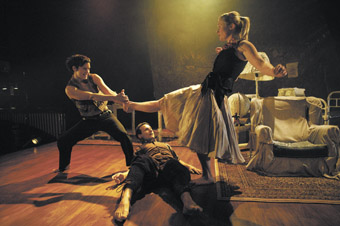
Alexandra Harrison, Anton, Ingrid Kleinig, Bubble
photo Lisa Tomasetti
Alexandra Harrison, Anton, Ingrid Kleinig, Bubble
BUBBLE PRESENTS THREE UNNAMED CHARACTERS (ANTON, ALEXANDRA HARRISON, AND INGRID KLEINIG) TRAPPED IN A MILDLY CLAUSTROPHOBIC DOMESTIC SPACE, EACH JUST HANGING OUT. THE SPACE IS CLUTTERED WITH AN ARMCHAIR, A BED, TABLE AND CHAIR, AN OLD SUITCASE UNDER THE TABLE, RUGS ON THE FLOOR AND A CRINKLY PAPER-COVERED WALL UPSTAGE. IT IS UNCLEAR WHAT THE RELATIONSHIP BETWEEN THE CHARACTERS IS, OTHER THAN THEIR BEING FORCED TO SHARE THIS SPACE. THROUGH SOME UNSPOKEN AGREEMENT, THEY DECIDE TO PLAY A GAME, AND CHASE EACH OTHER AROUND THE ROOM. THIS GAME ENDED, THEY TRY TO TALK, BUT RATHER THAN COMMUNICATING THEY EACH SPEAK OVER THE TOP OF EACH OTHER. WE CAN’T UNDERSTAND THEM, AND PRESUMABLY, THEY ARE ALSO UNABLE OR UNWILLING TO UNDERSTAND EACH OTHER. THE LIGHTS GO OUT.
When the lights restore, our protagonists have discovered more of their bubble world. A package has arrived, and ownership becomes contested, escalating into a physical struggle that spills out over the furniture. Other objects emerge—a letter opener, a stapler, a red texta, a wrestler figurine and a goldfish bowl. Each are brought into the realm of play, put to imaginative re-use in the endless struggles for position that form the basis of much of the choreography, becoming the focus for childish destructive rages, power plays and petty victories. The red texta is used to playfully threaten violence, drawn across the throat of its ‘victim.’ The wrestler figurine acts as a surrogate for its wielder, strutting and smashing objects in its path. The goldfish bowl is worn like a helmet, becoming another bubble layer.
It’s clear that for the characters of Bubble life is elsewhere, and this elsewhere appears as punctures in the surface of the bubble world—a book that when opened shows the light and sound of distant worlds; a hole torn in the upstage paper wall that allows the bright light of outside to shine through. These worlds outside are probably far more disorderly, more dangerous and presumably more interesting, but this bubble world seems strangely resilient, impervious. In this sense, Bubble could be a dance reworking of Sartre’s No Exit. Despite the clear desire to depart, our protagonists seem unable to recognise or exploit any potential escape routes, stuck instead in small variations on fixed patterns of behaviour. Even when all of the onstage furniture magically bundles together and rises into the air, leaving the performers to dance beneath the levitating detritus, there is little change in the interpersonal dynamic, it’s merely an opportunity to dance slightly more freely in the reconfigured space.
The tone stays mildly bleak, slightly melancholy. Despite the skill of the makers, and all the energy expended, Bubble never gets beyond fatalism. A film sequence played late in the performance seems to underscore this—modern life is depressing and alienating, but there’s no escape from it. It’s well-trodden thematic ground, and despite the physical inventiveness of the performers, Bubble offers no new perspective.
Legs on the Wall, Bubble, director Rowan Marchingo, performers, co-devisors Anton, Alexandra Harrison, Ingrid Kleinig, dramaturgy Wesley Enoch, set design Dan Potra, design associate, costume design Lucas Edge, lighting Trudy Dalgeish, Christopher Snape, composer, sound designer Carl Polke, film Judd Overton, Rowan Marchingo; The Studio, Sydney Opera House, July 23-Aug 2
RealTime issue #87 Oct-Nov 2008 pg. 20
© David Williams; for permission to reproduce apply to realtime@realtimearts.net
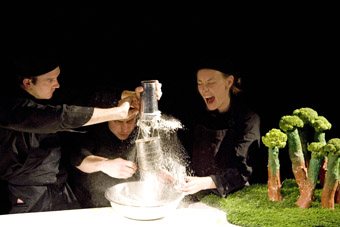
Men of Steel
photo Prudence Upton
Men of Steel
MANAGING AND PRODUCING SERVICES (MAPS) IS THE AUSTRALIA COUNCIL FOR THE ARTS’ NEW INITIATIVE FOR INDEPENDENT THEATRE AND DANCE ARTISTS. IT IS OPERATIONAL IN VICTORIA, WESTERN AUSTRALIA AND QUEENSLAND AS A PARTNERSHIP BETWEEN THE THEATRE AND DANCE BOARDS OF THE AUSTRALIA COUNCIL AND RESPECTIVE STATE GOVERNMENT FUNDING BODIES. MAPS SEEKS TO CREATE AN ALTERNATIVE SUPPORT STRUCTURE TO THE TRADITIONAL COMPANY MODEL.
I spoke with John Baylis, Director of the Theatre Board at the Australia Council about the background to the initiative. He said, “In 2006 I began a discussion within the Theatre Board and with the wider sector about new approaches to theatre funding. Under the name Make It New a number of papers were circulated and forums held, culminating in changes this year to our funding strategies. The aim is to generate more dynamism in the theatre sector by encouraging more connectedness between independent groups, larger producing companies and the broader presenting infrastructure, and by creating new pathways for fresh companies to emerge. One strategy has been to support independent producers directly, and we ran a pilot project two years ago which offered $50,000 per annum for two years to four successful applicants: Marguerite Pepper Productions, Strut & Fret, Keep Breathing and Arts Projects Australia.”
The aim for MAPS is simple, Baylis says, “Artists get the support to plan a future without having to create their own administrative and producing platform. It is one of a number of strategies that we have started in order to create a middle way for artists, a place between the freedom but terrible uncertainties of project-to-project existence, and the relative security but deadening administrative burden of funded small company life. The new funds last year presented a once-in-a-decade opportunity to think about new infrastructure—light infrastructure.”
Baylis went on to explain how research into international models influenced the creation of the brief for MAPS. “Arts Admin in London is the logical reference point and I had a good conversation with co-founder Judith Knight. She expressed doubts about whether Arts Admin could serve as a model for anything, emphasising that it is the passions and idiosyncrasies of the individual producers involved that determine success, not the structure itself. Jennifer McLachlan—Director of Dance at the Australia Council and my partner on this project—also brought her experience of the mixed fortunes of arts councils’ attempts to set up such structures in the UK, so we had a good sense of the risks involved. We based our final brief on a 2005 Scottish Arts Council tender.”
The Australia Council tender issued in early 2008 was won by Strut & Fret for Victoria, Performing Lines for Western Australia and a new partnership between Metro Arts and Brisbane Powerhouse for Queensland. The tender requested that producers provide a vision and list of artists whom they would support. Baylis underlines: “A basic principle of MAPS was that the producers choose the artists. We believed that producers must be passionately committed to the artists they work with, and it would not be useful for funding bodies to dictate who those artists should be. The producers themselves need to be empowered, so it was important not to conceive MAPS as a mere ‘service’ to artists, but rather as the foundation for an equal creative partnership between producer and artist.”
At the time of writing, all three organisations are yet to announce the artists they will support. In each state the set-up is different and dependent not only upon the existing independent theatre and dance culture but also upon the nature of the producers. Each has the potential to make a profound impact upon the local scene as Baylis outlines it. “The MAPS have a three-year commitment from their funding partners. They are not conceived as incubators that will produce perfectly formed micro-businesses free of subsidy. Those that work could become part of the funded theatre and dance infrastructure for the next decade and beyond.”
Strut & Fret are based in Queensland but have had a Melbourne office with five staff for the last two years. They define themselves as “a vibrant young company that produces and manages events, theatrical productions, performers and venues with a unique ‘catch-your-breath’ style.” Producer Scott Maidment says, “We are excited that this initiative both allows us to continue to work with a diverse range of performing artists we have supported over the previous 10 years, and also allows us to develop exciting new relationships with dance artists and companies who we haven’t previously worked with. Strut & Fret support a range of artistic visions and develop a wide scope of opportunities for artists. We want to create and develop futures for independent artists and continue to broaden their exposure to new audiences nationally and internationally.”
In Western Australia, the Sydney-based, but nationally funded, producers Performing Lines won the tender. Performing Lines “works from concept to production and touring. It works with artists at every stage of their careers, from emerging artists to internationally recognised names—and in many cases, plays a critical role in artists’ development. It produces or tours works presented at all levels of the Australian performing arts industry—from the contemporary arts venues comprising the Mobile States consortium to regional venues large and small, to flagship venues such as Sydney Opera House, and to all the major Australian festivals.” General Manager, Wendy Blacklock says of MAPS, ”The structure is under the umbrella of Performing Lines until it can become completely independent. This may take several years but in the interim Performing Lines manages the funds from all areas, contracts and payrolls, covers insurances, deals with superannuation, audits and acquittals, thus leaving the producers free to concentrate on improving the standard of the work, and having time to familarise themselves with national and international networks, funding possibilities and opportunities. I have put in place WA Producer Fiona de Garis and will be choosing an Associate Producer further down the track. Our brief is to choose an equal number of theatre and dance companies/independent artists, so the Associate may very well be a dance person.”
In Queensland MAPS will be jointly managed by Metro Arts, a multi-arts venue and “centre for independent practice”, and Brisbane Powerhouse, a mid-size performing arts venue. Liz Burcham, Chief Executive Officer of Metro Arts described how the project is a logical extension of the organisation’s Biz Arts Makers program and how the partnership with Powerhouse naturally complements their services to artists. Burcham says, “We want to work closer and more collaboratively with artists to enable Queensland based independent artists to be better structured to access markets and opportunities internationally and nationally. A producer will be recruited to work between the two organisations and more funding will be sought to increase that person’s opportunities to travel and extend the scope of the brief over time.”
While there are high hopes for the project and negotiations with other States and Territories continue, John Baylis cites a sobering list of potential pitfalls, including, “artists’ unrealistic expectations on what are very lean infrastructures; producers mistaking their role as creative partner for that of an artistic director; artists receiving only project-by-project support, when the real need is long-term planning and commitment; producer burnout; an unthinking imperative to grow, in the mistaken belief that to stay small is to stagnate; funding body complacency that a few MAPS entities around the country has ‘solved’ the small-to-medium infrastructure issue; and the needs of the producing organisation becoming more of a driver than the original aim—supporting artists better.”
Baylis’ describes MAPS as, “an experiment” and like all good chemistry the results are bound to be highly unpredictable.
For more on MAPS as it develops in each State: www.performinglines.org.au;
strutnfret.com; www.metroarts.com.au
RealTime issue #87 Oct-Nov 2008 pg. 21
© Sophie Travers; for permission to reproduce apply to realtime@realtimearts.net
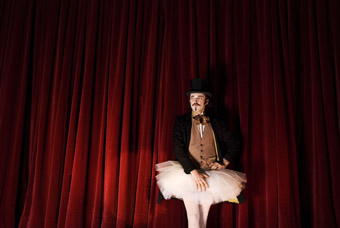
Tom Lawrence, The Masque of the Red Death, a BAC/Punchdrunk co-production
photo Stephen Dobbie
Tom Lawrence, The Masque of the Red Death, a BAC/Punchdrunk co-production
FOR 28 YEARS BATTERSEA ARTS CENTRE [BAC] HAS PLAYED A PIVOTAL ROLE IN THE DEVELOPMENT OF THEATRE IN THE UK. OCCUPYING A VICTORIAN FORMER TOWN HALL IN SOUTH WEST LONDON, THE ORGANISATION WORKS TO DELIVER A MISSION TO INVENT THE FUTURE OF THEATRE. THROUGH STRUCTURED SUPPORT PROGRAMS WE NURTURE ARTISTS AND COMPANIES IN AN ENVIRONMENT THAT ENCOURAGES EXPERIMENTATION AND RISK.
With a loyal audience playing a central role in the development of new work, we have offered a critical resource for a broad range of theatremakers for over two decades. Over that time BAC has helped nurture hundreds of companies including DV8, Improbable, Kneehigh, Complicité and more recently Punchdrunk, 1927 and Ridiculusmus. BAC’s co-production with Punchdrunk, The Masque of the Red Death—a building-wide, immersive theatrical experience—completed an eight-month sell out run in April 2008.
staying at home
In January last year after a quarter century occupying Battersea Old Town Hall, BAC was threatened with closure. Wandsworth Borough Council, our landlord and key funding partner, took the decision to withdraw financial support and levy a commercial rent on the building after decades of rent free use. While highly prized by artists, our audience and backers including the Arts Council, it looked like BAC would have to vacate its premises. A campaign was launched and the team at BAC began to look at a range of options including closure or relocation. Eighteen months on and after a campaign that included a question to Tony Blair in the House of Commons, BAC has been saved. Wandsworth Borough Council has reinstated most of the grant it threatened to cut and we have just signed a 125 year lease on the building.
This story is important for many reasons. When the prospect of alternative sites was explored it became clear that much of the success of our organisation could be traced to the relationship we have to our Victorian home. Our success as a theatre and as a developer of new work is in part rooted in the fact that the building we occupy is not a theatre but a found space. Although we do offer black box studios, many rooms are relatively unchanged from their intended use as places for public and private congregation within a municipal building. From tiny attic rooms to a Council Chamber and a grand hall, BAC presents an incredible playground for artists and companies. The success of so many performances generated by BAC is partly attributable to this architectural provocation.
renovating the house
This attitude to space is at the heart of our emerging plans for the building. In our ‘co-production’ with a brilliant team of theatre architects, we seek a series of phased solutions that will retain the ghosts of our building’s Victorian past while embracing 21st century technologies and infrastructure for artists and audiences. We have begun a process that sees the building through the eyes of theatremakers and, over the long term, will unlock the potential of a contemporary performance environment across our half-hectare site.
We want our plans to develop in the same way that great theatre emerges from the rehearsal room. Much of the work we develop starts with an idea or a theme. The productions we support are forged in the rehearsal room, often by an ensemble committed to working collaboratively. In the same way our architectural project is seen as creative process where ideas are given time to emerge, develop, breathe, flourish. While we have bold and ambitious ideas for the building we strive to keep our options open. We want to experiment with space, slowly learning how different environments might be best used across the building. We are excited by the prospect of building a ‘home’ at BAC—a space where artists, producers and staff can eat and drink together; a new model for residencies in London where we can accommodate UK and international artists. We are tapping a rich seam of new ideas through a process that is deliberately fluid, flexible, mutable. David Jubb, with whom I share BAC’s artistic directorship, calls this process “playgrounding”—a new way of improvising with space that places theatre artists and architects at the heart of the design process.
the house producers
This process draws on our experiences of a decade of ‘scratch’ at BAC. Over this period BAC has refined a model of development that has now been adopted by dozens of other arts organisations across the UK and overseas. This methodology places an artist’s work, at an early stage in its development, in front of an audience for the first time. Encouraged to provide critical feedback, the audience plays an integral role in the development of new work. The bar becomes a place for debate and conversation about the journey that emerging practice might take. The environment is supportive. Seeds are sown. Critics are banned.
Critical to this process is the role of the producer. For the last five years BAC has pioneered a particular approach to this role. Every artist and company we support is assigned a producer who slowly and skilfully brokers the emerging links between an artist or company and an audience. Armed with an understanding of the creative process of making theatre fused with an entrepreneurial zeal, BAC producers are responsible for assisting the birth of many new works every year. From our participatory work with young people to the development of world class professional theatre, it is this role that drives our program and unlocks the potential in many artists’ work.
supporting producers
And it is this role that the Arts Council in England [ACE] has over the last five years taken greater interest in. As a previous employee and one charged with leading this funder’s relationship with an emerging generation of producers I developed a series of initiatives aimed at raising the profile of and support for dynamic cultural entrepreneurs working in the arts in England.
Between 2005 and 2007 the Arts Council made a series of interventions aimed at providing a more sustainable base from which producers could work. Foremost amongst these was a scheme that provided a small coterie of independent producers with regular funding as a contribution towards operating costs. These grants were made with few strings attached with the intention of providing core support for producers working in contemporary performance, music, live literature and new media and music. In each case, and with demonstrable results that exceeded the expectations of relatively minimal investment, these producers delivered. Some attached themselves to partner organisations to access broader networks while retaining their all-important independence. Regular funding was offered on the understanding that supported producers would be able to come back to ACE for additional finances for individual projects. The piloting of support for independent producers was deemed a great success. Some of the individuals supported this way are now funded on an ongoing basis and all have punched above their weight, many making significant contributions to their artforms.
the challenge
Faced with similar challenges and a champion in John Baylis, the Australia Council developed a parallel scheme. But back in the UK in 2008 the climate is changing again and while some producers now feel on a more stable footing, all are faced with dwindling project funds. The 2012 Olympic Games raid on lottery funds is now felt across the arts and the promised access to flexible project funds is fast drying up. Many independents feel better recognised and core support has increased the sustainability of many, but a curb on project funding is beginning to bite and producers’ ability to broker the relationships between artists and audiences is slowly being curtaiiled.
case studies
The prevailing ethos of the producer is echoed in The Producers: Alchemists of the Impossible. This book, a collaboration between the Jerwood Charitable Foundation and the Arts Council, aims to shine a light on a dozen or so producers working in the arts in the UK and mainland Europe and serve as an inspiration to a new generation of cultural entrepreneurs. It offers a rich set of individual case studies and aims to capture the qualities and attributes that lie at the heart of the producing mindset. One chapter focuses on David Jubb and the unique producing vision he has brought to BAC:
I reckon my most important quality as a producer is to create a flexible space for play in which anything can happen and to keep that space open for long enough for something extraordinary to happen. That often means keeping the space open and keeping people’s confidence in the space way beyond any rational position.
It is this desire to create oxygen around the creative process that lies at the heart of the producing mission at BAC. With a fleetness of foot and a healthy attitude to risk BAC continues to give artists and audiences genuine space to play.
David Micklem is Joint Artistic Director, BAC, London, www.bac.org.uk; www.the-producers.org
RealTime issue #87 Oct-Nov 2008 pg. 22
© David Micklem; for permission to reproduce apply to realtime@realtimearts.net
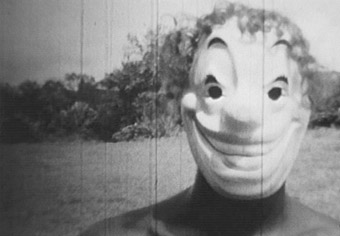
Daumë, Ben Russell
ONE OF THE INTERESTING THINGS ABOUT THE MELBOURNE INTERNATIONAL FILM FESTIVAL IS THE ‘PARALLEL WORLD’ EFFECT. THE FESTIVAL YOU EXPERIENCE MAY WELL BE COMPLETELY DIFFERENT FROM ANYONE ELSE’S, SO MUCH SO YOU MAY SOMETIMES WONDER IF YOU WERE AT THE SAME EVENT AT ALL. THIS YEAR, A FRIEND WAS TELLING ME ABOUT THE ENGLISH COMING-OF-AGE DRAMAS, THE IRANIAN RITES-OF-PASSAGE FILMS AND THE IRISH HUNGER STRIKE RE-ENACTMENT THAT PROVIDED HER WITH HER MOST VIVID FESTIVAL MOMENTS. I WAS TELLING HER I FELT LIKE I’D BEEN AT FILM SCHOOL, WATCHING AND LEARNING ABOUT THE ART OF GUERRILLA FILMMAKING AND HOW TO WORK ‘RIGHT OUTSIDE THE SYSTEM.’ FOR MY FESTIVAL WAS FILLED WITH GEORGE ROMERO ZOMBIE FLICKS (ROMERO BEING THE ULTIMATE MAVERICK), THE ADMIRABLE PROGRAM OF OZPLOITATION FARE (EXCAVATING IGNORED STRATA OF AUSTRALIAN FILM HISTORY), AND THE WONDERFUL ‘EXPANDED CINEMA’ WORLDS OF GUY SHERWIN, BEN RUSSELL AND BEN RIVERS.
Sherwin’s films were shown in a dedicated program at ACMI, while the two Bens shared a program; Sherwin and Russell also performed at Who is Miss Roder?, a subsidiary festival event at 45downstairs, a gallery and performance space in an old city warehouse. Over three performances, it featured the two internationals plus Australian artists in a mix of experimental cinema, performance art, sound design and video mixing. This was a great idea, enabling Sherwin and Russell to present a different side to their work, and it really added to the sense that, this year, MIFF was something different.
ben rivers
At ACMI, the best of the Ben Rivers material was Ah, Liberty!, shot on 16mm black-and-white stock, an exercise in faux ethnographic, mockumentary weirdness: feral kids in sea monster masks scavenge in rusting machinery dumps while odd scenarios play out around them—a car with no doors, for example, being driven in circles on a muddy field. Rivers projects surreal horror vibes, radiating 10 shades of uncanny, with moments of hilarity jolting you into the realm of the simply deranged. Most of his work is like this: unsettling, weird, but nonetheless conforming to its own internal logic. The overall effect is surprisingly ‘narrative’, given the lack of dialogue, the ultra-rapid editing and the warped tableaux. Another highlight was This is My Land, Rivers’ portrait of the Scottish hermit Jake Williams. Rivers’ scratchy träume style is totally suited to Williams’ self-contained, eccentric lifestyle. As he tinkers with the compost, builds bird feeders and tends his ramshackle house, Williams, in his lilting Scottish voiceover, says whatever comes into his head: an internal world that, like Rivers’ films, conforms to its own weirdly centred chronology.
guy sherwin
Sherwin has been making his miniature masterpieces since the early 1970s, building and unpeeling layers of tone, texture and grain, above all with acuity to create a shifting world of perception. A camera is affixed to the back of a bicycle wheel, simply recording the shadows from the bike as it meanders under the sun, then through a puddle of water, calmly recording the wet tyre marks which look like unravelling DNA. A cat sleeps on a roof. The film is slightly sped up. The creature is dreaming, twitching and kicking its paws into the air. Suddenly, it wakes with a start, looks around and wanders off. An elderly couple stand around laughing and joking. Between them is a mirror, which reflects Sherwin winding the crank of the box camera recording this poetic little piece. The film is silent. We watch Sherwin watching the couple who watch us watching Sherwin. These films were all shown at ACMI, where Sherwin introduced them, expressing surprise that his work was being displayed via state-of-the-art equipment. Normally, he said, his films are screened in a small bar or café type environment, where an element of performance comes into play.
Who is Miss Roder? provided that environment. Here, Sherwin presented his work in partnership with Lynn Loo. Vowels and Consonants was a piece for six projectors that screened variations on a simple, flickering font printed from computer onto acetate and then transferred to film. O’s and N’s fly into frame like amoeba under a microscope, vibrating and oscillating in response, seemingly, to the treated voices that announce their arrival; I’m sure the letters were triggering sound somehow. Sherwin and Loo manipulate the projectors to introduce fades, cuts and cross-fades matching the overlapping effect of the voice. The letters fold and bounce off each other. The overall effect is synaesthetic, like you’re actually watching sound take shape (and in fact the sound design was really something too—an ominous, post-industrial hum).
Man with Mirror was amazing, but it’s complicated to explain, let me try. Sherwin stands in the middle of the space, holding a mirror, which is painted white on the reverse side. Onto the board, the projector beams film of a younger Sherwin (from 1976) doing exactly the same. With a twist of the board, young Sherwin morphs into the older version. He turns the mirror to the reflective side, while young Sherwin turns the board over to the white side, which the real-life Sherwin is doing also. The latter then turns his board over to reveal himself, and then flips back to the mirror, which is now reflecting back to us young Sherwin in profile, the board outstretched in front of him. He turns to face us, flips the board over to the white side and we see the older Sherwin now standing in profile, holding the board in front of him. And on and on in endless variations. It’s like a form of time travel: a man disappearing into light and shadow and reappearing as a younger version of himself. It elicited ‘oohs’ and ‘aahs’ from the audience, and rightly so: the choreography was mind-bending.
ben russell
At ACMI, Ben Russell’s films included one from a static camera fixed on a wildly stuttering neon sign and another recording workers leaving a factory in Dubai: field recordings, the unblinking eye of the lens inducing subtle changes in people’s behaviour just by being there. Then there was Black and White Trypps Number Four. Russell takes a strip of 35mm film from a Richard Pryor performance and treats, warps and re-projects it, so that it folds in on itself, as does Pryor’s spiel, which pokes fun at white people and their paranoia about black people. Pryor trips on stage, the image stutters, then burns away as if caught in the projector, melting, reforming, white gaps in the film becoming black, black becoming white, until Pryor ends up leached away to a white screen, his voice slowed to a scratchy burr, and we are left to interpret the meaning: is Pryor a reverse racist? Or is Russell just having loads of fun (artistically and philosophically) with ‘black’ and ‘white’, gaining maximum mileage from minimal materials?
At Miss Roder, Russell upstaged Sherwin, screening a loop from his fake ethnographic film, Daumë, which screened in full at ACMI and is a brilliant piece of work in its own right. Again, how to describe? Young men dressed as ‘natives’ engage in strange rituals, throwing chairs at each other, punching each other randomly. The events are seen from many different angles. Black and white, flickering film. Bizarre masks and a heightened sense of surreality. It’s no wonder Russell and Rivers feel simpatico. At the performance, wearing nothing but underpants and a Church of the Subgenius mask, Russell manipulated the loop with two projectors, blurring the films together, flying by the seat of his (under)pants, improvising a pure performance of analogue dexterity (also manipulating sound via a mixing board, spewing forth granulated sheets of noise). Here, the aesthetic and philosophy of filmmaking becomes a raging, malleable, shapeshifting beast.
more magic
All the Miss Roder acts were excellent. Other highlights included Jon Pak’s performance piece The Feast, in which a small restaurant is actually set up in the space. Two actors, a man and a woman, enter. They sit down to eat, served by an impudent waiter. Their every movement is wired for ultra-amplified sound. There is a video screen upon which their images are projected, electronically treated so that they appear to be underwater. They are nervous with each other and every gesture, burp and nervous laugh is magnified painfully and uncomfortably. Steven Ball’s Personal Electronics was an absorbing study of paranoia, surveillance and the thoroughly fruity modern day phenomenon of ‘gang stalking’ (Google it, you won’t believe it), with pixelated video footage snaking around a suburb, recording people, cars, houses, neighbours, while an unhinged woman in voiceover tries to make sense of a world she thinks is out to get her. Later, Ball did a spoken word reading from similar case studies in his detached tones, while the insane pixels continued to unfurl.
I left these performances feeling divided: half inspired that so much amazing work is being done with scant resources, old media and boundless imagination, half annoyed with myself for wasting so much time watching crap film over the last few years when there’s all this to explore.
The Guy Sherwin, Ben Russell and Ben Rivers expanded cinema program
tour to the Melbourne and Brisbane International Film Festivals was curated and organised by Danni Zuvela, Joel
Stern and Sally Golding (OtherFilm).
Guy Sherwin, Ben Russell, Ben Rivers, Melbourne International Film Festival, Otherfilm, ACMI, July 30; Who is Miss Roder?, presented by MIFF, Greyspace, Otherfilm, Arts House; 45 downstairs, Melbourne, Aug 1-2
RealTime issue #87 Oct-Nov 2008 pg. 23
© Simon Sellars; for permission to reproduce apply to realtime@realtimearts.net
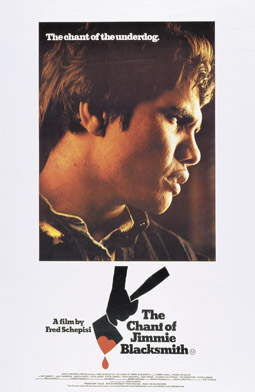
original poster for The Chant of Jimmie Blacksmith
HISTORIAN HENRY REYNOLDS MIGHT NOT BE A FILM SCHOLAR BUT HE REASSESSES FRED SCHEPISI’S THE CHANT OF JIMMIE BLACKSMITH (1978) WITH AN ATTENTIVE EYE TO VISUAL DETAIL—POINT OF VIEW, LOCATION, COSTUMING, MAKEUP AND SUNDRY TELLING INCONSISTENCIES—AND, ABOVE ALL, THE FILM’S IMAGERY AND NARRATIVE CONSTRUCTION. BUT WHAT’S MOST REVEALING IS HIS JUXTAPOSITION OF BLACKSMITH’S STORY WITH THE HISTORY OF JIMMY GOVERNOR (ON WHOM BLACKSMITH IS BASED). THE FILM, SCRIPTED BY THOMAS KENEALLY FROM HIS NOVEL, REVEALS HOW HISTORY CAN BE RADICALLY RECAST AS BASED-ON-FACT FICTION WITH, AS WE’LL SEE, UNFORTUNATE CONSEQUENCES.
Above all, Reynolds sees The Chant of Jimmie Blacksmith as an emblematically 1970s film, its makers motivated to create for Australian Aboriginals an icon, possibly a black equivalent to Ned Kelly. However, the nature of the Governor/Blacksmith crime, the axe murder of a group of white women, undercuts any sense of heroism. More problematically, the murders might well have been triggered by the racist and social indignities heaped on the Blacksmith brothers, but their impulse in book and film comes from a deep-seated savagery, a return to a primal condition. I recall teaching the novel and seeing the film at the time of its release and being disturbed by this very factor. I was not surprised at the film’s poor reception, despite some public debate about wary audiences being in a state of racist denial. As Reynolds points out, the film’s violence, reinforced by the bloodied axe which was its promotional icon, confirmed it as a film of its time, working the sex and violence theme but here in a racial context. Reynolds sees Keneally and Schepisi, like the 19th century journalists before them, as racialising the violence (as an atavistic urge), when it was more likely to have been motivated by class tension, in a man who didn’t see himself as Aboriginal.
Of course, it was a bold move by Keneally and Schepisi to attempt to engender empathy for the plight of Aboriginal people by using such a challenging story, with its excesses of provocation and response. But what Reynolds reveals, in a few pages, is the very different circumstances of Governor’s life from the film’s identification of Blacksmith as a conventional Aboriginal of the time. True to the period of the second half of the 19th century, Governor was typical of many Aboriginal men of mixed descent who assimilated to varying degrees with white society, went to school, were literate in English, had jobs or made careers for themselves and did not necessarily identify with fellow Aboriginals (nor is there evidence of Governor’s being ritually initiated as Blacksmith is in the film). Of course, all of this was to change with the introduction of the Aboriginal Protection Board in New South Wales in 1883 (removing mixed descent children from their families), the growth of forced segregation and the establishment of reserves and, in 1901, “in the new federal government…Aborigines were denied the right to vote in federal elections.” A few pertinent, educated observations aside, there is little sense in the film of Blacksmith as a man of this period.
The film’s account of Blacksmith’s post-murder bushranging (contentiously signalled as a ‘war’ on white society) is largely diverted into moral point making in an encounter with a white liberal. It pales next to Governor’s three months as an bushranger. He was an effective strategist—there were many robberies—and he was brutal—four killings, a number of woundings and a rape. Fear of his gang was widespread and a huge operation was mounted to capture him. Had the filmmakers wanted a more heroic, if still deeply problematic Blacksmith, they might have attended more closely to Governor’s history. After his capture in the film, Reynolds reminds us, a speechless Blacksmith declines into torpor (recalling a line in the novel: “a fatalism native to his blood”). Governor, however, was renownedly garrulous, “with a cocky sense of achievement, of becoming a celebrity”, and spoke keenly to journalists and his captors of his achievements. Governor, and Blacksmith, had been shot in the mouth during the capture. In the film this prevents Blacksmith from speaking. Reynolds suspects, as he tracks the loss of voice for the Aboriginals in the latter part of the film, “It’s as though Keneally and Schepisi didn’t want him to talk. It’s their story—not his.”
Reynolds also finds the values of the film confusing. If a primal urge is first seen as being at the root of the murders then the second half of the film shifts towards a suggestion that Jimmie’s problem lies in miscegenation, that he is caught between primitive life (initiation, his full-blood brother Mort) and Christian culture, but is forever at the bidding of his Aboriginality. Reynolds sees this in the contrastive skin casting of the performers, in makeup and hairstyling, in Mort’s stereotypical ‘bush native’, Jimmie’s breaking into “an apparently ‘instinctive’ tribal dance” and “[w]hen on the run, Jimmie’s initial improbable ignorance of tribal law is gradually overcome as an inherent Aboriginality breaks through…” As with the opening shot of the film, Jimmie’s intiation, so it ends, after Blacksmith’s off screen hanging, with a shot of cockatoos rising in flight—”conventional romantic pantheism”, writes Reynolds, and a further muddying of psychological and cultural cause and effect.
Reynolds asks if it’s possible to make an Aboriginal legend out of an obscure historical figure, a complex, possibly psychopathic one with white ambitions and no sense of being a warrior on behalf of his people. (As Reynolds notes, Schepisi is happy to “interpret violence as war” without “allowing Blacksmith to explain what his political objectives were.” Instead, Blacksmith howls “War” into an oddly reverberant landscape.) Reynolds suggests that if Schepisi wanted a hero, and one reasonably well known he could have looked to Jundamara of the Kimberley region and his Bunaba resistance from the same period (his life was recently dramatised by Perth’s Black Swan Theatre Company with Bunaba Films, RT84, p34 ).
Reynolds takes particular exception to the film’s cinematography, not in terms of its skill or effectiveness, but in the inspiration taken by the cinematographer Ian Baker and director Schepisi from Tom Roberts and the Heidelberg School: “…we are faced here with two quite different and competing traditions with the dialogue aspring to contemporary relevance while the cinematography looks back to the aesthetic ideals of the early 20th century”, ideals freed of Aboriginal connection to the land.
The book ends by addressing the big picture: the effect on the industry of the film’s poor reception and its place in our cultural history. Schepisi lost a quarter of a million dollars on the film and has said he “felt very guilty about its effect on the Australian film industry.” Reynolds thinks, given the filmmakers’ noble intentions, it was ironical that “the commercial failure of Schepisi’s film made it very difficult to make further films about racial issues for 10 or 20 years. It became the conventional wisdom of the film industry that films about Aborigines, and especially about racial conflict, woud never be commercially successful.” It was a long path to The Tracker, One Night the Moon, Beneath Clouds and Rabbit Proof Fence—all released in 2002, two of them by Aboriginal filmmakers.
As for the film’s standing as a work of art, Reynolds declares it “an unsatisfactory hybrid.” He says of the novel what is true of the film, “[it] takes a real historical character but invents so much that the story loses its touch with past reality. It is neither one thing or the other.” As a cultural artefact, Reynolds feels that “we learn more of the filmmaker and the writer than we do about Jimmy Governor and his brother. What we see is the way in which progressive, liberal white Australia sought to come to new understandings of the nation’s history while still encumbered by remants of discredited racial thought.”
Above all Reynold says the film tells us more about the 1970s than the 19th century. For that reason and “[de]spite the commercial failure of the film, Schepisi created scenes and images which are unforgettable and which will remain as important contributions to the intellectual and cultural history of Australia in the second half of the 20th century.” This comes somewhat as a surprise after Reynolds’ thorough and eloquently argued challenges to almost every aspect of the film. But perhaps it’s the kind of thing you’d expect of an historian, for whom the film is a fascinating document of our recent past, of issues and events which still haunt us and inhibit the well-being of Aboriginal people. Now a generation of Indigenous filmmakers are in the process of making their own feature films. What history will they tell us, and what history will they make? Reynolds’ book is another fine addition to Currency Press’ Australian Screen Classics series.
–
Henry Reynolds, Australian Screen Classics, The Chant of Jimmie Blacksmith, series editor Jane Mills, National Film & Sound Archive, Currency Press, 2008
RealTime issue #87 Oct-Nov 2008 pg. 24
© Keith Gallasch; for permission to reproduce apply to realtime@realtimearts.net
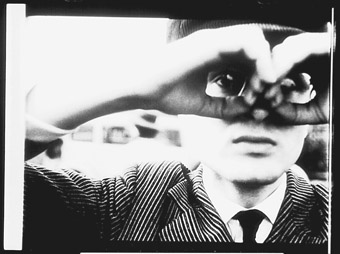
Mosaik im Vertrauen, Peter Kubelka
PETER KUBELKA’S VISIT TO AUSTRALIA WAS A GENUINE COUP FOR THE NATIONAL FILM AND SOUND ARCHIVE, WHO ORGANISED THE TRIP, AND A FABULOUS GIFT FOR CANBERRA AUDIENCES WHO GOT TO WITNESS THE WORK OF THE MAN STAN BRAKHAGE CALLED “THE WORLD’S GREATEST FILMMAKER.”
The handful of films Kubelka has made are among the most important in cinema history—their impact on avant-garde film is profound, and few who make work which explores flicker/perceptual address or sound/image relations are unaware of his standing. Despite the best efforts of former film collection curators and programmers, Kubelka’s film works—only available on their original format, 16mm film—have been unavailable in Australia until now. Among the legacies of the Canberra visit is the lodgement of a lovely new set of prints in the NFSA’s Non-Theatrical Loans collection (formerly the National Film and Video Lending Service—rebadged as of a couple of weeks ago).
Kubelka travels rarely, has never been to Australia before, and tends to be talked about in hushed tones by experimental cinema aficionados, amongst whom accounts of the great man’s brilliant lectures, films, curatorial work are traded as eagerly as the stories of exacting behaviour (a legendary inability to tolerate talking during screenings, public muzak etc). It was therefore wonderful to have the opportunity to experience Kubelka’s rarely-seen works, his three lecture-performance-screenings, as well as his new restoration of Soviet legend Dziga Vertov’s remarkable, kinetic 1930 film/sound/montage experiment, Enthusiasm: The Donbass Symphony.
The dispersed nature of the program, with Kubelka events spread over a month, made travel problematic for those unlucky enough to live outside our nation’s gracious capital. While the exclusivity clause is common practice in the cut-throat climate of contemporary institutional politics, it is a shame when there is such a potent movement of avant-garde film in other parts of Australia and so many up-and-coming filmmakers who could have benefited from contact with this cinema great, that a tour was not possible.
Over a three-week period, Kubelka delivered his three most infamous lecture-performances (though he disputes the applicability of the second word, gently chiding former pupil, outgoing NFSA director Paolo Cherchi Usai, for using it in his elegant introduction to Kubelka’s final address). These lectures all explored the utterly unique theorisations for which Kubelka is renowned with screenings, often repeated, of his films. The lectures began with Metric Cinema, where he outlined his use of precisely ordered shot-to-shot relations to amplify the film projector’s unique ‘flicker’ phenomenon to create intense phenomenological experiences. Next was Metaphorical Cinema, where he explored his formulation of ‘the sync event’—the myriad dialectical possibilities of non-synched sound/image, and, finally, the Edible Metaphor, where Kubelka lovingly demonstrated the relationship between cooking (“the most primal of all arts, the first art”) and other forms of creative expression.
Kubelka spoke to me on the subjects of film, archiving and programming, often with great emphasis, which has been preserved here.
kubelka speaks:
Of course I’m very happy to present my work here in Australia for the first time and maybe also the last time. I’m very happy now that my works will be available in Australia for young people who can also see the lectures and experience what I am saying.
archiving
I started out as a filmmaker, because of my own needs to make FILM. Later I became an archivist—I founded the Austrian Filmmuseum and then, with others, the Anthology Film Archives in New York. There are two schools of thought as to how archiving should be realised—on the one hand are the progressivists, who believe that now we have digital technology, that would solve all our problems, and the other, who think that if we do this, then we don’t have FILM history. As I have laid out in my lectures, archives do not preserve CONTENT—content does not exist without CONTEXT. Archives must preserve MATERIAL. This is easy with books—the content and the context is the same, we just see that it doesn’t decay—but where we have photographic support, we are in danger of losing the context if we use other mediums. Film is essential for film archiving because it’s the context.
My films have impact only in the form of cinema. I have bet my whole EXISTENCE on forbidding transfer to any other form of support. There were years when I was completely alone. My fellow filmmakers succumbed and their films were widely sold on digital formats. For example, Brakhage was afraid he’d be forgotten, so he sold his work to a digital venture, they made a DVD, and look what happened. Now all the places who teach Brakhage (whose work is so specifically tied to work on the EMULSION and thus is MISREPRESENTED by DVD) have acquired the DVD, and nobody rents from the co-ops which rent the actual film prints. The co-ops, who did so much to protect and support film and filmmakers, are going down. They’re going out of business. They can’t survive. It’s a very dangerous situation.
Then, along comes some new interest by new people who are working with film. On film. This has made me so HAPPY! It’s an incredible victory—these young people choosing to work with film. They will be making work for at least another 30 years—ample time to convince the industry to continue film! Of course, the film industry has no morals, no aesthetics. It has let down the art of film by discontinuing colour emulsion stocks and closing off other avenues. George Eastman (father of Kodak) would turn in his grave!
Fifty years ago the industry believed it should destroy prints—this forced early archives to STEAL prints—to protect them! This is what started the movement of film archives. I have even had my films stolen by archives, a long time ago. They’re forgiven now. For film, it’s a guerrilla war.
showing the archive
Yes, I was instrumental in forming ‘the avant-garde canon’ with Mekas, Brakhage, Sitney, Broughton, Kelman, and others, when I came to America in 1966. We had many, MANY discussions about what to do when showing films. The principle was all-inclusive when we started—show everything, without censorship, even if it’s dangerous to show (yes, Jonas went to jail for showing Flaming Creatures). That principle was actually working when we first started because there were so few and all were INTERESTING. It was an outcast thing and to do it you had to be so strong and had to sacrifice a civilised existence to produce a good film. But by the 70s, filmmaking became en vogue and the number was multiplying, suddenly there were hundreds, thousands, tens of thousands of films around. My thinking was, we have to prove to a public who is not educated in our art the main works which represent our art and then they will see what they are ABOUT. So when they see them, they will not be disappointed or confused, but see a selection which makes sense, gives them a way to know the films’ context, not just content.
Then came the possibility to form Anthology Film Archives, and the two avenues were Jonas’ ‘show everything’ and my principle of selection. We decided that there would be a jury of five people who choose what they thought was representative. We created a body of essential works that would be shown in a cycle. If you’re a painter, IT IS ESSENTIAL that you go and see other great works of art. There are certain essential paintings you must know, you must study—if you live in a place where these works are based (like New York or Paris) these everyday representations are what you feed on! Similarly you need a good place for sport—if people play football, you give people a place where every day there’s some representation of sport, where they can play and learn about football.
Now film isn’t like painting, which is static. Film is like music, it has TIME. The cyclical programming, as we instituted it at AFA in NY, is important to the ART of film. We believed that there should be a continuing, permanent representation of important work, as do many other curators such as in Vienna or at the Pompidou. At times it was dangerous, a subjective choice. At different historical points in time it has changed, mutated. The art of film needs spaces and cycles, it’s specific like that. Like an orchid plant, it grows out of a certain culture.
Peter Kubelka, Metaphoric Cinema, Sept 10, The Edible Metaphor, Sept 14, Kubelka restoration of Dziga Vertov’s Enthusiasm, Oct 1; ARC Cinema, National Film and Sound Archive, Canberra
RealTime issue #87 Oct-Nov 2008 pg. 25
© Danni Zuvela; for permission to reproduce apply to realtime@realtimearts.net
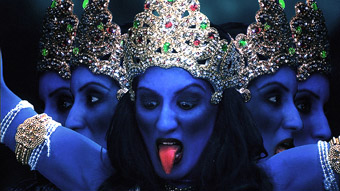
Uupekha Jain as Kali, When The Gods Came Down To Earth, Srinivas Krishna and Divani Films Inc
NIGHT AND DAY FOR A MONTH AT THE FLINDERS STREET ENTRANCE TO FEDERATION SQUARE, OPPOSITE ST PAUL’S CATHEDRAL, AND VISIBLE FROM MANY PERSPECTIVES, THE GODS OF THE INDIAN HINDU PANTHEON DANCED, PERFORMING THEIR ETERNAL ACTS OF JUSTICE AND BENEFICENCE. SOME ARE MULTI-LIMBED OR HEADED, OTHERS PART ANIMAL. SOME HAVE FLESH RICHLY HUED IN GLOWING BLUES AND REDS. IN RESPONSE TO A COMMISSION FROM FEDERATION SQUARE’S LIGHT IN WINTER FESTIVAL. CANADIAN FILMMAKER SRINIVAS KRISHNA [RT84, P20] CONJURES A BEAUTIFUL, OFTEN EERIE, OTHERWORLDLY POLYTHEISM IN HIS CREATION OF “A THREE-SIDED BEACON”, FULFILLING A DESIRE “TO TAKE THE GODS INTO THE STREETS.”
Inspired by the mass production of images of Hindu gods that commenced in India in the 19th century and its spread into many other media since, Srinivas Krishna clearly sees god-populated popular culture as a rich spiritual repository.
Using Toronto-based classical Indian dancers, Srinivas and his many collaborators have enriched the live action with hand painted sets, fine costuming, elaborate makeup, animation and a variety of digital effects. The elephant god, Ganesh, is a perfect merging of the human and the divine; the many-armed Kali is frighteningly spider-like; the “vision of Universal Being revealed by Krishna?to his friend Arjuna during a moment of doubt” is spectacular in its multiplication of heads and limbs; while the lotus growing from Vishnu’s belly is central to an image of beauty but also of the complexity of creation as a cluster of serpents hover above.
Each of the installation’s three screens plays the same loop of the gods in action, but not in sync, so that as you walk around the work a series of mysterious events unfold. Alternatively you can watch one screen, contemplatively, from a distance—aesthetically the best position given that the large size of each of the many screen units has a kind of pixelating effect close up. There are a few irritations.The absence of a sound score seems odd, especially for gods represented by dancers from a musically rich culture, and the dull grey of the supporting plinth seems inappropriate, not least when girded with municipal potted shrubbery. There was also no information about the installation that I could see. The artist’s website for the work (www.godsonearth.com) is a valuable corrective, providing images and names for each of the gods and footage of the installation in operation.
Given the noise of traffic, cafe music and public announcements of Federation Square, Srinivas Krishna told me he chose not to compete with a soundtrack, let alone face the economic and logistical challenges involved. However, he addressed the issue when the Institute of Contemporary Culture at the Royal Ontario Museum and the Toronto International Film Festival invited him to present When the Gods Came Down in Toronto in September as part of the festival’s Future Screens program, with the installion located outside the Royal Ontario Museum.
Srinivas worked with Toronto-based composer, Debashish Sinha, to create three to five minute compositions every half hour in a three-hour rotation, with the sound built into the installation and explanatory titles. He sees the sound as “focusing the attention of passers-by and, as well, signalling the time (which is what the images do when they are so typically used to adorn Indian calendars). In using the sound this way, I want to see if it will serve, in some way, to ‘frame the work’ and the experience of it for viewers, which as I had discovered in Melbourne, is the challenge of public art (unlike gallery art which already brings with it a host of viewer expectations).”
From Toronto, Srinivas writes that he “improved the facing and structure of the installation, added a new figure, Saraswati, the Goddess of Knowledge and the Arts,…repurposed the imagery and added a border because we were displaying on screens that were different proportions (but higher resolution than Melbourne).” Toronto’s The Globe and Mail declared, “The revelation came not in a cinema, but on the street…This utterly breathtaking video installation was far and away the strongest work in an especially strong TIFF, causing pedestrians to stop and gape. Genius.” [Sept 13].
Federation Square’s 2008 Light in Winter Festival also involved nine local communities—Indigenous Aboriginal, Vietnamese, Afghan, Japanese, Hispano-American, Indian, Sudanese, Turkish and Tuvalu-South Pacific—each displaying light-based works they had made in collaboration with artists. Doubtless these were best seen on the night of their premiering in Federation Square. By the time I saw them them they’d been tucked away into various locations, some easily found and with identifying labelling.The glass foyer leading to the NGV was spectacularly festooned with chains of internally lit richly and subtly coloured paper flowers created by the Japanese community.
The square itself was warmly re-cast in light sculpted by Nathan Thompson of The Flaming Beacon design group, if having to compete with a multitude of lights from restaurants and cafes and the square’s big screen. Thompson’s long lines of fragmented light hung high overhead (like the gridding in a Richard Foreman stage production) and from these were suspended thin red pods, suggesting an organic quality akin to the community group creations using animal and flower shapes. Light in Winter is a small scale festival, distinctive amidst many generic ones. May it continue to glow.
When the Gods Came Down to Earth, director Srinivas Krishna, producer Sherrie Johnson, cinematographer Rhett Morita, choreographer Janak Khendry, Divani Films, commissioned installation for The Light in Winter, artistic director Robyn Archer, Federation Square, Melbourne,?June 13-July 13; www.godsonearth.com
RealTime issue #87 Oct-Nov 2008 pg. 26
© Keith Gallasch; for permission to reproduce apply to realtime@realtimearts.net
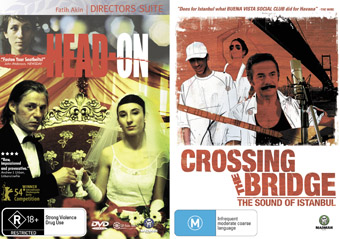
Head On, Crossing the Bridge: The Sound of Istanbul
ON THE COMMENTARY TRACKS FOR SOME OF HIS FILMS ON DVD, TURKISH-GERMAN WRITER-DIRECTOR FATIH AKIN REVEALS HIMSELF TO BE A SPIRITED, PLAYFUL PERSONALITY. IT’S NOT SURPRISING THAT HE WAS PURPORTEDLY INVESTIGATED BY GERMAN POLICE IN 2006 FOR WEARING A T-SHIRT WITH A SWASTIKA REPLACING THE ‘S’ IN GEORGE W BUSH, EQUATING THE PRESIDENT’S GUANTANAMO BAY REGIME WITH THE THIRD REICH. THE FEATURE FILM HEAD ON (2003), WHICH BROUGHT AKIN TO INTERNATIONAL PROMINENCE IS A TENSE, VIOLENT, DRUG-SATURATED AND ROCK-FUELLED TALE OF THWARTED LOVE IF, FORTUNATELY, MUCH MORE THAN THAT. AND AKIN PROVOCATIVELY ACCEPTED HIS AWARD FOR THE EDGE OF HEAVEN AT THE 2007 CANNES FILM FESTIVAL ON BEHALF OF TURKISH CINEMA.
But for German cinema Fatih Akin is also a respected figure, an integral part of the country’s film renaissance and one whose films make sense of the challenges of intercultural life. Not surprisingly his films locate themselves physically in both Germany and Turkey, characters travelling between the two in attempts to find lost family, to recover or seek a sense of identity…or flee, or be banished.
Even when portraying extremes, the voluble Akin is a subtle writer-director who generates unexpected narrative developments that test our expectations, who loops time back on itself to re-direct our perspectives, and who allows his fine performers ample time and space to reveal their characters without ever impeding his nuanced pacing. For all their intensity, Akin’s films are inviting meditations on love, kinship and culture.
Fatih Akin was born in 1973 in Hamburg of Turkish parentage and studied Visual Communications at Hamburg’s College of Fine Arts. He made award-winning short features in 1995 and 1996 and a full length feature, Short Sharp Shock in 1998, winning the Bronze Leopard at Locarno and the Bavarian Film Award for best Young Director. Since then he has made the feature films In July (2000), Solino (2002), Head-On (2003) and The Edge of Heaven (2007) which premiered in Australia at the Goethe Institut’s 2008 Festival of German Film and then enjoyed a long cinema release. It won Best Screenplay at the 2007 Cannes Film Festival.
Akin’s output also includes documentaries: We forgot to go back (2001), about his parents’ migration to Germany, and the feature length Crossing the Bridge: The Sound of Istanbul (2005), a comprehensive if informal quest to explore Turkish music—on the streets, in bars and clubs, on film and in sacred spaces—filming them as they perform and talk.
Crossing the Bridge: The Sound of Istanbul features Alexander Hacke of Einstürznede Neubauten as the narrator, onscreen quester and occasional collaborator with local musicians. It’s a characteristic move by Akin to look into Turkish music through the eyes and ears of a German musician who is recording and mixing as he travels the city.
The music is classic Arabic, Romany, Sufi and Kurdish, along with modern derivatives and hip hop, punk and more. There’s much fascinating music to listen to (and more in the added features), often much more idiosyncratic that you’d expect in a rapidly globalising culture, not to mention many an intriguing lyric on unfamiliar topics.
Throughout, there are accompanying, often substantial conversations with the musicians revealing their rich sense of cultural heritage, whatever their idiom, with not infrequent reference to the politics of nationalism and the effects of repression. The street musicians (buskers of a very high order) are some of the most eloquent when speaking of the deprivations of the big city and their romanticising by some popular artists.
Crossing the Bridge is a wonderful cultural document, its subjects ranging from hip hop teens to aged traditionalists (their younger selves glimpsed in archival footage) whose lyrics are vivid. A popular performer, youthful in her 80s, sways, singing “they said the tables were covered in sin/ with the wine of lovers.” Not least, the film is a great introduction to Istanbul, lovingly filmed in a manner as far from touristy or standard documentary as you could imagine, taking time out to gaze at tired buildings, thoughtful inhabitants, langorous pets and beautiful streetscapes behind the city’s iconic facades. This is a film you want to to return to again and again.
Madman Music has provided RealTime with six DVDs of Crossing the Bridge: The Sound of Istanbul to give to our readers, and six copies of Fatih Akin’s feature film Head-On the soundtrack of which includes traditional Turkish music, and songs from Depeche Mode, Sisters of Mercy and Talk Talk. Head On’s tale of an impossible love relationship borne of coincidental suicide attempts is as moving as it is tough-minded, heading towards a sad resolution as wise as it is despairing. As ever, Fatih Akin’s melding of image and music is fundamental to the power of his filmmaking.
Crossing the Bridge: The Sound of Istanbul, director, writer Fatih Akin, Madman Music DVD; Head On, writer, director, Fatih Akin, Madman Music DVD. www.madman.com.au
The Madman DVD of Akin’s The Edge of Heaven will be available for rental from October 9.
RealTime issue #87 Oct-Nov 2008 pg. 26
© Keith Gallasch; for permission to reproduce apply to realtime@realtimearts.net
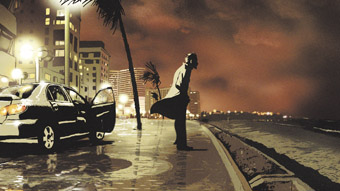
Waltz with Bashir
ARI FOLMAN’S OUTSTANDING ANIMATED DOCUMENTARY BRINGS TOGETHER INTERVIEWS, STORIES AND ACTS OF REMEMBERING WITH ANIMATED SCENES THAT RE-IMAGINE, RECREATE AND RE-ENACT THE PAST. TOGETHER THEY CONJURE A COMPLEX PICTURE OF EVENTS FOR WHICH THERE IS NO ARCHIVAL FOOTAGE. WOVEN TOGETHER, THESE ANIMATED FLASHBACKS, DREAMS AND MENTAL IMAGES CAPTURE THE TRICKY SURREALITY OF WAR AND MEMORY.
Folman draws heavily on his personal experiences with repressed traumatic memories. He is in fact the central character of his own film. Ari, a film director, retraces his time as an Israeli soldier in the 1980s when he supported Christian Phalangist militia in the first Lebanon War. He knows he was witness to two devastating massacres committed in the Sabra and Shatila refugee camps but he cannot remember anything about them. Waltz with Bashir follows Ari as he seeks out friends and long lost colleagues in the hope that their stories and memories will restore him to these repressed events.
During the Lebanese Civil War, the Israeli Minister of Defence, Ariel Sharon (who 20 years later became the country’s President) planned for the Israeli Defence Force to occupy Beirut and support Bashir Gemayel, senior commander of the Christian Phalangist militia, as the newly elected President of Lebanon. When Gemayel was assassinated, Phalangist militia took revenge by attacking the Sabra and Shantila refugee camps at night, the Israeli Defense Force lighting their way with flares. An estimated 3,000 people were massacred in these camps including women, children and the elderly, provoking widespread protests from the Israeli people, a government inquiry and, ultimately, the dismissal of Sharon.
The film’s incredible history lesson does not lie in these details, however. Folman describes the depiction of war in Waltz with Bashir like this: “It’s like nothing you’ve seen in American movies. No glam, no glory. Just very young men going nowhere, shooting at no-one they know, getting shot by no-one they know, then going home and trying to forget. Sometimes they can. Most of the time they cannot.”
Presented from the point of view of the common Israeli conscript, Waltz with Bashir speaks to a nation, a whole culture full of individuals haunted by repressed traumatic memories of war. Seven out of the nine interviews in the film are with real friends and colleagues of Folman who gave testimony on their recollection of their involvement in events now more than 20 years old. The other two interviewees are played by actors recounting the real testimony of Folman’s friends.
It is a recurring nightmare Ari’s old friend Boaz tells him that prompts the filmmaker’s own journey into the dark, forgotten depths of his own past. This film itself must have provoked similar journeys for Israeli filmgoers, speaking to the grim history that continues to haunt the bleak reality of contemporary Israel.
The workings of memory constitute both a topic of conversation in Waltz with Bashir and a driving narrative force. Film has often been understood as the ultimate medium for capturing the capriciousness of memory. It has the capacity to connect the past and the present, the real and the imagined, with the same unpredictable logic that drives our everyday experiences of thinking and feeling. Folman makes full use of these capacities.
A veteran documentary director, Folman’s approach to animation is unique. Waltz with Bashir was scripted, shot first on video and cut to 90 minutes. Rather than animate the video using rotoscope, where animators paint over real video, the film was then drawn again from scratch. The video was storyboarded, illustrated and then animated using a combination of Flash, classic animation and 3D. This produces a remarkably poignant aesthetic.
The drawings are exquisite. Their deeply moving attention to detail produces textual effects that would never have been available to the video camera. At the same time, the animation replicates the conventions of documentary, mixing talking head style interviews and at one point even imagining a slideshow of war photographs. In animated form, archive takes on the same status as subjective memories and hallucinations, the animation powerfully masking the distinction between real and imagined scenes. Animation here becomes the ultimate tool for rendering experimental histories.
Having Waltz with Bashir in general release here in Australia is significant since animation has become a major site for innovation in Australian short films in recent years. Australian Sejong Parks’ short animation The Birthday Boy (2005), nominated for an Academy Award, stands out as a companion example for Waltz with Bashir. The Australian cinema, however, is yet to deploy animation so powerfully to conjure traumatic memories of the dark histories that haunt our own contemporary reality. Waltz with Bashir opens up that possibility.
Waltz with Bashir, director Ari Folman, art director, illustrator David Polonskey, director of animation Yoni Goodman, editor Nilli Feller, 2008, waltzwithbashir.com
RealTime issue #87 Oct-Nov 2008 pg. 27
© Megan Carrigy; for permission to reproduce apply to realtime@realtimearts.net
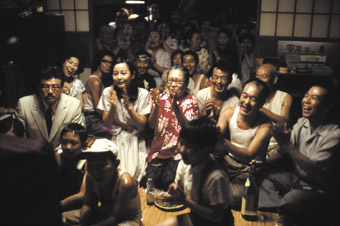
Always—Sunset on Third Street: the first television set
THE FESTIVAL’S PREVIEW DVDS COMPRISED A FROTHY SELECTION OF JAPANESE FILMS—SOAPY DRAMAS, A MONSTER SAGA IN THE GODZILLA TRADITION, SAMURAI ANGST, BRACING SENTIMENTALITY AND A JOURNEY INTO MADNESS.
The best of the bunch is the two-hanky (idiomatic Japanese for mildly weepy) Always—Sunset on Third Street (director Takashi Yamakazi), a meticulously crafted, nostalgic recreation of the Tokyo of 1958 based on a popular comic strip set in in the old blue-collar residential area of Yuhi and winner of 12 Japanese Academy awards in 2006 including Best Film, Best Actor, Best Screenplay and Best Cinematography. The film’s narrative is framed by the building of the Eiffel Tower-like Tokyo Tower, glimpsed here and there from a distance through the gaps between humble, mostly timber suburban houses and at the end of tram-tracked main streets as it grows to completion and an almost happy end for at least some of the characters. The tower represents an emerging spirit of optimism after the depredations forced by defeat in World War II.
There are small signs of improvement—the refrigerator replaces the icebox and the first television on the block attracts a multitude of ecstatic house guests (until a fault develops and an eager helper disastrously dismantles the set) and there’s very full-on Christmas gift-giving. The film’s sense of community, quite village like, is strong, as is its comedy if frequently undercut by darker narrative strands—the local doctor who chronically mourns his war-dead wife and daughter, and a woman whose father’s debts keep her in sexual bondage (“so feudal”, comments one of the locals).
The film centres on two households, one belonging to the family of a volatile car mechanic prone to verbally mistreating a string of young apprentices who leave him, this time a young girl from the countryside who feels she’s been effectively banished from her family. The other is a run-down general store neglected by a cranky, disinherited writer whose literary ambition cannot be achieved, writing secretly instead for boys’ manga, and stealing stories for them from an intelligent and creative orphan he is begrudgingly obliged to mind. The actors playing the mechanic and the writer give the film much of its strength—they are obtuse, funny, infuriating and at odds, while the other characters, the young boys excepted, are more generic. One of the best and most sustained scenes has the easily insulted mechanic erupting emotionally and physically through doors and walls in pursuit of his apprentice. It’s eventually a positive turning point for him and one that has a rightness about it amidst the calculated coincidences and resolutions elsewhere. The more detailed transformation of the writer into a loving foster parent is developed in the second part of the film, combining studied motivation and sentimentality in equal, but nonetheless convincing proportions. Always is doubtless a feel good fiction with limited historical vision, but the totality of that vision and its finest performances ring tearfully true. Always is showing only in Melbourne, and its sequel, Always 2, is showing only in Sydney.
Love and Honor (Melbourne only) completes the Yoji Yamada trilogy that includes The Hidden Blade and Twilight Samurai. It’s samurai drama of a quiet order—only one fight and a tellingly abject one at that. The young protagonist’s job is to taste his master’s food and in due course he is poisoned, resulting in blindness, a stubborn withdrawal from the world and a loss of moral perspective. The return to honour and perhaps love is carefully wrought in this modest period piece, which won Best Supporting Actor, Best Cinematography and Best Lighting at the 2007 Japanese Academy Awards,
I’ve long enjoyed those small scale films that offer glimpses into specialist aspects of Japanese urban and regional life, as with Shingo Matsubara’s chatty The Taste of Fish centred round the Tsukiji Fish Market, one of the world’s largest, and where the corporate protagonist recovers his sense of self. The Godzilla films might have been inadvertantly satirical but Minoru Kawasaki’s Monster X Strikes Back/Attack the G8 Summit is calculatedly so as the monster from outer space attacks the world reaping large scale political ill will and much damage to balsa wood and other constructions. One for the fans. A different kind of monstrosity is perpetrated in Suzuki Matsuo’s Welcome to the Quiet Room (showing in Sydney only) where a journalist is accidentally admitted to a psychiatric ward where she nonetheless manages to learn something about herself—but what a way to do it. Ultimately this is a ‘feel very bad but then in the end feel quite good’ kind of movie and not without interest.
While not the topflight of current Japanese cinema there’s something in the program for everyone, offering not a few insights into one of our key neighbours. Not least there’s a constant sense of the past bleeding into the present in ways both nourishing and limiting. RT
The 12th Japanese Film Festival, ACMI Cinemas, Nov 27-Dec 1; Greater Union, George Street, Sydney, Dec 2-9;
http://12thjff.jpf-sydney.org
RealTime issue #87 Oct-Nov 2008 pg. 27
© RealTime ; for permission to reproduce apply to realtime@realtimearts.net
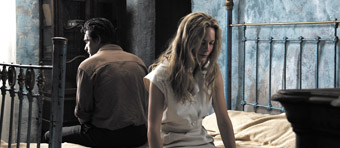
The Banishment
RUSSIAN CINEMA IS CURRENTLY IN THE MIDST OF A RENAISSANCE. OF THIS THERE CAN BE NO DOUBT. WITH THE GREAT FILMMAKING INSTITUTIONS OF THE SOVIET UNION NOW A DISTANT MEMORY, THE RUSSIAN FILM INDUSTRY HAS BUFFETED THE WINTER OF TRANSFORMATION AND RE-EMERGED IN THE 21ST CENTURY TO A DIVERSE AND FERTILE MARKETPLACE. RUSSIA’S DOMESTIC BOX OFFICE RECORDS ARE BEING CONSISTENTLY BROKEN BY LOCALLY-MADE PRODUCTIONS, AND MORE THAN A COUPLE OF EMERGING RUSSIAN FILMMAKERS ARE MAKING SERIOUS INROADS INTO THE INTERNATIONAL FESTIVAL CIRCUIT.
Indeed, so healthy is the state of Russian cinema that some critics have begun talking of a “new wave” in Russian filmmaking. I’m not sure the term is apt. Contemporary Russian cinema is too disparate and multifaceted to be swept along in one direction. But as an acknowledgment of industrial progress, if not for any ideological or stylistic consistency, the idea of a Russian “new wave” is certainly justifiable. After almost disappearing in the years immediately following the break-up of the Soviet Union, the film industry (like many industries in today’s “new” Russia) has steadily grown over the past decade to now re-assume a significant measure of international stature. Since 1998, each passing year has witnessed an increase in film productions, with a high proportion of these being made by first time directors. This establishment of a wide platform of emerging talent (of not only directors, but actors and crew), coupled with the willingness of the Russian state and big business to invest in domestic productions, has meant that strong foundations have been laid for a very productive, varied and potentially enduring industry. In a time when West European and Hollywood cinemas seem locked in a state of creative recession, and when even East Asian cinemas seem a little quiet, Russian cinema is on the march. Creative and financial chances are being willfully taken. Gambles are ventured without the guarantee of healthy returns (a concept that Hollywood producers could reacquaint themselves with). And even if not all of these are successful—even if bad films are still made in Russia as in any other country—the boldness and confidence that pervades contemporary Russian filmmaking is refreshing.
Australians will have a chance to taste the vitality of this new Russian cinema when the Russian Resurrection Film Festival returns for its fifth annual season. Established in 2003, the festival has grown substantially over recent years, branching out from its original venues in Melbourne and Sydney to now include screenings in Adelaide, Brisbane, Canberra and Perth. And much like the national industry it showcases, the festival shows all the signs of further growth. Last year former Russian president Vladmir Putin lent political weight when he opened the Sydney wing of the festival (giving Australian politicians a hint of the importance that some governments place on their national cinemas). And with 2007 audiences up 55% on the previous year, organisers of the 2008 festival are hoping for an even bigger turn-out this time around. I was grateful to festival organisers for a brief peep at some of the headline features.
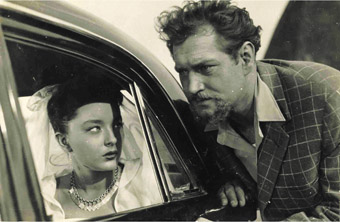
Amphibian Man
No doubt the festival drawcard for local cinephiles is Andrei Zvyagintev’s The Banishment. A Russian-Belgian co-production, The Banishment arrives on our shores shrouded in both mystery and anticipation. Following the media sensation that surrounded Zvyagintev’s debut feature The Return (which won the Golden Lion at Venice in 2003), details of The Banishment were kept under strict wraps until the film’s release last year. The Siberian born director Zvyagintev even went to Kubrickian lengths, going into hiding to avoid the press. Thankfully the results have proven worth the trouble. The Banishment, I am happy to confide, is a demanding, enigmatic and masterful film confirming Zvyagintev’s status as a rare genius of narrative cinema. This is a major event in world cinema, a genuine example of film art, and should not be missed by any serious filmgoer. The Banishment won the Best Actor award at the 2007 Cannes Film Festival for Konstantin Lavronenko.
In the crime thriller Vice, director and co-writer Valery Todorovsky revisits the Russian underground he so successfully explored a decade ago in Land of the Deaf. Vice follows the descent of young hipster Denis (Maxim Metveyev), a dance club disc jockey whose dreams of a life beyond the mundane lead him into an uncompromising relationship with lonely, sociopathic mobster Verner (Fedor Bondarchuk). Denis soon discovers that it’s easy to make friendships, but hard to break them off. With some fine performances, blistering scenes of violence and a peculiarly bleak Russian denouement, Vice is an effectively paced crime drama, a much darker film than it seems at first.
Aleksei Popogrebsky’s award-winning feature Simple Things is an entertaining and surprisingly evocative example of cinematic understatement. The film gently portrays the less than remarkable, though still thoroughly unmanageable, mid-life crisis of St. Petersburg anesthetist Sergei Maslov. A kindhearted-without-being-prissy film that was lauded with prizes at Eastern European festivals last year, Simple Things stands out in its national context as a unique, semi-precious gem—an antidote to the darkness of Zvyagintev’s harrowing epic.
Other films to be screened at the festival include Karen Shakhnazarov’s latest feature Vanished Empire (which plays alongside the director’s Glasnost-era classics Zero City and We are Jazz Men) and a retrospective of Soviet fantasia’ cinema to be headlined by the enormously popular 1962 oddity Amphibian Man. Come and sing along to the adventures of Ichtyandr, boy with gills. For Sydney audiences there’s also a special treat on November 9 at City Recital Hall, where the SBS Youth Orchestra perform the original Dmitri Shostakovich score to Gregoriy Kozintsev and Leonid Trauberg’s 1929 silent film New Babylon.
2008 Russian Resurrection Film Festival: Melbourne: Palace Cinema Como, October 29-Nov 5; Canberra: Greater Union Manuka, Oct 30-Nov 3; Sydney: Chauvel Cinema, Oct 31–Nov 10; Brisbane: Palace Centro Cinema, Nov 6-12; Perth: Cinema Paradiso, Nov 13-19; Adelaide: Palace Nova Eastend, Nov 14-19; www.russianresurrection.com
RealTime issue #87 Oct-Nov 2008 pg. 28
© Tom Redwood; for permission to reproduce apply to realtime@realtimearts.net
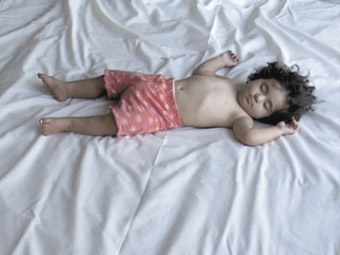
Ten Minutes Older, Abbas Kiarostami
ERICE-KIAROSTAMI. CORRESPONDENCES IS AN EXHIBITION NOT TO BE MISSED IF YOU VALUE THE POETIC AND EXPRESSIVE POSSIBILITIES OF CINEMA AND ITS SHIFTING CONNECTIONS TO THE VISUAL ARTS. IT IS ONE OF THE MOST ENCHANTING AND ENGAGING EXHIBITIONS ON THIS SIGNIFICANT THEME THAT I HAVE ENCOUNTERED IN THIS COUNTRY, AND INDEED, ELSEWHERE.
It is simply an elegant and imaginatively installed exhibition delineating the uncompromising aesthetic, cultural and formal qualities of these two modern trailblazers of world cinema. These two artists were born—as life would have it—one week apart in countries (Iran and Spain respectively) that have both experienced massive socio-cultural and political turbulence, censorship and ideological contradictions and tensions. In Kiarostami’s case, it was Iran under the regime of the Shah from the 1950s to 70s, and then the theocratic Islamic Revolution, and for Erice, the transition from fascism to democracy with the end of Francoism in Spain in 1977.
Co-curated by the prominent French film critic Alain Bergala and the Spanish curator Jordi Ballo the exhibition constantly asks of the engaged gallery-goer, “What is cinema?”, particularly in a time of vertiginous cross-pollination between cinema, digital cinema, photography, installation, painting, sculpture etc. As you wander through this spacious exhibition of films, photographs, installations, painting and videos you also entertain another question, “Why is our own cinema frequently lacking in an inventiveness of form, dialogue, performance, space and text?” I am not dismissive in toto of Australian cinema, far from it, but the same unsettling question returned.
The exhibition subtly reveals the resonating, parallel trajectories of the filmmakers, each exploring a personal path in cinema that speaks of everyday life, history, landscape, myth and memory. Both Kiarostami and Erice, as Bergala explains in his penetrating catalogue essay, refused careerism, cinematic fashion and public taste, making their diverse “post-medium” (Rosalind Krauss) oeuvres “with the sovereignty befitting an artist” (“Erice-Kiarosatami: The Pathways of Creation”, in Erice-Kiarostami Correspondences, Barcelona, Catalogue, Centre De Cultura Contemporana De Barcelona, 2006). In other words, they see and hear the world as a perennial enigma located and concealed in the visible. Whatever differences there may be in terms of culture, as you surrender yourself to their exhibits, you realise that these filmmakers have a mutual interest in producing a contemplative cinema of attentiveness to the contingencies of life, to silence and tranquillity. At the same time they evoke Proustian reveberations of their childhood memories.
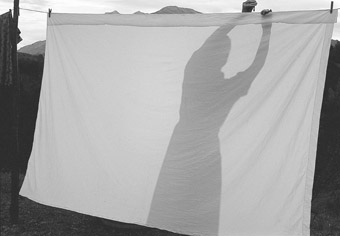
Lifeline, Victor Erice
Bergala is right in emphasising how both filmmakers abhor the iron-clad tyranny of drama, sense and narrative and make their speculative, non-linear and philosophically informed films as if they are contemporary visual artists. As we know, they are not alone in this facet of world cinema (Chantal Akerman, Stan Douglas, Jean-Luc Godard, Derek Jarman, Thierry Kuntzel, Sally Potter, Chris Marker, Agnes Varda and many others).
The exhibition’s intelligent structure provides corresponding paths, placing the life of each filmmaker in dialogue with the other, highlighting resemblances and differences. But which ever way you choose to enter the massive space, you find yourself at the ‘crossroads’ of the filmmakers’ oeuvres and whichever way you go, Erice or Kiarostami, is of no real consequence. There is a welcome “Cagean” wisdom to the criss-crossing curatorial and apparent design randomness. The ‘crossroads’ allows you to traverse from one universe of cinematic creation to another.
And at the other end of the exhibition, whose critical theme is, I believe, the indispensable connectedness that exists between the childhood of cinema and the cinema of childhood (Serge Daney, Jean Louis Schefer), we find the correspondence between Kiarostami and Erice conducted in mini-DV letters. This striking exhibit, amongst others scattered throughout the exhibition, particularly attests to their experimental creativity and curiosity to go beyond the usual constraints of celluloid cinema to explore the new possibilities of small digital cameras. This is another instance of how cinema is rapidly expanding beyond the theatre, especially in galleries and museums, where art and film are interacting in many intricate ways. For some 30 years now we have been witnessing the changing cultural geography of the gallery/museum as shaped by interactions between visual art and film.
There are also other works that cut across a number of media confirming for each a singular aesthetic and a sense of existential creative adventure: the black and white, calligraphic poetry of Kirarostami’s ravishing landscape photographs and The Roads of Kiarostami (1978-2003) are among the numerous delights of this exhibition, as is Erice’s Notes. Quince Tree (1990-2003), a work that continues the concerns of his 1992 modern masterpiece on creativity,The Quince Tree Sun.
The exhibition program also contains most of the seminal films of these risk-taking filmmakers. Erice and Kiarostami’s captivating films share a crucial aesthetic and ethical kinship of sorts based on the belief that the universal is indisputably connected to the singular. Both critically reject the crippling legacy of naturalism in the cinema and other art forms; and both also believe that the singular vocation of today’s artist is to speak of everydayness and, as Bergala puts it, “the essential inessentiality of art.”
Erice-Kiarostami. Correspondences highlights something that is sorely missing in these ahistorical times of ours. It unequivocally demonstrates that these two artists, who create with their camera-pens (Alexandre Asrtruc) and write to each other, pay respect to each other’s personal path to creativity and in so doing pay the same to the ancestors of their medium.
Erice-Kiarostami. Correspondences, ACMI, Aug 21-Nov 2
RealTime issue #87 Oct-Nov 2008 pg. 31
© John Conomos; for permission to reproduce apply to realtime@realtimearts.net




















































































